 Leading Blog | Posts by Category |
 Leading Blog | Posts by Category |
04.04.25

Why Buy-In Is the Most Overlooked Factor in Business Growth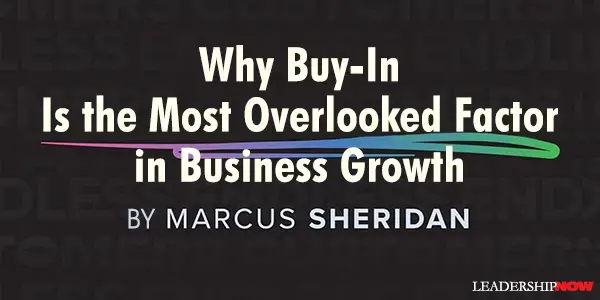
MOST business leaders assume that if they roll out the right strategy, success will follow. But the truth is, even the best strategy will fail without full buy-in from your team. Lack of buy-in is the silent killer of growth. It’s why so many marketing initiatives fall flat, why sales teams resist new processes, and why companies struggle to implement real change. If your employees aren’t aligned, your customers will feel it. And if your customers feel it, they won’t trust you. The Real Reason Strategies Fail The biggest mistake CEOs make is assuming that once they decide on a direction, their team will automatically follow. But people don’t resist change because they’re lazy or unwilling—they resist it because they don’t understand why it matters to them. If your leadership team makes decisions behind closed doors and then announces them as mandates, don’t be surprised when your employees push back—or worse, disengage entirely. The companies that thrive aren’t the ones with the best ideas; they’re the ones that get their teams to believe in those ideas. How to Get Your Team Fully Invested To build a company that executes at the highest level, buy-in can’t be an afterthought—it has to be built into your culture. Here’s how: Involve Your Team Early – People support what they help create. Instead of rolling out a fully baked strategy, bring your team into the conversation from the start. When employees feel heard, they’re far more likely to take ownership of the outcome. Communicate the Why—Not Just the What – Telling your team what to do isn’t enough. They need to understand why it matters. If they don’t see how a new initiative connects to their success, they won’t give it their full effort. Remove the Fear of Change – Many employees resist new initiatives because they’re afraid of failure or increased workload. Address these fears head-on by showing how changes will make their jobs easier, more impactful, or more rewarding. Model Buy-In from the Top – Leaders set the tone. If the CEO and leadership team aren’t visibly invested in a new strategy, don’t expect the rest of the company to be. Buy-in starts at the top and cascades downward. The Bottom Line: Your Strategy is Only as Strong as Your Buy-In A great strategy without buy-in is worthless. The companies that grow the fastest aren’t just the ones with bold ideas—they’re the ones that get their entire team aligned, engaged, and committed to execution. So, before you ask, “Is this the right strategy?” ask yourself, “Does my team actually believe in it?” Because if they don’t, nothing else matters.
 
Posted by Michael McKinney at 10:59 AM
01.22.25

Connections: The New Currency of Our Era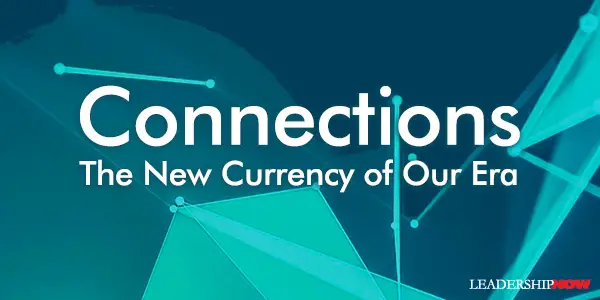
THE challenges organizations face today are becoming increasingly complex, interconnected, and unpredictable. Yet, as we examine these challenges more closely, a striking realization emerges: most are rooted in connection issues. Network science heralded as the science of the 21st century, provides a groundbreaking framework for understanding connections. It uncovers profound insights into the structural and functional challenges organizations encounter, offering a transformative lens for leadership in this era of complexity. To thrive, leaders must embrace a new paradigm that prioritizes the power of connections. Let’s explore two critical domains where connections are paramount: innovation and talent management. Innovation Is a Connection Issue Innovation is no longer a choice — it’s a necessity for survival. Organizations must continuously evolve to remain relevant in a world where rapid technological advancements, globalized competition, rising customer expectations, sustainability imperatives, and the accelerating pace of change are redefining the landscape. Businesses face relentless pressure to create new products, services, and experiences. The speed of change, coupled with shrinking product lifecycles, demands an ever-present focus on reinvention. But true innovation — transformative, game-changing innovation — requires more than resources or technical expertise. It requires connections. True Innovation Requires Novel Connections Innovation doesn’t arise in isolation. It emerges when existing components — technologies, ideas, or processes — are combined in novel ways. Breakthroughs happen at the intersections. Consider these examples: • Netflix disrupted the entertainment industry by integrating streaming technology with a subscription-based model, reimagining how content is consumed. • The iPhone combined touchscreens, mobile internet, and portable media players to create a seamless, revolutionary device that reshaped industries. These innovations weren’t about inventing entirely new technologies. They were about creating connections — linking ideas and resources in ways others hadn’t imagined. For innovation to flourish, leaders must create environments where connections thrive. This means fostering diverse teams, building networks that bridge silos, and nurturing cultures where collaboration is encouraged. By connecting people, ideas, and resources across boundaries, leaders can ignite fresh thinking and unlock transformative breakthroughs. Talent Management Is a Connection Issue Talent is the lifeblood of any organization. Yet, in today’s digital age, retaining top talent has never been more challenging. With alternative employment opportunities more visible and accessible than ever, organizations must prioritize creating environments where employees feel valued, engaged, and connected. The pressure to retain talent is more urgent than ever. Employee expectations have shifted. Today’s workforce seeks more than just a paycheck — they seek purpose, belonging, and meaningful connections. Organizations that fail to meet these needs risk losing their best people to competitors who can. Retention depends on high-quality connections. Studies show that a sense of belonging is at the heart of employee retention. A Harvard Business Review study found that fostering belonging reduces turnover by 50 percent, increases job performance by 56 percent, and cuts sick days by 75 percent. A Gallup study revealed that employees with a best friend at work are seven times more likely to be engaged. When individuals feel connected to their teams, their leaders, and the broader organization, they’re more likely to stay and perform at their best. Strong workplace connections foster trust, boost morale, and create a shared sense of purpose, all of which are critical for engagement and retention. The Leadership Imperative Leaders play a pivotal role in fostering these connections. By investing in team building, encouraging collaboration, and cultivating a culture of inclusion, leaders can create workplaces where employees thrive. Prioritizing connections isn’t optional — it’s a strategic necessity that directly impacts organizational performance and success. Connections Are Central to Organizational Success Beyond innovation and talent management, many other organizational challenges, such as supply chain coordination, AI implementation, cross-functional collaboration, and team performance, are also deeply rooted in connection issues. This should come as no surprise. Network science reveals that all complex systems are, at their core, networks. Organizations, being complex systems, are no exception. Networks are simple in structure yet extraordinarily powerful. They comprise: Nodes: In human networks, these are individuals. Connections: The links between them, such as communication channels. Interactions: The flows that occur between nodes, such as information exchange or collaboration. The strength and quality of these connections determine the effectiveness of the network — and, by extension, the organization. The Network Science Message for Leaders Network science offers a revolutionary insight for leaders: Focus on connections — the space between people. Stronger connections lead to stronger networks, which in turn drive better organizational outcomes. Whether addressing innovation, talent management, or operational challenges, leaders who prioritize building and strengthening connections unlock their organization’s full potential. Transitioning to Network Leadership: Mastering Connections To truly harness the power of connections, leaders must master both the art of small, close-knit connections and the art of large, systemic connections. Small connections: Small teams, typically composed of four to five members, consistently outperform larger teams. Why? Because smaller teams foster higher-quality connections, enabling superior engagement, trust, and performance. These teams are where the work gets done. Large connections: While small connections excel at execution, they risk losing sight of the bigger picture. Large gatherings, on the other hand, cultivate a sense of belonging, enhance cross-functional collaboration, and create the conditions for serendipity and breakthrough innovation.. Magic lies in mastering both the art of small and large connections. Leaders must create environments where small teams can thrive while ensuring the organization as a whole remains interconnected, inspired, and aligned. The path forward for leadership in the 21st century is no longer about command and control; it’s about connection and collaboration. The leaders who excel in this new era will be those who understand the power of networks and use them to drive innovation, engagement, and performance. By focusing on connections — strengthening the space between people — leaders can create organizations that are not only resilient and adaptive but also capable of achieving extraordinary outcomes. The future belongs to those who master the art of connection.  
Posted by Michael McKinney at 01:33 PM
12.20.24

Be Powerful & Em-Powerful!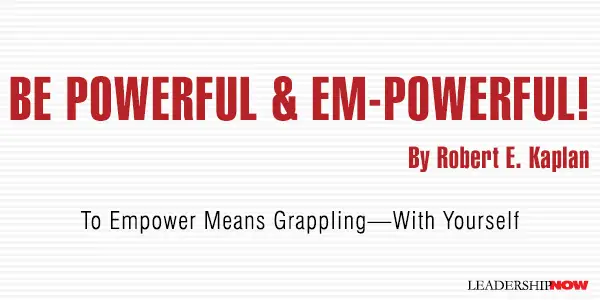
EMPOWERMENT has turned into a buzzword that’s lost its meaning. We all know what being powerful—or, euphemistically, influential—looks like. But to be empowering—how clear is that? Worse than unclear, empowering is widely misunderstood. For forceful leaders, it’s seen as giving power away; giving power to your staff means giving up your power. It’s easy for forceful leaders to feel that granting power to others takes away from their own power or that they are somehow rendered “passive,” as one forceful leader put it. Power is simply a means to the end of getting things done. It shouldn’t matter whether it’s your power or “Other” power. You can grind grain into flour by your own hand using a mortar and pestle, which human beings learned to do at the dawn of agriculture. Or, as people discovered centuries later, you can spare yourself that manual labor and produce a lot more grain if you hitch horses or water or wind power to the mill. Three Types of Empowerment #1. Delegation. Delegation of authority is letting your people do their jobs. Delegation of authority is certainly not abdication. It’s taking an active role in arranging for some other source of power to be transmitted to the grinding stone. It is spooling out authority and then staying engaged to the degree necessary. #2. Taking counsel. Empowerment isn’t just granting power down. It’s also accepting power up. Because every leader is fallible—at risk of making costly errors of judgment—there is great merit in taking counsel from your people, selectively, of course. Perhaps your ego rebels just a bit, and you can’t help feeling that taking your team’s counsel on decisions that are yours to make is somehow a sign of weakness. Quite the contrary, within bounds, accepting power up actually extends your personal power. Done well, it fortifies your judgment—makes it stronger. #3. Picking strong players. To tap effectively into Other power, you must put strong, capable people on your team in the first place. You can only be as em-powerful as your people’s skills and energies allow. If you were deciding on a place to build a windmill, you’d settle for nothing less than a consistently windy place. Many leaders fail to put high-quality people on their team. Either they are poor judges of talent or, out of insecurity, they shy away from appointing the best people. Leaders may also fall down on the back end of staffing out of misplaced loyalty or being afraid to let go of people who’ve lost effectiveness or who turn out not to be good picks. To Empower Means Grappling—With Yourself Do you recoil at the idea of sharing power, thinking, “Never. I’d be a wimp?” Indeed, empowerment is sometimes viewed as “soft” and, therefore, something to be avoided if you want to be a strong leader and you want to be viewed that way. If that’s what you believe, you’ll never be good at empowerment. Likewise, if you fear that empowering others makes you a managerial weakling. That prejudice, that fear, stands in your way. To get it out of the way means grappling with yourself because it isn’t always easy to correct an entrenched belief or allay an unwarranted fear. Why not see your way clear to be both powerful and empowerful? It’s a struggle with yourself well worth waging. (For more on that subject, see my new book, GRAPPLING: Leaders Striving To Be Better, short stories that bring executive coaching to life.) Why not have both sources of power fully available to you, direct and indirect power. However naturally powerful you are—however well you take charge, make decisions in a timely way, set high expectations, and hold people accountable—it pays big-time to also be em-powerful. That way, you extend your power and amplify your impact. What’s more, you afford other people the opportunity for one of life’s deepest satisfactions—to use their powers fully.  
Posted by Michael McKinney at 08:29 AM
03.22.24

End Game First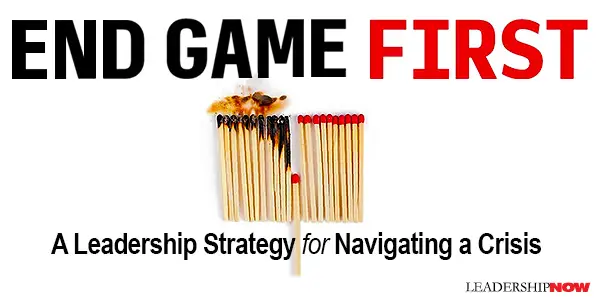
A CRISIS most often comes when you expect it least. How do you deal with the damage and move forward? Vice Admiral Mike LeFever and Roderick Jones state in End Game First, “In a crisis, you have to consider your end game first. At some point in the future, you will be out of danger and back in the day-to-day. Where do you want to be when that happens?” The end game is your exit strategy. It’s not the end of the crisis, it’s where you want to be after the crisis. It is the result of the actions you take instead of letting the crisis lead you. The end game is about how you will actively shape the outcome. There is risk with any decision made during a crisis, but it is better than standing still. If you don’t identify and act in accordance with the end game, you’re going to be caught unaware when the world moves on without you. The authors identify the four phases of any crisis—a dynamic but predictable path: Phase 1: 911 The opening moments of a crisis require immediate action—most often reactionary action. And that’s normal. But at some point, you will need to step back and observe what is happening so you can develop your strategic end game plan. Once the 911 moment begins, you’ll find yourself reacting any number of challenges. This is when you need to trust your instincts, and your preparations, as you endure the initial chaos. Even with proper planning, this can be a difficult phase. Motions run high, teams grow anxious, and unpredictable turns can come at any time. Information is a powerful currency. In the first phase of a crisis, you need to distinguish between information (raw) and intelligence (analyzed) and to take all new information with a grain of salt. Discordant information abounds in chaos. Phase 2: 2nd and 3rd Order Effects Once the chaos ends, it’s time to address the second and third-order effects. Phase 2 is characterized by moving from reacting to acting—a recovery mindset. A key characteristic of Phase 2 is that none of these solutions are permanent. You are making decisions that move you forward, but they are not the final word on the situation. As a leader, you need to realize when a fix is actually just a bandage. Some solutions also bring new problems. That’s part and parcel for this phase of a crisis. The decisions you make as a leader might plug one leak while creating another. You can’t get discouraged by cascading events, but you need to be aware that can happen. Phase 3: Steady State You’re not out of the crisis yet. “The steady state can lull you into a sense of routine, but you can’t lose focus. You can still make decisions and take actions that move you toward your end goals.” Phase 3 is a steady state of being, but it is not a sustainable environment. Or rather, it can’t be a self-sustainable environment. Steady state is marked by reestablishing some semblance of routine that allows some degree of reset. Phase 4: Reestablishing Normalcy In this phase, you recognize that the crisis is over based on the reality of the situation and dismantle the emergency infrastructure. Exiting a crisis means returning to a changed world. No matter how much you may want it to, life isn’t just going to go back to the way it was. Following a disaster, people change. Priorities change. Infrastructure changes. That’s why your end game needs to take that evolution into consideration. Just as the now exists in the aftermath of the crisis, so must you. Things have changed, and you need to change with them. Knowing which phase you are in will aid you in determining your next move. Each phase comes with its own set of issues. Navigating each with the end game in mind can leave you in a better place than before things began to unravel. While you always need to keep the end in mind, the decisions you make from phase to phase will differ drastically. You not only need to know where you are within the crisis, but how you’ll transition to the next chapter or phase. A crisis will also evolve at different rates for different parts of your organization. It’s important to recognize where the rest of your organization falls within their own scope of the crisis. The authors spend a good deal of time addressing key components of crisis management: building a team, communication, gathering intelligence, creativity in working with what you have to work with, mental health, and relationships. After the crisis is a good time to evaluate what worked and what didn’t. Important, too, is to always be looking for the undercurrents in your industry. Where are you headed? A crisis can accelerate those scenarios. Are you prepared to adapt to the shifts taking place around you? A missed change can create a crisis. It’s hard to know when you’ve become too comfortable with your current situation to objectively step outside of it. That’s why you need more eyes and ears seeking out undercurrents. If you miss it, someone else has a chance to catch it. 
Posted by Michael McKinney at 02:02 PM
02.16.24

quickpoint: What Middle Managers Do
IN Power to the Middle: Why Managers Hold the Keys to the Future of Work, authors Bill Schaninger, Bryan Hancock, and Emily Field contend that middle managers are crucial to the new world of work. What middle managers do is actually much more complex than what either executives or frontline workers do: They manage both up and down, and serve as translators in both directions. What kind of qualities and skills does the job require? Emotional intelligence, resilience, adaptability, technical skills, critical thinking, communication skills, being open to change, seeing the big picture, and managing both full-time and contract/gig workers. Everything they do deeply affects the work, the workforce, and the workplace. Consequently, Senior leaders should make transforming the role of middle managers their top priority. They should invest in their success, placing their most qualified and valued people in these roles, providing training for them to excel, rewarding them within the role rather than promoting them into more senior positions, and most importantly giving them the time to actually manage. By trusting managers to make decisions, and sending a clear message that these roles are highly desirable, middle managers will be better positioned to make an impact. 
Posted by Michael McKinney at 09:38 AM
04.07.23

Is Your Workplace Plagued by Disrespect? Take This Step to Disarm It
NAME-CALLING. Stereotyping. Micromanaging. Foul language. Is your workplace a hotbed of disrespect—and are productivity and collaboration tanking because of it? When co-workers, managers, and their subordinates lose respect for one another, it negatively impacts their work and the work of the people around them. Some organizations respond with well-meaning exhortations to “just get along,” or they encourage private chats with human resources or senior management. Yet quite often, there’s no action taken at all. If someone’s disrespectful behavior crosses a policy or legal line, there may be an investigation followed by disciplinary action, interventional coaching, a lateral transfer, demotion, or termination. Or—once again—there may be nothing done at all. Is there a better way to address and curb disrespect at work? Without a doubt, yes. At the Center for Respectful Leadership, we believe that Coaching for Respect™ (CfR) is something every organization should consider trying first (even if they rule it out) before moving to more formal, investigative, disciplinary, or legal remedies. At the core of this process is a simple question: What do you respect in the other person? We’ve found that when co-workers clash over disrespectful behavior or language, what they do respect in their colleagues isn’t completely obscured. It’s just being overridden by intense negative feelings and emotions. Once the “what happened”—the intentions, actions, impacts, and perceptions—are uncovered and explored through coaching and rational discussion, what people respect in each other is much easier to see. And their work environment will improve because of it. Three Common Areas of Respect Typically, what we respect in our work colleagues falls into three areas or attributes:
By having people identify precisely what they respect in others, they’ll start to break down hardened perceptions, such as an employee labeling a colleague as a “disrespectful person” or the accused suggesting the aggrieved party is “too sensitive” or “a complainer.” Ideally, you’re trying to get the sparring parties to identify something they respect that relates to their work together. For example, an aggrieved employee may respect a particular skill the accused has and understand that without it, their own work will be much harder, or impossible, to accomplish. Be warned: This can be a challenging process. Strong, negative feelings make some people resistant to seeing offenders in anything but a negative light. You’re going to have to work hard here and be persistent, respectfully, of course! Ask for Specifics Ask the parties to specifically name the traits and attributes they respect in each other. What events, times, and places have showcased these traits in the past? Don’t accept “There’s nothing I respect in them” as a final answer because if you do, you won’t be able to move forward with the process. Here are some approaches and opening lines you might use:
The bottom line: We don’t have to like a person to work with them, but we do have to have a level of respect for them. Without respect between co-workers, it’s almost impossible to work effectively and productively. Next Steps Identifying respected traits and attributes is just one step of Coaching for Respect.™ If you have colleagues who have fallen out with each other due to perceived disrespectful behaviors—and if you have the willingness, the positional authority, and the patience to try something supportive and collaborative first—the CfR process may be exactly what’s needed to turn that relationship around.  
Posted by Michael McKinney at 09:12 AM
12.16.22

The 3 Biggest Problems with Accountability and What You Can Do to Fix Them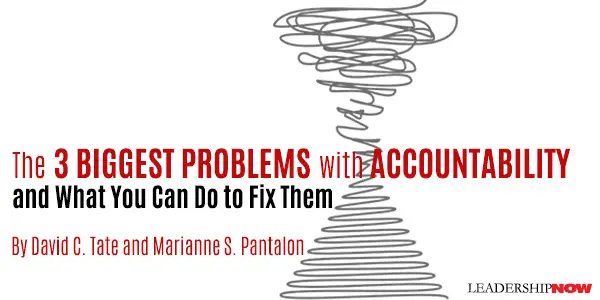
ACCOUNTABILITY is essential for human systems to function. Whether you’re talking about governments, companies, sports teams, or families, accountability is what ensures that things run smoothly and that progress continues. But oftentimes, problems exist with how accountability is understood and how it’s enacted that make it ineffective or even counterproductive. An awareness of the limitations of traditional notions of accountability can help leaders bring about a more inspiring, supportive, and transformational version of accountability. Theodore Roosevelt once said, “If you could kick the person in the pants responsible for most of your trouble, you wouldn’t sit for a month.” This humorous observation holds some truth, but it’s also emblematic of a more traditional approach to accountability — with some inherent flaws. Here are the major limitations of traditional notions of accountability: Results only: The primary goal is achieving task or performance results. Did you do what you were supposed to do? Did you hit your numbers this quarter? While results are certainly important, focusing solely on performance outcomes may lead to ignoring other, equally important aspects of what it means to be effective in the long run —things like better relationships and learning. It also yields a binary, “pass/fail” approach to evaluating outcomes, which can be discouraging and limit what you can learn from it. Focus on individuals: Traditional accountability emphasizes individual responsibility. Individual responsibility is a vital aspect of accountability, but it runs the risk of people looking at situations through the lens of themselves only and missing the larger, collective goals. At worst, it can result in people developing a “that’s not my job” mentality, which can seriously undermine morale, capacity, and results. Blame-oriented: When something goes wrong, oftentimes, the first question asked is, “Who needs to be held accountable?” This kind of backward-looking accountability focuses on apportioning blame and punishment — who needs to be “kicked in the pants?” But in the majority of circumstances, making mistakes or failing to produce are not black-and-white situations for reprisal. They can actually represent learning moments. A blame orientation induces fear and leads to people covering up problems and avoiding more robust discussions of shortcomings, resulting in lost opportunities for learning, growth, and improvement in the long run. The upshot of these limitations is that they undermine the power of accountability as a force for excellence, connection, and learning. These problems turn accountability into something that’s essentially transactional: “Focus on the result, do your part, and don’t mess up!” This approach is limited because it’s more narrow, sterile, and even fear-invoking. It leaves a lot of possibilities on the table. So what’s the solution? Here are three strategies for taking a different approach to accountability that will allow you to capture the upsides of strong accountability while sidestepping the pitfalls. 1. Focus on people and results Instead of emphasizing just the task-related outcomes you’re aiming for, make sure you also pay attention to people’s experience in working towards those outcomes. How do you want people to feel about themselves and each other as a function of their work together? How do you want people to grow during that process? And when reflecting on the question of “How well did we do?” make sure you make space to consider how team members experienced the process, how relationships were affected, and how much people learned. 2. Make accountability a team sport Broaden the frame of accountability to go beyond what individuals are responsible for to create a collective sense of responsibility for meeting the team’s goals. Talk about what that means — whether that’s covering for other team members, helping others achieve their goals, sharing information and resources, soliciting others’ feedback, and being able to see the big picture. Everyone must be accountable to themselves but also to each other, as well as shared groups of stakeholders (customers, suppliers, investors, and the public). 3. No matter what happens, look for the learning Have a growth mindset that sees failures, errors, and setbacks as important opportunities for growth. When problems occur, instead of focusing on who was at fault, determine who is responsible for improving the situation, what can be learned from what happened, and what you’ll do differently next time. Normalize the fact that things sometimes go wrong by talking about your own mistakes and what you’ve learned from them. Done differently, accountability could be something that’s transformational, creating a mindset in which everyone takes responsibility for both individual and collective goals, no one wants to let anyone else down, and people are continually learning and improving. As a result, accountability changes from creating dread and worry to promoting vibrancy, engagement, and connection.  
Posted by Michael McKinney at 07:21 AM
11.29.22

Why Managers Matter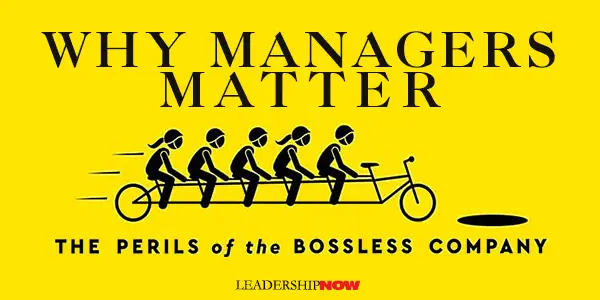
ONE OF the most important books you’ll read this year is Why Managers Matter: The Perils of the Bossless Company by Nicolai Foss and Peter Klein. Max DePree wrote that the first responsibility of a leader is to define reality. That’s what you will find here—a dose of reality. It is popular today to talk about the bossless organization and the death of hierarchy. Not everyone is fooled by the hype. The purpose of the book is to dispel the notion that hierarchy and managers are on their way out. Any student of organizational theory knows that this is a reoccurring issue making it both contemporary and relevant. Hierarchies not only work better than the alternatives most of the time but they are also aligned with our basic human nature, which, more than anything, explains why they persist. Of course, there is a great variation among hierarchies. Some people do them well, and some don’t. “Authority and hierarchy—rightly exercised—are useful and necessary for companies to thrive.” The hierarchically organized company actually emerged during a period in world history notable for radical changes in technology, a sweeping expansion of global trade, and increases in public education—namely, the period from the middle of the nineteenth century until World War I. Growth drives hierarchy. Hierarchies help to deal efficiently with complexity. And in times of great uncertainty, we need managers. “It is when something extraordinary happens that we need managers the most.” A well-structured hierarchy helps firms buffer unanticipated shocks. The author’s close examination of bossless organizations reveals that they are perhaps flatter but not really bossless. Even the outliers like Gore, Valve, Zappos, Oticon, and Semco, are not genuinely bossless organizations. There is a place for these leaner, flatter structures. Bosslessness, at best, works for a handful of companies operating under special conditions, such as small companies that carry out simple tasks—like the food processor Morning Star. Decentralized structures tend to be most effective in particular circumstances, such as where groups and tasks can be broken down into smaller independent units. Siloing, turf wars, and the like are more easily avoided when teams are organized around projects—say, building a bridge or developing a specific piece o software—rather than on the business functions such as marketing, sales, or finance. Hierarchy helps solve the universal problems of coordination and cooperation. “Coordination means figuring out what should be done, by whom, when, how, and in what quantities.” Coordination defines responsibilities and how my job relates to yours. It is about how an organization brings people together. “Cooperation is about getting them to do it, even when doing so is not in everyone’s self-interest.” These management tasks don’t just go away just because we might decide to go Bossless. “Bosses matter, not just as figureheads but as designers, organizers, encouragers, enforcers.” Decentralization and delegation are tools that managers can use when the conditions are right. They are not a unique feater of the bossless organization. It is possible to delayer, cut management roles, and give workers more discretion, though doing so does not result, of course, in a bossless company. As we have seen, such organizations normally have very powerful bosses, cliques, and other sources of authority—and even the most bossless companies have bosses who set them up and make sure the model is working. Although the authors would agree the management of people needs to change, that is not the point of the book. They cover how hierarchies have changed and how the people in them need to think about their work. We know how to manage people. We just don’t do it. And that is the key. We keep looking for some magic bullet as we look around at who or what to blame. Hierarchy is not the problem. Managers are not the problem. We are. When things aren’t working right, it is expedient to blame something other than ourselves. Inequities, engagement, micromanagement, and the like are not the fault of the hierarchy. It is the fault of people in the hierarchy—leaders, managers, and employees alike. The real value of this book to me is that it helps to take hierarchy and managers off the table so we can deal effectively with the organizational issues of the day. We can get on with the personal inner work necessary to get to where we need to be. There are no universally “best” solutions to organizational problems, only trade-offs that depend on the contingencies facing the company. Identifying and acting upon those trade-offs—not decentralizing everything, everywhere—is the key to successful leadership. 
Posted by Michael McKinney at 12:31 PM
06.24.22

Connecting Your Employees to a Higher Purpose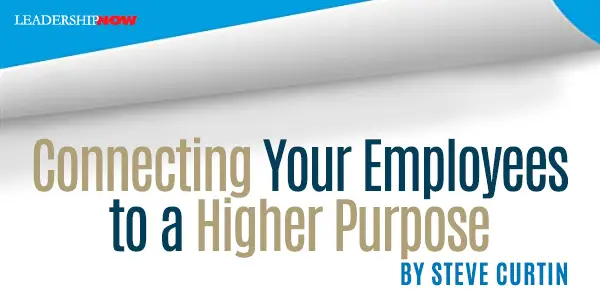
IN 2016, I had an experience while working with a sophisticated, billion-dollar technology company that, for me, was a seminal moment. I was invited to speak to a group of senior managers at the company’s annual leadership summit on the topic of connecting to purpose at work. My client and I devised a quick activity to determine how many of the 222 leaders in attendance could recall the company’s single-sentence corporate mission statement. Prior to my presentation, we distributed index cards to all participants. We asked them to record the one-sentence mission statement on the card from memory, without the aid of a smartphone or the colleagues seated next to them.. Guess what we discovered? Only 4 of the 222 leaders in attendance (less than 2%) could accurately recall the company’s pithy guiding statement. Thirty-four participants (15%) left their cards blank or answered with a question mark. One senior manager thought it was a trick question and wrote, “As far as I know, we don’t have a corporate mission statement right now.” This experience reinforced an observation that has directed my work’s focus ever since: Although organizations consistently develop corporate mission, vision, and purpose statements, leadership is inconsistently able to recall them. As a result, leaders are unable to reveal these corporate ideals to employees, connect them to employees’ daily work activities, and leverage them to inspire greater employee engagement. Start with Your Organization’s Purpose and Core Values It’s not possible to be purpose-driven if a company’s purpose hasn’t been articulated and communicated at all levels of the organization. So, the first order of business is to articulate organizational purpose followed by a set of core values.. A purpose statement, in its simplest form, expresses why the organization exists—beyond simply making a profit. It may also illustrate how your product or service positively impacts stakeholders. For example, United Airlines’ purpose is “Connecting people. Uniting the world.” This purpose applies universally across all job roles. Whether a pilot who connects passengers between points of origin and their destinations, a mechanic who keeps planes in service, or a reservations agent who facilitates complicated itineraries, all reflect the airline’s raison d'être, its reason for being—connecting people and, in doing so, uniting the world. With a purpose statement in place, you can turn your attention to the core values that guide employees’ actions and behaviors. A word of caution: Too many companies develop imitative lists of core values that are indistinguishable from those of their competitors. Most Fortune 100 companies, for example, claim integrity as a core value, and nearly half tout customer satisfaction and teamwork. While these are inarguably noble values, they don’t distinguish one company from another. Be certain that the core values you adopt reflect your organization’s unique character, culture, and purpose. Once you have a set of solid core values, you should add context to them by expanding them into value statements. These are pithy descriptions of how your organization interprets its values. Each value statement is further described by behaviors that demonstrate the value in action in employees’ real world of work. Here’s an example:
It would be difficult for an employee or vendor partner to repeatedly miss deadlines in an organization that has codified behavioral expectations related to honoring commitments. Completing this activity will immediately separate your organization from the vast majority that merely post their values on their websites and enshrine them behind framed panes of glass in executive corridors. It will also convey to employees and other stakeholders that you’ve thought about how your organization uniquely interprets and applies its values. Bring Purpose and Core Values to Life Whether your organization has a long-established purpose and set of core values or these standards have recently been put into words, the next step is to consider how to transfer these ideals from corporate headquarters’ ivory tower of theory and abstraction to employees’ real world of work. Think back to the senior managers who attended my client’s annual leadership summit: less than 2% could recall the company’s one-sentence mission statement. This figure was so low because company leaders were disconnected from the organization’s purpose. It was too far removed from the reality of their workdays. And if they were distanced from it, then you can bet frontline employees were equally aloof. The mistake this company made was assuming that crafting a mission statement and set of core values, inserting them in the employee handbook, and posting them on the corporate website meant they were done. Not true. It’s a bit like buying a Peloton exercise bike and a keto diet cookbook, displaying them conspicuously in your home, and not using them. Nothing will change unless you act. Link Corporate Ideals to Employees’ Daily Responsibilities Supervisors, managers, and leaders must build a bridge between an organization’s purpose and values and the actual work assignments employees are paid to perform. This is accomplished by incorporating purposeful actions and behaviors into daily work activities. Here are some examples:
It’s not enough to articulate your organization’s purpose and core values. You must bring these guiding principles to life by revealing them to employees, clarifying their meaning, and labeling behaviors that support these ideals. Next, incorporate specific actions and recommended behaviors into the processes that govern employees’ daily work. You’ll yield greater employee engagement, higher customer satisfaction scores, and employees at all levels of the organization who are genuinely connected to a purpose.  
Posted by Michael McKinney at 08:34 AM
04.08.22

Pitch Like Hollywood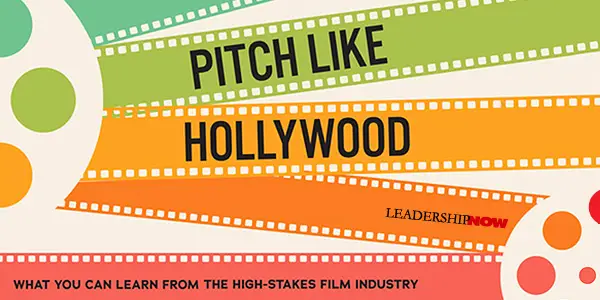
HOLLYWOOD is a tough place to pitch. In Pitch Like Hollywood, clinical psychologist Peter Desberg and writer/producer Jeff Davis take us inside to understand the process. “Hollywood has its own form of pitching,” they write. “It employs the traditional elements of pitching used in business but adds other elements to make it more persuasive and emotionally engaging.” Hollywood pitches use characters and conflicts to tell stories that leave audiences needing to know more, Hollywood artists have been pitching the same product for over a hundred years. Give creatine people a quick hundred years, and it’s not surprising that they develop a unique type of pitch. And we can learn from that and incorporate it into what we do every day to influence others for better outcomes. In a world where not-so-good ideas are being listened to way too much, we need a better way to get our ideas heard (provided they are good ones!). A pitch is when you are trying to promote an idea, a business project, or a script. It is the essence of influence. The pitch is a solution to a problem. If you don’t have a problem to solve, there’s no need to pitch. But you are not trying to sell. You are trying to start a conversation. The best pitches use a three-act structure. The pitch should have a hook and a logline. A hook is designed to grab your attention. They are short, engaging, memorable, and unusual. The logline is a short description of the idea you’re presenting. It introduces the protagonist and the antagonist, introduces the main conflict, and gives a hint of the arc. At first blush, it may seem like pitching a story is very different than pitching a business idea. A Hollywood pitch begins by presenting the world as it is: “What products in your field already exist? What service do they perform well? What don’t they do? What are they missing? With this last question, you are laying out your idea in context with the accompanying challenges and problems involved in implementing it.” In Act I, present the “setting for the problem or situation that your idea will solve by providing two key pieces of information. First, you want to orient your audience by laying out the problem area your project will resolve. Second, you introduce the source of conflict. This lets your audience know what problems must be overcome and stimulates their curiosity making them want to hear more.” Act II “deals with previous attempts to resolve the conflict, laying out the problems that were encountered. The emphasis is on problems rather than solutions, making it appear that it’ll be difficult to work things out. The goal is to maximize the audience’s curiosity and add a bit of surprise. Act III “ties everything together. You demonstrate how the conflict is resolved, and your audience hears your data in context as the solution to the problem you introduced at the beginning. If you’ve done your job well and told a great story, your audience will want to see your business plan.” The goal of pitching is collaboration. If you give too little or too much detail, you don’t allow others to get in on it. “When you’re pitching an idea, try to draw people into it. Encourage them to contribute their ideas and show enthusiasm for those ideas. It’s a sign that they’re stimulated by your ideas and want to get involved.” The former president of Hughes Entertainment explains how to avoid excessive detail this way. Imagine you’re at the coffee machine talking to your coworkers on Monday morning telling them about this great movie you saw over the weekend: You’re sharing the cool things about the movie you saw. The things that caught your imagination; the things you remember. You’re sharing the excitement. For me, that’s the key to pitching. If you start throwing in too many details your coworkers will duck for cover on Monday mornings when they see you walking down the hall. When you are called in to give your pitch, and they begin with, “Tell me a little bit a bit yourself,” you don’t want to start reeling off facts about your life. “It shows a considerable poverty of imagination.” Instead, you want to start a conversation, not rehash your credits. In creating your elevator story, it is important too, to know what to leave in and what to leave out of your pitch. A man and a woman are chatting at a cocktail party. The man asks, “What do you do?” To get into the minds of your listeners, when presenting something—especially something new—you need to connect it with something they already know. “The more original your idea is, the tougher it may be to sell, because there isn’t a precedent to show it can work. Improve your pitch by using a similar context and examples of successful precedents, but also by showing the point of departure.” The authors cover the psychology and art of persuasion and the panic that can set in before the presentation, the stage fright you feel when presenting, with informative expert examples and exercises to help you work through the issues. 
Posted by Michael McKinney at 10:10 AM
03.07.22

Redefining Ambition and Career Development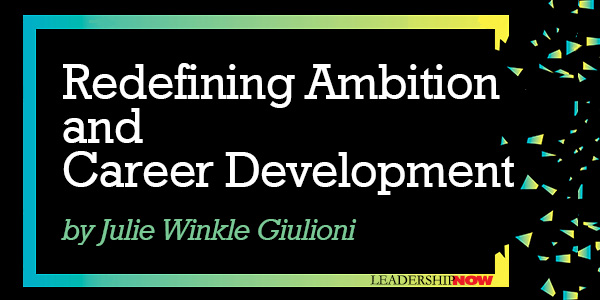
MANY definitions of “leadership” exist; but the ones that always resonate for me involve an element of bringing people along, helping them grow and progress, facilitating the development of them as people and their careers. And I have the feeling that similar definitions are deeply held by many leaders – especially given the frequency of one question I’m asked over and over: “What should I do with my ‘I’m good where I am’ employee who lacks ambition, doesn’t seem to want to grow, and is completely disinterested in moving up, over, or anywhere?” My answer to these leaders – who can’t help but feel that they’re shirking their responsibility if they aren’t motivating people to aspire to more – often is, “celebrate them… then get right to work challenging your own career development mindset.” It’s easy to impose our values, priorities, and aspirations on others. But the truth is that we each have a unique definition of what success looks like and how to achieve it. Appreciating and acting upon these differences is key to unlocking potential, motivation, and growth – even with those who appear outwardly disinterested in career development. And doing this involves going deep and wide – deep into understanding the individual and wide in terms of expanding your definition of career development. Understand the Individual Let’s face it, employees may be satisfied where they are for any number of reasons. Perhaps they’re deeply self-aware. They know what they’re good at, what they’re interested in, and what they love. Maybe they’ve found a comfortable niche within which they experience a sense of purpose and meaning. They might have figured out how to make work fit within their broader lives and other priorities. Or maybe they’ve gotten a glimpse into the headaches that you and other leaders experience on a regular basis and have consciously decided to take a pass. Disinterest in moving up doesn’t mean someone is unambitious; it simply means the leader needs to become more interested in understanding what’s important to the person and where their ambitions lie. Expand the Definition of Career Development When leaders engage with employees in candid conversations aimed at deepening their understanding of the individual, they frequently discover that the problem isn’t that these people lack ambition. Instead, it’s that we all have lacked the language – concrete ways to talk about career development – that aren’t inextricably connected with promotions, positions, and moves which don’t interest all employees. Careers and development are far bigger than the traditional trajectory up the org chart. Many employees recognize that careers operate between and beyond the artificial markers of new positions. One’s current role can become a rich sandbox for continuous growth… if we reframe the conversation and introduce seven other dimensions that are deeply meaningful to people who may not want to go anywhere but would welcome the opportunity for growth in place. Research I conducted for my new book, Promotions Are So Yesterday, suggests that there are seven other development dimensions that offer more interesting ways for employees to grow the than the classic climb up the corporate ladder. They include:
These seven dimensions offer leaders who are committed to ensuring that everyone grows the tools they need to facilitate meaningful development – even with those who have little interest in promotions. For instance, a new role is not required to introduce interesting and meaningful challenges into someone’s work life. People don’t need a different title to expand their network and learn from and through different people. A position change isn’t a pre-requisite for changing up one’s work to offer greater value or contribution. Employees don’t have to go anywhere to experience the powerful learning that comes along with making greater or more complex decisions. And the good news is that these seven dimensions – unlike promotions – are completely within your control. You and the employee can agree upon countless ways to tap their interests, motivations, and ambitions with development opportunities that are available right within their current role. So, if you’re a leader who measures your success by the growth of others, these seven dimensions will help you promote career development without promotions. Unlocking new possibilities may turn some ‘I’m good where I am’ responses into ‘I’m ready to get even better where I am!’  
Posted by Michael McKinney at 07:38 AM
02.16.22

Coaching Your Employees for Influence and Impact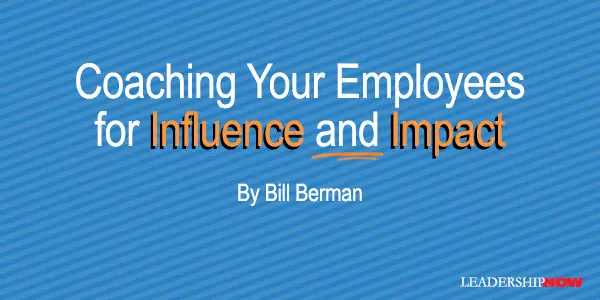
WHETHER you are a leader of a small team or the leader of a whole business, one of the key roles for any manager is the same. For you to be successful, your people—one, ten, or ten thousand—need to be successful. Our guidance in Influence and Impact: Discover and Excel at What Your Organization Needs from You the Most is intended to help you with your direct reports or your skip-level reports (one layer down). As Elizabeth Ling Decitre said to me, “After 23 years of work…when I look back…what I remember and get the most joy from [is] the team members I have helped finding the right career track or helped to get more pay for their great work, or conversely, those fewer I have pushed gently to find a more suitable career. Each time, it was a lot of time and intense discussions, but it was always worth it.” The same guidance applies even if you are focused on someone deep in your organization. Help them to understand what the job entails and what the culture expects so that they can do the work you need from them the most. Our fundamental premise is consistent throughout the book: Many people who are struggling in their job are not focused on the most essential, mission-critical business and cultural priorities that give them the most influence and impact. They may not even be aware of what those are! This drives how they spend their time, how they think about their job, and how they do that job. And just as important, the way they do their job is inconsistent with the culture and mores of your organization. How managers can help their people is a book in itself. What follows are a few points from our chapter for leaders: Some bullet points on how you can help your people excel and shine, to your benefit, and your organization’s benefit. Most of what we are describing in this chapter can be summed up as “Coach more than supervise.” Managers acting as coaches to their team members is first and foremost an act of respect, which engenders respect. It is a core behavior of a high-performing executive. It is how you help others evolve, using your confidence in them to bring out their best:
Remember that leaders and managers succeed when their people are engaged, empowered, and focused. Helping your team members develop their influence and impact is the best way for you to expand your own influence and impact. The time devoted to helping them will return your investment multiple times over.  
Posted by Michael McKinney at 07:59 AM
06.08.21

We’ve Coached Over 1 Million Supervisors … Here’s What We Learned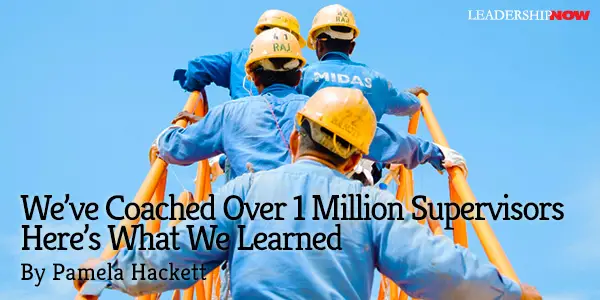
WANT A WORKPLACE with fewer accidents? Want to achieve better results? Perhaps your boss wants to avoid the 75% to 80% failure rate that plagues company transformations. You’ve probably heard the stats: only 25% of business transformations cross the finish line. No matter how big or small the change you want to make, if you’re a team leader, it all comes down to you. That’s a little different than what our guts tell us, right? It’s easy to point the finger at top leadership—it starts with them. The CEO needs to be leading the parade, setting the vision, and pointing the way. Well, yes, she does. But that’s not enough. And then there’s the view that if you properly scope out what needs to change, you’ll get there. After all, aspiration—the “what”—is as important as the “how” when you want to make big change. That’s true, too. But it’s also not enough. While the last decade has flattened our organizations and reduced the need for some managers, the need to create leaders at every level has never been more necessary. Not to supervise but to build great workplaces that work for people, not against them. We need frontline leaders to help workers bring their best selves to work each day, to find out what’s holding team members back and how to address it. We need connected managers to create community and spark collaboration. Essentially, we need these leaders to engage, enable, and energize the people on their teams. And it starts with really understanding the role of the frontline team leader. An Eye-Opening Revelation That’s been one of the most eye-opening revelations for many of the supervisors we’ve worked with over the past few decades. After conducting a few million DILOs (Day in the Life of) across 30,000 organizational operations assessments, we found one thing in common. Those who get out on the floor where the work gets done, who spend time with their teams, who listen and learn about the people and ecosystems that make up their workplace, make better decisions. When supervisors actively engage their team members—getting out of their offices and lifting their noses from their reports and devices—their teams are more productive, often safer, and their businesses are more profitable. Supervisors hold the success of a business in their hands, and it’s all in how they manage. Put simply: those who don’t engage their people don’t do well. So how do you engage well? Here are a few pragmatic solutions to get you started:
When you recognize that nothing moves until your people move, it’s clear that it’s the supervisor’s job—their primary purpose, in fact—to move their people to move. A supervisor’s or manager’s presence is key to results, transformations, and safety in the workplace. If you want to be a great leader, you must first manage to engage.  
 
Posted by Michael McKinney at 03:44 PM
04.27.21

The FBI Way: The Seven C’s of Excellence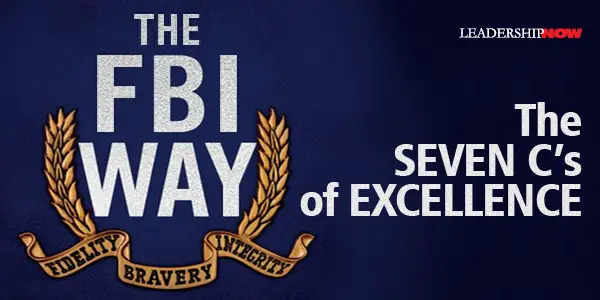
THE Federal Bureau of Investigation is a respected American institution that had its beginnings in 1908. Its 100-plus years of exceptional performance, the former head of counterintelligence Frank Figliuzzi says, is attributed to the organizational code that demanded internal excellence at all times, from everyone. He calls it the FBI Way. In The FBI Way: Inside the Bureau’s Code of Excellence, Figliuzzi organizes and explains that code and how it is maintained as The Seven C’s. These seven values are worth considering in any context. 1. Code The code reflects the core values that are shared by everyone in the organization. If you haven’t established basic behavioral benchmarks in your business, organization, team, or family, you should. They don’t have to be numerous; in fact, they shouldn’t be. Too many rules can very quickly turn into no rules at all. Determine what type of conduct so undermines whatever you or your group stands for that it poses an existential threat. Communicate those “danger zones” clearly and frequently. The FBI, as an institution, enforces code and investigates deviations from that code—the U.S. Constitution and the criminal code. Living out their own code becomes critical to that process, especially in a political environment with really no code. You can’t live by two codes at once. You also can’t spot and avoid the kinds of codes and conduct that threaten your values if you never even develop a strong sense of what it is that you value. You’ll never see the threat coming. We might not die from an absence of code, but regardless of who we are, our lives and livelihoods are enhanced when we know what we stand for. 2. Conservancy The FBI is a conservancy. I like his terminology here. Like stewardship, conservancy is “a collective effort to preserve and protect the true worth of a place or thing. People in conservancy agree to become stewards accountable for sustaining an entity greater than themselves.” Accountability is key here. And everyone in the FBI is accountable to someone, and the higher up you go, the more accountable you are. He briefly mentions the missteps of Jim Comey in 2017. Comey cast doubt on the FBI when he allowed himself to be drug into the political drama of the time. It’s human, but Figliuzzi says it basically came down to the fact that he forgot who he was accountable to. It is hard not to become political, even when writing a book such as this, but it is critical to the FBI’s credibility that it is not seen as political. As Figliuzzi advises later in the book, “Sometimes taking a broader view of your mission can help you preserve your values.” Figliuzzi notes that families need conservators too. And his wife filled that role. 3. Clarity Clarity applies in a number of ways. Clarity includes “bright lines;” Those lines, that when crossed, get you fired. Clarity of code. The need for clarity of information for decision making and the clarity to know when you have enough or all you are going to get. “You need to know when to demand clarity and when to just walk away.” And there is the clarity of purpose and principle that help you to know when to say yes and when to walk away. Too often, when organizations have their most important standards challenged, they engage in a cost-benefit analysis to decide whether to defend their core values. Those organizations don’t recognize that standards worth defining are standards worth defending. 4. Consequences There should be no surprises when it comes to consequences. A code must have repercussions when it is violated, or it is just “window dressing.” A code that’s not enforced quickly becomes a lie that undermines your entire operation. You can’t just wish a code into compliance; people need to understand that there’s a price to pay if they endanger the collective health of the larger team. Consequences put teeth in a code. 5. Compassion A code without compassion doesn’t work for long. Compassion and consequences go hand-in-hand. Sometimes compassion means looking in the mirror to see how you or a dysfunctional system lead to the poor judgment or wrong behavior. Compassion provides the necessary balance to what could be an otherwise harsh and cold process. As sure as people need to know that their leaders have set bright lines on conduct, they also need to trust that those leaders will treat them as valued human beings. That’s why good leaders take a holistic approach to weighing consequences by assessing an employee’s total record, the context that led to their lapse, and that team member’s capacity to overcome their wrongdoing. 6. Credibility Credibility is the bedrock of a values-based organization or group. And that applies both within the organization and about the organization. “People must believe in us and the values we represent. It is credibility that determines whether values survive beyond the personalities of individual leaders.” Credible preservation of principles happens when the process is codified, objective, and comprehensive. Codification means the process must not only be in writing but also easily accessible, understandable, and taken seriously. 7. Consistency Consistency is about intentionality. It helps to preserve what really matters. There was a beauty and simplicity to establishing a rhythm that went beyond mere routine. I’m talking about developing a system in your life, your work, or your studies, and sticking with it if it works, or tweaking it if it doesn’t. A consistent system. Not just winging it. But as Figliuzzi points out, that shouldn’t be confused with rigidity. Consistency may mean, at times, redefining “your entire approach in order to remain consistent with your values,” as they did after 9/11. Change shouldn’t be something that happens “to” people, it should be something that happens “with” people. It’s crucial that everyone involved understand that adapting doesn’t mean an abandonment of values or mission. To the contrary, the proposed changes must reflect how those changes are not only consistent with your values but vital to preserving them. He observes that the “FBI’s highest-profile mistakes happen primarily when its leaders act contrary to their own rules.” So build in systems that make it harder to fail. Woven into the explanation of each of these qualities are stories of 9/11, interstate chases, Quantico, anthrax, espionage, counterterrorism, homicides, and much more to illustrate his point. The FBI Way is a very profitable and interesting read. And well worth your time for the principles that are applicable anywhere. 
Posted by Michael McKinney at 11:22 PM
04.19.21

What You Do Is Who You Are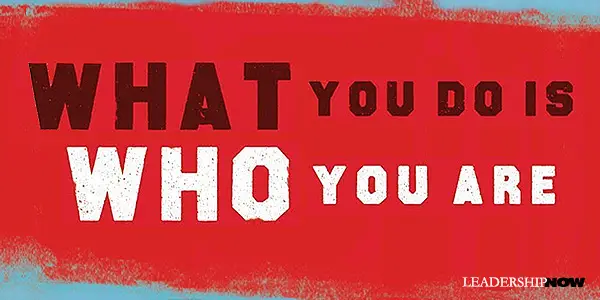
IT HAS BEEN SAID that culture is the most important thing because it determines how your company makes decisions when you’re not there. This led Ben Horowitz to ask, how do you create and sustain the culture you want? He turned to three historical figures and one contemporary that were “outstandingly effective in getting the culture they wanted.” He wasn’t so interested specifically in the culture they produced but what they had to do to change themselves and their culture. In What You Do Is Who You Are, Horowitz looks at the lives of four cultures created by their leaders: Toussaint Louverture, the Haitian slave that led the only slave revolt in human history. The samurai who ruled Japan for seven hundred years and shaped modern Japanese culture. Genghis Khan, who built the world’s largest empire. Shaka Senghor, and American ex-con who created the most formidable prison gang in the yard and, ultimately, transformed prison culture. Companies—just like gangs, armies, and nations—are large organizations that rise and fall because of the daily microbehaviors of the human beings that compose them.
1. Make sure your culture aligns with both your personality and your strategy. How do you know when something is wrong with your culture? Horowitz point to three indicators: The wrong people are quitting too often, you’re failing at your top priorities, and an employee does something that truly shocks you. Some final thoughts: The best way to understand your culture is not through what managers tell you, but through how new employees behave. What behaviors do they perceive will help them fit in, survive, and succeed? By the way, Peter Drucker’s statement that “culture eats strategy for breakfast” actually speaks the exact point Horowitz is making: “What you do is who you are.” If your culture isn’t aligned with your strategy, then culture rules the day. In the long run, a strategy not supported by culture falls flat. Execution works in concert with culture. 
Posted by Michael McKinney at 08:44 AM
01.15.21

Culture Renovation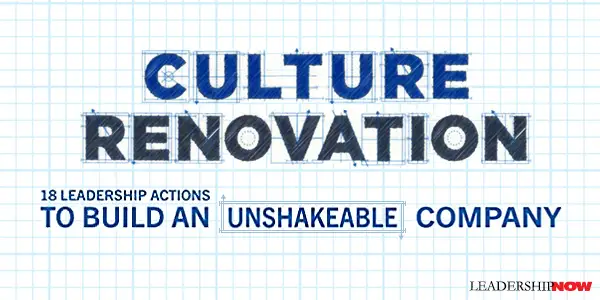
WE hear a lot about changing the culture. And the successful are more like renovations than they are like rebuilding the culture. Kevin Oakes advocates that mindset in Culture Renovation: 18 Leadership Actions to Build an Unshakeable Company Companies that effectively changed their cultures were successful because they were renovating what they had, not starting from scratch and completely rebuilding or transforming. Furthermore, he notes that the best time to renovate your culture is when all is well. Rarely do companies set out to change their culture when everything is calm and running smoothly, even though that is probably the best time to do it. Making the point that culture renovation begins at the top he replays the appointment of Satya Nadella as CEO of Microsoft after Steve Balmer in 2014. Cultural change at Microsoft began on day one. The key change was instilling a growth mindset. Microsoft’s culture had been rigid. Each employee had to prove to everyone that he or she was the smartest person in the room. Accountability—delivering on time and hitting numbers—trumped everything. Meetings were formal. If a senior leader wanted to tap the energy and creativity of someone lower down in the organization, she or he needed to invite that person’s boss, and so on. Hierarchy and pecking order had taken control, and spontaneity and creativity had suffered as a result. The culture change I wanted was actually rooted in the Microsoft I originally joined. The culture change I wanted was centered on exercising a growth mindset every day. The turnaround at Microsoft has been remarkable, and it started at the top. Oakes offers an 18-step culture change blueprint organized equally into three categories: Plan, Build, and Maintain. PLAN Step #1: Develop and Deploy a Comprehensive Listening Strategy. “Before an organization embarks on a culture renovation, it needs to first understand how the current culture is perceived. Too often, the senior team assumes they know what the culture represents. Too often, they are dead wrong.” Step #2: Figure Out What to Keep. Know what stays and what goes. Listen to employees (Step 1) is so important because “it not only illuminates what the culture is today, but it also helps determine the most positive and valued aspects of the company’s historical culture to carry forward.” Step #3: Set Your Cultural Path. “In the spirit of renovation, the new direction should acknowledge and embrace past successes, but set up the organization to forge new ground into an unknown future.” A carefully crafted purpose statement. Step #4: Define the Desired Behaviors. Once you have a short, pithy, and memorable purpose statement, the question is what behaviors will best support that statement. Step #5: Identify Influencers, Energizers, and Blockers. Know the informal organization using an organizational network analysis. Step #6: Determine How Progress Will Be Measured, Monitored, and Reported. “Ultimately, the reason for a culture renovation is to enable the organization to execute on its go-forward strategy. Because this change can sometimes take years, it’s important to define upfront what the indicators of a successful renovation should be, and to put in place mechanisms to monitor progress.” Oakes offers a number of common measures and methods. BUILD Step #7: Clearly Communicate That Change Is Coming. “To kick off a culture renovation, the CEO must articulate the purpose of the organization (whether new, old, or renovated), and that purpose must resonate with employees.” Step #8: Ferret Out Skeptics and Nonbelievers Early. This is the hardest step. “It’s the consistently de-energizing people that ultimately slow down or take down cultures. Ferret them out as early in the renovation as possible.” Step #9: Paint a Vision for the Future. The story matters. “73 percent of successful change efforts relied on stories.” A go-forward vision of the future. Most CEOs of corporate change failure attack previous leadership and focus their messages on the past. Step #10: Consciously Collaborate. Strong internal collaboration is important to drive change. The group must understand why they are coming together and what they are doing. Collaboration can go too far as in the case where “connectivity is through the roof because everyone believes they need to be consulted on decisions.” Step #11: Establish a Co-creation Mindset. “Though almost all successful culture change efforts begin top-down, it is critical to also get the buy-in of the workforce by creating a bottom-up (and middle-out) contribution mechanism.” Consider a Culture Hackathon. Ford “held a two-day event where employees worked in randomly selected teams to generate ideas to either fortify elements of the culture they loved or fix elements that weren’t serving the company well - #hackFORDculture. Step #12: Provide Training on the Desired Behaviors. Train leaders at all levels on the desired behaviors so that they can model them. “While leaders as teachers is one of the most effective ways to reinforce behaviors, it’s clear that successful culture change relies on overall leadership training across the organization.” MAINTAIN Step #13: Make Onboarding About Relationships Versus Red Tape. “If you want to maintain that culture renovation you worked so hard to put in place, you can start by improving your onboarding process.” The most overlooked aspect of onboarding: “Helping the new hire establish a network of trusted subject matter experts who will contribute to that person’s career success.” Step #14: Promote Those Who Best Represent the New. Behaviors that support the renovated culture should be rewarded. Showcase the “career advancement of individuals who best represent the new.” Step #15: Change Performance Management Practices. Most important is the “frequency and usefulness of feedback, clearly defining the business purpose of the performance process, and aligning it with the culture and values of the organization.” Step #16: Leverage Employee Affinity Groups. Interestingly, their research found that two-thirds of companies felt Employee Resource Groups were “more effective than other leadership development forums at developing leadership skills and competencies.” An ERGs primary benefit is to “raise awareness of the different groups of people that make up the workforce of most organizations.” Step #17: Increase the Focus on Talent Mobility. “During a culture renovation, one of the most successful talent initiatives an organization can focus on is rotating talent to strengthen ‘the pack’ and ensure the desired behaviors are exhibited throughout the organization.” Step #18: Don’t Underestimate the Value of External Sentiment. Use external feedback from places like Glassdoor, LinkedIn, and social media to monitor the progress of efforts to renovate your culture. Culture Renovation is less theory and more how to. You will find case studies and interviews with the participants of successful culture change. 
Posted by Michael McKinney at 07:35 AM
03.16.20

Leading with Gratitude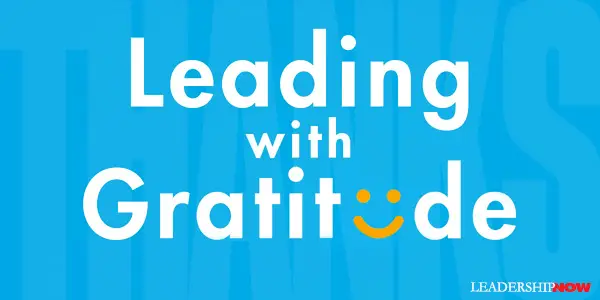
GRATITUDE increases our leadership effectiveness as drives out fear and blame, gives meaning and confidence to all, and boosts productivity. We all know this, yet still, we don’t place as much emphasis on gratitude as we should. We withhold gratitude when we should be expressing it not just for their good but for our own good as well. Gratitude is more than saying thank you. It goes beyond nice. It is an approach to life. Adrian Gostick and Chester Elton say gratitude is “one of the most misunderstood and misapplied skills in business.” When it is genuine and specific, it is the “easiest, fastest, and cheapest way that managers can boost performance and employee engagement.” In Leading with Gratitude, the authors uncover what holds us back from showing gratitude and what we can do about it. They begin by taking a look at the seven most common reasons we avoid showing gratitude. They call them the Ingratutide Myths: fear is the best motivator, people want way too much praise these days, there’s just no time, I’m not wired to feel it, I save my praise for those who deserve it, it’s all about the benjamins, and they’ll think I’m bogus. They debunk each of these with stories and studies. I’m Not Wired That Way We’ve all probably had a few of these myths run through our minds from time to time, but I want to call out one of the myths: I’m not wired to feel it. While we are born with predispositions—warmer or colder, more sensitive to positive or negative circumstances—they are not life sentences. Gratitude, like other character traits, is a matter of choice. We should have developed it from example in our youth, but as we know, that doesn’t always happen. But it is learned. Through practice, we can wire our brains to express gratitude. It becomes a matter of choosing to move beyond our comfortable predisposition towards an approach to life that better serves us as leaders. Seeing and Expressing The last two sections of the book focus on four ways of seeing and four ways of expressing gratitude. Seeing is about awareness. The best leaders know how people contribute and actively look for reasons to express gratitude. It is about seeing good things happening and then expressing heartfelt appreciation for the right behaviors. On the flip side, managers who lack gratitude suffer, first and foremost, from a problem of cognition—a failure to perceive how hard their people are trying to do good work—and, if they’re encountering problems, what they are. These ungrateful leaders suffer from information deficit. Other practices for seeing include assuming positive intent (seeing people as trying to do well), walking in their shoes (understanding the challenges your people are experiencing), and looking for small wins (motivates us for the next step). Expressing, of course, is how to express gratitude. We all need regular feedback. “Timeliness of gratitude communicates that a leader is paying attention, and that giving credit when it’s due is a priority in his busy world.” Like ripe bananas, gratitude does not keep. The closer to an achievement a leader expresses her appreciation, the better. When it comes to expressing, tailor it to the individual. People have different motivators. Giving gratitude helps reinforce the organization's core values. “Gratitude offers an opportunity to put the flesh of specificity on the bones of core values.” Encourage peer-to-peer gratitude. It demonstrates support and builds bonds. “When employees are grateful to each other, they affirm positive concepts typically values in their colleagues, such as trustworthiness, dependability, and talent.” Living Gratefully When we begin to practice gratitude, the goal is to live gratefully—to make it part of who we are. Gratitude then extends to everyone in our lives. It is not just something we do at work to increase productivity, but we take it home and express it to those people that mean the most to us. If we practice gratitude with all the people in our lives, we’ll find that they respond just as well as our employees. When we give our family, friends, and all those we encounter a lift, we also give ourselves more moments of joy. One of the great ironies of personal relationships is that we so often take those who mean the most to us for granted. Adrian Gostick and Chester Elton share example after example of the often creative ways that leaders and organizations that are doing it right show gratitude. We can all begin to live life more gratefully and receive positive results that exceed our efforts. 
Posted by Michael McKinney at 11:44 PM
11.25.19

Hiring for Cultural Fit
ORGANIZATIONS OFTEN TALK about hiring for cultural fit, yet very few of them know how to do it well. This is mostly because they haven’t taken the time to define their culture and, therefore, there’s nothing to hire against or fit into. Instead, a standard set of questions, technical skills, qualifications, and psychometric testing are used in the hope that the right candidate lands in their lap. Where time, money and effort has been invested to define the organizational culture, it’s imperative to use what that definition to bring in the kind of people who will contribute to it, rather than hold it back. The hiring process isn’t an exercise in finding someone with a pulse to fill a position. It’s an opportunity to bring in an individual whose values, intention, mindset, and ambition match that of the organization. Quite often, the most qualified person isn’t the right person for the culture you’ve created. However, it may take one, two, or seven interviews to determine that. In order to ensure that a force for good is added to the organizational culture, time needs to be taken to execute the hiring process well. That way, the person fully understands what’s expected to fit into the culture and the environment in which the work gets done. When the new hire meshes well with these expectations, unnecessary performance management time is avoided. Case studies of how to hire for culture successfully Tony Hseih, CEO of the online shoe retailer Zappos, once famously said that he didn’t know anything about shoes, but knew a lot about creating workplace culture. Zappos has a very well-defined recruitment and induction process, which it calls The Zappos Family New Hire Program. It’s not a rubber-stamping probation period, but a values fit assessment. Every new hire, regardless of role or department, goes through the four-week program, which combines technical training and culture immersion. In the end, the employee has full knowledge of what the organization stands for and how it does business, and the organization can assess the mindset of the individual and how he or she can contribute to Zappos’ values. When hiring at Slack, CEO Stewart Butterfield looks for humility and an acknowledgment that luck has played some part in the job prospect’s success. He also places great emphasis on diversity: “If you don’t have people who come from different backgrounds and experiences, you’ll miss out on meeting the needs of groups of customers.” Ben Kirshner, former CEO at Elite SEM and now Chairman of the Board at Tinuiti, said he’s very particular about who he brings into the culture. , means interviews, on core values. Using an example of having an attitude of gratitude, he explained, “The hiring team will ask candidates a lot of questions to gauge how grateful a candidate is -- how much they appreciate others and how much they give back.” If organizations such as Zappos, Slack, and Tinuiti hired people who didn't share their values, then their culture would become stagnant very quickly as these people would drag others down. Just because they’re qualified doesn’t mean they’ll fit To hire for cultural fit, it’s critical to assess not only an interviewee’s technical skills but also how well the values, emotional skills, and aspirations complement the organization’s culture. To uncover those attributes that can enhance company culture, apply these hiring strategies: 1. Use the organization’s vision statement as a hiring tool. Part of defining company culture is creating an inspirational statement of intent that generates the impetus for moving beyond the status quo. The vision statement can also become a tool for hiring as you determine whether the individual will improve the organization’s chances of achieving its vision. People are often attracted to cultures based on their aspirations. It’s a great way to check that potential employees share the same dreams and understand the agreed-upon ways of working together to realize them. 2. Look beyond a candidate’s skills. While skills may get them an interview, the candidates’ emotional intelligence should be a determining factor in who gets the job. That means the interview should be structured to ensure that emotional intelligence is something you uncover. One valuable question to ask is, “Tell me about your biggest failure.” Being able to admit fallibility is important in a collaborative environment. Also, the best candidates will share how they’ve adapted or changed from the experience. 3. Tailor questions to find out a person’s values. The aim of the interviewing process is to separate those that understand what they stand for from those who just want a job and will say want they think the interviewer wants to hear. Ask candidates to describe their values and how they live them on a day-to-day basis. Include questions around how the candidate would apply the organizational values and remain resilient in stressful situations. 4. Investigate cultural fit. Understand the personalities and skillsets that you already have on board. Once you know your team, and you’ve collectively developed your defined culture, you can look for someone with the right values, personality, and skills to fill the gaps. Hiring any member of staff, regardless of whether they’re permanent or contract, shouldn’t be rushed. If you don’t want to undermine the culture that you have, then it’s important to take the time to find someone who will add to it. Those people will fit like a glove. 
Posted by Michael McKinney at 08:33 AM
11.13.19

5 Steps to an Aligned and High-Functioning Organization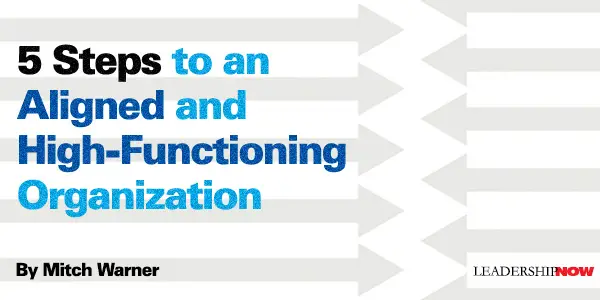
IN OUR WORK training and consulting organizations across the globe, we have found misalignment to be at the heart of most organizational dysfunction. People assume the organization’s goals are clear to everyone and that employees’ roles and priorities are aligned to support those goals. However, most of the time they’re not. This misalignment causes all kinds of problems. Managers get upset because the things they think are important aren’t getting done. Employees get upset because they’re not getting the support they think they should be getting. And massive amounts of time and energy are wasted as a result. It’s not that anyone has ill intent. It’s just that they haven’t aligned on goals, roles, and priorities. Here are 5 steps to create this alignment in an organization: 1. Lead the shift to an outward mindset No leader, no matter how brilliant their argument or how pressing the bottom line, will be able to enable alignment in an organization that’s locked in an inward mindset. With an inward mindset, we are self-focused. We see only our own needs, challenges, and objectives. By contrast, an outward-mindset culture enables all to envision and pursue a collective result. With an outward mindset, people focus on achieving their goals in context, with a clear understanding not only of how their actions contribute to collective results but also how they are impacting others’ abilities to contribute. As a leader, you need to spearhead the shift to an outward mindset by focusing on the collective result, your role in it, and how you’re impacting others. As you honestly hold yourself accountable for your impact on others, you model that change—and walking the walk will invite people to follow your lead. 2. Lead your teams’ shift to an outward mindset Too often, people in organizations primarily identify around their separate, individual roles. With an outward mindset, teams and team members break free from the constraints of self-focus and are able to see options that would not otherwise occur to them. The basic ways they see the world are different: with an inward mindset, people tend to see each other as objects; with an outward mindset, they see each other as people. Instead of acting in ways calculated to benefit or justify themselves, they take into account their impact on others and adjust their efforts to be more helpful. They consider others’ needs and behave in ways that further the collective results they are committed to achieving. 3. Articulate the collective result An organization needs to be explicitly organized around a result in order to achieve it. Take the case of Gregg Popovich and the San Antonio Spurs. Not surprisingly, this NBA team and their coach are all about championships. And winning a championship isn’t yet the kind of objective that sets up an organization to work in an outward-mindset way. Chasing that dream can be done in inward-mindset ways as well. But Popovich led his team to shift to an outward mindset in order to better achieve a specific collective goal: winning through ego-less teamwork—a result that requires everyone to be all in. This collective goal informs how they pursue each championship, and the results tell the story. The team appears to operate as a single organism on the court, with no ego on the floor that would prevent the most advantageous moves. This approach also means the team can prevail despite personnel changes. 4. Show people how they play a role in the collective result Wherever people are organized together, a collective result already exists, just waiting to be named, collaborated around, and worked toward. But people need to grasp the importance of their own roles in the overall collective result and see how their work will contribute to the end results. When people not only understand the collective goal but have a clear sense of their own importance in it, they have the clarity and confidence to act on their own initiative. 5. Ask these questions Invite people at all levels of the organization to ask the following questions. These questions will help everyone redefine their own role in achieving the collective result, and accelerate the shift to an outward mindset. • Toward my manager: Do I have a clear understanding of my manager’s objectives? What can I do to learn about them? What do I need to do to make sure I am holding myself accountable for my contribution to my manager’s results? Who do I need to work with to ensure that I help my manager achieve those results? • Toward customers: Who are my customers, and what objectives do they have that I could help with? How will I measure whether they are, in fact, helped by my efforts? • Toward peers: Which of my peers are affected by my work? What are their objectives? Do I know whether I am helping or hindering them in their ability to accomplish their objectives? • Toward direct reports: Are my direct reports growing in their abilities? Have I worked with them to set a collective result for the entire team, and do they understand how they contribute to that result? Do they understand how their work impacts the ability of others to make their contributions to the collective result? And are they holding themselves accountable for that impact in each of the directions of their work? What can I do to help them to do this? By clarifying the collective result, leaders encourage individuals and teams to improve their contributions within the organization—without waiting for directives from those with a broader view of the organization’s interconnected parts. Equipped with this understanding, people don’t need someone else to align their roles relative to others. They can do it themselves. They know how their actions contribute to accomplishing the collective result and can constantly adjust to achieve a better outcome. They decide to be this kind of contributor—and that’s when the true power of teams is unleashed. 
Posted by Michael McKinney at 08:39 AM
07.10.19

How to Be an Engaging Leader in a World of Robotics, AI, and Digitization
MANY of today’s leaders are saying: I know leadership is about people, not tasks; effectiveness, not efficiency. However, the rapid increase of robotics, AI, and digitization are a disruption. It’s leading us to increased depersonalization and disengagement with our employees. How do I keep the digital demands of today from overwhelming my business? I want to keep my best people engaged, remain competitive, and stay on the growth path! If these are your feelings, you are not alone! Many business leaders are perplexed by the task of leading in an ever-increasing technological world. Yes, we are leaders of people, and yet it feels as if technology and other digital demands keep us from investing in our most valuable resource, our people. In the midst of managing these exponential leaps in technology, there is a war for talent. We are challenged to attract, engage, and retain top-tier millennial talent – the fastest growing segment in our workforce. However, Millennials, the techno-wizards, are not necessarily happy either. Here’s the paradox: Millennials are stepping into a world where one of the things they are good at—technology—may well be one of the things that hurts them most and undercuts their ability to flourish. They are living in a world where the predictions are that robots will soon take over their jobs. It feels as if we’re getting mixed messages from the top. Do we need to choose between attracting and engaging top millennial talent and installing new, state-of-the-art technology? Not every industry needs the latest artificial intelligence, but everyone is feeling the pinch of staying on the leading edge of technology. How can we be an engaging leader in a world of robotics, AI, and digitization? The Benefits of Engaging Leadership According to the 2017 Gallup Workplace Report, employee disengagement is alarmingly high in America. They report that just over 30 percent of participants are engaged (love their jobs), 16 percent are actively disengaged (miserable and destroying what others are building), and 51 percent are not engaged (they’re just there). In 2016, the Society for Human Resource Management made a compelling case about the benefits that come from an engaging leadership approach: • 22 percent greater profitability
Millennials are reminding us of what the research shows – no matter how important the new AI or robotics system is, in order to attract, engage, and retain them, we need to do three important things. Prioritize the Person, as Well as the Technology “I want to be treated as an individual – not as a trend or a robot.” Listen deeply. Listening is a tangible action that engaging leaders employ to demonstrate that they value the Millennials in their sphere of influence. They listen…then collaborate on how they might support their emerging leader’s goals to leverage their strengths, nurture their natural skills, and achieve their career goals. Here’s the challenge. As experienced leaders, we have a wealth of knowledge, wisdom, and insight that we are excited to share with our younger counterparts. But what happens when we talk, and talk, and talk…and don’t listen? Our emerging leader loses trust. Then, they disengage. Why? Trust is at its lowest when we talk 75 – 80 percent of the time, and listen only 20 – 25 percent of the time. What might happen if we spent 20 – 25 percent of our coaching and managing time asking insightful, probing questions, and then listening? Practical experience has proven that active listening improves collaboration, deepens relationships, and boosts productivity. By prioritizing and seeking to understand what makes your emerging leader flourish, you spark engagement. Plus, you will gain even further insights from them on how to leverage technology to gain to tap new markets, gain market share, and enhance the customer experience. Align Vision and Values “I want to understand your vision and values so that I know how I’m making an impact. I want to be part of something bigger than the job you’ve hired me to do.” Tapping into the goals, dreams, and aspirations of their Millennials – and create align with their company’s vision and values – is a driver for engagement focused leaders. Emerging leaders often feel stuck and can’t see beyond the perceived drudgery of their ToDo List. They may struggle seeing how their everyday work has meaning and purpose. The result? Disengagement. Reverse this trend by helping them see how they, and the work they are doing, fits into your company’s larger purpose. The clearer the picture is to them on how they are helping your customers and how they are making the world a better place, the more engaged they will be. They will live with high regard for their work, bringing fresh, human compassion, insights, and connection to a high-tech world. Value Two-Way Mentoring “I want to be more than a digital number in your database who gets a monthly paycheck. I want leadership that values my opinion and is geared to my career development opportunities.” Two-way mentoring means that we seek not only to teach and train our emerging leaders, but also to learn from them. Millennials thrive when they get clear guidelines and feedback that shines a bright light on what they’re doing right. This creates a learning pattern for them of recognizing their strengths, re-creating it, and refining it. Bring them into brainstorming and problem-solving processes. Their insights can assist you in developing new products and services, as well as create openings in new markets. We might not want to admit it, but they have important insights for us to consider that test and rethink our own paradigms about how to lead well in the rapidly shifting world. Summary The disruption of digitization, robotics, and AI is here to stay. That does not mean that your role as a leader of people will become obsolete. In fact, your role will become even more indispensable. As the war for talent continues, you can come one step closer to winning that war by becoming an engaging leader. The time has come to start listening to the emerging leaders so that we learn about their strengths. Give your Millennial clarity on his or her role, and create a win-win scenario by establishing yourself as a leader who wants to learn. You have the experience and resources to counteract the depersonalization and disengagement phenomenon. Keep your best people engaged, remain competitive, keep up with the demands of technology, and be poised for growth!  She is a member of Forbes Coaches Council, is a leadership and sales development expert and author of the new book, Millennials Matter: Proven Strategies for Building Your Next-Gen Leader.
Posted by Michael McKinney at 10:20 AM
02.20.19

The Critical Few: Working with Your Culture to Change It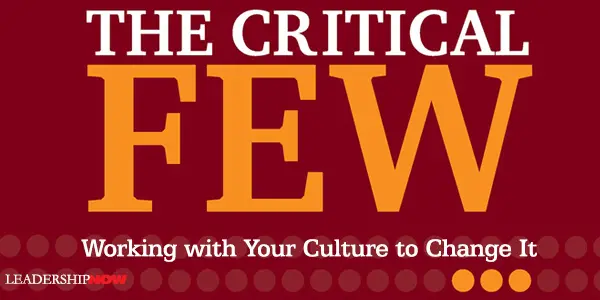
CULTURE is hard to change. And we’re usually fighting against it. But what if we used the culture to change it? What if by focusing on a few critical elements we could work with our culture instead of against it? In the Global Culture Survey 2018 by The Katzenbach Center, a whopping 80% of respondents say their organization’s culture must evolve in the next five years for their company to succeed, grow, and retain the best people. I think we’re all there, so the challenge is how to make that happen. In The Critical Few, the authors—Jon Katzenbach, Gretchen Anderson, and James Thomas—describe organizational culture as “a collection of deeply held attitudes, entrenched habits, repeated behaviors, latent emotions, and collective perceptions of the world. Culture is the shared set of assumptions we all bring when we work together—our unspoken expectations of one another.” It’s easy to underestimate the powerful force exerted by the culture when trying to change it. Instead of issuing top-down, comprehensive, urgent, cultural change directives, you’ll get further faster with real transformation, if you can get the “important emotional forces in your current culture working with you. You identify and make use of what already exists. Chances are, there are some reservoirs of genuine positive emotional energy lurking somewhere within your current cultural situation that can be harnessed if brought to light.” The idea then is to align how people behave and feel—those cultural elements that motivate your workforce—with your goals and what is necessary to make the company successful. But you need to keep it simple. The tendency is to include too much—too comprehensive. Complexity is distracting; comprehensiveness is wasted energy. You need crystal-clear simplicity and a small group of elements that will carry everyone forward together. You need to unify your organization’s people around a common, clear cultural movement, driven by a core of keystone behaviors and positive emotions. It’s easy to create a long list of very important and necessary keystone actions that are vital to building a better culture. But if you can’t narrow it down to three or four, “you’ll be overwhelmed when you start to work with them, and so will everyone else in the organization.” So we need to focus on three specific elements they call the critical few to have the most success: existing cultural traits, keystone behaviors, and authentic or critical informal leaders. Here’s how they describe each: Existing Cultural Traits A set of shared characteristics that represent the “family resemblance” of your entire enterprise—the qualities that transcend subcultures and are at the heart of the shred assumptions people bring to work and their emotional connection to what they do. Traits are not values. They reflect how things are actually done. When we understand what core qualities make up the “family resemblance,” we can than encourage the most the best and useful aspects of those qualities to bring about the change in culture. The traits you choose to focus on should “reflect your company’s essential nature, resonate across the enterprise, trigger a positive emotional response, and support your company’s cause.” Emotional energy is released as traits (and behaviors) are defined because traits, when well-articulated, reinforce and remind people within an organization of their sense of belonging to something larger than themselves. Keystone Behaviors A few carefully identified things that some people do, day after day, that would lead your company to succeed if they were replicated at greater scale. Culture change is slow process, but it begins with specific changes in behavior. As Richard Pascale wrote, “People are much more likely to act their way into a new way of thinking than to think their way into a new way of acting.” You are looking for behaviors that, when encouraged, will move your organization in the direction of your stated aspirations and your strategic intent, all while aligning to those fundamental traits of who you are as a company. Authentic Informal Leaders A few people, or at least a reasonably small percentage of your company’s people, who stand out because they have a high degree of “emotional intuition” or social connectedness. Authentic Informal Leaders (AILs) are people who are already demonstrating the kinds of behavior you want to encourage. And they are not necessarily your high-flyers. These are the people too that can give you a better understanding to how things really work in your organization. Work with them from the beginning. They note thought that AILs may be thought of as skeptics, resistors, and even “mouthy.” Their value is that they “aren’t just there to channel a message—they are there to translate it if they believe in it and also to call foul if they do not and push the leadership to try harder! Their talent for sensing and responding to what others think and feel means that they will choose a way of communicating key ideas that will strike a chord at all levels of the organization.” You can’t point your finger and mandate behavior change. But you can intervene to create the conditions that make the right behaviors emerge. You’re looking to surround your people with a coherent system of “enablers,” some formal and some informal, that all, taken together, suggest a new path. Too often we try to implement changes as an initiative against something when we would be better off working with the prevailing culture to shape something better. These initiatives are usually communication-led transformation rather than a true culture-led, behavior-led, transformation. Communications-led transformations rarely produce a lasting effect on how we feel about what we do and therefore actually change what we do. Lasting cultural changes must have an emotional commitment. You can find more information on this concept on the Strategy& website. 
Posted by Michael McKinney at 08:34 PM
02.08.19

Henry Mintzberg’s Bedtime Stories for Managers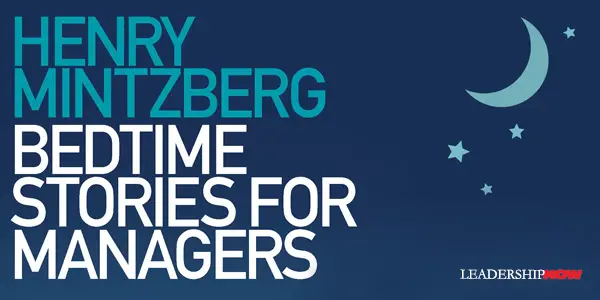
MINTZBERG’S 20th book, Bedtime Stories for Managers, is a thought-provoking page-turner. (In that sense I’m not sure it’s good to read just before drifting off.) The stories—a collection or repurposed blog posts—are meant to be pondered. The theme running through most is that managers/leaders need to get out from behind their desks and see the world from the perspective of their employees and customers. To this end, he dedicates the book to “all those managers who eat the scrambled eggs to help their organization work like a cow.” That requires some explanation. Scrambled Eggs The first story tells of an experience he had on the soon to be defunct Eastern Airlines (they went bankrupt in 1991). He was served some awful scrambled eggs. After complaining to the flight attendant, she said, “I know. We keep telling them; they won’t listen.” Management is not eating the eggs. They’re not running the business; they’re reading financial statements. The financial analysts were certainly reading those statements, and probably explaining the airline’s problems in terms of load factors and the like. Don’t believe a number of it. Eastern Airlines went belly up because of those scrambled eggs. And here’s the kicker: Some years later, after telling this story to a group of managers, one of them, from IBM, came up to tell me another story. The CEO of Eastern Airlines came rushing in at the last minute for a flight, he said. First class was full, so they bumped a paying customer to put him where I guess he had become accustomed. Apparently feeling guilty, he reportedly made his way to Economy Class (no mention was made of him having to ask where it was). There he apologized to the customer, introducing himself as the CEO of the airline. The customer replied: “Well, I’m the CEO of IBM.” The lesson is that managers/leaders (both sides of the same coin) need to get out and run their businesses. They need a dose of reality. “Managing is not about sitting where you have become accustomed,” writes Mintzberg. “It’s about eating the scrambled eggs.” Work Like a Cow In section 2 we learn about the cow. It comes as a reaction to a clever and insightful 1995 advertisement from SAP. In the ad, the copy reads: “This is an organizational chart that shows the different parts of a cow. In a real cow the parts are not aware that they are parts. They do not have trouble sharing information. They smoothly and naturally work together, as one unit. As a cow. And you have only one question to answer. Do you want your organization to work like a chart? Or a cow?”
This is a very serious question. Ponder it. Cows have no trouble working like cows. Nor, for that matter, does each of us, physiologically at least. So why do we have so much trouble working together socially? Are we that confused about organizing, for example, all this obsession with charts? Other Lessons A few of the stories take a concept or two out of context to make a point, but the point is well taken. Here are a few lessons gathered from the pages of Bedtime Stories for Managers: Successful managers are flawed—everyone is flawed—but their particular flaws are not fatal under the circumstances. Reasonable human beings find ways to live with one another’s reasonable flaws. The stories serve best as sort of a reality check. Good night. 
Posted by Michael McKinney at 12:51 AM
05.04.18

Leading Clarity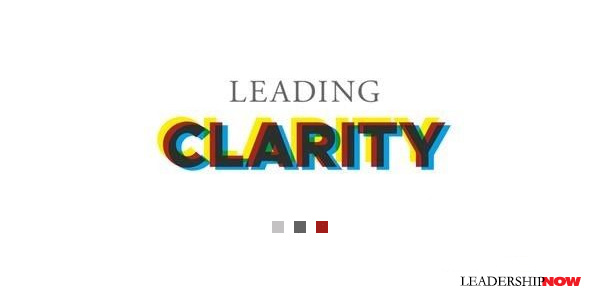
T In Leading Clarity, Brad Deutser states that “Clarity operates on the truth that everything is connected.” Clarity connects. “Clarity is the foundational fabric that weaves together dreams, goals, initiatives, concerns, challenges, and triumphs.” Clarity not only defines an organization, but it also protects and stabilizes it too. Considered as a destination, clarity can be lost or obscured the moment the landscape changes, or the environmental factors dim your view. In clarity, we can see all the factors, recognize them for what they are and what they can become, and create connections that can be relied on to establish or reestablish equilibrium and an environment for growth. This distinction matters to us because especially in times of great change and emerging opportunities, we can easily lose our way—our focus. Businesses fail—people fail—due to a lack of clarity. When disruptions come it is easy to move out of clarity. “Clarity become central to your ability to not only visualize, but actualize your performance.” Clarity should transcend your environment. When we are in clarity, we can maintain a constant flow of energy and maintain connections. Deutser identifies 12 circuit breakers that disconnect us from clarity: fear, ambivalence, clutter, labeling, doubt, impatience, boredom, conflict, overconfidence, physical depletion, inference or shallowness, and resources. This comment was interesting regarding our need to tolerate ambiguity: Being in clarity allows space where we wait for what we don’t quite understand to emerge, which keeps energy available and flowing rather than being boxed in, covered up, or mistakenly shelved through what’s already known. Too often we miss lessons, opportunities, and shifts in thinking, because we want to quickly fill the space of not knowing. Clarity needs structure and has to be created. So how do create this state of clarity? Deutser begins by working inside-the-box. We all work within constraints or within our particular box—a box of our own making. So we start by understanding our box. From there we can grow and/or change our box. When working in the box, your playing field is more defined and there is greater understanding of specifics and their possible impact on your desired outcome. There is also more empathy and connectivity in the box because there is definition. … The box provides a form of clarity for all to grab hold of and work toward. The powerful point is that the box is of your own making. You should also understand that while the sides of the box exist, they can be permeable, to let things flow in and out, and be flexible, to expand and contract when deemed necessary; but, once inside, each element serves to interact with the whole.
Direction: What are our values? Where are we headed? Is leadership aligned with values? Operations: Do we adapt well to change? What are our metrics? Do our systems and processes ensure high-quality work? People: Do we develop our team? Do we give timely and consistent feedback? Are we highly collaborative? Engagement: Coaching and Development, Talent Management, and Team Capabilities Organizational Identity: Who are we? Why do we exist? What motivates us? This side—your identity—is the foundations of everything you do. It is the foundation from which you can build the space for your thinking to exist in. Environmental Factors: What external factors affect or shape who we are? What do competitors do that we would never identify with or do ourselves? This framework helps you to understand who you are, where you are going, and how you work. As individuals and organizations we all have constraints. So it’s really what’s in the box that drives performance. Working within the box provides the context where innovation is likely and more importantly, implementable. When you understand the box it is easier to work and be productive within it. The box gives intentionality to everything you do. There’s no such thing as perfect, but “there is such a thing as being whole, which signifies the big picture as it weaves al the smaller pieces together. Being whole in this respect denotes a sense of closure that comes after all the parts fit together. Striving to be in clarity is about the process of becoming whole, of intentionally incorporating all the important aspects of your business into one connected form that accounts for the outside world as well.” It is the magic of your own ability to control [the construction of your box] that both protects and nourishes and becomes that which withstands and even thrives in chaos, change, and uncertainty. If you think of the sides of that box as being permeable rather than fixed, it frees the flow of input information in and the release of old ways and toxic byproducts out and away from your core. You build your own box. So what is your box and what do you need it to be? 
Posted by Michael McKinney at 06:41 AM
12.08.17

The Stand-Up Strategists
H Skilled leaders, those we call the “Stand-Up Strategists,” understand the utility of humor to address four important organizational outcomes, or the 4Cs: Community, Composure, Change and Creativity. And to address these four outcomes they typically use four broad styles of humor. The 4S – Styles of Humor The four styles we identified are based on our understanding of humor-driven dynamics in organizations, and build upon the broader world of humor research: Sensory humor involves a leader projecting an energetic, positive, playful vibe, and having a generally humorous outlook. Social humor typically involves jokes or stories shared as a tool to reduce interpersonal tension, increase sociability and promote openness. Self-deprecating humor is the ability of a leader to laugh at him/herself to reduce power-distance, and thereby facilitate more positive and intimate relationships. Strong humor most often entails sarcasm or cynicism. It is the comic style mostly associated with generating negative emotions, and therefore the one with the most limited application in organizations. The 4Cs – Organizational Outcomes There are four organizational outcomes where humor can be leveraged as a particularly effective managerial tool: Community In situations in which collaboration is an important driver of organizational success, lacking a sense of community can be a formidable barrier to delivering results. It is well understood by psychologists and social scientists that people who laugh together generally have stronger feelings of empathy and bonding. Sense of fun and social humor can be used as especially effective humoristic styles to build group cohesiveness, with a leader as the role model of projecting a relaxed and humorous attitude, sharing occasional jokes, anecdotes and stories that inject a playful aspect to day to day interactions. In situations where a leader needs to increase sociability across organizational hierarchies, self-deprecating humor can also be used. In years gone by, strong 'community' humor might have involved humiliation, ridicule, sexist or even racist overtones but these kind of jokes, anecdotes and stories have no place in today’s world. Beyond being potentially damaging to one’s own reputation, inappropriate humor can also contribute to reduced morale, absenteeism, the elevation of dysfunctional internal competition, and company-level reputational damage. Composure Studies on humor, stress and coping strategies have shown that individuals with a high sense of humor tend to experience less stress than individuals with a low sense of humor, even in situations where both face similar challenges. In group situations, humor can be utilized to reduce the pressure of stress associated with deadlines, targets or crises. Social humor is best leveraged in these situations, not to make deadlines or challenges disappear, but to improve morale, to help individuals avoid feelings of isolation, and to increase the solidarity of purpose needed to overcome adversity. Due to its tendency to trigger negative emotions, strong humor should be used sparingly, and in most instances only ever directed at external targets where there is an urgent need to overcome complacency or strong internal inertia. Change It is important for all leaders to communicate with employees about ongoing organizational change, especially with regards to vision and strategic priorities. Humor in day-to-day interactions and broader organizational communication can create an atmosphere which improves listening and understanding, boosts message retention, and enables positive emotions. These outcomes are even more vital during times of continuous change - two of the most common reasons that employees resist change are lack of sufficient information and a fear of the unknown. In the words of writer and civil rights activist Maya Angelou: “I’ve learned that people will forget what you said, people will forget what you did, but people will never forget how you made them feel.” Creativity The fourth organizational condition addressed by humor is perhaps the most important: creativity. Humor, laughter and fun releases physical and cognitive tension, which can lead to perceptual flexibility—a required component of creativity, ideation, and problem solving. Discoveries in this area also explain why many leaders are not just leveraging humor, but are also investing in creating playful and fun work environments. Jumping to conclusions… Time and time again in our interactions with leaders in some of the world’s most successful and innovative companies we have been struck by a recurring experience – not only are these leaders intelligent, talented and forward-thinking, many of them are also very funny. And it is not just that these senior executives are able to deliver a flawless punchline at a cocktail reception or town hall event – they are able to leverage humor as a strategic tool. May the farce be with you!  Of Related Interest: “When you’re a high performer, when you’re an achiever, the doors open in front of you.” “It’s great to strive for success, to shoot for the moon. But there are many moons out there in the Universe, so please make sure that the moon you are shooting for is your own.”
Posted by Michael McKinney at 08:02 AM
11.20.17

8 Ways To Design a High-Trust Culture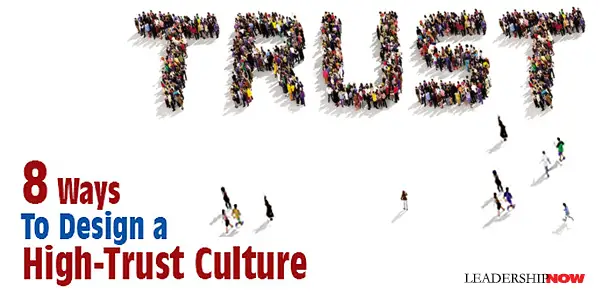
T Zak says that the most important thing to know is that “oxytocin works by activating a brain network that makes us more empathic.” He calls oxytocin “the moral molecule because when the brain releases it, we treat others well.” High levels of stress and testosterone inhibit the release of oxytocin. But here’s the good news. “You can actively promote oxytocin release and capture its benefits, including increased interpersonal trust and improved health, by modifying your default social behaviors.” Competition and status increases testosterone in both men and women. (Men have five to ten times more testosterone than women.) Promotion? Hot new romantic partner? Large bonus? “Testosterone whispers to our brains that we have won the social lottery and make us behave like demigods. It also increases libido. No surprise that CEOs, presidents, and movie stars have affairs.” Putting a check on your behavior will help you to produce a high-trust culture. Neuroscience has affirmed eight factors that are the building blocks of organizational trust. Zak has labeled these eight ways around the acronym OXYTOCIN. Ovation is recognizing colleagues who contribute to the organization’s success. Ovation should be unexpected, tangible, and personal. It should also be close in time (no more than a week), consistent, and done publically. eXpectation is setting difficult but achievable eXpectations. It engages the brain’s reward system, so that meeting goals at work becomes highly engaging and enjoyable. Challenging stress is good for you. Regular feedback on performance builds neural pathways in the brain that adapt behavior to meet goals. Yield means leaders must let go. Empower people to share their expertise and allow them to choose how to do projects. Instigate innovation by encouraging mistakes with limited downside and reward employees who make them. Train extensively and delegate generously. Transfer supports autonomy. Enables self-management by permitting colleagues to craft their own jobs. Facilitate self-mastery and skill development. Advise between teams without dictating. For transfer or self-management to be effective, Ovation, eXpectation, and Yield must be present in the organization. Openness involves keeping others informed. Sharing information broadly with colleagues and additionally, soliciting input and valuing the input of others. Organizational trust occurs when decisions are transparent, and reasons for decisions are shared. Caring is intentionally building relationships and prioritizing empathy. Supporting others. Letting people take the time to get to know each other increases trust. Emotions are recognized and accepted. Sometimes “difficult” people just need to be recognized and shown care. Peter Drucker said, “The number one practical competency for success in life and work is empathy.” Invest is committing to “whole person” development and work-life integration. Although it provides the foundation for a long-term commitment to the organization, investing in people is quite often just an afterthought. Do a Whole Person Review that asks three questions: Are you growing professionally? (Am I helping you to get your next job?) Are you growing personally? (Are you and your family happy?) Are you growing spiritually? (Are you developing as a human being?) Natural is allowing leaders and colleagues to be human, honest, and vulnerable. Ask for feedback on a daily or weekly basis. “A natural leader is one who accepts responsibility for mistakes and includes others in wins, who know the organization at every level, from the front lines to the executive suite.” Work the front lines at least one day a month. Trust when coupled with purpose results in joy at work. Working in a high-trust culture modestly increases joy. “Organizations should not try to make people happy at work. Joy is the result of working with trusted colleagues who have a transcendent purpose.” Joy=Trust x Purpose. Does your organization have a high-trust, high-performance culture? You can take the brief 16-question Ofactor Pulse & find out for sure. 
Posted by Michael McKinney at 07:43 AM
10.18.17

Challenges for Founder Leaders and How to Make Things Easier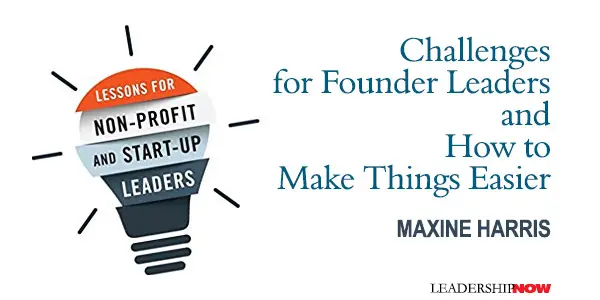
F Here are 4 tips for leading a founder run-organization more effectively and more efficiently while getting better results in the process.
 
Posted by Michael McKinney at 09:14 PM
09.18.17

How to Bypass Ego-Driven Drama
T Cy Wakeman writes in No Ego, that we spend way too much time in the workplace dealing with drama caused by our egos. Ego driven behaviors include:
Venting When we are frustrated, hurt, or angry, we vent. “Venting is the ego’s way of avoiding self-reflection.” As Wakeman points out, venting doesn't solve anything and only creates more negativity, which as we know, deteriorates our ability to think rationally. “Venting leaves people stuck in ego. It stunts growth and kills accountability.” If we encourage venting, we are preventing people from learning and growing into the person they need to become. To diffuse venting and bypass the ego, we need to move people into a different frame of mind: self-reflection. Self-reflection allows for accountability. And accountability allows people to amplify their strengths. Better all the way around. Ego-Bypass Questions Wakeman suggests bringing people back to reality by asking some ego-bypass questions: • What do you know for sure? • What would be most helpful in this situation? • What could you do next that would add value? • What could you do right now to help? • Would you rather be right or happy? • What is helpful in this situation—your expertise or your opinion? • How could we make this work? People who love their drama will not appreciate this approach. “Reality, self-reflection, and accountability make the ego very nervous. It doesn’t want to venture outside its comfort zone, so it will cling to the old and look for every possible way to torpedo change.” Ego resists things like “Mental flexibility, self-reflection, taking full accountability, forgiveness, letting go and moving on.” Check Your Own Ego This isn’t tough love, says Wakeman. “Reality is rough. Leadership is love.” If you are going to work to diminish the drama in your workplace, there are a few things Wakeman recommends we keep in mind. • Be gentle. You want to wake people up, but not by violently shaking them up. • Work with those willing to make the call. • Summon up all the compassion you can. We are all human. • Forgive others early and often. And most importantly: Check your own ego before you attempt to engage another’s. Here are some takeaways from No Ego:
 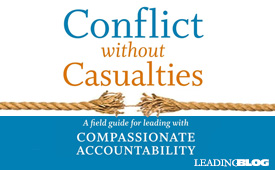 
Posted by Michael McKinney at 03:40 PM
08.07.17

Employees Do Care – and How that Helps your Bottom Line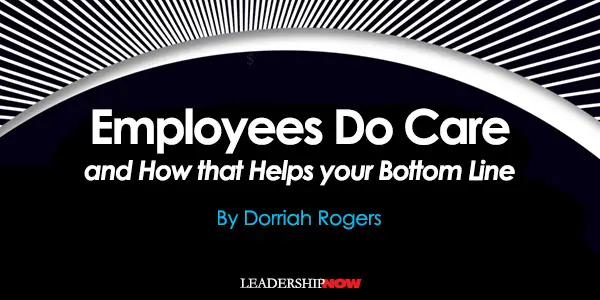
O 1. Create a behavioral culture of continuous improvement Managers and executives must promote a culture of continuous “improvement” as opposed to a culture of continuous “growth.” And there is a reason for that distinction. In my experience, many companies view “growth” as increased top-line revenue or sales, additional product lines, or entry into new markets, for example. Growth is typically more of a step event, as opposed to improvement, which is embedded and incremental. In my opinion, none of these are the true indicators of success. Success is only possible when you can do all of these things AND increase profit. In order to develop a culture of continuous improvement there are two primary areas of focus: behavioral changes and a clear system to enable ideas for change. What happens within organizations as they push for change and growth? For one, behaviors change. Where once a handful of individuals made key decisions, these decisions are now spread across numerous departments and individuals at all levels of the organization. Agility and flexibility are replaced by process and a mind-numbing disconnect from business goals. Innovation and creativity are supplanted by overhead creep, loss of productivity, and poor business decisions. Managers and executives need to own these impacts and make some changes. To make this happen I recommend the following:
2. Provide a process for employee-owned, sound and innovative business decisions that are tied to sustainable growth and profit. Decide to Profit: 9 Steps to a Better Bottom Line was written specifically in order to provide a step-by-step guide that aligns both employees and managers around connecting all ideas and decisions that affect change to the financial goals of your company. Employees have a clear system that links decisions to the financial performance of their organization. Managers have a ready tool to shape their organizational culture and business outcomes. With this system, both leaders and employees can adapt and change through external transformations in the marketplace and increasingly tough competition, and ultimately, maintain net profit. The 9 Steps enable both employees and managers to avoid common decision-making mistakes and taps directly into the fact that your employees DO care about your bottom line. The book also provides checklists and tools to foster a creative and idea-driven culture within your organization, and, ultimately, easy to understand and implement guidelines to ensure a financially sound future. The chapters outline each of the steps, its application, checklists, critical questions to ask, and easy-to-use forms for managers and employees. Embedded within each step are checks and balances and a process for accountability so that managers and employees can remain in sync in both their thinking and actions. In order for the 9 Steps to work effectively, the culture of the organization implementing them must reflect an ongoing and continuous curiosity, which ties directly back to the first recommendation. Culture and process are inextricably linked. Complacency and surrender can kill this curiosity, and creating this type of culture can be extremely difficult especially if historically your people and processes are embedded. Within the 9 Steps (Steps 1-8), a process is imbedded that allows alignment between employees and management that is focused on the right decisions for the right reasons: to ultimately make money. Step 9 is designed to ensure that your people and your ways of thinking are always asking questions, always challenging yourselves, never accepting the as-is, and ensuring that whether you fail or succeed at change or innovation does not quell the desire to constantly come up with new and better solutions. And Step 9 has a built-in feedback loop that continuously brings you back to Step 1 and so on. So between cultural behaviors and a straightforward internal process that ties directly to the financial success of your organization, leaders can provide both the tools and inspiration for success.  
Posted by Michael McKinney at 09:24 AM
04.26.17

Stretch: Unlock the Power of Less
I We are under more pressure than ever to do more. The idea that we can stretch and do more with what we already have begins to remove us from the dehumanizing rat race for resources that is impossible to win. Chasing limits us. Stretch liberates. Especially in uncertain times, “stretching equips us with the abilities to adapt and change when facing a less predictable set of circumstances.” One of the reasons we chase instead of stretch is because fail to see how we might see a resource beyond its traditional use. It’s also easy to assume that if we just had more money we could spend our way out of our problems. It’s often easier to acquire things than to think about how to use those same resources in more productive ways. “The problem is that chasers become so fixated on acquiring resources that they lose sight of what those resources will do for them” so we end up squandering them. We need to place more focus on what we already have. “Stretchers find beauty and richness in places where others struggle to see anything of value. Too often, we understand, interact with, and use things at face value, locking ourselves into conventions that limit possibilities.” Our creativity is sparked by constraints. Filmmaker Robert Rodrigues comments: The creative person with limitless imagination and no money can make a better film than the talentless mogul with the limitless checkbook every time. Take advantage of your disadvantages, feature the few assets you may have, and work harder than anyone else around you. Outsiders can often stretch by seeing possibilities that we can’t because we are the expert or just too close to the issue. “Breadth of experiences helps people stretch.” The well rounded often outperform those who are deeply focused on a single thing especially when trying to solve complex problems. It makes a case for a liberal arts education. We need to repeatedly go outside ourselves. “Temporary departures from our small worlds can come from short bursts of new activities such as reading about another field, finding a hobby, or having conversations with people from different backgrounds.” Stretching is not about being a cheapskate. There is a difference between frugal and cheap. A Stretching Roadmap In summary, here are a dozen ways Sonenshein suggests to help get us into the stretching habit. Just Say No Find a Sleeping Beauty
Go Explore
Take a Break (and Pay Less Attention)
Pick New Neighbors
Appreciate
Shop Your Closet
Scramble the Back Row
Make Midyear Resolutions
Break it Down
Turn Treasure into Trash
Stretch is a very well done book. Good and relevant examples give power to the points he is making. By chasing resources we really limit our potential. Stretching brings out our best. 

Posted by Michael McKinney at 05:55 PM
04.05.17

Radical Candor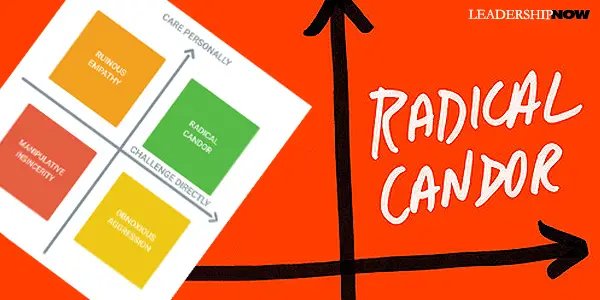
R The very heart of being a good boss is a good relationship, writes Kim Scott in Radical Candor. We need Radically Candid relationships with those we work with and because this is often scary and can be emotionally taxing, we resort to be ruinously empathetic or obnoxiously aggressive or manipulatively insincere. Of course, establishing trust with each person that reports to you is fundamental to radical candor. Radical Candor happens when you put Care Personally and Challenge Directly together. Care Personally refers to the fact that to have a good relationship “you have to your whole self and care about each of the people who work for you as a human being. Challenge Directly “involves telling people when their work isn’t good enough—and when it is. Challenging people might seem the opposite of Care Personally, but “challenging people is often the best way to show them that you care when you’re the boss.” Scott explains that she chose the word Radical “because so many of us are conditioned to avoid saying what we really think. This is partially adaptive social behavior; it helps us avoid conflict or embarrassment. But in a boss, that kind of avoidance is disastrous. She chose Candor because it is “necessary to communicate clearly enough so that there’s no room for interpretation, but also humbly.” Caring Personally is about acknowledging that we are all people with lives and aspirations that extend beyond those related to our shared work. It’s about finding time for real conversations; about getting to know each other at a human level; about learning what’s important to people; about sharing with one another what makes us want to get out of bed in the morning and go to work—and what has the opposite effect. Radical candor is not an invitation to be a jerk, or to nitpick, or to simply schmooze. (“A good rule of thumb for any relationship is to leave three unimportant things unsaid each day.”) What you say gets “measured at the listener’s ear, not at the speaker’s mouth.” Everything must be delivered in good faith. 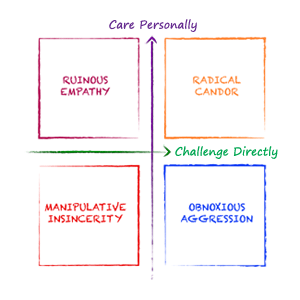 Scott has created a framework to help you be more conscious of the kind of guidance you are getting, giving, and encouraging. There are two dimensions to good guidance: Care Personally and Challenge Directly. It is a way to gauge praise and criticism. Scott has created a framework to help you be more conscious of the kind of guidance you are getting, giving, and encouraging. There are two dimensions to good guidance: Care Personally and Challenge Directly. It is a way to gauge praise and criticism.
When you criticize someone without taking the time to show care, your guidance feels like Obnoxious Aggression. It’s what happens when you challenge but don’t care. It’s praise that doesn’t feel sincere or criticism that isn’t delivered kindly. “When bosses belittle employees, embarrass them publically, or freeze them out, their behavior falls into this quadrant.” And keep this in mind: “Almost nothing will erode trust more quickly than using one’s insights into what makes another person tick to hurt them.” Manipulative Insincerity is what happens when you neither care nor challenge. It’s an attempt to push the other person’s emotional buttons in return for some personal gain. It’s praise that is non-specific and insincere or criticism that is neither clear nor kind. Ruinous Empathy is what happens when you care but don’t challenge. “When bosses are too invested in everyone getting along, they also fail to encourage the people on their team to criticize one another for fear of sowing discord. They create the kind of work environment where ‘being nice’ is prioritized at the expense of critiquing, and therefore, improving actual performance.” It is praise that isn’t specific enough to help the person understand what was good or criticism that is sugarcoated and unclear. You may think Radical Candor would never work on your organization’s or team’s culture. And it probably won’t unless you first invest in the people you work with and show them that you care personally. But here’s the big hurdle: Start by explaining the idea and then asking people to be Radically Candid with you. Why you first? First, it’s the best way to show that you are aware that you are often wrong and that you want to hear about it when you are; you want to be challenged. Second, you’ll learn a lot—few people scrutinize you as closely as do those who report to you. Third, the more firsthand experience you have with how it feels to receive criticism, the better idea you’ll have of how your own guidance lands for others. Fourth, asking for criticism is a great way to build trust and strengthen your relationships. (Important: “If a person is bold enough to criticize you, do not critique their criticism.”) Scott carefully details ways to create a climate in which Radically Candid relationships can flourish. She provides many (most first-hand) examples of what worked and what didn’t work. From her experiences at Apple and Google, she observed that “a boss’s ability to achieve results had a lot more to do with listening and seeking to understand than it did with telling people what to do; more to do with debating than directing; more to do with pushing people to decide than with being the decider; more to do with persuading than with giving orders; more to do with learning than with knowing.” And there’s an app: Candor Coach. This app will show you how quick, frequent, face-to-face conversations can help you build a culture of Radical Candor. It will start by teaching you to ask for and give feedback. It will help you track the conversations you’re having with each person on your team so that you can see where you need to improve.   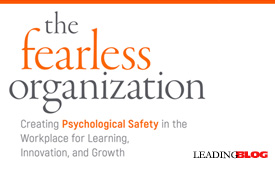
Posted by Michael McKinney at 09:32 PM
03.15.17

Intelligent Restraint: Pacing for Growth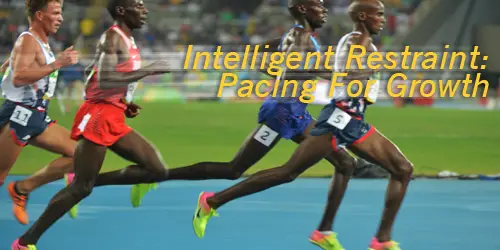
W Athletes know that the right pace in both training and racing is key to winning. It is a common belief that pushing ourselves or our organizations past our limits is the best strategy fro growth. But if you go too fast or push too hard you cannot only burn out but cause injuries and setbacks. At the same time, if you go too slow, you will get left in the dust. Find the right pace is key to successful growth and long-term success. Long-term success also requires that we execute our core business today while preparing ourselves for the future. In Pacing for Growth, Alison Eyring addresses this tension and how we can find the pace that avoids the wasted effort and the frustrating boom-splat cycles common to growth initiatives. The concept is called Intelligent Restraint. Intelligent Restraint is basically operating within the limits of the capacity and capabilities we have today and no further while we also build a base of the right capabilities for long term enduring growth. The three core principles of Intelligent Restraint are: Principle One: Capacity determines how far and fast you can go. Maximum capacity is the highest level of performance at which a system can perform without breaking down. When we understand the gaps between performance and capacity and how maximum capacity in the future will be different from today, we can create a program to build capabilities that increase capacity. Principle Two: The right capabilities increase capacity. The key is to be crystal clear what capabilities are most critical for growth in your business. What are the critical few capabilities your strategy requires you to execute fabulously well? Principle Three: The right pace wins the race. Growth leaders understand how and when to push faster and when to slow things down. In a race, we need to conserve some energy to maintain a fast pace and we need to perseverance to sustain this pace even when it become uncomfortable. Growth requires trade-offs like exploring new opportunities while exploiting existing assets. Eyring says there are three rules to keep in mind. Rule #1: Focus overrules vision. Vision is important and gets you going but focus is what gets you over the finish line. By learning to focus and then align people and pother resources to that focus, you can conserve time and energy that can be used to build new capabilities for growth. Making focused choices is Intelligent Restraint at work. Rule #2: Routines beat strengths. Strengths are useful but they can become a liability when overused. The right routines efficiently shape new ways of thinking and behaving that are need for growth. When we repeat the same thing over and over, we can perfect our technique, But when we repeat progressively challenging routines, we build endurance. Rule #3: Exert then Recover. To deliver results and build capacity for growth at the same time requires high levels of exertion that consumes personal and organizational energy that must be replenished. As a growth leader, you may need to intentionally slow things down. A sign that you’re growing at the wrong pace is that you lack the capacity or infrastructure to support what you trying to do. This results in chronic mistakes, poor customer service, and in some industries, safety violations and injuries. You know you are at the right pace when you can deliver the results intended by the growth initiative while at the same time having the space to give thought to and build for future growth. Eyring offers an online assessment to determine if your organization is setting the right pace on her Organization Solutions web site. 
Posted by Michael McKinney at 11:40 PM
12.22.16

How to Matter: The 5 Key Ways Companies Win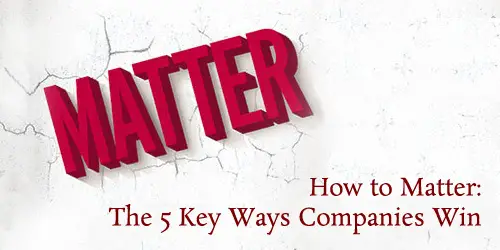
IN TODAY'S ECONOMY of volatility and velocity, the lifespan of a Fortune 500 company has plummeted from an average 50 years to a mere fifteen. When constant disruption is the new normal, how do companies succeed? They find a way to matter. When we looked at thirty-plus case studies of successful companies, we found that they all share an audacious approach to disruption. Large to small, in fields from construction to tech to health care, they win hearts, minds and wallets by innovating ways to stay the obvious choice in the market. Here are five key ways that winning companies stay on top: 1. Embrace disruption. Great companies recognize disruption and face it. They don’t try to stick to business as usual. They see disruption as an opportunity to adapt and grow, staying the obvious choice in the changing marketplace. Case in point: Burberry. When threatened by faster, cheaper online competitors, the legendary retail company confronted this digital disruption head-on. CEO Angela Arendt and her team created digital and omni-channel shopping experiences to stay relevant. By adding digital without compromising the quality of the 160-year-old brand, Burberry regained market superiority in the new retail economy. 2. Offer more value. By solving challenges their costumers, employees and stakeholders face, companies become the ones that matter. They offer value by identifying an authentic need and meeting it. Case in point: Blueshore Financial. This former working-class credit union in British Columbia seized an opportunity that bigger banks missed: unique customer experience. Financial “spas” with personalized, concierge service and expert advice transformed Blueshore into the bank of choice for affluent clients. In 2014, it had more than twice the administration assets of its closest competitors. 3. Seek out the right partners. Smart companies create strategic partnerships to help mitigate the volatility and velocity that disrupt the marketplace. Case in point: DeBeers. New Russian mines began producing a bumper crop of diamonds that threatened to flood the market. DeBeers worked out a partnership to become their sole distributor, and control supply. The legacy firm continues to innovate and form key partnerships to sustain the health of the marketplace. 4. Care about more than profits. Successful organizations embrace a broad perspective when tackling challenges and align company values with strategic initiatives to improve lives. Case in point: Unilever. When the soap giant wanted to cross into nonwestern markets, it identified a cultural gap and a serious social need. Washing hands was not a habit, and children’s rates of fatal infections and diarrhea were high as a result. Unilever partnered with Red Cross and UNICEF hygiene initiatives including a grassroots, mother-to-mother campaign. The soap giant was instrumental in a marked improvement in children’s health. 5. Identify future needs. Disruption in the tech market is relentless. Without constant innovation, one-time market giants quickly find themselves irrelevant. Winning companies take a long view and use disruption to pinpoint the needs of the future. Case in point: Adobe. Countless rivals and the emergence of the Cloud diminished Adobe’s primacy in design software and products. It bypassed its original customer base (art directors and designers), and retooled as a strategic partner to marketing executives. Adobe reshaped the market by offering design services, social media help, and subscriptions in an all-in-one creative, cloud-based solution. Companies that boldly embrace the disturbances that threaten to derail them are the ones that prevail, as we found out. And their success is far less about products, and far more about value. These are the firms that raise the bar. 
Posted by Michael McKinney at 03:14 PM
07.25.16

Under New Management IT IS HARD to let go of the thinking behind some of the management tools we still use today. Designed for types of work that are no longer prevalent, these systems were designed for another time. David Burkus reports on a number of seemingly radical management ideas in Under New Management. He stresses that we look for practices that are limiting employees’ potential and eliminating them. He questions best practices like: Banning or limiting access to e-mail actually improves productivity. “Researchers believe that limiting email decreases stress and increases productivity because it cuts back on multitasking and distraction.” Consideration should also be given to limiting email to normal working hours. The customer always come first? Putting employees first may be the best way to serve the needs of the customer. “Profits are driven by customer loyalty, customer loyalty is driven by employee satisfaction, and employee satisfaction is driven by putting employees first.” As an artifact of the industrial age when managers needed to ensure that all shifts were covered, strict vacation policies were a necessity. But as industrial work gives way to knowledge work more liberal vacation policies often increase engagement and performance. “When you give employees trust and freedom to act responsibly, you don’t need nearly as many policies.” Trust allows employees to focus on performance. In one study, being trusted increased levels of oxytocin (the bonding hormone that creates a feeling of well-being) in the brain which in turn triggers more generous and trusting responses. “Trust breeds more trustworthy behavior.” Burkus also discusses the value of sabbaticals and pre-cations. People don’t feel comfortable talking about salary. Should how much employees are paid be public knowledge? Some research says yes. “When people know where they stand and know how to move up in the range, they’re more motivated to work to improve their performance and improve their standing.” But while it can improve perceptions of fairness and feelings of engagement there are obvious drawbacks. Without non-compete agreements organizations have little incentive to invest in employees or innovative research since they could easily leave and take their knowledge to a rival company. But research has demonstrated that non-compete agreements create a “brain drain” from those states that enforce them. For companies in stats without non-competes, when an employee leaves one firm for another, both companies benefit. Not only do both companies gain new knowledge but new connections between employees in both firms are created. “In effect, departing employees have a cross-pollinating effect on the ideas of both organizations.” Burkus makes a case for ditching performance appraisals, paying people to quit, bringing in teams to the make hiring decisions, ever changing org charts, and closing open offices. He also tackles the question: Are managers necessary? Although some reseach suggests that employees are more productive and engaged when they, and not their manager, control their destiny, these are not really mutually exclusive. Nevertheless, Burkus concludes, “To benefit from the motivating power of autonomy, leaders don’t need to give up total control and fire all the managers, but every leader does need to consider how their current structure might be limiting the perception of freedom and blocking the organization from its peak potential.” Under New Management gives leaders much to think about. Read the research and the stories of those doing it and you decide. 
Posted by Michael McKinney at 10:27 PM
05.10.16

Balancing the 3 Boxes
ULTIMATELY our future is not in linear—incremental—improvements. It is in nonlinear—nonconforming, breakthrough—change. But the future is built in the now and that’s the problem. What should we be doing now to ensure we have a future? Dartmouth professor Vijay Govindarajan writes, “As much as we might pay lip service to the fact that the future will differ dramatically from the past, we often behave as though it will be exactly the same.” There is a tension between and what we have to do now to continue on as an entity and what we need to be doing now to create our future along with the things that we are doing that get in our way of doing any of it. How do we create the future while managing the present? Vijay Govindarajan has incorporated good principles for managing change into a framework he calls The Three Box Solution. It is a method to simultaneously meet the performance demands of your current business—one that is still thriving—while dramatically reinventing it for the future. It’s about managing preservation, destruction, and creation. In each Box there is a function that needs to be performed to lead a sustainable business: Box 1: The Present Box – Manage the present core business at peak efficiency and profitability. Box 2: The Past Box – Selectively forget the traps of the past by identifying and divesting businesses and abandoning practices, ideas, and attitudes that have lost relevance in a changed environment and would otherwise interfere with your focus on inventing the future. Box 3: The Future Box – Generate nonlinear, breakthrough ideas and convert them, through experimentation, into new products and businesses. It’s not about predicting the future but it is about being prepared for circumstances you can not control. The Three-Box Solution requires an ability to think and act simultaneously in multiple time frames. Each requires different leadership and you must maintain balance across the 3 boxes. It’s a balance. Most businesses focus on Box 1 – preservation. And understandably so: the rewards are immediate, it is a known quantity and the risks are relatively low. Here’s the challenge: The greater your success in Box 1, the more difficulties you are likely to face in conceiving and executing breakthrough Box 3 strategies. This “success trap” typically arises not from willful intention but from the overwhelming power of success that the past has brought. The most pernicious effect of the success trap is that it encourages a business to suppose it already knows what it needs to know in order to succeed in the future. Boxes 2 and 3 are about creating the future. In Box 1 there is a value in sticking to what you have been good at, but in Box 3 you throw it out. The idea is to be building the future continuously instead of waiting until you are forced to do something. By then it is generally too late. Boxes 2 and 3 are easy to ignore because “when you neglect the future today, you don’t see the damage today.” Box 2 is especially difficult because it is hard to give up on the assumptions that got you where you are today. (Even if they are not working for you, to be frank.) Our resistance to selectively give up the past is arrogance. It reflects a desire to control our world. But it changes and we must strategically change with it. Box 2 issues limit our futures. They are obstacles to Box 3. “It is harder for an organization to admit to itself that it’s time to stop doing something than to know when it’s time to invent something new” in part, because we have so much invested in the past. It becomes an emotional issue. If you “ride the obedient horse of Box 1 all the way through Box 2 and into Box 3 without stopping to consider what needs to be forgotten, you end up stuck in your comfort zone.” Box 1 must be performing or Box 3 concerns are much more difficult to deal with. The 3-Box Solution is a daily operational balancing act. For leaders it means:

Posted by Michael McKinney at 10:29 PM
02.19.16

9 Ways We Sabotage Ourselves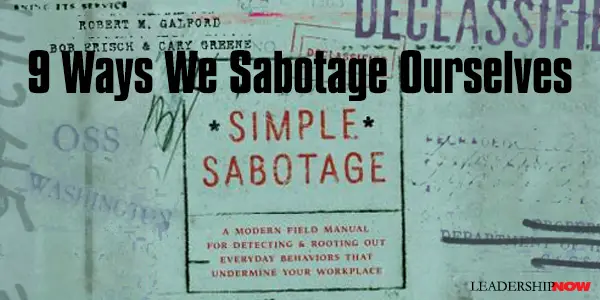
FROM PEOPLE whose job it is to sabotage the efforts of others, we can take a lesson or two. In Simple Sabotage, authors Robert Galford, Bob Frisch, and Cary Greene explain that in January 1944 the OSS (Office of Strategic Services—predecessor of the CIA) published the Simple Sabotage Field Manual (PDF) to train resistance members in the art of sabotage. “The Manual detailed easy ways to disrupt and demoralize the enemy’s institutions without being detected.” One section of the Manual provided eight tactics specifically designed to disrupt the enemy’s organizations. The authors have added a ninth in keeping with the times. One thing you will notice from each of these tactics or behaviors is that none of them are all that bad on the surface. One could easily find a rational explanation for engaging in them—to a point. And that’s the problem. That’s why these are insidious. Too often we insist on reproducing a behavior long after the sell-by date. We don’t let it go when we should and so we unwittingly sabotage our best efforts. Here are nine acts of sabotage we unintentionally get caught up in: Sabotage by Obedience Insist on doing everything through channels. Never permit shortcuts to be taken in order to expedite decisions. Sabotage by Speech Make “speeches.” Talk as frequently as possible and at great length. Illustrate your “point” by long anecdotes and accounts of personal experiences. Sabotage by Committee When possible, refer all matters to committees, for “further study and consideration.” Attempt to make the committees as large as possible—never less than five. Sabotage by Irrelevant Issues Bring up irrelevant issues as frequently as possible. Sabotage by Haggling Haggle over precise wordings of communications, minutes, resolutions. Sabotage by Reopening Decisions Refer back to matters decided upon at the last meeting and attempt to reopen the question of the advisability of that decision. Sabotage by Excessive Caution Advocate “caution.” Be “reasonable” and urge your fellow conferees to be “reasonable” and avoid haste, which might result in embarrassments or difficulties later on. Sabotage by Is-It-Really-Our-Call? Be worried about the propriety of any decision—raise the question of whether such action as is contemplated lies within the jurisdiction of the group or whether it might conflict with the policy of some higher echelon. Sabotage by CC: Everyone CC: Everyone. Send updates as frequently as possible, including in the distribution list anyone even peripherally involved. In each chapter, the authors use examples to help you identify the behavior and root it out—which is not as simple as you might think. Perpetrators can easily defend their behavior, but that’s what makes these behaviors so effective. For the same reason, it is also difficult to see in ourselves. Simple Sabotage is about the day-to-day routine interactions and processes we rely on as we work that are undermined by unintentional sabotage. By identifying and removing the hundreds or even thousands of small, barely perceptible irritants—the “sand” that clogs the machinery—you will transform your workplace or workgroup experience and the experience of those around you. 
Posted by Michael McKinney at 10:15 AM
02.16.16

The Superboss Playbook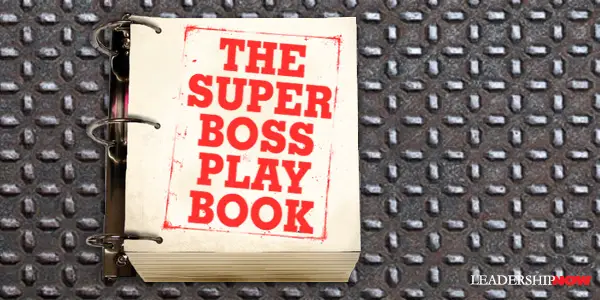
IMAGINE A WORLD a world where the person who you call your boss changed your life by helping you accomplish more than you ever thought possible. In every industry there is a leader that stands out. A Superboss. What is their secret?In Superbosses, Sydney Finkelstein discovered that although they may differ in leadership styles, they share a playbook that leads to extraordinary success founded on making other people successful. Superbosses can be fierce or gentle, belligerent or self-depreciating, but whatever their style, they do a much better job inspiring and teaching because they get in their trenches with protégés, leading by example and giving them personalized attention they require to move up quickly. Here then is the outline of The Superboss Playbook – Techniques, Mind-Sets, Philosophies, and Secrets of the World’s Best Bosses: Superbosses recruit people who “get it.” Superbosses are uncompromisingly open. Superbosses embrace the apprenticeship model. Superbosses are traders in opportunities. Superbosses fashion teams that function as a “band of brothers.” Superbosses create a strategic alumni network. We need new approaches to nurturing people and the Superboss Playbook presented by Finklestein, is completely learnable by any leader who is fearless, competitive, imaginative, credible, and authentic. Superbosses is a fascinating look at the leaders that flourish and often change their industries by developing a future generation of leaders. If you are not working for one, this book will help you to become one. The Three Types of Superbosses Glorious Bastards: These superbosses care about one thing: winning. They’re the ultimate hard drivers, yet they realize that to get the very best results, they need to develop the world’s best people and teams. So they do.
Nurturers: These coaches and teachers resemble traditional mentors the most. They take pride in bringing others along and care deeply about the success of their protégés. They help people accomplish more than they ever thought possible.
Iconoclasts: These executives usually operate in creative fields, where their single-minded passion for their work inspires their protégés.
Available too, is The Superbosses Playbook: A Workbook Companion to Superbosses. It shows readers how to apply the tactics of these "superbosses" in their own organizations. It features assessments, case studies, and exercises designed to help anyone recruit talent, lead performance, inspire teams, and even part with great people like a true superboss. 
Posted by Michael McKinney at 08:40 PM
12.02.15

How the World’s Best Leaders Enhance Their Productivity and Effectiveness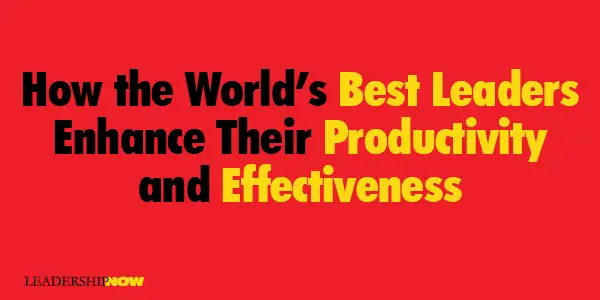
 Leaders know how to choose the right person for the job. As Jim Collins wrote in his book Good to Great, leaders start by getting the right people on the bus and in the right seats. In my book The CEO’s Secret Weapon: How Great Leaders and Their Assistants Maximize Productivity and Effectiveness, I interviewed global business leaders such as Richard Branson, Donald Trump, Steve Forbes, John Chambers, and others, who repeatedly demonstrated this knack of hiring the right person who could operate as a seamless extension of the executive. In the case of these business leaders, all their assistants have been with them well over 20 years, and sometimes, over 30 years. Donald Trump told me, “I have good instincts but I always believe every hire is a gamble.” Knowing yourself, your work habits and your work style are key. In discussing hiring his assistant, Norma Foerderer, who was with him over 25 years before she retired, Trump told me, “I needed someone strong because I work quickly and am demanding because of that. I also needed a straight shooter—someone who will tell it like it is. I’m that way and I can’t have someone who isn’t. Every boss appreciates someone who is honest with them.” So, how do these global business icons manage to get so much done through the smart use of their assistants? Here are some suggestions for how can you do the same in your business: Give Them Access: Give your assistant complete access to you. Let them learn by observing your decision-making process, your moods, why you like or dislike something. This perspective will give them a compass for how to act on your behalf. Confident of what you would want, they won’t hesitate to act as your proxy. Give Them Autonomy: Great leaders know when to become immersed in the details and when they should let someone else take the lead. If you’ve hired the right person, let them do their job. Trust them. Don’t second-guess what they do. As General Patton reportedly said, “Never tell people how to do things. Tell them what to do and they will surprise you with their ingenuity.” In the case of exceptional executive assistants, you don’t even need to do that. Simply share your vision with them and trust their experience, skills, and creativity to take it from there. Give Them Confidence: When you trust people, you build their confidence and encourage initiative. I was fortunate in my positions as assistant to successful business leaders such as peak performance strategist, Tony Robbins, to be allowed considerable latitude in how I did my job. Then the job becomes exciting because you care for it and run it as you would your own business. Richard Branson’s former assistant, Penni Pike, told me that after many years of working in close quarters with Branson, one day he told her to take all his most important papers and move back to the houseboat from where they worked earlier. She said that while it felt strange to be away from him in the beginning, it came to feel like she was running her own business. In fact, the experience I gained through being trusted by my bosses and working independently, gave me considerable confidence when I started my own business because decision making and going out on a limb were not new to me. Give Them Kudos: Management consultant Peter Drucker told me he didn’t have much interest in discussing assistants with me because his focus was on strategy and assistants don’t create strategy. If he were alive today, I think Mr. Drucker would be pleasantly surprised to see the role many assistants are playing in helping their executives define strategy because of the strategic position an assistant to a leader occupies in an organization. The assistant is often privy to information that would never make it to the ears of the CEO unless the assistant told them. Who is doing or saying what, how employees are reacting to new directives, much of this is communicated to the CEO by their assistant, whose finger is on the pulse of the organization. Smart leaders take note of their assistant’s recommendations. Management guru Marshall Goldsmith commented in my book, “Executives should get in the habit of asking their assistants, ‘How can I be a better partner in our relationship’, then listen, learn and act on the assistant’s ideas.” Give Them Respect: Every top influential business leader I’ve had the privilege of knowing or hearing about, shows courtesy and consideration to their assistant – in public and private. They don’t disrespect their assistant and they don’t let others disrespect their assistant. I remember, as a young assistant, telling my CEO boss that someone had been rude to me. My boss immediately called him saying that when I called, this person needed to speak to me as if he were speaking to my boss. That experience taught me that a boss backs up his people. As much as the assistant “has the boss’ back”, the boss should do the same. Give Them Gratitude: Acknowledge the immense job your assistant is doing on your behalf. Time after time, great business leaders have told me they could never do what they do without their assistant. As Ken Blanchard remarked in my book, “Assistants give you the capacity to do so much more.” Remember to express your thanks, show consideration and once in a while, look for ways to reward them. Develop these habits and you will have learned some of the secrets that for generations have enabled exceptional leaders to function at optimum levels, working effectively with their exceptional assistants. Jan Jones is the author of The CEO’s Secret Weapon: How Great Leaders and Their Assistants Maximize Productivity and Effectiveness. She is President of Jan Jones Worldwide, a speakers bureau that evolved from her experience as executive assistant to personal development icon, Tony Robbins and ten years as exclusive representative for small business visionary, Michael Gerber. For more information: theceossecretweapon.com   
Posted by Michael McKinney at 09:24 AM
10.30.15

Leading Teams Toward Success Using People, Products, and Profits I've written the words People, Products, Profits (In That Order!) so many times over the years it would be easy to think of them as simply a slogan I use, a catchphrase meant to pique your interest. I assure you this is no more the case than Apple using the words Think Different as a clever tagline. Like the words Think Different, People-Products-Profits is part management philosophy, part rallying cry, and in an aspirational context, part religion. When I invoke these words to set the table for embarking on the outrageous, it is with the full knowledge that I could sound silly, fail miserably, fall on my face, or possibly convince you that relentless pursuit of the extraordinary is within your grasp. That's a lot to bite off in a very few words. It's meant to be. In my new book, Endless Encores, a veteran CEO named Daphne spends an evening talking with an up-and-coming executive named Paul, helping him come to terms with the potential first failure he could be facing following a huge initial success. They are stuck in an airport, passing the hours. She is a leader and he is leader, only at the moment he is too obsessed with his own personal exposure to realize that he is failing to be a leader by trying to duck out-of-the-way of his own mishap. By worrying more about what he has done than what he has learned, he has shifted the weight of his problem from marginal to endemic. In truth, the failure he might be facing is not so much a setback as it is an opportunity. By the end of the story, he has embraced that and reset his sights on the long game. Save for the guidance from Daphne, Paul might have missed the boat. And the plane. And all that might have been ahead of him in the form of material reward, passionate accomplishment, intellectual richness, and emotional fulfillment. It's a close call, but he makes it over the coals. You can, too, if either you have a Daphne in your corner and you're willing to listen, or if you otherwise come to acknowledge your role as a leader is more about the long-term example you set than the specific offering you at the moment champion. One is permanent and tangible, the other fleeting and beyond your control. Where would you prefer to focus? Leading through People, Products, and Profits means committing to the idea that talent is a priori to all success. This has much less to do with your own talent than the talent you assemble, empower, and inspire. World class products and services don't create themselves. They are created by human beings, most often high performance teams, and the time you devote to building and bolstering those teams is a direct reflection of your values. When your team identifies a product concept that is worth pursuing, leadership becomes the championing of execution over the touting of an idea. We can all dream up big ideas, but few of us can bring them to market. Those who can almost invariably need some form of stewardship to hold the team together through unending punch lists of details. If that's not challenge enough, you can have the best team in the world and the best product in the world, but if your business model is not sensible and doesn't sustain the enterprise, it really doesn't matter what you set out to accomplish. A business has to create value, usually measured in the form of profit, and if you can't lead a team to do that more often than not, you're not likely to get many chances to stand in the center ring. The point of the rallying cry is to set a tone of priority, balance, and perspective. Everyone likely wants a business that is profitable, but leaping straight to the outcome ignores the most valuable element in the mix: your customers. An exceptional team that has been well-directed puts the customer in first position, in essence their supreme boss, with the primary hope that if a customer's expectations are exceeded, that customer can become a customer for life. When we talk about the notion of lifetime value, we are talking about just that: Have we surprised and delighted a customer in such a way that they ascribe emotion to the brand we represent? Will they come back for more with cost-effective prompting, and will they tell their influence circles about the breadth and depth of their fine experience? That's why a business leader is accountable first to customers, because they hold all the cards, and that's why when they pursue a business opportunity, they place investment in talent first, product innovation second, and business model third. You need all three, but put them in the wrong order and you are left extracting value from a customer rather than bonding a customer who becomes a partner in creating value. Yes, you have to juggle three balls at once in sequence if you want to repeat success, and you have to do it over and over. It's not easy and it's not supposed to be easy, because if it were, you wouldn't be worthy of praise or wealth because anyone could do it. Likewise, leadership is a choice. It's not for everyone. The rewards are far often more intrinsic than measurable, and falling on your face in a public forum is never going to be fun. You will fail. We all fail. If you learn when you fail you will also win. You have to decide if leadership is really something you're ready to shoulder. If you are, choose your words and the order of those words carefully. The talent around you will only become cynical if you're insincere and don't stand for something more than winning right now. Repeating success is about the journey. Leading is about tone and substance. Projects are always short. Careers can be short or long. The choice is always yours. Your values always matter. If you're deliberate in determining how you build a culture of shared values, the best around you will always be listening. Stay authentic and their results will surprise you. Those are likely to be extremely pleasant surprises. Ken Goldstein has served as Chairman & CEO of Shop.com, Executive Vice President & Managing Director of Disney Online, and VP / Executive Publisher of Entertainment & Education for Broderbund Software. He currently advises start-ups and established companies on brands, creative talent, e-commerce, and digital media strategy. Ken is on the boards of Thrift Books LLC and Good Men Media, Inc. He publishes the business blog CorporateIntel.us and his first book, This Is Rage: A Novel of Silicon Valley and Other Madness, was published in 2013 by The Story Plant. For more information please visit his website and follow him on Facebook and Twitter. 
Posted by Michael McKinney at 09:44 AM
09.23.15

Keeping People Front and Center
AT SOME POINT we all come to see that people are the most important part of any initiative. We get caught up in the tasks, but it’s the people that leaders need to focus on. Dominic Barton, global managing director of consulting firm McKinsey & Company, reminds us of this in an interview with The Wharton School. Talking to CEOs reflecting on their tenure he found that they all said that they would have “moved faster on people … taken people out faster, moved them up faster and spent more time on people…. I’ve not heard a single leader not say this [among] those that are toward the end of their career.” This is made easier of you are able to compartmentalize your work. If you can isolate and focus on issues separately for short periods of time, you are better able to keep that big picture in mind—keep an eye on what’s really important. He added: “You get so many issues coming at you, and some of them can paralyze you.” He related a story from a Liberty Mutual CEO who told him, “‘In my first three weeks of my job, I would have kicked you out of my office.'” The CEO explained that at that time, he had been told by his general counsel that the company was being sued for $6 billion, and that everywhere he looked, all he could see was $6 billion. “Now, he said, ‘I’m talking to you, and I have six of those [issues going on right now], but I’m focused on you.'”
Posted by Michael McKinney at 11:51 PM
08.28.15

Fairness is OverratedFairness is Overrated is a solid leadership primer on what it takes to create a healthy culture day-in and day-out. Tim Stevens comes from a Church leadership perspective. However, his 52 principles are applicable anywhere because people are people with the same issues—only the peer pressure changes (unfortunately).The 52 principles are organized around four key areas: Be a leader worth following, Find the right people, Build a healthy culture and Lead confidently through a crisis. Stevens begins with “live a life with margins” and ends with the “five stages of failure.” Living a life with margin structured in not only helps all of the other leadership principles discussed here but it helps you move through the five stages of failure faster. So it’s a foundational principle. A leader worth following has integrity. It’s about character. Knowing yourself and disconnecting is an important way to maintain integrity. You need to build space for what’s important. Finding the right people—finding and developing leaders—is the most important thing his did as an executive pastor. “Here is what I believe to my core: the success of leaders will rise or fall based on the decisions they make about the people around them.” When hiring people Stevens recommends not going solo. Get others involved. Chemistry is more important than skills, experience, or education. Use social media to “get to know” the people you are considering. Look for how they treat people they disagree with. Hiring too quickly leads to problems. Pay well. “You don’t want staff to join because of money. You don’t want staff to stay because of money. You don’t want staff to leave because of money.” If you have a healthy culture, people are waiting in line to join your organization. A healthy culture is led by a leader who is not insecure about others succeeding. Gossip is not tolerated. Employees do life together; it’s not just a job. In a healthy culture a leader turns over authority to others. Let your leaders lead. “No organization, church, government, or company can have a healthy culture and be run by a dictator, monarch, or single personality.” You need a strong team running the organization. What Stevens is talking about here is humility. A toxic culture cannot be changed without it. Leading confidently through a crisis means trusting the people you have in place to figure it out. A confident leader is not one that says, “I can figure it out” but one that says, “We can figure it out.” Having a great team in place is critical here. If you have found the right people and developed a healthy culture, then it becomes easier to lead confidently in a crisis. These 52 principles are easier to implement if you have people who will speak truth to you. Again, humility is key here. There is a lot to be considered in this book. It is well-written (a bit of a page turner) and you will want to go back again and again to see how you measure up. And by the way, fairness is overrated. “Don’t confuse fairness with justice. Justice is about doing what is right. Fairness means everyone gets exactly the same thing.” It's about priorities. 
Posted by Michael McKinney at 08:03 AM
05.18.15

A Lean Look at Value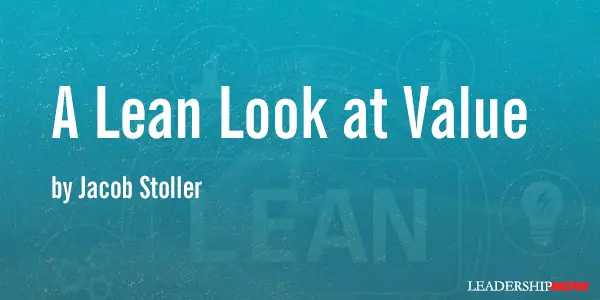
“Price is what you pay. Value is what you get,” said Warren Buffett, adeptly observing that value is more than just a notion of what something is worth. Customer value that is based on substance, as opposed to perceptions, is widely pursued by organizations that aspire to greatness and is also a fundamental building block of the Lean management system. One of Lean’s great triumphs is that it breaks value down into a set of metrics that can be actively pursued. Leaders who aspire to excellence can gain much from studying this approach. Separating value from waste Toyota, who pioneered Lean methods in the wake of World War II, learned how to maximize value under dire circumstances. Desperate to make the most of scarce resources, they began a relentless campaign to eradicate any expenses or activities that didn’t contribute directly to the value that customers would willingly pay for. In other words, maximizing value – Buffett’s proverbial “what you get” - was a process of elimination. For example, an assembler installing a mirror on a vehicle was at that moment adding value. Walking across the plant to retrieve a screwdriver while the vehicle sat idle, however, was considered non-value or waste. If there were more workers than necessary assembling the car, or more parts than needed in inventory, these were considered wastes that added unnecessary cost to the vehicle. The key here is that the workpiece is treated as a proxy for the customer. It’s almost as if extra walking was keeping the customer waiting, or extraneous activity was wasting the customer’s money. This applies in any industry, whether the workpiece is a manufactured product, a meal in preparation, or an insurance claim under review. In healthcare, the workpiece and the customer are the same, making non-value activity waiting particularly visible and objectionable. Where’s the customer? In Lean organizations, all efforts are focused on the customer experience. To support this, Lean organizations drive improvement using metrics that pertain directly to customer value, such as defect rates, on-time delivery, lead times, and cost indicators such as inventory turns. It also prioritizes roles according to customer value – the closer you are to the customer, the more important the work is. In a factory, the shop floor workers who produce the goods are the most important. In a hospital, it’s the hands-on care workers. In an insurance company, it’s the representatives that are on the phone handling customer claims. This approach has profound implications for employees who don’t make products or interact with customers. By the Lean definition, non-production activity, including IT, engineering, HR, accounting, and yes, senior management, can only provide value indirectly through their support of production. This calls for some major role shifts. HR, instead of sponsoring leadership courses, might spend more time in the workplace helping employees develop problem-solving skills. Accounting, instead of trying to explain variances for the past quarter, might spend their time developing real-time reports to help production supervisors make better buying decisions. And senior managers might step out of the executive suite and find out what more they can do to support their value-creating workers. When assessing whether an activity has value, everything stems from one question: “Why would our customers pay for this?” If the answer is “I don’t know,” maybe it’s time to eliminate it.  
Posted by Michael McKinney at 12:11 PM
04.22.15

How a Lean CEO Thinks and Why You Should Too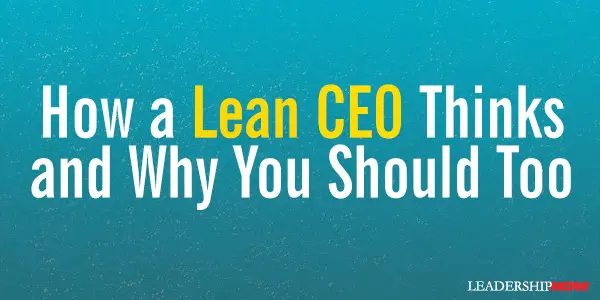 The Lean CEO by Jacob Stoller gets to the thinking behind why Lean management works. I think "Lean" is a poor moniker to give the approach. It tends to make people think of cost-cutting or how to get the most work out of the fewest number of people. It sounds like a manufacturing thing. But that is misleading.
The Lean CEO by Jacob Stoller gets to the thinking behind why Lean management works. I think "Lean" is a poor moniker to give the approach. It tends to make people think of cost-cutting or how to get the most work out of the fewest number of people. It sounds like a manufacturing thing. But that is misleading.
It is a holistic approach to management. It produces excellence because it is good leadership. It is “a fundamental overhaul in the way companies manage people.” To be sure it is about creating the most value from the resources you have whether it be time, money, people, or equipment. It strips away any event that does not add value by creating leaders at all levels. Stoller points out, Lean organizations outperform non-Lean organizations for two basic reasons: Lean Brings Out the Best in People Lean is respectful of people, develops and makes use of people’s gifts. “Lean provides the antidote for the common complaint ‘I love my work, but I can’t stand all the other stuff that goes on.’ Lean sees that ‘other stuff’ as waste, and any employee who feels that frustration can lead the charge to get rid of that waste.” It builds teamwork. How can we produce the best work together? Lean Gets Leaders in Touch with Reality Management does not lack data. What is typically lacking is context. Lean provides that context. It connects every member of the team to what is really going on. A Lean organization is essentially a learning organization which makes it especially suited for uncertain times. “Lean provides a disciplined structure that allows an organization to focus resources on measurable customer-oriented goals, essentially codifying what has made the company successful. Because Lean creates a continuous improvement environment where all employees are asked for input on decisions, the Lean journey allows the CEO to naturally evolve from reactive day-to-day decision maker to proactive teacher, coach, and strategist.” Stoller begins The Lean CEO with an exceptional survey of how we got to be so wasteful. Wasteful of people’s time, energy, and talent in particular. Abundance often leads to waste and hides issues that should be dealt with. Many Lean CEOs would not have adopted Lean practices without a crisis. Stoller profiles 28 Lean CEOs in this book that have implemented Lean in a variety of industries with great success. There is a lot to glean from these pages. Here are some ideas to reflect on: Lean creates the ideal environment for motivating workers. Recognition, variety, autonomy, and the opportunity to learn are all intrinsic to the employee’s role in a culture of continuous improvement. Lean is not just a manufacturing system. It is a way of thinking about people that applies to any organization. Lean is a culture. It’s not a directive. It’s a way of thinking. It is about being open and humble. It’s about diversity of thought and understanding that good ideas come from anywhere. The Lean CEO gets to the heart of what it means to lead from anywhere. 
Posted by Michael McKinney at 10:54 PM
03.03.15

The 5 Habits of Mind that Self-Made Billionaires Possess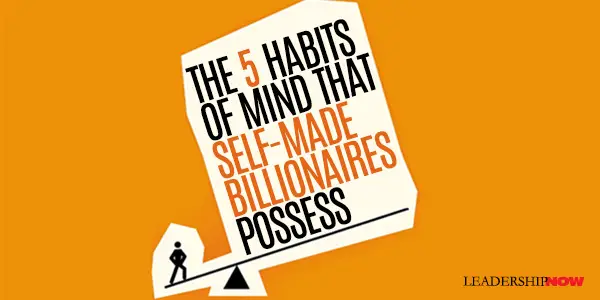
SELF-MADE billionaires think differently than most of us do. Most of us think like what authors John Sviokla and Mitch Cohen call Performers because their success is tracked through performance. They excel at optimizing within known systems. They strive to excel in well-defined areas, and are important to any organization – in fact, they are important to the self-made billionaire. Self-made billionaires have what the authors call the Producer mind-set. They thrive in uncertainty. Producers are critical to any company looking to create massive value because they redefine what’s possible, rather than simply meeting preexisting goals and standards. Combining sound judgment with imaginative vision, Producers think up entirely new products, services, strategies, and business models. For The Self-Made Billionaire Effect, they interviewed 120 billionaires and found that they had in common five habits of mind. What is interesting is that most organizations weed out the very people that they need to create massive value. Imagine what Atari might have achieved if Steve Jobs had stayed there to develop the first mass market personal computer.Self-made billionaires are able to integrate ideas and actions that most individuals and organizations keep separate or even hold in direct tension to one another. Self-made billionaires effectively operate in a world of dualities—they seamlessly hold on to multiple ideas, multiple perspectives, and multiple scales. Here are the five critical dualities that they observed with additional thoughts on each: Empathetic Imagination Producers billion-dollar ideas come through the marriage of extreme empathy for the customer’s needs and wants, and an imaginative mind-set that allows him or her to come up with and explore new, untested ideas. Focusing on the competencies of today is exactly what causes companies to get stuck in the markets they serve and the products they deliver now, with little eye for the shifts and innovation they will need for tomorrow. Sometimes it takes a slight twist in perspective to see opportunities through a different lens. Patient Urgency Producers urgently prepare to seize an opportunity but patiently wait for that opportunity to fully emerge. Producers are willing to operate simultaneously at multiple speeds and time frames. Inventive Execution Producers approach execution of their ideas with the same integrative, inventive mind-set they applied to come up with a billion-dollar idea in the first place. Inventive freedom allows them to design aspects of the customer experience that outsiders consider fixed, thus unlocking new value. Producers frequently operate in markets that require them to rethink the fundamentals of product or business design in order to deliver at scale. Taking a Relative View of Risk Self-made billionaires are not huge risk-takers. Their perceptions of risks are relative: they are far less concerned about losing what they have than of not being part of a bigger future. What Producers are not willing to risk is the chance to capture an opportunity. This dynamic creates a critical duality between the right kind of risk and the resilience needed to do it all over again when the original plan doesn’t work out. Leadership Partnership Producer overwhelmingly do not go it alone. Creating billions in value requires both a master Producer, who can bring together divergent ideas and resources into a blockbuster product design, and a virtuoso Performer, who can apply his or her creative acumen to optimizing the potential of that design. Creating billions in value requires both: the Producer’s ability to bring together divergent ideas and resources into a blockbuster concept and inventive design, and the Performer’s ability to follow through on details needed to make the business work. Why don’t organizations hold on to extraordinarily talented people? These Producers? Here’s the thing: while we can all get behind these attitudes of mind, organizationally we don’t generally reward these traits. We recognize and reward Performers. They get the raises and promotions largely because they're easy to recognize. They fit in; they can hit the ground running. Producers on the other hand don’t always fit because they think differently from those around them. “The ideas they propose move against the standard approach you are following, and that friction is what you need to achieve breakthrough value.” That makes us uncomfortable. As a result, we tend to drive Producers away or cause them to just give up. We need both types, but when looking for new employees we need to look for more people whose background hints at looking at things differently. People who have started something new. People with the raw imagination to see something new and the fortitude necessary to work through the difficulty of execution. “The key imperative for management is to differentiate between opportunities that need a Performer and those that need a Producer. Look at areas of achievement for the business and at who did the work. When it is a Producer, recognize that and give that Producer her next Producer-appropriate challenge.” As leaders we need to accept both Producers and Performers and reject neither. We need to find and support positive deviance while promoting for systematic improvement. 
Posted by Michael McKinney at 11:30 PM
12.05.14

The Culture Engine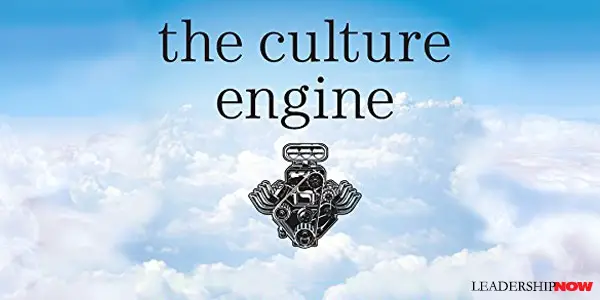
CULTURE is the engine of any organization. It is the force behind everything that happens. It empowers behaviors that communicate who we are whether we like it or not. Getting it right is critical. How do we create a culture that brings out the best in people? Chris Edmonds says that it can be done by the creation of an organizational constitution. “An organizational constitution is a formal document that states the company’s guiding principles and behaviors.” It describes how your organization operates. It makes clear what our expectations are and how we are to achieve them. We have to begin by understanding the truth of how our organization operates. Are we where we want to be? To do that you have to de-insulate yourself, genuinely connect with team members, seek out the truth-tellers, and share your assumptions and what you are learning. Whether we like it or not, we have to “understand that people are acting exactly as you would expect. The way they are behaving now is being reinforced consistently, albeit maybe unintentionally.” In other words, if you are going to define a better way, you have to live a better way. Leaders define the culture. So it’s critical that you live the values and behaviors in your constitution both in and out of the organization. “This scrutiny is unfair, yet it is completely understandable and it is inevitable. You need to expect it and live up to it.” The first element of your constitution is your organization's reason for being. Your purpose statement should be a clear statement of what the company does, for whom, and why. The second element is the “positive values and behaviors you want every leader and employee to demonstrate in every interaction with team members and customers.” These have to be defined in behavioral terms so people have something concrete to measure themselves against. Have a "good attitude" is not specific enough. You can't manage attitudes but you can manage behaviors. The third element is strategy. The strategy represents the path to company goals and expectations. “Every team member should be able to describe how his or her daily projects, goals, and tasks contribute to the accomplishment of team or company strategies.” Edmonds then explains how to manage, measure, and coach others to embrace the organizational constitution. “In high-performance, values-aligned organizations, values accountability is of equal importance with performance accountability. Leaders spend as much time, if not more, communicating, modeling, and reinforcing the department’s values and valued behaviors.” The Culture Engine provides tools in each chapter for making this happen in your organization. The ideas here are not limited to just a few leaders at the top. At any level in the organization, you can make a difference within your sphere of influence. As a leader, you should be intentional about the culture you are responsible to and for.

Posted by Michael McKinney at 01:01 AM
11.28.14

Accelerate (XLR8) IN order to reliably maintain an organization nothing beats a well-organized and well-developed hierarchy. But in order to grow, avoid collapse, and take advantage of the changes happening all around us, we need something more.
IN order to reliably maintain an organization nothing beats a well-organized and well-developed hierarchy. But in order to grow, avoid collapse, and take advantage of the changes happening all around us, we need something more.
John Kotter provides that extra something we need in Accelerate (XLR8). He writes that management-driven hierarchies are “still absolutely necessary to make organizations work.” So what he suggests is not an either/or but a both/and. It is a dual operating system. A second system that is organized as a network that works in cooperation with the existing hierarchy.
The second operating system does not take away from the existing organization but it adds to it, enhances it, feeds it. It is based on a few basic principles: • Many people driving important change, and from everywhere, not just the usual appointees. It recognizes the possible contribution made by anyone in the organization. “You need more eyes to see, more brains to think, and more legs to act in order to accelerate.” It gives more people the latitude to initiate—the foundation for developing leaders. • A “get-to” mindset, not a “have-to” one. Your existing people will step up but only if they “are given a choice and feel they truly have permission to step forward and act.” • Action that is head and heart-driven, not just head driven. Logic alone is not enough. People will want to help you if you can give them greater meaning and purpose to their efforts. • Much more leadership, not just management. Management is the guts of the engine, but “the name of the game is leadership, and not from one larger-than-life executive.” Both practices are crucial but management alone will “not guarantee success in a turbulent world.” • An inseparable partnership between the hierarchy and the network, not just the enhanced hierarchy. “The two systems, network, and hierarchy, work as one, with a constant flow of information and activity between them—an approach that succeeds in part because the people essentially volunteering to work in the network already have jobs within the hierarchy.” Kotter has found that “just 5 to 10% of the managerial and employee population in a hierarchy is all you will need to make the network function beautifully.” He describes eight accelerators for launching and sustaining this two-system model. 
Posted by Michael McKinney at 02:28 PM
10.20.14

Leading Rookie Talent: The Tight Rope and the Safety Net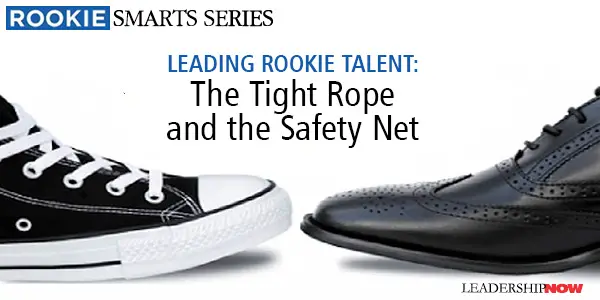
IS IT possible that we are actually at our best when we are least qualified for the job? In my research studying the situations and types of leaders that bring out the best in people, I’ve noticed a counterintuitive but persistent theme: people tend to do their best work when they are out of their comfort zone, doing something important and difficult – often for the very first time. When we are stretched to our limits (and often beyond), we are forced to focus, and we learn fast – a mode I call “rookie smarts.” Working high above ones skill level can feel like a tight rope act – these new performers feel the tension and know that all eyes are on them. It is inevitable that they will wobble and perhaps even fall off at some point. The best leaders and mentors must not only place someone up on the tightrope; they must also be there to catch them when they fall. BTS, a global consulting firm, developed a highly effective system for launching and securing rookie talent on high-stakes projects. Vice president and partner Dan Parisi said, “Our job is to move people from left to right, up a learning curve. When there’s a steep learning curve, you need to build a safety net under it.” On every project, one person, such as the account manager, is the designated safety net. When veteran consultants or project managers assume this role, it is their job to launch the junior talent and be their safety net. When they see a struggling team member, they intervene without usurping control and then put the rookie back on the tightrope. How can managers intervene without usurping control and avoid the resentment that can come from public recognition of the protégé’s false steps? No one likes falling off the tightrope, landing on her back, and needing to be “saved” by the boss. Here’s how BTS uses safety nets to launch people, not deflate them:
A stretch assignment – working high on a tight rope – can be terrifying, both to walk and to watch. But with the dual promise of top performance and professional growth, smart leaders see constructing these challenging assignments as one of their most critical roles. They’ve learned to get comfortable asking others to be uncomfortable. Leaving our comfortable perch is never easy. Many of us go kicking and screaming. Those who venture out can feel the exhilaration of top performance. They might also feel their manager’s reassuring pat on their shoulder, followed by a gentle push.  
 
Posted by Michael McKinney at 01:12 AM
10.16.14

Leading Rookie Talent: Helping New Recruits Hit the Target
ARE your new employees loose canons or heat-seeking missiles? Rookies – people of any age who are new to a task – aren’t weighed down with old assumptions and are more likely to explore new possibilities. Lacking knowledge of their own, they seek out and mobilize a network of experts – my research found they consult with five times more experts than experienced people do. Because they are unsure of themselves they take small, calculated steps and move fast, so they can get feedback. Their lean and agile way of working is extraordinarily valuable in dynamic environments where yesterday’s best practices don’t apply. So, if rookies are really so valuable, should managers turn them loose and let them go? Rookies work fast, but sometimes they run in the wrong direction and get to the wrong answer quickly. Too often a wide-open terrain can leave them wandering aimlessly. A commanding officer in the U.S. Navy said, “Rookies are all thrust and no vector.” They’re full of energy and willing to do the work, but they need to be pointed in the right direction. To provide clear direction, start by doing what you would do for your more experienced staffers—clarify what needs to be accomplished and why it’s important. But, take it further, providing a clear target and the rules of engagement.
While rookies need clear direction, they also need space to explore, experiment and even make mistakes. So once you’ve helped them lock onto a target, make sure they have a practice field to build their skills. You can create a space for experimentation by defining two categories of work: 1) those tasks where success has to be ensured and 2) those where failure can be recovered from. This second realm becomes your safety range—a safe space for you, your team or newcomers to struggle and potentially fail without harming your stakeholders or their business. Within this space, identify a project where you or your colleagues can take a risk, and then in a series of small, calculated steps, iterate until the solution hits the mark. You might even offer the assurance, “In this space, if you totally blow it, I’ve got you covered.” Not only are your rookies capable of doing amazing work themselves, they may just be the spark that unleashes a wave of rookie thinking across your entire team – even with your most experienced staff. But for them to make their mark, they need leaders who know when to rein them in and when to unleash them. So when you release these emerging titans, make sure they are charging for the right target. Watch for my next guest post where we’ll explore how to provide your rookie talent both a tight rope to perform on and a safety net in case they stumble.  
 
Posted by Michael McKinney at 05:33 AM
10.13.14

Leading Rookie Talent: A Sizing Guide for Stretch Assignments
ROOKIES: Bumbling newbies that require copious management? Or underutilized top performers that need to be turned loose? While we often think of newcomers (be they young employees or experienced staff from another arena) as empty vessels that need to be filled up, my research shows that being a rookie – facing a new problem or a challenge for the first time – can provoke top performance. In the realm of knowledge work, rookies tend to outperform those with experience, especially when it comes to innovation and speed. Why? Because they aren’t encumbered with previous knowledge and resources. And, they are hungry. Needing to close a knowledge gap quickly, hyper-learning kicks in, causing them to seek out guidance, experiment and get rapid feedback. They work lean and agile, the smart way all professionals should be working in the current, constantly changing environment. When cycles spin fast and knowledge doesn’t stand still, many leaders never face the same problem twice. In this environment, the ability to learn is far more critical than one’s accumulated knowledge. While rookies are more capable than we might think, they still need leadership and guidance. For starters, they need the right-sized challenge – one that is big enough to really stretch them, but not so big as to break them. When the learning gap is too big, people can easily become overwhelmed and simply let go (or break down). However, when the challenge is too small, people never engage. How do you create the right sized stretch challenge? When someone is in a rookie assignment, err on the side of making the first challenge doable—make it a constructive “micro-challenge,” one with enough tension to create movement and with just the right mix of relevance, difficulty and opportunity for recognition. For more junior staff, carve off a project that can be completed within two weeks, so the rookie gets immediate feedback and recognition. When Jen Lamorena, eBay’s manager of college recruiting, brought on her own new hire, Jen gave her an important project – create and execute a social media strategy to support the firm’s initiative to recruit top university talent. The newly hired employee appeared to go into a spin cycle and sent out a few distress signals. Jen didn’t step in and micromanage, she scoped out a micro-challenge – create a video. With this clear starting place, the new staffer began making connections and mobilizing resources and within two weeks had produced an astonishingly great video that built the confidence she needed to tackle the larger campaign. When establishing the degree of stretch, leaders must also consider what is at stake and reconcile the tension between letting people learn and protecting others from their potential mistakes. While I was teaching a leadership seminar at a hospital for Yale Medical School, several physician-leaders who oversee residency programs voiced an intriguing frustration. While they wanted to give the resident physicians space and freedom to do their best work, the life-and-death nature of their work forced them to micromanage and bark orders. They insisted that there was no room for learning when someone is flatlining on the operating table. I agreed and asked, “What percentage of your time is spent in these situations?” They suggested it was probably 3-5 percent of their time. Yes, these critical situations aren’t rookie moments. But the other 95-97 percent of the time just might be. Along with a micro-challenge, rookies need micro-feedback—a steady stream of information to help them course-correct and stay on track. The best feedback comes in small doses and quick bursts, typically delivered in drive-by fashion rather than formal meetings. The newer someone is to a task, the more feedback they need and the more they need you to recognize and reflect what they are doing right.
When leaders offer a right-sized challenge, they spawn a success cycle. As the newcomer contributes quickly, they build confidence and are ready for an even bigger challenge. With the right leadership, they’ll become perpetual rookies, living and working permanently on the steep side of a learning curve. Watch for my next guest post where we’ll explore how to provide your rookie talent the right combination of freedom and direction.  
 
Posted by Michael McKinney at 11:32 PM
04.04.14

Five Ways to Reduce Conflict When There Are No Right Answers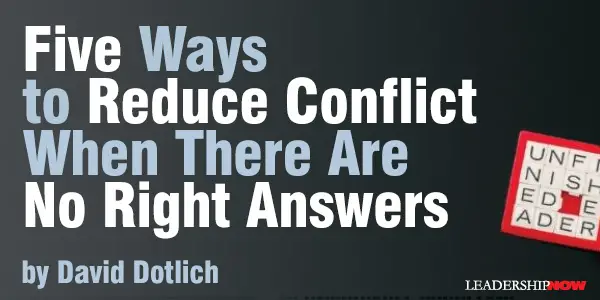
TO be a leader today in almost any organization means you are daily, if not hourly, bombarded with problems and challenges that don’t have clear-cut “right” answers. Or, even more confounding, there are many “right” answers, depending on your perspective. Such challenges include meeting contradictory needs (for example, tending to your “stars” while building the team as a whole), delivering quarterly results while investing for the future, maintaining consistent standards and policies while accommodating unique customer requirements, or staying focused on results while adhering to your company’s purpose and values. The list goes on and on. In the face of these complex contradictions, many leaders choose to deny them and just “get the job done.” But like Marley’s ghost, unresolved and unacknowledged issues keep reappearing. And as leaders ignore or deny them, conflicts begin to emerge, positions solidify, and resolution becomes increasingly difficult. Just to be clear: I am not talking about conflict as it refers to disagreement over how to make a decision in which the facts point to a clear outcome or personal disputes in which one or the other party feels slighted or bruised. Rather, I am referring to those disagreements which emerge in teams or organizations due to how a potential course of action is defined, often in “either/or” terms. By not recognizing the difference between a problem and a paradox, leaders unintentionally generate conflict. This results in both parties adopting a win/lose stance because the problem has not been framed effectively. By not acknowledging the paradox and encouraging “both/and,” not “either/or,” behavior from the outset, paradoxes such as, “How do we maintain global consistency while encouraging local customization?” can easily devolve into conflict, tension, and disputes. And when conflict rages, leaders often attempt to “solve” it by adopting lose/lose compromise solutions in which no one is happy. In my 30+ years of work as a leadership executive and coach for Fortune 500 companies, as well as through interviews with 100 CEOs and top leaders, I’ve identified five effective ways to successfully manage conflict when faced with paradox:
By understanding different viewpoints and then aligning through customer insights and the organization’s higher purpose, people can successfully resolve conflict and come together around meaningful and impactful answers.  
Posted by Michael McKinney at 10:14 AM
01.14.14

The 5 Disciplines of Wiki Management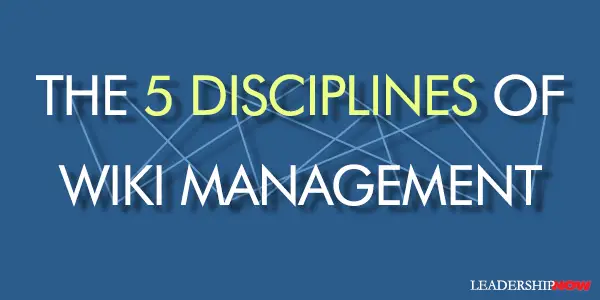
THE world we now live in has forced us to reexamine the way we lead people that gained preeminence during the industrial age and our often immature view of leadership—the “I’m in charge” mentality. Authoritarian leadership implies that the smartest, most valuable people are at the top and so the leader commands and the followers do. Not only is that not true, it’s not sustainable in a world characterized by exponential change. Rod Collins writes in Wiki Management, “Today’s managers may spend more time soliciting input from their workers, but at the end of the day, the basic social technology remains the same: The managers are still the bosses, the workers are still subordinates, and the latter are still expected to do as they are told.”“Wiki” is a Hawaiian term that refers to taking quick action to produce immediate, effective results. Coupled with management, the term offers a way to describe a way of managing designed to help managers keep pace with accelerating change. Collaborative networks are smarter and faster than top-down hierarchies. “Wiki Management assumes that the most effective organizations are highly connected, self-organized networks that are designed to leverage the power of collective intelligence and achieve extraordinary results.” Rather than leaders “acting as controllers who take charge and make the decisions, they assume the roles of facilitators of the discovery processes from which the best decisions emerge.” In general, Wiki Management is about removing inflated ego from the practice of leadership and about breaking down the barriers that define most hierarchies. Collins examines five key disciplines essential to thriving in this “flatter,” highly collaborative landscape:
Collins provides 50 concrete practices to help implement these disciplines and transition your thinking from controller to facilitator. Not everything here is new but what Wiki Management does extremely well, is to guide you through the often counterintuitive thinking that underlies collaborative leadership. It’s leadership that allows people to flourish and can help to detoxify the working environment.

Posted by Michael McKinney at 10:38 PM
11.04.13

Xceptional Execution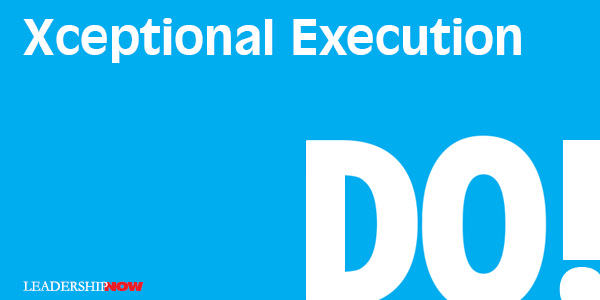
YOU DON'T need to be a guru. You don’t need to be rich. You don’t need to invent the next big thing to be a success. What you need to do, says Kevin Kelly is find an ordinary idea and implement that idea with xceptional execution. You can start with what you have from where you are. The list of reasons why we shouldn’t do something is often long and persuasive. We are predisposed to accept it. And so we let our ideas die. The combination of fear and knowledge is all too often lethal to our best ideas. Kevin Kelly writes in DO! The Pursuit of Xceptional Execution, “the antidote for too much knowledge is execution. Why? Execution helps to work through fear and build confidence. Knowledge will always give you enough reasons not to act. Execution is taking the next step in spite of that knowledge.” Have you ever seen someone doing something that you’ve always wanted to do even though you know they should know better? And yet they’re doing it and you’re not. Maybe it should be, “Those who know teach, those who don’t do.” Too much knowledge can be a dangerous thing.This doesn’t mean that we jump into something without thinking. That’s unwise. Kelly says execution rests on two pillars: Awareness (Self) and Attention (Others). Part of awareness is being able to receive negative feedback, learn from it and apply it in a way that you grow. Anyone you come into contact with is a potential teacher. Kelly says, “You will find that there are zero degrees of separation from potential teachers.” One of the things that holds us back is not that we can’t solve the problem, it’s that we don’t see the problem. Who we are is obvious to others—our co-workers and customers. You’ve got to know what you are projecting to others. The other pillar is attention. “People crave genuine, authentic, undivided attention, the side effect of which is extremely positive: loyalty, engagement and positive word-of-mouth promotion.” Kelly advises that we “focus on building friendships, not customer relationships.” We don’t always know exactly what to do or where we are going, but Kelly insists that the xceptional execution ethos will take you places you never imagined. Xceptional Execution = Opportunity. Kelly talks to nine xceptionalists to understand their story—how they did what they did and how they executed in spite of the ups and downs. Throughout these examples will find mindsets and actions that resonate with your own situation. DO! will expand your mind and broaden your approach. 
Posted by Michael McKinney at 04:32 PM
08.27.13

The Art and Science of Perfect Timing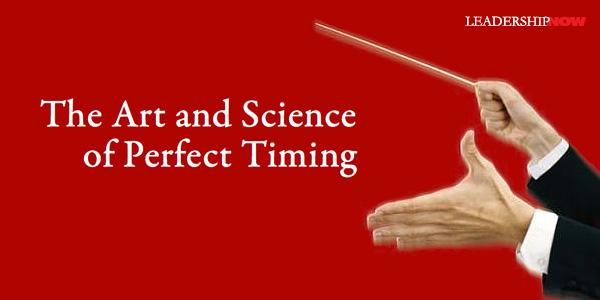
WE SAY timing is everything. And it is. But most of the time it just seems like good luck. In When, Stuart Albert says that using the right tools we can become better at managing and deciding issues of timing. Good timing is a skill that can be acquired. We miss timing issues “because the way we describe the world and the tasks we must accomplish omit the kinds of facts we need….They fail to include all the sequences, rates, shapes, punctuation marks, intervals, leads, lags, overlaps, and other time-related characteristics that are part of the temporal structure of everything that happens, every action that is taken, every plan that is implemented.” And we routinely omit them from our thinking. I had never thought of it that way. I was intrigued. If we don’t look for and note time-relevant characteristics like sequences, rates, duration, beginnings, and endings, we won’t have the information we need to make good timing decisions. For example, we question whether or not the incentives we have chosen are the right ones, but we don’t consider why those incentives became important at that particular time. Albert likens the structure of timing analysis to the structure of a musical score. There is a horizontal and a vertical dimension to it. Five horizontal—sequence, punctuation, interval, rate, and shape—and there is a vertical dimension—polyphony. The way they come together in an organization gives us insight into timing. These patterns form the temporal architecture. Sequence refers to the order of events, like the notes in a melody.
We have to learn how to listen for the rhythm of what is going on, for its moments of tension or release, for moments when we must pause and change direction. Learning to view events in this manner will help us to spot opportunities first, execute on them well, and avoid costly mistakes. The worst timing mistakes are not those that have significant human or financial costs, but those that appear to be inexplicable, where we ask, “How could someone have made a mistake like that?” One example of a sequence issue is Cooper Union’s decision to build a 166 million dollar engineering building on its campus in New York with the hope that a donor would step forward to fund the building. As of May 2013, nobody has. This is a classic sequence inversion error, playing notes out of order—in effect putting the cart before the horse. The first step should have been to attract the donor, who would help select the architect, and then become involved in the design of the building. In order to get the timing right Albert says we need to move beyond spheres and networks, boxes and arrows, trees and branches, and instead think in terms of a tall polyphonic musical score in which a large number of processes and events are playing at the same time. Here’s more:
When provides a more insightful way to look at events and the seven essential steps in a timing analysis. Timing issues are not always obvious but Albert helps us to know where to look and what to look for so we will be much more likely to get the timing right. 
Posted by Michael McKinney at 01:37 AM
06.20.13

Phil Jackson's 11 Principle's of Mindful Leadership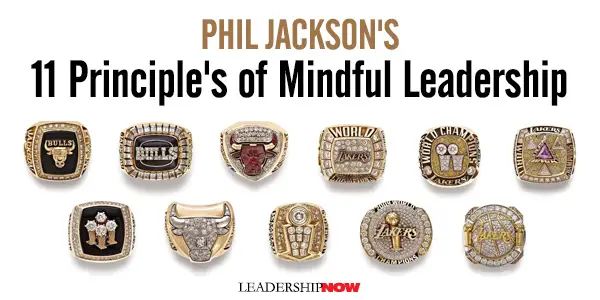
PHIL JACKSON, considered one of the greatest coaches in the history of the National Basketball Association, has won 11 titles as a coach. The most in NBA history. Eleven Rings is a memoir that, for me, is more about leadership and relationships than basketball. Jackson's principles are worth taking a look at. They support the idea that a leader's job is to build leaders at all levels. You could take back to your organization and put into practice today any one of the following 11 principles:1. Lead From the Inside Out. Avoid fads. Lead from who you are. "As time went by, I discovered that the more I spoke from the heart, the more players could hear me and benefit from what I gleaned." 2. Bench the Ego. "The more I tried to exert power directly, the less powerful I became. I learned to dial back my ego and distribute power as widely as possible without surrendering final authority. Paradoxically, this approach strengthened my effectiveness because it freed me to focus on my job as keeper of the team's vision. "Some coaches insist on having the last word, but I always tried to foster an environment in which everyone played a leadership role, from the most unschooled rookie to the veteran superstar. If your primary objective is to bring the team into a state of harmony and oneness, it doesn't make sense for you to rigidly impose your authority." 3. Let Each Player Discover His Own Destiny. Jackson's goal wasn't to provide all of the answers. "I've always been interested in getting players to think for themselves so that they can make difficult decisions in the heat of battle." "My approach was always to relate to each player as a whole person, not just a cog in the basketball machine. That meant pushing him to discover what distinct qualities he could bring to the game beyond taking shots and making passes. How much courage did he have? Or resilience? What about character under fire? Many players I've coached didn't look special on paper, but in the process of creating a role for themselves they grew into formidable champions." 4. The Road to Freedom is a Beautiful System. Similar to the principles used to foster greater creativity and innovation in an organization, Jackson used a system known as the triangle offense. "What attracted me to the triangle was the way it empowers the players, offering each one a vital role to play as well as a high level of creativity within a clear, well-defined structure." 5. Turn the Mundane into the Sacred. Leaders take note. Jackson writes, "As I see it, my job as coach was to make something meaningful out of one of the most mundane activities on the planet: Playing pro basketball." He incorporated meditation into his team's practices. "I wanted to give players something besides X's and O's to focus on. What's more, we often invented rituals of our own to infuse practices with a sense of the sacred." 6. One Breath = One Mind. Players "often have to make split-second decisions under enormous pressure. I discovered that when I had the players sit in silence, breathing together in sync, it helped align them on a nonverbal level far more effectively than words. One breath equals one mind." "If you place too many restrictions on players, they'll spend an inordinate amount of time trying to buck the system. Like all of us, they need a certain degree of structure in their lives, but they also require enough latitude to express themselves creatively." 7. The Key to Success is Compassion. "Now, 'compassion' is not a word often bandied about in locker rooms. But I've found that a few kind, thoughtful words can have a strong transformative effect on relationships, even with the toughest men in the room." Compassion breaks down barriers among people. 8. Keep Your Eye on the Spirit, Not on the Scoreboard. When a player is "playing within his natural abilities, he activates a higher potential for the team that transcends his own limitations and helps his teammates transcend theirs. When this happens, the whole begins to add up to more than the sum of its parts." He adds, "Most coaches get tied up in knots worrying about tactics, but I preferred to focus my attention on whether the players were moving together in a spirited way." 9. Sometimes You Have to Pull Out the Big Stick. Sometimes Jackson used "tricks to wake players up and raise their level of consciousness….Not because I want to make their lives miserable but because I want to prepare them for the inevitable chaos that occurs the minute they step onto a basketball court." 10. When in Doubt, Do Nothing. "Basketball is an action sport, and most people involved in it are high-energy individuals who love to do something—anything—to solve problems. However, there are occasions when the best solution is to do absolutely nothing….I subscribe to the philosophy of the late Satchel Paige, who said, 'Sometimes I sits and thinks, and sometimes I just sits.'" 11. Forget the Ring. We all hate losing. "And yet as coach, I know that being fixated on winning (or more likely, not losing) is counterproductive, especially when it causes you to lose control of your emotions. What's more, obsessing about winning is a loser's game: The most we can hope for is to create the best possible conditions for success, then let go of the outcome." Jackson concludes with: "What matters most is playing the game the right way and having the courage to grow, as human beings as well as basketball players. When you do that, the ring takes care of itself." 
Posted by Michael McKinney at 10:33 AM
06.10.13

Three Rules to Deliver the Best Possible Performance for as Long as PossibleMichael Raynor and Mumtaz Ahmed went looking for those companies that were good enough for long enough to be considered exceptional and to rule out luck as the primary source of their performance. What they found they present in The Three Rules: How Exceptional Companies Think.When they looked at behavior they found that the exceptional companies did better than the average companies because they did whatever they did "right." Not too helpful. But when they looked at what exceptional companies thought as opposed to what they did, a pattern emerged. They were able to identify a small set of decision rules implicit in the choices exceptional companies made that lower-performing companies did not seem to use. This forms the basis of The Three Rules. Here are the three rules you can use to guide your own decision making: 1. Better Before Cheaper. Competing on non-price value, not price. When it comes to how you differentiate yourself from the competition, seek out a position based on non-price value. Do not compete on price. Price-based competition can work, but only rarely does it drive exceptional performance. When the recession hit in 2008, Abercrombie & Fitch (one of their exceptional companies) was criticized for not cutting their prices as most other retailers did. And although their profitability suffered significantly in the short-term and full recovery remains an uphill climb, they are not struggling to cure their customers of a "discount addiction." "Those competitors that coped with the recession with price discounts are finding it difficult to increase their prices, having taught their customer that their T-shirts do not have to cost $30 after all." Of course, no company can afford to ignore its relative price position. That's why the rule is "better before cheaper:" being price competitive is far from irrelevant, but when it comes to position in a market, exceptional performance is caused more often by greater non-price value rather than by lower price.2. Revenue Before Cost. Outperforming through higher revenue rather than lower costs. When exceptional companies face a trade-off between increasing profitability by increasing revenue or by decreasing cost, they systematically choose increasing revenue even if that means incurring higher cost. Do not try to "cut" your way to greatness. Just like price-based competition, cost advantages can be effective, but only infrequently. Profitability advantages driven by higher revenue, even when they incur higher cost, prove to be more valuable than advantages driven by lower cost. "To beat the odds," say the authors, "you want to focus on creating value using better before cheaper, and on capturing value with revenue before cost." 3. There Are No Other Rules. Whatever competitive or environmental changes or challenges you might face, do not give up on the first two rules. Everything else is up for grabs. Everything. The first two rules tell you what you should do. The third rule tells you what you should not do; namely think that anything else matters in a systematic, specifiable way. Change whatever you must about your business—your markets, your technologies, your people…anything. But no matter what, stick with better before cheaper and revenue before cost. What sort of leadership contributes best to corporate success: charisma, hard-driving, larger than life CEOs who move the company forward seemingly by force of will, or humble, deliberate, share-the-glory servant-leaders? As far as we could tell, all that mattered consistently was whether or not leadership was focused on building a non-price position and revenue-driven profitability formula.The idea here is that when faced with strategic decisions, ask yourself which option best conforms to the three rules. Use the rules like a compass to point you in the right direction. It's not a formula to follow but a way of thinking that informs your decisions. Ask yourself if your strategy is taking you in the direction of better and revenue or cheaper and cost. The authors have found that companies that consistently chose the former path deliver superior results. The three rules are measurable and hence actionable. "Because you can measure the degree to which you are following the three rules, you can adapt your behavior to remain consistent with them." 
Posted by Michael McKinney at 12:02 AM
06.05.13

The Clarity Principle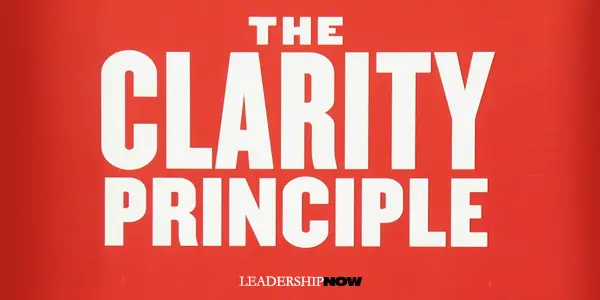 The Clarity Principle by Chatham Sullivan, is about a widespread issue facing many (most) organizations: who are we and what are we doing? What is our purpose? It is a vitally important question that is rarely answered—not really. It's a difficult question to answer and is the cause of much of the dysfunctional, painful and absurd activity in many organizations. Instead of leading we are being lead by the business we are supposed to be leading.
The Clarity Principle by Chatham Sullivan, is about a widespread issue facing many (most) organizations: who are we and what are we doing? What is our purpose? It is a vitally important question that is rarely answered—not really. It's a difficult question to answer and is the cause of much of the dysfunctional, painful and absurd activity in many organizations. Instead of leading we are being lead by the business we are supposed to be leading.
The Clarity Principle states that clarity is derived from purpose, and purpose from a pivotal act of choice that leaders make about the business. Sullivan says that the problem isn't that organizations define themselves incorrectly, it's that they don't choose at all. Choosing "is a risky prospect, fraught with personal, political, and cultural risks for the organization and its leaders." Leaders often "duck their responsibility for choosing because they cannot accept the tradeoffs, risk, and loss that accompany an act of commitment to choose one definition of the business over the other." A purpose is not necessarily set in stone especially in today's business climate. "Companies do and should reinvent themselves. But there is a big difference between redefining your purpose and attempting to stitch together conflicting business models." He adds, "attempting to simultaneously preserve and replace the core is very likely a fool's errand. There is only so much artful balancing a company can endure. The goal of achieving balance between contradictory models often becomes the biggest excuse for failing to make the bigger choice." We may avoid the choice out of a desire to protect the organization and its people—to maintain a perceived stability and collegiality. To address one choice over the other would disrupt the way in which people have become used to operating. But in the long run, this silence will end up hurting the organization. Sullivan writes that "Leadership's primary responsibility is to define the purpose of the business. This means understanding and making choices to resolve strategic dilemmas confronting the organization." We see dysfunctions in the business not merely as "people problems" but as upwelling expressions of larger foundational business dilemmas. Thus what may at first appear to be a turf battle between two departments is really descended from a persistent failure to clarify the company's purpose or a painful fight with a coworker is less a personal failure or conflict of styles than evidence of an important strategic dilemma.Corporate life so often disappoints writes Sullivan, because "the loss of shared purpose makes the experience of business feel as though it's every man or woman for him- or herself. People who feel disconnected from the primary task of the business become isolated from one another." Sullivan provides numerous examples of conversations that have gone on inside companies in search of their purpose. Their struggles can be quite enlightening and helpful in determining our own. What if you're not the CEO? Take responsibility for those things within your ability to control. Acts of small leadership can thus have outsized impact. They perform the role of making monumental undertakings more easily achievable. In truth, you don't have to be a top executive to resist, confront, and even reverse the contagious effects of a crisis. If the conflicts in the business can flow down from on high, generating breakdowns throughout the organization, so too can creative solutions and purposeful action flow upward to help resolve the crisis. What you can do:
The issues addressed in this book will resonate with most of us. "The battle against ambiguity is never-ending," says Sullivan. Choice defines and establishes that some things are more crucial than others. It's the leader's job.

Posted by Michael McKinney at 11:36 PM
05.03.13

How to Make Better Decisions
"Why do we have such a hard time making good choices?" ask Chip and Dan Heath in Decisive. "A remarkable aspect of your mental life," says Daniel Kahneman, "is that you are rarely stumped." We have opinions about nearly everything and are quick to jump to conclusions based only on the information that is right in front of us. We often just go with our gut. And that hasn't always served us well. • An estimated 61,535 tattoos were reversed in the United States in 2009. • Forty-one percent of first marriages end in divorce. • Forty-four percent of lawyers would not recommend a career in law to young people. • Eighty-three percent of corporate mergers and acquisitions fail to create any value for shareholders. The Heath brothers have identified “four villains” when it comes to making decisions:
What can we do? We can counteract our tendencies with these four strategies the authors call the WRAP Process from the first letter of each step:
Making better decisions is a choice. This process will help us to make better choices.

Posted by Michael McKinney at 12:09 AM
04.29.13

Are You a Giver or a Taker?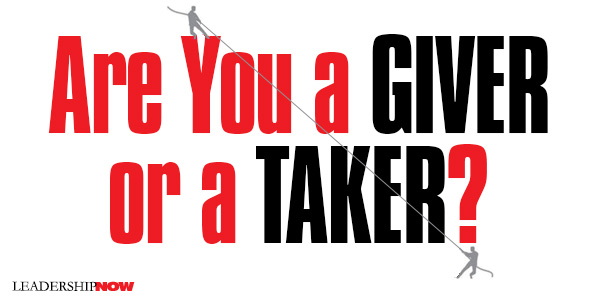
RESEARCH shows that givers sink to the bottom of the success ladder. Givers may make others better off, but they do so at their own expense. But here's the thing, givers also land at the top of the ladder with takers and matchers in the middle. Adam Grant explores in Give and Take, what separates givers at the bottom and top. And the difference is not competence, but the kinds of strategies givers use and the choices they make.Grant notes that in "purely zero-sum situations and win-lose interactions, giving rarely pays off…. But most of life isn't zero-sum." The giver advantage is often hard to see in the short term because the "giver advantage grows over time." Chip Conley, founder of Joie de Vivre Hotels, explains, "Being a giver is not good for a 100-yard dash, but it's valuable in a marathon." The Strength of Weak Ties Givers connect with the people they know casually--their acquaintances. Although it is harder to ask them for help, they are the faster route to new leads and ideas. "The dormant ties provided more novel information than the current contacts. Over the past few years, while they were out of touch, they had been exposed to new ideas and perspectives." The Five-Minute Favor: "You should be willing to do something that will take you five minutes or less for anybody." Givers create a ripple effect around themselves. "Giving, especially when it's distinctive and consistent, establishes a pattern that shifts other people's reciprocity styles within a group." Givers take on the tasks that are in the best interests of the group. Developing Others As leaders, givers don't look for talent first, they focus on motivation. "Because they tend to be trusting and optimistic about other people's intentions, in their roles as leaders, managers, and mentors, givers are inclined to see the potential in everyone." Takers have a general distrust of others. "Even when takers are impressed by another person's capabilities or motivation, they're more likely to see this person as a threat, which means they're less willing to support and develop him or her." Takers desire to be the smartest person in the room. "The matcher's mistake lies in waiting for signs of high potential. Since matchers tend to play it safe, they often wait to offer support until they've seen evidence of promise." Otherish Givers Givers that end up on top are otherish. "Being otherish means being willing to give more than you receive, but still keeping your own interests in sight, using them as a guide for choosing when, where, how, and to whom you give." Giving energizes and is meaningful when it is done out of choice rather than duty or obligation—and otherish givers give more than totally selfless givers. To avoid being taken, it is important to distinguish between givers and takers and those that pretend to be givers. Givers become matchers when they are dealing with takers. Grant provides a lot of fresh examples—people from all walks of life. What he finds most magnetic about successful givers: "they get to the top without cutting others down, finding ways of expanding the pie that benefits themselves and the people around them. Whereas success is zero-sum in a group of takers, in groups of givers, it may be true that the whole is greater than the sum of the parts."

Posted by Michael McKinney at 09:10 PM
04.15.13

Nice Companies Finish First
WHEN you have the power usually associated with leadership, it's easy to begin thinking that you can do anything you want. You can treat people any way you want. Sometimes it works in the short term, but it never works in the long term. It's self-centered, and it eventually kills your influence. It's the core message of Nice Companies Finish First by Peter Shankman: "Being a selfish bastard who doesn't believe the rules apply to you simply won't get you very far." Shankman cites a study where 700 people from a variety of industries reported on the treatment they received from their managers: 31% reported that their supervisor gave them the "silent treatment" during the year.
And it goes on. Not surprisingly, this kind of abusive behavior results in a workforce that "experienced more exhaustion, job tension, nervousness, depressed mood, and mistrust." Shankman says your manager might be a jerk if they: are a know-it-all dictator, are uninterested in feedback, take sides unfairly and openly, are wasteful of resources, are a Desert Island boss (non-existent), a builder of empires, are a talker and not a doer, think adversaries work better than teams or are in a constant cycle of crisis. The Nine "Nice" Characteristics Shankman then identifies nine "nice" characteristics that will eradicate "jerk" behavior beginning with "enlightened self-interest" since it underpins all of the others. A leader with enlightened self-interest will think in terms of the transactional benefits of everything they do. To be sure, there are times when a leader must make unpopular decisions, but, says Shankman, "you can make beneficial decisions and lead your company to greatness without resorting to third-grade schoolyard tactics." An enlightened leader is accountable, invests in others, consults with those affected by decisions, seeks counsel, expects the truth, and reacts mindfully and positively to any situation. The other traits he describes are: Accessibility (Inaccessible, aloof CEOs can run successful businesses for a while, but in the long run, they make bad leaders.), Strategic Listening (leadership is "a lot less about convincing people and more about benefiting from complex information and getting the best out of the people you work with. Listening for comprehension helps get you that information, of course, but it's more than that; it's also the greatest sign of respect you can give someone."), Good Stewardship (Good stewardship is about responsible management and ethical standards that are in sync with the concerns of all of the constituents who are important to your business, including shareholders, stakeholders, investors, neighbors, and communities.), Loyalty (360 Loyalty–loyal to what works for the whole company and for all good employees.), Glass-Half Full POV (Seeing the difference between "Everything's OK!" and "Everything will be OK if we do the following things."), Customer Service-Centric ("Makes it easy for people to become and stay customers in every way possible." Serving first selling second.), Merit-Based Competitor (Compete by differentiation. It's OK to be nice to your competition. Kill them with kindness.), and Gives a Damn ("Turning down the easy buck to instead do the right thing is one of the hardest choices we have to make."). You can't fake being nice. "As communication becomes more fluid, leaders will be more exposed. We won't be able to hide anything anymore."

Posted by Michael McKinney at 12:14 AM
03.20.13

Tipping Sacred Cows or How We Unwittingly Turn Our Virtues Into VicesTipping Sacred Cows by Jake Breeden is one of those bring-you-back-to-reality must-read books. It is about how we undermine ourselves and our organizations and get ourselves into comfortable ruts, by blindly following seemingly virtuous traits. It’s often about taking our strengths too far or misapplying them.Our values give us life and direction on one hand, “and on the other hand can steal our energy, effectiveness, and success. Like rocks in a river channel, these unexamined values can get in our way, impede our efforts, and even capsize us,” writes Breeden. Julian was given the reins of a company and immediately set about cutting waste and inefficiency—his core value. Profits temporarily rose but growth eventually stalled. He took the firm “from growing inefficiently to shrinking efficiently.” In an effort to be efficient, he ripped the heart out of the organizational culture. Breeden advises: Julian Fletcher shouldn’t stop being efficient—he needs to start being more sophisticated. He needs to raise his game so he understands how efficiency can harmonize with other complementary leadership traits he needs to nourish.Breeden tackles seven sacred cows: Balance: “Balance operates through a constant stream of choices.” Balance is often thought to mean finding the middle ground. That’s not balance, that’s compromise. In order to find the middle ground, our choices “can too easily drift toward the middle in a cowardly compromise of nothingness. Balance backfires when it moves from being about bold, sometimes tough, choices to being about bland compromises.” Collaboration: Collaboration should be accountable not automatic. “The default state of working should be alone; leaders should collaborate only when they must. Depending on your role, that may mean a significant part of your job requires collaboration. But ask yourself the question: does this work really need more than me? Creativity: We all like creativity. It’s fun and exciting. But creativity needs to be useful and meet a real need or it’s just narcissistic creativity—creativity to serve our legacy. “Creativity should be pragmatic, not prideful.” Excellence: Our pursuit of excellence “backfires when our high standards choke progress.” Forcing excellence on the process rather than the outcome. One point I would add to Breeden’s section on excellence: excellence isn’t about doing everything perfectly. That’s perfectionism. We need to be careful not to confuse the two. Excellence is a way of thinking and includes making excellent mistakes, learning an excellent lesson and perhaps even going on to make a new and different mistake. If excellence is used as an excuse for indecision, avoiding all risk or unreasonable and immovable standards, it’s counterproductive. Excellence is a term that we sometimes throw around too loosely. It’s an excuse to cover perfectionism and/or controlling and self-centered behavior—my way or the highway. Fairness: “Fairness backfires when some of our noblest instincts force us to ensure equitable outcomes rather than equitable processes.” Keeping score and evening the score to make sure no one gets more than their "fair share" often leads to regrets. Passion: Bad passion crowds out everything else causing you to ruminate on one thing at the expense of others. Healthy passion is part of a diverse set of traits. Passion backfires when it becomes obsessive. Preparation: The problem here is with too much backstage preparation. Preparation is critical but sometimes the best work is done in real-time—onstage preparation—learning while you are doing. To make all of this very practical, Breeden provides in each chapter seven steps to: Make Your Balance Bold, Make Your Collaboration Accountable, Make Your Creativity Useful, Make Your Excellence Meaningful, Train Your Brain to Focus on Process Fairness, Make Your Passion More Harmonious, and seven ideas to Take Your Preparation to Center Stage. Very helpful material. “Sometimes, without realizing it, we use our most reassured values as an excuse to avoid the discomfort of actually leading.” Organizational cultures and personal assumptions promote certain values. If these values are not examined from time to time in light of the overall purpose, then they can cause derailment or stagnation. We can train ourselves “to avoid the waste that comes from the unintended consequences of unexamined conventional wisdom.” We can learn to lead with wisdom.

Posted by Michael McKinney at 07:54 PM
02.26.13

5 Key Practices to Earn Trust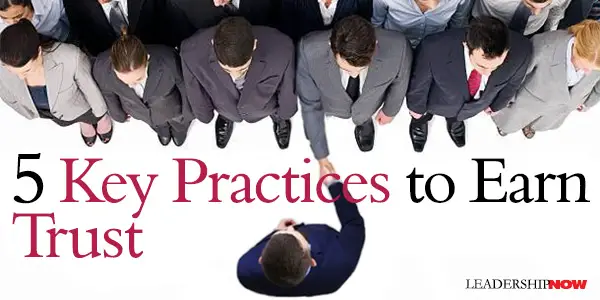
TO TRUST or not to trust is a decision we all make every day. As leaders, we can influence people’s decision to trust not only us, but others in the organization and even the organization itself. Robert Hurley has identified ten specific trust factors in The Decision to Trust. The first three factors are trustor-related: the level of risk tolerance, the trustor’s level of psychological adjustment, and the power position of the trustor.
With these ten factors in mind, you can more easily diagnose why trust may be (or likely to be) high or low in your organization. You can also see what you are contributing to the situation—positively or negatively. Here are five key practices to earn trust: 1. Align your interests with those whose trust you want. High trust leaders try to move their enterprise together by encapsulating stakeholders’ interests not pitting stakeholders against one another. If you want to build trust, start by clarifying and aligning stakeholder interests and prove that you will promote those interests in a fair manner. This may seem to go without saying, but “one of the reasons that trust has broken down in business and society in general is that there are many situations where the complexity of misaligned interests is not acknowledged, must less dealt with.” In these situations, “the best you can do is be clear about interests, decide whose interests will be primary or secondary, and be transparent about what trade-offs you are making and why.” 2. Demonstrate Benevolent Concern. We tend to trust people who we believe will care about our welfare—they demonstrate a benevolent character. People, who appear concerned only with themselves, engender distrust. If you want to earn trust, demonstrate to others that you will do the right thing for them even if it puts you at risk. “Demonstrate a respect for others and understand others’ needs in a way that helps them find win-win solutions.” 3. Develop and demonstrate Capability in the Matter at Hand. We are only trustworthy if we can deliver on our commitments. Good intentions, benevolence, and even ethical conduct, do not warrant trust if the other person is incompetent. High trust leaders make sure that there is a reasonable probability and capability to deliver before they make promises. 4. Create a track record of Predictability and Integrity. High trust leaders tend to practice values based leadership, which creates consistency and coherence in their behavior. Trust comes from always striving to honor ones word. 5. Communicate, communicate, communicate and do it clearly and openly. Because is largely about relationships, communication is critical. Communication is also the vehicle through which the other four elements of trustworthiness are delivered. Aligning interests, demonstrating benevolence, accurately communicating ones capability and practicing what you preach all require effective communication skills. Spirals of distrust often begin with miscommunication, leading to perceived betrayal causing further impoverishment of communication and ending in a state of chronic distrust. Open and transparent communication can induce others to open up and reciprocate with feelings of confident reliance. Of Related Interest:

Posted by Michael McKinney at 10:10 AM
01.21.13

5 Things Smart Risk Takers Do Well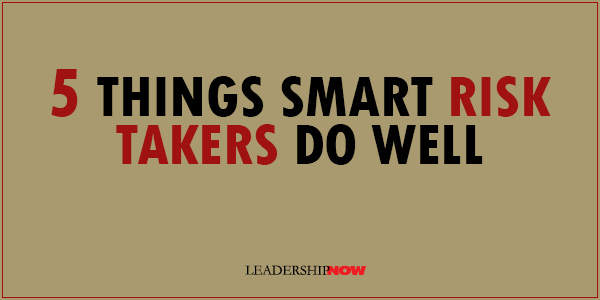 Doug Sundheim’s book, Taking Smart Risks, isn’t really about making your next risky decision smarter or safer; it’s about pushing all of your choices to be riskier, but smarter on a daily basis.
Doug Sundheim’s book, Taking Smart Risks, isn’t really about making your next risky decision smarter or safer; it’s about pushing all of your choices to be riskier, but smarter on a daily basis.
We tend to view our choices as risky or safe. Safe is good while risky is well, risky. You’re taking a chance with a risky choice; it could lead to ruin. Sundheim says that view doesn’t capture the essence of what taking a risk is all about. Taking a risk is “exposing oneself to the possibility of loss or injury in the hopes of achieving a gain or reward.” It’s really the reason we would consider taking a risk rather than just playing it safe. It’s not an either/or proposition—safe or risky. But because we perceive it that way, we tend to do all we can to avoid risk and stay in our comfort zone.  • You don’t win.
Are you caught in the comfort zone? Here’s a thought we can all relate to: Being caught in the comfort zone doesn’t mean that you’re sitting around doing nothing. It’s more nuanced than that. You could be making progress, but not quickly enough. You could be taking chances, but not boldly enough. You could be going out on a limb, but not far enough, and the extra push is what will make a difference. What Sundheim is advocating is a change in our mindset regarding risk. Rather than perceiving risk as negative (“Things may not be perfect now, but they’re not all that bad. If I make a move, things could end up worse. I’d better not risk it.”), we should view it as a balanced focus on both the downside of taking risks and not taking risks (“I’ll regret it if I don’t pursue this thing. I’ve got to find some smart ways to take risks to move it forward.”). A limiting mindset versus a liberating mindset.
Smart risk takers consistently do five things well to disrisk whatever they’re up to:
Communication is a critical element of each of these stages. “At every stage of any risk, improving the way in which you discuss thoughts, plans, and actions is the single most effective way to derisk the risk, that is, to make it smart.”

Posted by Michael McKinney at 10:34 PM
12.07.12

Do Leaders Really Matter?Are individual leaders truly responsible for the end result, or do they just happen to be there—for better or worse? asks Gautam Mukunda in Indispensible. To be sure, Lincoln and Churchill have mattered, but does every leader matter?Of course, every leader matters to someone. But here Mukunda is talking about leaders who matter on a larger scale—those that matter to all of us. What would have happened if someone else had filled the same role. “Leader impact can best be thought of as the marginal difference between what actually happened and what would have happened if the most likely alternative leader had come to power….Will he or she make significantly different choices than the other plausible candidates.” It gets down to how we choose our leaders and how we advance people through an organization. This process, Mukunda calls the Leader Filtration Process (LFP). A given LFP will filter candidates through a process designed to find those who conform to a specific value system—a Modal or standard leader. Occasionally an Extreme candidate will slip through. Many organizations weed out potential Extremes. The military’s promotion system is an example of a tight filtration process. At the other extreme, entrepreneurship is a very loose process—you become an entrepreneur just by deciding to do it. EXTREME LEADERS A leader that has bypassed an LFP is likely to be an Extreme. Charisma helps leaders bypass filtration. “Family connections, personal wealth, and celebrity, for example, all smooth the path to power without subjecting candidates to the risk of being Filtered out by the LFP.” Modal leaders can be highly successful under normal conditions. They are good at maintaining the status quo. I would associate management with Modal leaders. Extremes, on the other hand, are all about innovation. “Extreme leaders will be much more likely to change the goals their organization or state is pursuing and to adopt means to achieve those goals that other leaders would not—that’s why they have such marked impact compared with other Modals.” If you are stuck, an Extreme leader may be just what you need. But while Extremes deviate—and that may be a good thing—they are “far more likely than Modals to have dramatic successes and failures.” “Filtration is supposed to prevent leaders with undesirable characteristics from gaining power.” This is quite understandable. However, “many of those undesirable traits aren’t purely negative—in the right situation, they can be a huge asset.” What helps make an Extreme great is when they couple their decisions with humility. “The Extreme leader does what others would not do, even when others advise him or her against it. To make this sort of choice when the stakes are high takes enormous confidence. Sometimes, however, the Extreme’s advisers will be right. When that is true, the great Extreme leader will have the humility to defer to their judgment. It is this almost paradoxical combination of self-confidence and humility that marks the transcendentaly great leader.” Mukunda’s Leader Filtration Theory has implications as to how and when we choose certain types of leaders to lead us. He recommends that if you are a Filtered leader that you bring a few Extremes into your inner circle. 
Posted by Michael McKinney at 05:11 PM
10.19.12

Leading Apple With Steve Jobs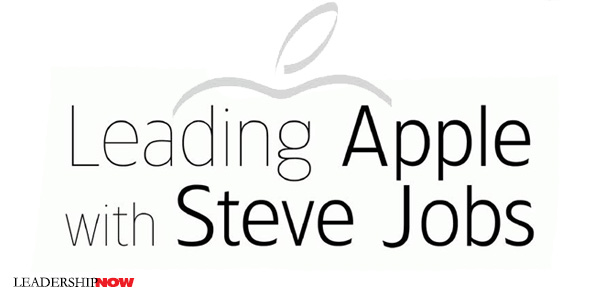
JAY ELLIOT, former Senior Vice President of Apple, has spent a lot of time with Steve Jobs. In Leading Apple with Steve Jobs, he writes that “Isaacson’s Steve is not the Steve I knew.” He believes that there has been too much focus on the negative aspects of how Jobs dealt with people and not enough on the positive. “I think,” he writes, “most people who worked for him, including me, would say they did the best work of their lives for him and don’t regret the experience a bit.” While his stories regarding his time with Jobs don’t do much to polish his image, he does bring out aspects of his thinking that undoubtedly have given people the opportunity to feel that in spite of the negative aspects of Jobs' behavior, Apple is where they wanted to be. When analyzing anything, it always a challenge to pull out the important lesson and learn how to integrate the good without the bad. We are all a complex mix of motivations and behaviors and everything we do seems like an indispensable part of achieving our success (or not). But we can always improve—diminish the negative and emphasize the positive. It is not unusual for any of us to find ourselves in a position where our intention is admirable but we lack the skill to implement it in the most beneficial way. Frequently, we can find ourselves stuck without alternatives to our own patterns of behavior. As leaders, we have to constantly be learning—by reflection and reading about the lives of others—to discover where we could expand our thinking and therefore our options. Not only does Elliot help us understand why Jobs was the way he was, he does a good job of explaining the development of and reasoning behind much of the Apple mystic that is worth implementing. Jobs said that “It’s not my job to pull things together from different parts of the company and clear the ways to get resources for the key projects. It’s my job to push the team and make them even better, coming up with more aggressive visions of how it could be.” Jobs believed that accountability, attention to detail, perfectionism, simplicity, and secrecy, would sustain innovative leadership at Apple. Getting the right people was as important to Jobs as creating a new product. “When you’re in a startup, the first ten people will determine whether the company succeeds or not.” Elliot says that he learned from Jobs the value of “knowing your own values so well that you can instinctively recognize someone who shares those values.” It would be good to reflect on our own values from this standpoint. Another way of thinking about this would be to consider: if you don’t know why you do what you do, why would anyone want to follow you? The right people make the difference. “A leader in the Steve Jobs model needs to have a set of lieutenants who can translate his goals and vision into detailed action plans. The success of Apple through the years has largely been due to Steve’s talent for surrounding himself with people who could bear the heat when he wasn’t satisfied, were strong enough to stand up to him when he was wrong, and were able to relay not just his instructions but his commitment, drive, and vision to the crew.” 
Posted by Michael McKinney at 02:54 PM
09.12.12

The Strategy Book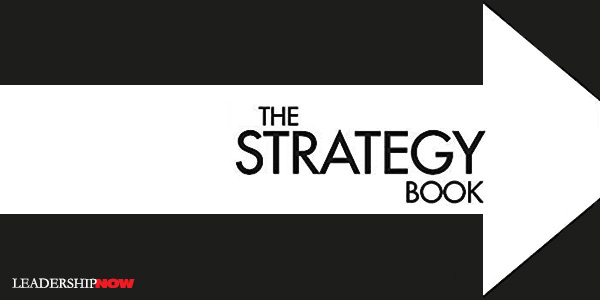
“Strategy is about shaping the future,” writes Max McKeown. There are five basic questions that strategy tries to answer: Where are we? Where do we want to go? What changes have to be made? How should changes be made? How shall we measure progress? There are a number of ways to get the answers to these questions. Max McKeown has created a strategy reference work – The Strategy Book – to guide you to the answers. Each chapter defines the objective, the context and the challenge—and then what success looks like and the pitfalls you might encounter. Well thought out and helpful. Part of thinking like a strategist is learning to recognize unplanned opportunities and reacting. In fact, says McKeown, unplanned opportunities may be your best chance of creating a great strategy. The problem is following a plan so closely without responding to events that you will “lead the company efficiently in the wrong direction.” In a sense, strategy creates risk. “Strategy involves completion of goals, and the risk is the difference between those goals and the ability of the organization to achieve them.” Because “uncertainty can only be reduced by committed decisions and actions,” you can choose to create a “certainty of purpose and direction.” The Strategy Toolkit at the end of the book is not just another nice add-on. It is worth as much as the rest of the book. It contains concise explanations (without all the jargon) of some of the most popular strategy tools and how to use them. In his own words: “First, there are the most popular tools—those that are used most often in the workplace. Second, there are some of the most influential tools from the field of strategy and management. Third, there are tools that I have found valuable in my work with some of the most successful organisations in the world." The tools include: SWOT analysis, Porter's 5 forces of competition, McKinsey's 7-S framework, BCG’s product portfolio matrix, Kim and Mauborgne's blue ocean, Kaplan and Norton's balanced scorecard, Mintzberg’s deliberate and emergent, Prahalad's bottom of the pyramid and twenty-one more. 
Posted by Michael McKinney at 10:20 PM
09.10.12

Help Them Grow or Watch Them Go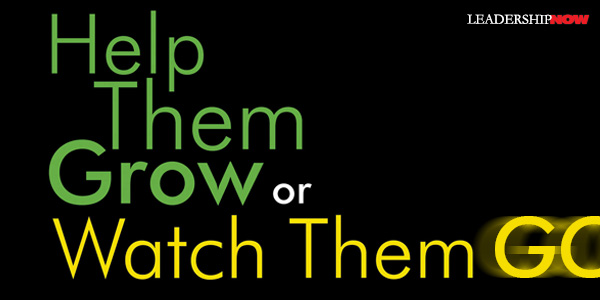
FINDING good employees is not enough. Organizations must have a plan in place to keep the employees they have. A priority for many employees today is career development opportunities. The problem is very few managers and leaders feel they have the time to work on career development. Yet career development, say Beverly Kaye and Julie Winkle Giulioni in Help Them Grow or Watch Them Go, is nothing more than helping people grow. And that’s job one for leaders. Kaye and Giulioni contend that it is not as hard as we usually make it out to be. “Quality career development boils down to quality conversations”—frequent, short conversations that occur within the natural flow of work. They suggest that we “reframe career development in such a way that responsibility rests squarely with the employee and that our role is more about prompting, guiding, reflecting, exploring ideas, activating enthusiasm, and driving action.” Their framework for career development is organized around three types of conversations: Hindsight conversations. These conversations are meant to help develop self-awareness—where they have been and what they are good at. This is even more apparent with by good feedback. “Helping people look back and inward also provides a reservoir of information that allows employees to move forward and toward their career goals in intentional ways that will produce satisfying results.” Foresight conversations. What an employee learns about themselves in hindsight needs to be applied in the context of what is going on around them. “When you help your employees develop the ability to scan the environment, anticipate trends, and spot opportunities, you provide a constructive context for career development.” Insight conversations. These conversations leverage what your employee learns from the convergence of the insight and foresight conversations. Here you guide them into practical steps they can take to be where they want to be. “Onward and upward has been replaced by forward and toward.” Today, it’s not about moving up the ladder but moving to the place you want to be. Kaye and Giulioni suggest that we learn to help them grow in place. This requires a shift in thinking. “The challenge of growing in place involves stripping titles from our thinking and instead focusing on what the employee needs to experience, know, learn, and be able to do.” Too frequently, we limit the scope of career conversations, thinking they’re only about jobs, promotions, or stretch assignments—the actions employees can take to move forward. Important? Yes. But that’s just a drop in the bucket of conversations you can have with employees. We have conversations about the work anyway, so why not make it a teachable moment? “A few minutes of conversation can help others slow down enough to reflect, bring deep insights to the surface, verbalize important messages, and consider how to leverage their expanding skills and knowledge base.” If you don’t think you have the time to incorporate this vital task in what you do, this book is for you. Kaye and Giulioni offer templates, guidelines, and sample conversations and questions that you can adapt to your own situation. With their approach, career development stays fresh because each employee’s career plan is unique and done in real-time.

Posted by Michael McKinney at 10:31 PM
09.07.12

Adaptability: The Art of Winning In An Age of Uncertainty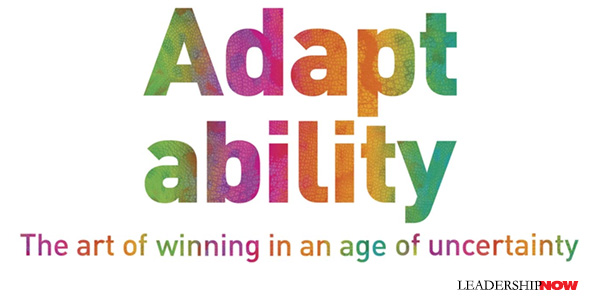
MAX MCKEOWN accurately argues in Unshrink that our beliefs have shrunk us. They have limited our responses. And it profoundly affects our ability to adapt. Adaptability is a book about how people adapt. It is about how to win more often. “In the future,” writes author Max McKeown, “you can try to maintain what you already have, or you can attempt to transcend the constraints of your situation.”Of course, to begin, you have to recognize the need to adapt. That’s not always as easy as it sounds mainly because we have to admit that something isn’t right. You have to understand what’s going on. Enthusiastic ignorance often rules the day. And so as, McKeown points out, “stupid survives until smart succeeds.” Knowing the rules and when to break them is essential to successful adaptability. If you find a system failing, then you have also found a system that is failing to adapt. You need to discover, first, what adaptations are needed for the system to succeed. Second, you should understand what has stopped the system from adapting successfully. And third, you should find out how to free the people in the system to make the necessary adaptations. Once you recognize the need to adapt, you need to understand what adaptation is required. In times of great uncertainty, we need the knowledge creators, the radical and the rebels. “When times are easy, almost anyone can look effective….When choices seem obvious, unimaginative leaders may be rewarded for making the obvious choices even when they know they’re the wrong choices.” Leaders too, need to release its stranglehold on what is considered acceptable and unacceptable thought. Effective adaptation will not happen when there is a dominance of a couple of people over the way everyone else is allowed to think and act. It is important to not only identify what needs to be done, but to keep on learning until you get it right. Something to think about: Most people lock on to a particular course of action, they make their minds up early and fail to adapt to evidence that their choices are wrong. As a result, only a small portion of most people’s experiences lead to new learning. Finally, you need to actually make the changes necessary to adapt. “The most successfully adaptive companies are those that never grow up.” It is rare to find leaders that are comfortable with “learning what is necessary from the people who do the work and know the answers.” McKeown rightly observes that being all knowing is not a human quality. When attempting to adapt, “it is very tempting to try to remake a new situation to match an old situation.” We tend to continue to do what we already know. “In adaptive terms, if you are still in the game, then it’s always the beginning.” This is a critical mindset for successful adaptation. “You can imaginatively rethink your actions so that wherever you are becomes the best place to start.”

Posted by Michael McKinney at 09:29 AM
08.28.12

There is an I in Team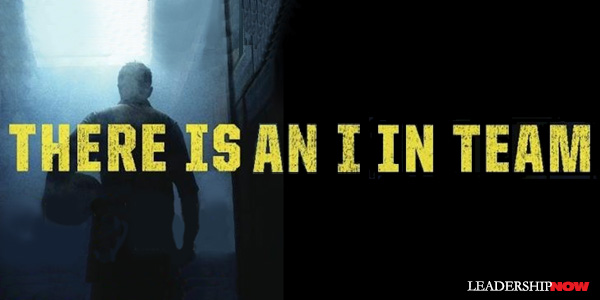
THE often repeated phrase, “There’s no ‘I’ in TEAM” is only half true. It ignores the fact that great teams have great individual members. And high performing teams are not always easy places to be. Mark de Rond acknowledges in There Is an I in Team, that “with few exceptions, the qualities that make individuals as gifted as they are can make them wearisome as team members.” Great team members are often perfectionists, paranoid, stubborn and/or self-confident. But they do perform. “Team leadership is as much about mitigating the risks of these traits as it is about exploiting their potential.” David Whitaker, one of Britain’s most distinguished coaches wrote in The Spirit of Teams, “If you want an exceptional team, keep your eye on the individual … Teams thrive on individual choice and commitment … the most powerful teams are made up of individuals who have chosen to work as a team.” Using fresh examples, de Rond tackles other realities of teams: On high performance teams, everyone is not equal. Star performers increase a team’s overall effectiveness but only to a point. If the proportion of stars versus average members exceeds much beyond about 50%, you begin to experience diminishing returns. Of course, emotional intelligence plays a part. De Rond reports that “if someone is strongly disliked, it is almost irrelevant whether or not he is competent. By contrast, if someone is liked, her colleagues will seek out every bit of competence she has to offer, meaning that a little likeability has far more mileage than competence in making someone a desirable team member.” Without internal competition, teams may underperform. Too much harmony can hurt team performance. “A healthy level of internal competition can help get the best out of high performers.” Citing Timothy Gallwey, De Rond explains, “each player tries his hardest to defeat the other, yet not for the sake of beating another player, but merely to overcome the obstacle he now presents.” Interestingly, one study de Rond offers, finds that often team members value charitable individuals much less than we might expect. After a team activity, members were asked which people they would eliminate. Not surprisingly, the selfish people were unpopular, but so were the most selfless. One explanation was that “seeing others take less than their fair share made them feel bad, and that the only way to rescue their own reputations was to eliminate the martyr. Virtue had become a vice.” While we want everyone to be on the same page, people have different versions of reality. Whether or not they are correct is less relevant than what their realities tell you about their priorities. “At the root of much team conflict is disagreement on why things are as they are and not otherwise, which too easily escalates as colleagues begin to question each other’s motives. To recognize explanations for what they are—a visceral reminder of what matters to people personally—is often a good first step to calming the waters.” De Rond also deals with social loafing or why productivity tumbles with size. An interesting series of studies show that productivity and team size is less an issue of coordination and more a problem of contribution. Team members are “more likely to optimize their performance when faced with slightly fewer members than the task at hand requires.” Management consultant Kal Bishop found that with creative teams in particular, larger teams were inclined to seek consensus rather than explore novel ideas. Understanding and managing our humanity is key to leading teams. De Rond concludes: “Team leaders may choose to increase their reliance on sophisticated technological gadgets to up performance but will only ever be effective when they use these tools to unlock that basic, shared humanity. And, then, not by dispensing solutions, but by knowing what questions to ask and when.”

Posted by Michael McKinney at 10:22 AM
08.24.12

Leadership as Provocative Competence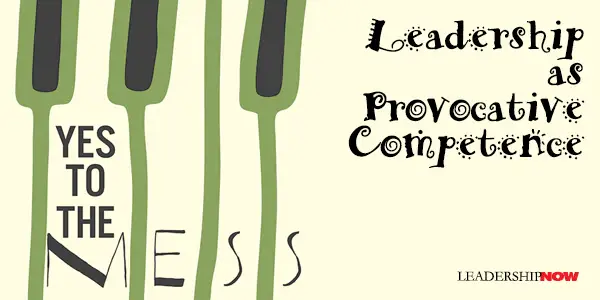
J Barrett introduces us to what he calls Provocative Competence. It is the capacity “to create the discrepancy and dissonance that trigger people to move away from habitual positions and repetitive patterns.” Barrett says “Leadership as a design activity means creating space so that people will be tempted to grow on their own.” Herbert Simon, who won the Nobel Prize in Economics in 1978 for his research on decision making in organizations, believed that we should not think of leaders as making decisions on past data, “but as creating forms so that people can flourish in the future,” or as Barrett expresses more clearly, as shaping “worlds of interpretation in which others can make meaningful contributions.” The outcome then, is to enliven activity and rouse the mind to life. It isn’t about authority but is “relational moves within an unfolding context” and are judged by “how well they work with the resources at their disposal … and how effectively they help free their own potential and that of others.”Barrett breaks provocative competence down into five component parts: First, it is an affirmative move. “What makes these interventions powerful is that the leader holds a positive image of what others are capable of. This often means seeing other people’s strengths better than they see their own strengths.” Second, provocative competence involves introducing a small disruption to routine. “What makes provocative competence an ‘art’ is the introduction of just enough unusual material that it engages people to be mindful—to pay attention in new ways.” Timing and pacing is important he cautions. “Leaders who disrupt on a regular basis or try to be provocative all the time are obnoxious, and are eventually ignored and probably mimicked.” Third, it is important to create situations that demand activity. People are expected to jump in and work it out and discover as they go. Fourth, provocative competence means facilitating incremental reorientation by encouraging repetition. There is a balance here. “Not all repetition is the same. Sometimes you need to repeat a gesture and then start to notice it from a slightly different angle…. Even while people are learning on old habits, they have to attend to new cues and new options, and start to manage and process information within a new, broader context.” Fifth, provocative competence involves analogic sharpening of perspectives and thought processes. “This is the point at which people look back at what is emerging and jump into the morass as they make comparisons, links, and connections to a larger, emerging whole.” This is the thrust of innovation. Net effect: “People start to notice affinity between pieces that previously seemed disconnected; resemblances that no one noticed before start to emerge.” Of course, notes Barrett, “different groups have different levels of performance, and leaders certainly have to deal with imperfect talent, but saying yes to the mess means finding affirmation in the best of what already exists.” That’s the job of a great leader. It’s what separates leaders from bosses. “That’s a true gift: to be able to see people at their very best when their current behavior is far less than that.” Of Related Interest:

Posted by Michael McKinney at 05:59 PM
08.21.12

The Main Thing: How to Keep Organizations Centered on What Matters Most "The main thing is to keep the Main Thing the main thing!" We loved that expression when we first heard it from Jim Barksdale, then the COO of FedEx. That single sentence captures the greatest challenge that executives and managers face today: keeping their people and their organizations centered on what matters most. Every organization needs a Main Thing—a single, powerful expression of what it hopes to accomplish. Without it, it's not possible to align the four elements that produce organizational efficiency and effectiveness: strategy, people, customers, and processes. Does your organization have a Main Thing? Do your people understand it? Are they guided by it? Fred Smith, the Founder and CEO of FedEx, once described to us his understanding of The Main Thing—which he refers to as the "theory of the business." Every successful business has, at its heart, a theory of the business—an underlying set of supporting objectives and a corporate philosophy that gives people a foundation on which to operate. Working inside that framework, they've got an idea of what we want them to do—to prioritize. We [at FedEx] have a very clear business mission and a business theory which is understood certainly by every member of the management team, and probably by 90 percent of the work force."The Main Thing is critically important. It is the end that strategy and human effort serve. We cannot achieve and maintain alignment without consensus and conviction about The Main Thing. Yet we are always amazed by how few people can articulate their organization's main thing. When we ask participants in workshops, "What's your Main Thing?" we see people digging into their wallets for the latest mission statement. Others look questioningly to the person sitting next to them. We wonder how these people can formulate a strategy or know how well they are doing if they cannot even state—or agree on—the ultimate purpose of their work. Some people, however, can articulate their Main Thing without hesitation. Here are a few examples:
What is The Main Thing for your organization? Can you articulate it clearly and concisely? Can your subordinates? In many organizations, people have no clear answer, or will offer a confusing list of lofty goals. Others will describe their strategy. But a strategy is not The Main Thing; it is merely its servant. In some cases senior management defines The Main Thing one way and the people in the trenches define it in another. In these cases people and policies work at cross-purpose; one person is pulling when the other guy is pushing. As you formulate a Main Thing for your organization, keep these guidelines in mind:
Dr. George H. Labovitz is the founder and CEO of ODI, an international management training and consulting company, and professor of management and organizational behavior at the Boston University Graduate School of Management. Victor Rosansky is co-founder and president of LHR International, Inc. He has more than 25 years of experience as a consultant, helping Fortune 500 clients to drive rapid strategy deployment and alignment. 
Posted by Michael McKinney at 02:39 PM
08.06.12

The Pivot Point of Organizational Change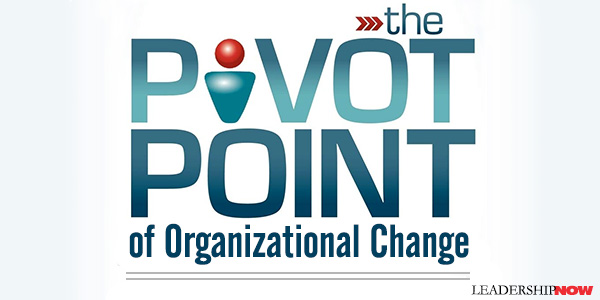
WE know that the vast majority of organizational change initiatives fail. Why? The general answer is our resistance to change. But what if it’s something else? In The Pivot Point, authors Victoria and James Grady ask, “What if this is not a ‘resistance’ problem for which the organization must engineer a solution, but a deeper ‘people’ problem that the organization must first learn to understand and respect?” Perhaps the problem is less about resistance to change and more about attachment to some thing. Change involves destruction and insecurity. You have to give up something to create something new. It’s the nature of change. Sometimes it is very hard to give up that thing. It creates anxiety, frustration and insecurity. “We form attachments to objects unique to our organizational environment and we lean on them for support.” What we react to is our loss of attachment. The essence of the problem is not resisting change per se, but resisting the distress inherent in somehow losing the objects that we attach to or lean on in our work environment. These objects can be people, systems, places, things, or even abstract concepts such as ideas or environments—anything that provides us with a sense of “attachment” to the organization. If this is the case, then the challenge is to identify those attachments and the impact the proposed change will have on them, and design a solution around them—introducing changes will maintain healthy attachments. The authors refer to this as the Pivot Point of organizational change success: “when we recognize the significance of our individual reaction to organizational change, take appropriate steps to support healthy attachment behaviors, and make use of current information to optimize the situation for all concerned.” The authors suggest that “to mitigate the negative effects of losing our sense of stability, one way an organization can ease the transition of a change initiative is to look for a generic substitute to replace the lost object until a new sense of stability is restored. Those replacements could be “a leader, a favored object, a method of communication, a continuing education series, a technology, a colleague, a culture, or any combination of these items.” They also present other methodologies to prevent or modify symptoms before or as they are developing. It is possible to discover which symptoms are most likely to escalate, allowing you to implement a strategy to mitigate these symptoms before you ever begin your organizational change initiative.

Posted by Michael McKinney at 06:28 PM
07.18.12

How to Turn Your Team Around in Six Stages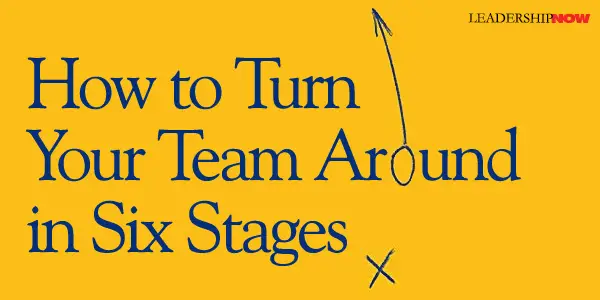
HOW DO YOU transform a losing climate into one that fosters collaboration, innovation, and productivity? Losing is not necessary or permanent, but to turn it around you need a leader who can see the truth, identify where things that have gone wrong, and broadcast the reality of possible in spite of what’s actually happening. A turnaround is really a change in culture—changing the culture of the team or organization.In Team Turnarounds, authors Joe Frontiera and Daniel Leidl present a six-stage Team Turnaround Process. While many of the examples are from sport franchises—Colts, Eagles, Steelers—and the people they interviewed there, they also include turnaround stories of Domino’s pizza, Spider-Man: Turn off the Dark Broadway show, and the state of Michigan. Each stage contains specific developmental milestones—principles that leaders and their teams typically master before proceeding to the next stage: Stage I: Leading Past Losing
The funny thing about truth is that people often want to embrace it. They may not want to hear it, but once it’s spoken, everyone’s shoulders drop in relief. Finally, someone has noticed that the organization has been skating by. Finally, someone is willing to confront the ugly reality. Finally, someone is putting the success of the group above everything else. What most often holds us back are the excuses we hold on to. Stage II: Committing to Growth
Stage III: Changing Behaviors
Stage IV: Embracing Adversity
Challenges are moments of growth—times for you to refine yourself, make yourself better, and believe with even more confidence that you’re on the right path. The resilience and the willingness to take on adversity that come with stage IV will prepare your team for the even larger challenges presented in stage V. Stage V: Achieving Success
We think of life, our efforts, our aspirations, as something like a movie, as if we work toward the one big goal, give everything we have to a single crowning achievement, and when it’s complete, the credits roll. We become so fixated on the effort to achieve that we sometimes lose sight of what we’re doing and how it relates to the bigger picture. We sometimes forget that there aren’t any credits, and that there’s no stop to the action after we hold up the trophy. Life keeps rolling even after our big wins. Stage VI: Nurturing a Culture of Excellence
When teams win, they can become complacent. Success feels good and builds confidence, but it can also breed sloppy habits, overconfidence, and eventual performance decline. The book concludes with the Team Turnaround Workbook. The exercises for each stage will help you and your team work through the Team Turnaround Process.

Posted by Michael McKinney at 11:10 PM
06.28.12

Innovation at Bell Labs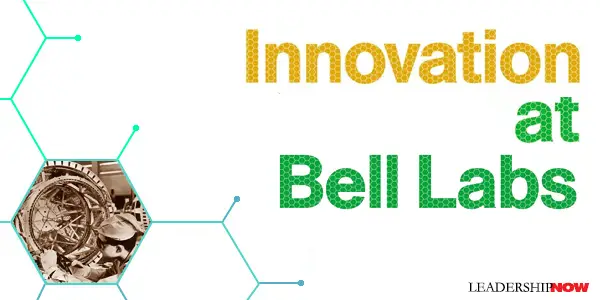
BILL GATES once remarked, “My first stop on any time-travel expedition would be Bell Labs in December 1947,” That was the year Bell Labs invented the transistor—a tiny invention that makes possible the technology we have today. Finding an aspect of modern life that doesn’t incorporate some strand of Bell Labs’ DNA would be difficult. Cellular communications, the laser, digitized and synthesized music, the solar battery cell, the first orbiting communications satellite, and the UNIX operating system, are all products of Bell Labs. AT&T officially created Bell Telephone Laboratories on January 1, 1925. At its peak in the late 1960s’, Bell Labs employed about twelve-hundred PhDs and produced 13 Nobel Prize winners.
 John Pierce is one of the brilliant and interesting people we are introduced to in Gertner’s story. It was Pierce that suggested calling the new device of 1947 a transistor. Peirce was what Gertner calls an instigator. “An instigator is different from a genius, but just as uncommon. An instigator is different, too, from the most skillful manager, some able to wrest excellence out of people who might otherwise fall short.” Pierces real talent was “in getting people interested in something that hadn’t really occurred to them before.” Humans all suffer from a terrible habit of shoving new ideas into old paradigms. “Everyone faces the future with their eyes firmly on the past and they don’t see what’s going to happen next,” observed John Pierce. For creativity to flourish, it needs both freedom and structure. When pierce first came to Bell Labs “he was given free rein to pursue any ideas he might have. He considered the experience equivalent to being cast adrift without a compass. ‘Too much freedom is horrible,’ he would say in describing his first few months at the Labs. Indeed he eventually came to believe that freedom in research was similar to food; it was necessary, but moderation was usually preferable to excess.” Gertner writes, “We usually imagine that invention occurs in a flash, with a eureka moment that leads a lone inventor toward a startling epiphany. In truth, large leaps forward in technology rarely have a precise point of origin. At the start, forces that precede an invention merely begin to align, often imperceptibly, as a group of people and ideas converge, until over the course of months or years (or decades) they gain clarity and momentum and the help of additional ideas and actors. Luck seems to matter, and so does timing, for it tends to be the case that the right answers, the right people, the right place—perhaps all three—require a serendipitous encounter with the right problem. And then—sometimes—a lead. Only in retrospect do such leaps look obvious. When Niels Bohr—along with Einstein, the world’s greatest physicist—heard in 1938 that splitting a uranium atom could yield a tremendous burst of energy, he slapped his head and said, ‘Oh, what idiots we have all been.’” Today there is nothing quite like the Bell Labs of AT&T and Western Electric to produce the creative technology that they did. Bell Labs laser scientist Herwig Kogelnik describes the magic of Bell Labs well: “It’s the interaction between fundamental science and applied science, and the interface between many disciplines, that creates new ideas.” 

Posted by Michael McKinney at 04:54 PM
05.14.12

5 Leadership Lessons: The Leader as Strategist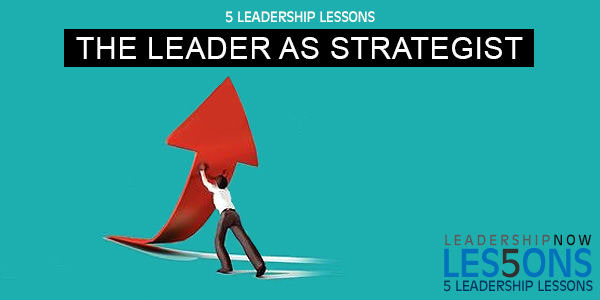
The Strategist is not a book about strategy, but a book designed to equip and inspire you to be a strategist. Author Cynthia Montgomery, says we have reduced strategy to a right-brain exercise and have lost sight of what it takes to lead the effort. The essential component of the strategy-making process is the leader. Leaders must not ignore or underestimate their crucial and ongoing role as a strategist. “Strategy is not a destination or a solution,” writes Montgomery. “It is not a problem to be solved and settled. It’s a journey. It needs continuous, not intermittent, leadership. It needs a strategist.”
What does my organization bring to the world?
As a leader, you must answer them. 
Posted by Michael McKinney at 11:13 PM
05.08.12

What Matters Now
What Matters Now by Gary Hamel is an important book. It is an invitation to rethink the fundamental assumptions we have about capitalism, management, institutions, and life at work. It is, as Hamel describes it, “a blueprint for creating organizations that are fit for the future and fit for human beings.” It would be wrong to assume that hierarchies and managers will go away. But we need to rethink how we operate within our organizations. The book is divided into five fundamental, make-or-break issues that will determine whether your organization thrives or dives in the years ahead: values, innovation, adaptability, passion and ideology. Here are some of his thoughts that become more powerful as they sink in:Values Matter Now. • What matters now is that managers embrace the responsibilities of stewardship. • Every institution rests on moral footings, and there is no force that can erode those foundations more rapidly than a cataract of self-interest. • I think corporate life is so manifestly profane, so mechanical, mundane, and materialistic, that any attempt to inject a spiritual note feels wildly out of place—the workplace equivalent of reading the Bible in a brothel. Innovation Matters Now. • Post these simple questions on your company’s idea wiki: First, what are the thoughtless little ways we irritate customers and what can we do to change that? And second, what are the small, unexpected delights we could deliver to our customers at virtually no additional cost? • Whenever you identify a convergent belief, ask, does this rest on some inviolable law of physics, or is it simply an artifact of our devotion to precedent? By working systematically to surface these invisible dogmas, you can turn reactionaries into rebels. • To innovate, you need to see your organization and the world around it as a portfolio of skills and assets than can be endlessly recombined into new products and businesses. Adaptability Matters Now. • To thrive in turbulent times, organizations must become a bit more disorganized and unmanaged—less structured, less hierarchical, and less routinized. • There are only two things, I think, that can throw our habits into sharp relief: a crisis that brutally exposes our collective myopia, or a mission so compelling and preposterous that it forces us to rethink our time-worn practices. • To put it bluntly, the conversation about “where we go next” should be dominated by individuals who have their emotional equity invested in the future rather than the past. It needs to be led by individuals who don’t feel the need to defend decisions that were taken ten or twenty years ago. Passion Matters Now. • It’s impossible to unleash human capabilities without first expanding the scope of employee autonomy. People need the freedom to challenge precedent, to “waste” time, to go outside of channels, to experiment, to take risks, and to follow their passions. How, many policies in your company exist only to preserve that fiction that the higher-ups really are in control? How many rules enforce standardization at the expense of initiative and passion, while delivering few if any performance benefits? Ideology Matters Now. • The creed of control reigns supreme. If you doubt this, ask yourself: Is your organization any less rules-driven than it was ten or twenty years ago? Do people on the front lines feel any less controlled? Are their freedoms any less abridged? And are little cogs any less obsesses with becoming big cogs? • Give someone monarch-like authority, and sooner or later there will be a royal screw-up. • We don’t have to content ourselves with an organizational model that was designed to serve the interests of ancient military commanders and smokestack-era CEOs. It’s time to re-invent our leadership. This book will help in that process. 
Posted by Michael McKinney at 09:54 PM
04.25.12

When Good Employees Do Bad: Six Surprising Behaviors that May Precede a Scandal Good intentions can lead to bad outcomes in business. This is especially true in organizations that have toxic cultures in which leaders tout worthy values—and then put up roadblocks that prevent employees from living those values. For example, if a company claims it welcomes innovation and risk taking, but then only rewards employees who toe the company line and reinforce the status quo, sooner or later people will simply stop asking questions, innovating, and stretching themselves. Instead, they will conform in order to please their bosses. While the company's competitive edge plummets, leaders may be left wondering: What happened to our core value of innovation and risk taking? When we look at companies that have faced scandals such as recalls, ethical violations, or crimes, the problem often comes down to employees whose surprisingly positive behavior was distorted by a toxic culture and clueless leaders. Here are six seemingly benign behaviors that may come back to bite a company if they become exaggerated and throw the organization out of alignment: Commitment to meeting deadlines. One would think that a company where employees are encouraged to meet deadlines and rewarded for doing so consistently would lead to super-productivity and efficiency. In fact, it can lead to disaster. At Johnson & Johnson, the understood directive to get product to market on tough deadlines created a culture of "Don't ask too many questions" and resulted in a series of dangerous drug recalls that badly sullied the company's reputation. Excessive optimism. When a person is sick, optimism can buoy his spirits and help healing. When a company is unhealthy, "Everything is going to be okay" is not what you need to hear from those in authority positions. Take David Myers, former controller of WorldCom. By his own account, he saw the problems of the now-defunct company through rose-colored glasses. He simply kept believing--and telling his frightened staff--that the problems would resolve themselves eventually. By the time he came to his senses, he was under arrest for accounting fraud. Staying focused on a goal. Telling employees to keep their eye on the prize is not intrinsically a bad thing. But when the goal becomes more important to management than the underlying values of the organization, it can lead to a dysfunctional culture. For example, in the 1990s, Sears gave its auto repair mechanics a mandatory sales goal of $147 per hour. It wasn't long before customers began to be overcharged or sold unnecessary repairs. Having a competitive mindset. Boeing is known for its highly competitive employees and work culture. That's a good thing, right? Not so in 1996, when the company lost billions in government contracts for ethics violations after an employee stole 25,000 pages of proprietary documents from Lockheed. Flash forward to 2005, when employees were still so competitive that their own work teams were known to keep useful information secret from other teams in the company to make sure they stayed on top. Too much competition can erode cultural values, leading to disaster. Sticking to a budget. Most managers would be thrilled if their employees were doggedly determined to stay on budget and not cost the company any unnecessary money. But a good intention can go bad when financial performance becomes the only metric that matters. That was the case, many believe, behind the fatal mistake made on the BP oil platform in the Gulf. Before the explosion in April 2012 caused by a safety shortcut, BP's Macondo project was more than $40 million over budget. You know the rest. Wanting to please higher-ups. What's more attractive than a hardworking employee who wants his bosses to approve of him, based on high performance and outstanding results? A lot, in the case of French trader Jérôme Kerviel at the Société Générale banking group. His need to be liked led to $4.9 billion in massive financial fraud by means of elaborate computer manipulations. Kerviel is thought not to have profited personally from his crimes. He said he was just working to increase the bank's profits and make his bosses happy. David Gebler is a sought-after speaker and panelist, and author of The 3 Power Values: How Commitment, Integrity, and Transparency Clear the Roadblocks to Performance (Jossey-Bass, 2012). He is founder and president of the Skout Group, which helps companies determine whether and how their organization's culture is costing them money, and what they can do to reduce risk and increase performance.
Posted by Michael McKinney at 02:57 PM
04.23.12

Why Leaders Can NOT Procrastinate You're about to end a conference call, and someone says, "Great, we'll send you some materials right away." A day goes by, and then a week. What happens to your confidence in that person? Surely, you may continue to do business together, but you'll always wonder if they'll do what they said they'd do, in the time they promised. So, now is the time to look in the mirror Are you putting something off? Because you forgot, or is it on purpose? Are you missing key resources? Are you waiting for key data before you can make the next decision? Or, are you procrastinating? Begin by exploring your own daily routines. When you understand HOW you work, you can get things done more effectively. Here's an activity you can experiment with this week. Write down the approximate time you arrive and leave the office every day. This represents your “work-week.” (I call this the "window of professional productivity.") For each single hour you were working, you made choices about what to focus on as “priority.” You also chose what did not get done! Here are three ways to get going and sustain an action-orientation to your own productivity:
Jason W. Womack, M.A., M. Ed., advises corporate boards and entrepreneurs on the topics of maximizing productivity and achieving a balanced lifestyle. Visit his website at www.womackcompany.com and share your questions and comments via twitter @JasonWomack.
Posted by Michael McKinney at 01:51 PM
04.20.12

Restoring Your Ability to Choose
WE all like to think we are in charge of our choices. But the fact is that most of the time we are reacting, not choosing. Most of what we label choice is habit. We’re really on automatic. It can even lead us to think that we have no choice. Only when we pause—slow-down to think and reflect—are we exercising our ability to choose. Nance Guilmartin writes in The Power of Pause that a pause is “any space between an action and your reaction.” And it’s vitally important:Today you need the ability to discern what lies beneath people’s words, their reactions, or their silence. If you don’t build the neuropathways in your brain to pause, to momentarily disengage your automatic reactions, you can trigger a chain reaction that derails your best intentions and strategies. Guilmartin lists seven cues that a pause is in your best interest. It’s time to pause if you are thinking, feeling, or saying:
The Power of Pause Method is based on a three-step Effectiveness Equation and twelve Power of Pause practices. The equation: Professional Effectiveness and Personal Fulfillment Not surprisingly, the equation references an all-important addend, humility. Humility should fuel your curiosity and drive the need to pause. Guilmartin explains that “in situations where you think you know enough, pausing to wonder what you don’t know is a vital, even game-changing leadership skill.” The twelve practices are:

Posted by Michael McKinney at 04:36 PM
04.09.12

All In: It’s Culture that Drives Results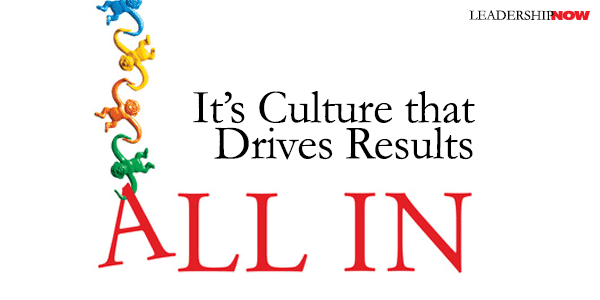
IN THE New York Times, Stephen I. Sadove, chairman and chief executive of Saks Inc., explains that it is culture that drives results: It starts with leadership at the top, which drives a culture. Culture drives innovation and whatever else you’re trying to drive within a company — innovation, execution, whatever it’s going to be. And that then drives results. While we know that our most important resource is our people, it’s not so easy to get people “all in”—convincing people to “truly buy into their ideas and the strategy they’ve put forward, to give that extra push that leads to outstanding results.” All In by Adrian Gostick and Chester Elton explains why some managers are able to get their employees to commit wholeheartedly to their culture and give that extra push that leads to outstanding results and how managers at any level, can build and sustain a profitable, vibrant work-group culture of their own. All In takes the principles found in their previous books—The Orange Revolution and The Carrot Principle—and expands on them and places them in a wider context.They begin by explaining that it all rests on the “belief factor.” People want to believe, but given the fact that “failure could cost them their future security why shouldn’t they be at least a little dubious about your initiatives?” But belief is key. “As leaders we must first allow people on our teams to feel like valuable individuals, respecting their views and opening up to their ideas and inputs, even while sharing a better way forward. It’s a balancing act that requires some wisdom.” To have a culture of belief employees must feel not only engaged, but enabled and energized. What’s more, “each element of E+E+E can be held hostage by an imbalance in the other two.” The authors have created a 7 step guide to develop a culture where people buy-in: Define your burning platform. “Your ability to identify and define the key “burning” issue you face and separate it from the routine challenges of the day is the first step in galvanizing your employees to believe in you and in your vision and strategy.” Create a customer focus. “Your organization must evolve into one that not only rewards employees who spot customer trends or problems, but one that finds such challenges invigorating, one that empowers people at all levels to respond with alacrity and creativity.” Develop agility. “Employees are more insistent than ever that their managers see into the future and do a decent job of addressing the coming challenges and capitalizing on new opportunities.” Share everything. “When we aren’t sure what’s happening around us, we become distrustful….In a dark work environment, where information is withheld or not communicated properly, employees tend to suspect the worst and rumors take the place of facts. It is openness that drives out the gray and helps employees regain trust in culture.” Partner with your talent. “Your people have more energy and creativity to give. There are employees now in your organization walking around with brilliant ideas in their pocket. Some will never share them because they don’t have the platform to launch those ideas on their own. Most, however, will never reveal them because they don’t feel like a partner in the organization.” Root for each other. “Our research shows incontrovertible evidence that employees respond best when they are recognized for things they are good at and for those actions where they had to stretch. It is this reinforcement that makes people want to grow to their full shape and stature.” Establish clear accountability. “To grow a great culture, you need to cultivate a place where people have to do more than show up and fog a mirror; they have to fulfill promises—not only collectively but individually.” And this has to be a positive idea. Gostick and Elton explain that the “modern leader provides the why, keeps an ear close to those they serve, is agile and open, treats their people with deference, and creates a place where every step forward is noted and applauded.” The authors skillfully examine high-performing cultures and present the elements that produce them. A leader at any level can implement these ideas to drive results. A great learning tool.

Posted by Michael McKinney at 11:46 PM
03.30.12

The Power of Habit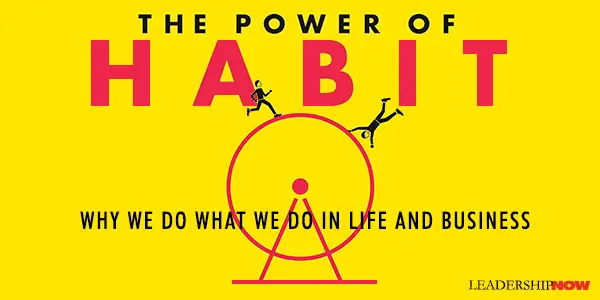
HABITS will always be with us. Some good. Some bad. But how do you replace bad habits with good habits? More importantly, how often do we ask ourselves if what we are doing is really just a habit? We are less intentional than we think we are. Charles Duhigg has written a book for all of us: The Power of Habit. After reading it you will understand how habits are formed and what you can do about it. You will also look at habits in a new way. Habits infiltrate our organizations and become invisible forces to contend with that we never realized were there. Learning to spot them is key to our success. Consider the following story:As a newspaper reporter in Baghdad, Duhigg heard about an officer conducting an impromptu habit modification program in Kufa, a small city ninety miles south of the capital. He was an army major who had analyzed videotapes of recent riots and had identified a pattern: Violence was usually preceded by a crowd of Iraqis gathering in a plaza or other open space and, over the course of several hours, growing in size. Food vendors would show up, as well as spectators. Then, someone would throw a rock or bottle, and all hell would break loose. In a sense, a community—your organization—is a giant collection of habits. Later, when Duhigg talked to the major, he said, “Understanding habits is the most important thing I’ve learned in the army.” “Once you see everything as a bunch of habits,” says Duhigg, “it’s like someone gave you a flashlight and a crowbar and you can get to work.”
The key to remember here, says Duhigg, is that “When a habit emerges, the brain stops fully participating in decision making. It stops working so hard or diverts focus to other tasks. So unless you deliberately fight a habit—unless you find new routines—the pattern will unfold automatically.” Breaking habits down in this way makes them easier to deal with. If we can learn to identify the cues and rewards, we can change the routines. We can live life a bit more intentionally. Duhigg shows how habits played a part in the success of Olympic swimmer Michael Phelps, Starbucks CEO Howard Schultz, and civil-rights hero Martin Luther King, Jr. He goes behind the scenes at Procter & Gamble, Target superstores, Rick Warren’s Saddleback Church, and NFL locker rooms. He explains how improving a single habit rippled out to improve an entire organization—Alcoa. Fascinating material to think about on many levels. How much of what you do is on autopilot? How much of what your organization does is on autopilot? 
Posted by Michael McKinney at 07:08 PM
03.20.12

The Four Disciplines of Organizational Health
PATRICK LENCIONI believes that the single greatest advantage any company can achieve is organizational health. Unfortunately most leaders prefer to deal with the data-driven world of organizational intelligence. The problem is, without good organizational health, organizational intelligence is attenuated. In The Advantage, Lencioni explains that “an organization is healthy when it’s whole, consistent and complete, when its management, operations, strategy and culture fit together and make sense. You know you have it when you have minimal politics and confusion, high degrees of morale and productivity, and very low turnover among good employees.” Additionally, the value of a healthy organization has a ripple effect that affects all who come into contact with it or its employees. What does an organization have to do to become healthy? Creating a healthy organization is a rigorous endeavor. Lencioni has created a four disciplines model: Discipline 1: Build a Cohesive Leadership Team
Discipline 2: Create Clarity In addition to being behaviorally cohesive, the leadership team of a healthy organization must be intellectually aligned and committed to the same answers to six simple by critical questions:
There can be no daylight between leaders around these fundamental issues. Discipline 3: Over-communicate Clarity Once a leadership team has established behavioral cohesion and created clarity around the answers to those questions, it must then communicate those answers to employees clearly, repeatedly, enthusiastically and repeatedly (that’s not a typo). When it comes to reinforcing clarity, there is no such thing as too much communication. As tempting as it may be, leaders must not abdicate or delegate responsibility for community and reinforcement of clarity. Instead, they have to play the tireless role of ensuring that employees throughout the organization are continually and repeatedly reminded about what is important. Discipline 4: Reinforce Clarity Finally, in order for an organization to remain healthy over time, its leaders must establish a few critical, non-bureaucratic systems to reinforce clarity in every process—hiring, managing performance, rewards and recognition, employee dismissal—that involves people. These disciplines may sound idealistic—and they are—but health is a matter of degrees. Any improvement will reap benefits. There will always be those that use "idealism" as an excuse to not make the effort; to find this all too remarkable to actually implement. Not surprisingly, the key is leadership. But it is a sacrifice. If an organization is to get healthy, it must have the “genuine and active involvement of the person in charge. For a company, that’s the CEO. For a small business, it’s the owner. For the school, it’s the principal. For the church, it’s the pastor. For a department within a company, it’s the department head….The leader must be out front, not as a cheerleader or a figurehead, but as an active, tenacious driver.” Without the leader's commitment, this model will be sabotaged or seen as “career suicide.” The leader must support it and reward it. 
Posted by Michael McKinney at 07:57 AM
03.19.12

Being Smart is Not Enough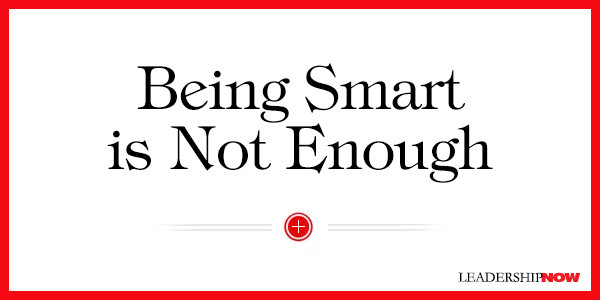
BEING SMART has become a commodity. It's permission to play, says Patrick Lencioni. He writes in The Advantage: In this world of ubiquitous information and nanosecond technology exchange, it’s harder than it has ever been in history to maintain a competitive advantage based on intelligence or knowledge…..I have become absolutely convinced that the seminal difference between successful companies and mediocre or unsuccessful ones has little to do with what they know or how smart they are; it has everything to do with how healthy they are. He reasons that healthy organizations can get smart over time as they are quick to learn from experience and each other, but smart organizations don’t necessarily get healthier by virtue of their intelligence. In fact, it often stands in their way as they are not as open to learning. “The key ingredient for improvement and success,” writes Lencioni, “is not access to knowledge or resources, as helpful as those things may be. It’s really about the health of the environment.” Healthy organizations are able to tap into more of their collective knowledge and use it. “Most organizations exploit only a fraction of the knowledge, experience, and intellectual capital that is available to them. But the healthy ones tap into almost all of it.” In short, what Lencioni is talking about is a component of humility: teachability. Teachability plays a huge role in determining the health and consequently the success of an organization. Unhealthy organizations are hindered by politics, confusion, and low morale, resulting in low productivity and high turnover. Next time we’ll look at what an organization has to do to become healthy.

Posted by Michael McKinney at 12:02 AM
03.12.12

The 11 Essential Elements Needed to Achieve True Collaboration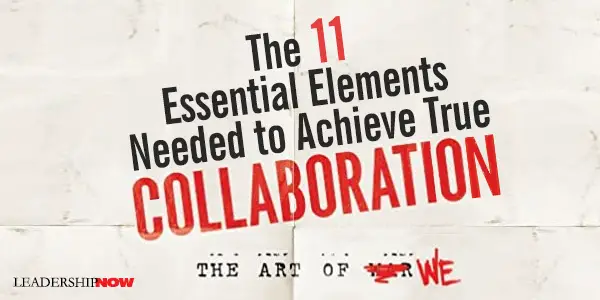
DAN SANKER states that ironically, in order to remain “competitive” companies will have to become more collaborative. Collaborate: The Art of We is a practical guide to going beyond democratic or cooperative work to creating truly collaborative work environments as a growth strategy. Collaboration is not a new concept, but globalization and new technologies have turned it into one of the best methods of competitive advantage available. Rather than engaging in an endless tug-of-war over the dwindling crumbs in a finite market, collaborative companies find ways to make the pie bigger, or create whole new pies, expanding everyone’s market and revenue. “It’s not about how many people you can defeat, but rather about how many people you can help win.” Although networking, coordination, and cooperation may look like collaboration, they are not. True collaboration is the “synergistic relationship formed when two or more entities working together produce something much greater than the sum of their individual abilities and contributions.” It results in something that did not exist before. The focus is on results and not process. Collaboration is distinct from cooperation in that “although both cooperating parties may achieve a common goal, they do not necessarily enhance each other’s capacity. In addition, cooperating parties do not fully share risks, responsibilities, and rewards. In the case of collaboration, all available resources, as well as risks, responsibilities, and rewards, are fully shared.” For a collaboration to be successful, Sanker says that eleven elements must come together: Ongoing Communication. People need to be able to talk to one another freely and regularly. Groups that do not have this kind of interaction are nothing more than loose collections of individuals working on their own tasks, toward their own ends. Willing Participation. Everyone believes that they are working toward the same, mutually beneficial goal and that each one of them will have gained something valuable when that goal has been achieved. Brainstorming. It’s the creative part of the collaboration process, in which members of the group move beyond the “same kind of thinking” to come up with new ideas that bring true value to the collaborative effort. Teamwork. It’s teamwork that keeps people with a diverse set of skills, knowledge, information, and perspectives working together effectively and efficiently to achieve their common goal. A Common Purpose. If the group moves forward too quickly without taking the time to clarify their goal and make sure that everyone is in agreement about what it is, they will undoubtedly run into huge disagreements that are likely to tear the effort apart. Trust. You need to feel confident that other people in the group are putting the group’s shared goal—not their own interests—first, and that they will keep confidential or sensitive information within the group, take you seriously, respect your point of view, and not take credit for your ideas. A Plan for Achieving the Goal. Everyone needs to be working from the same script, clearly understanding roles and responsibilities, and they need to have the same understanding of what success looks like. A Diverse Group. Diversity is the power behind collaboration. Without diversity groupthink sets in. It is diversity that gives a team the unique perspectives needed to create truly innovative solutions. Mutual Respect. For collaboration to be successful, team members must encourage, listen to, and seriously consider all of the ideas suggested by others in the group, no matter how unworkable they might seem. A Written Agreement. A written agreement helps the group avoid misunderstandings and lack of clarity that could derail the process after everyone has invested a great deal of time, effort, and resources. Effective Leadership. Whether one person has been formally designated as the leader of the group is self-led, leadership of some sort is essential to keep the group focused on its destination and facilitating the process of getting there. 
Posted by Michael McKinney at 11:33 PM
02.15.12

The Inner World of the Leader: On the Couch with Manfred Kets de Vries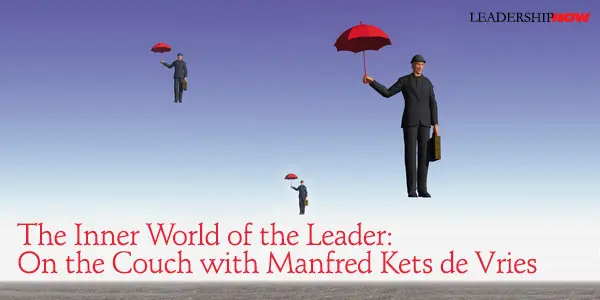
WHY do organizations attempt to function on the basis that executives are logical, rational, dependable human beings? Kets de Vries is a clinical professor of leadership development at INSEAD. His background in economics, management, and psychoanalysis, adds a great deal of richness and context to the study of leadership. Over the last three years Jossey-Bass has published a mostly revised and updated collection of his rather large body of thoughtful-provoking writing in this series of three books. The opinion of one of the power holders in the [Harvard Business School] Organizational Behavior department was that I would never write anything. That particular person must have had a very good understanding of human behavior. One of the small pleasures of life is doing something people say you will never do. I believe that [Reflections on Character and Leadership] is my twenty-ninth book. I have always thought that academics are masters in character assassination.Kets de Vries begins the series with Reflections on Character and Leadership. In it he examines some of the major issues about leadership. What makes a leader? What is good leadership? And what is bad? What happens to organizations if a leader derails? What are the impacts of successful and failed leadership on followers and organizations? Every leader needs someone who is willing to speak out and tell the leader how it is in order to create checks and balances—the counterweight of the person in power. Without such people leaders easily derail and organizations can become paralyzed by fear, mistrust and insecurity. He explains how leaders construct organizations that are great places to work. The era of the highly structured organization is past….Clearly, some executives may not be able to deal with the ambiguities that this new kind of networking, boundary-less organization entails—the external boundaries in an organization can be removed fairly easily, but the boundaries inside people’s heads are more difficult to dissolve. Weaning some leaders away from their need for authority, structures, and controls may take considerable time and effort. In the long run, however, it will be well worth it. Eventually, they will enjoy their work more, and be more effective.Kets de Vries says that narcissism is an inescapable aspect of human nature—and leadership. It has had a generally bad press. “There is such a thing as a healthy dose and it lies somewhere on a wide spectrum that ranges from grandiosity and showmanship to denigration and coldness.” He begins Reflections on Leadership and Career Development by discussing narcissism and leadership. Leadership can be pathologically destructive or intensely inspirational. But what is it about the leaders themselves that causes them to be one or the other? I believe the answer lies in the degree of narcissism in the personality of the leader in question. He discusses the qualities characterize great leaders and the interactions, both positive and dysfunctional, between leaders and followers. “The truly effective leader “is the one who knows how to balance reflection and action by using self-insight as a restraining force when the sirens of power start singing.” He takes a look at leadership archetypes and how they operate within organizations—and how to deal with them. He concludes with an examination of the issues, anxieties, and opportunities that we face at midlife and beyond. How can we alter our perspective on life to become “twice-born”? Finally in Reflections on Groups and Organizations, Kets de Vries looks at leadership issues in the context of groups and organizations. He examines various ways in which neurotic individuals create neurotic organizations. He describes how folie à duex—literally “madness shared by two”—works in an organizational setting; how individuals’ activity or passivity and tendency toward conformism can contribute to the process and what checks and balances could be used to forestall and manage dysfunctional leader-follower relationships.Kets de Vries doesn’t believe leaders are born. While some seem to have a head start, leadership potential can be developed. “Leadership potential is a delicate interplay between nature and nurture.” An effective leader is someone, says Kets de Vries, “who is a little like a Zen riddle, or kōan—a paradox who is comfortable dealing with paradoxes. Because a leader has to be active and reflective, an introvert and an extrovert, engaged in both divergent and convergent thinking. A leader needs IQ, but also EQ. A leader has to think atomistically, but also holistically, for the short term and the long term. Anyone who can balance these contradictions effectively will do well.” He advocates the building of an organization wide coaching culture ad discuss how it can be implemented. There are several basic things that any leader has to do: provide focus, understand what makes their people tick, set an example, and make things happen. However, the distinguishing factor between mediocre and great leadership is always the same: the creation of meaning….When it comes down to it, people are searching for meaning. This series of books cannot be read quickly. Each book in the series seeks to understand leaders, human nature and its vicissitudes. They need to be reflected on. They will challenge your thinking, widen your perspective and inspire you to do better.
Posted by Michael McKinney at 04:08 PM
02.13.12

Nine Reasons Managers Struggle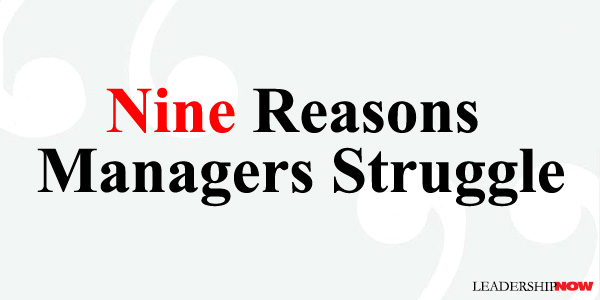
FORMER CEO and president of Verizon Wireless, Denny Strigl explores nine specific behaviors that leaders do and don’t do that make them serious performers, marginal performers, or failures. In "Managers, can you hear me now?" he says it’s all about behavior.

Posted by Michael McKinney at 06:37 PM
02.10.12

Grow: Taking Your Purpose to the Next Level
Jim Stengel, former global marketing officer for Procter & Gamble, believes that businesses must rethink their purpose to achieve far better results. But not just the most apparent purpose, but a higher-order ideal or purpose. For example, Johnnie Walker exists to make great whiskey, but its higher-order ideal is to celebrate journeys of progress and success. Starbucks must make great coffee, but it must do more if it is to attract people and innovate in ways that make life better for the people they serve both inside and outside the organization. “It’s necessary,” writes Stengel in Grow, “to want to be the best-performing enterprise around, with the highest standards, the best people, and the most satisfied customers. However, this simply doesn’t aim high enough and look far enough ahead. To hit higher targets and stay out in front of the competition requires an ideal.”To that end, Starbucks also exists to create connections for self-discovery and inspiration. It’s what fuels passion and creates meaningful work. “A brand ideal of improving people’s lives is the only sustainable way to recruit, unite, and inspire all the people a business touches, from employees to customers.” Stengel believes that a higher-order brand ideal must improve people’s lives in one of five fields of fundamental human values: Eliciting Joy: Activating experiences of happiness, wonder, and limitless possibility; create moments of happiness that engage our thoughts and emotions as well as our physical senses. (Coca-Cola, Zappos, Lindt) Enabling Connection: Enhancing the ability of people to connect with one another and the world in meaningful ways. Key concepts in this field are: connect, listen, reach, and community. (Airtel, Fed Ex, Blackberry, Natura) Inspiring Exploration: Helping people explore new horizons and new experiences. Helps customers learn, gives them powerful tools, and invites them to reinvent themselves and their world. (Apple, Discovery Communications, Pampers, Red Bull) Evoking Pride: Giving people increased confidence, strength, security, and vitality; supporting self-expression and inspiring passion. (Calvin Klein, Heineken, L’Occitane) Impacting Society: Affecting society broadly, including by challenging the status quo and redefining categories. (Accenture, IBM, Method, Seventh Generation) Stengel’s bases his conclusions on a ten-year growth study involving 50,000 brands. The study tracked the connection between financial performance and customer engagement, loyalty, and advocacy. The result was “The Stengel 50.” In the 2000s, an investment in these companies would have been 400 percent more profitable than an investment in the S&P 500. “If you’re willing to embrace the same concept and align your business with a fundamental human ideal, you can achieve extraordinary growth in your own business and your own career. My research shows that your growth rate can triple.” As a side note, whether or not the study suffers from the Halo Effect is beside the point. Stengel’s point is good psychology. Success is more complex than any one factor. More good decisions than bad (intelligent people make dumb mistakes too), timing, and luck all play a part too. And then great companies get off track, not because they were doing the wrong thing, but because they stop doing them or failed to adapt appropriately. The ideas presented in Grow are what worked for Stengel for the time he was at Procter & Gamble and properly applied may work for you too. Generally, if it is based on sound principles, it’s always worth consideration. And Sengel’s ideas are. One implication of the study is interesting. Stengel reports that the “study challenged P&G’s paradigm of moving people around frequently. The companies that were growing the fastest had a different paradigm. In recruiting and hiring they looked for people whose values fit with their brands and tended to keep people working in the same areas for much longer.” He categorizes the people that run The Stengel 50 as business artists. “The fastest-growing businesses in the world have a leader whose relationship to the business is not primarily that of an operator, no matter how savvy, but an artist whose primary medium is an ideal.” The business case for ideals is about playing a role in the lives of both customers and employees at a much more important level than the competition does. It’s about connecting with people holistically: rationally and emotionally, left brain and right brain. Stengel recommends that you continually ask four questions: How well do we understand the people who are most important to our future? What do we and our brand stand for? What do we want to stand for? How are we bringing the answers to these questions to life? The power is in the answers and executing against them. What is your primary purpose? What do the people you serve care about beyond what they buy from you? Could you benefit from discovering your higher ideal? Of Related Interest:

Posted by Michael McKinney at 05:00 PM
02.08.12

Lead With Purpose
WITHOUT A CLEAR SENSE of purpose, organizations become listless. John Baldoni says in Lead With Purpose that it falls to the leader to make certain that organizational purpose is understood and acted upon. Retired Army colonel, George Reed told Baldoni that the importance of this cannot be underestimated: I don’t think you can hit purpose enough as a senior leader. It is one of those things that can be undercommunicated by an order of magnitude. You cannot oversell, overpronounce “Here’s why we’re here.”The problem is that leaders think that they have communicated it enough, but the urgencies of the day cause people to forget their original intentions and their passion. It causes leaders to forget too. Repetition is essential. Baldoni states: How well leaders use purpose to create the vision, mold the mission, and shape the values will serve as a testament to their ability to bring people together for a common cause.It may begin with an explanation of what the organization does, says Baldoni, but it is vital that it be linked to the organizational culture and values. That means having clear-cut, definite goals, putting people first, and importantly, reducing purpose to a simple and memorable statement. Baldoni has illuminated seven key people-smart things that organizations must do to succeed in the new future: Make purpose a central focus. Organizations that succeed are those that know where they are headed and why. Leaders of purpose tap into the power of narrative to help employees make sense of adversity and have faith in their organization’s ability to not just survive, but continually adapt and thrive. Instill purpose in others. Prioritize people. People have to know what they are doing and why they are being asked to do it. To cultivate and leverage high-performing people, emphasize mission, values, creation, collaboration, and execution, establish clear expectations for behavior, and embrace the credo: “Honor the workforce.” Make employees comfortable with ambiguity. Purpose can provide clarity in unsettled times. Leaders who find clarity in chaos, practice the virtues of pragmatism, and teach critical thinking skills will make living with uncertainty easier for their people—and themselves. Turn good intentions into great results. Even in a tough world and a people-sensitive company, it’s a bottom-line fact: the work still has to get done. Leaders of purpose balance creativity with practicality; keep a firm eye on efficiency, effectiveness, and accountability; and strive to instill ownership in every individual worker. Make it safe to fail (as well as prevail). Reasonable risk, daring to try something radical while keeping a grip on what works and what doesn’t, is critical to every breakthrough success. Leaders of purpose explore the impetus for change—reason, urgency, action—before leaping; respect their people’s resourcefulness; and handle setback with grace. Develop the next generation. Few senior business leaders will be in their current jobs five or ten years from now. Leaders of purpose prepare their people for a future beyond them by hiring with care, developing capable, competent employees who are able to rise to challenges and seize opportunities; and enabling others to lead. Prepare yourself. Purposeful organizations need leaders who know themselves first; have the inner compass that points them in the right direction. Many leaders never take the time to do so. Take time to reflect on what you want to do, why you want to do it, and how you will do it. Baldoni says to define purpose, you want to ask three questions: What is our vision? Vision emerges from the sense of purpose. It forms the why, but it also embraces the future as in “to become” the best, the most noted, the highest quality, or the most trusted. What is our mission? Your mission is the what of an organization; what it does. What are our values? Neither vision or mission mean much if they are not reinforced by strong values. Values shape the culture. Values enforce the behaviors that employees cherish.
 

Posted by Michael McKinney at 11:38 PM
01.27.12

Managing With a ConscienceWe handicap our potential when we think we have to exploit others to get ahead. Succeeding is not a zero-sum game. We don’t look better when everyone else looks worse.Frank Sonnenberg makes the case in Managing with a Conscience, that the only sustainable way to succeed is the right way—not cutting corners—emphasizing the intangibles like trust, creativity, focus, speed, flexibility, relationships, loyalty, and employee commitment. While not readily measureable, they can make or break leaders and organizations. Sonnenberg believes that leaders who have a jaded view of intangible assets will never make the commitment required to reap their full potential. Sonnenberg discusses at length, nine critical success factors that need to be built into the organization:
Employees have the right to approach management. Management should announce an open-door policy. But announcing is not enough. Employees should feel comfortable approaching management. Ask yourself if you’re in your office long enough to be approached. Are you available at convenient times or only at 7:00 a.m.? Has your administrative assistant done everything to screen you from “outsiders” except put barbed wire outside your office? When a concern was brought to your attention, in confidence, did you divulge any part of the information? Do you just go through the motions of listening? It is up to you to take the initiative and get out of your office to meet with employees. Been seen on a regular basis so people don’t think you’re avoiding them.Sonnenberg writes, “If your organization isn’t focused, someone is probably undoing something you just completed.” How true. As he notes, when people don’t know or understand the organizational purpose, they end up going in different directions, often competing with each other. And this is true in the social media environment, too. It is not unusual to see social media participants undoing an organization’s values and beliefs because they simply don’t understand them or can’t live them. They create conflicting messages that undermine the purpose of the organization. “The costs to society,” writes Sonnenberg, “of everyone acting like random molecules bouncing off one another is just too great. We have no time to think about what is important. We judge someone’s worth by what we see on the outside rather than their inner worth. We envy someone who has achieved success without thinking about what they did to earn it.” We can change that, if we begin with our own example first.

Posted by Michael McKinney at 04:34 PM
01.13.12

Why are Organizations Slow to Respond?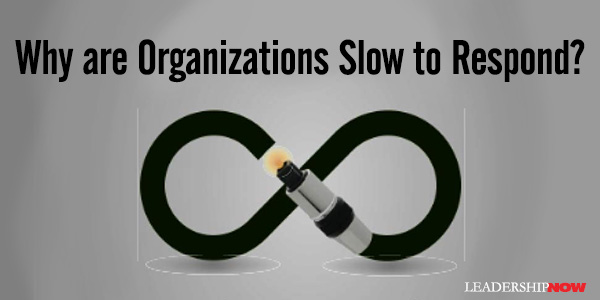
ORGANIZATIONS are only human. Organizations share many characteristics with the people that populate them. Organizations are born, they mature, they age, and they die. The life expectancy of most is about 15 years and only 5% last longer than 50 years. They begin with an innovative idea—even developing beyond all expectations—but eventually they begin to show signs of aging. Claudio Feser writes in Serial Innovators, “Some firms become blinded by success and begin to resist external views and challenges. Some are locked into mental models and become driven by habits. Some lose the sense of purpose that pervaded them in the early days. Some become bureaucratic. Some have processes and incentive systems that have put them on autopilot, leading in a dangerous direction. Some develop dysfunctional organizational cultures.”Occasionally, some organizations resist these all too human tendencies and thrive. They continually reinvent themselves. They confront rigidity. They become serial innovators. We create over time, our own and our organization’s rigidities. Individually, we develop rigidities in the form of biases, lack of self-confidence, and habits. The human mind is quite adept at this in order to create efficiencies. We can only process so much. Organizationally, we create rigidities like structures, performance management, and reward systems, supporting cultures and capabilities that while necessary to some degree, often prevent us from adapting rapidly. Worse still, we add complexities to existing structures, processes, values and norms, without ever rethinking and possibly eliminating obsolete ideas and procedures. All of this can cause entropy and our demise. Rigidities are not going to go away, but we can learn to manage them better. Feser says that organizations that want to become serial innovators must do the following:
Again, it is a leadership issue with a leadership solution. If company leaders do not accept challenging and diverging views, neither will the organization. After all, organizations are only human. 
Posted by Michael McKinney at 10:11 AM
01.03.12

Power Corrupts Sooner than You Think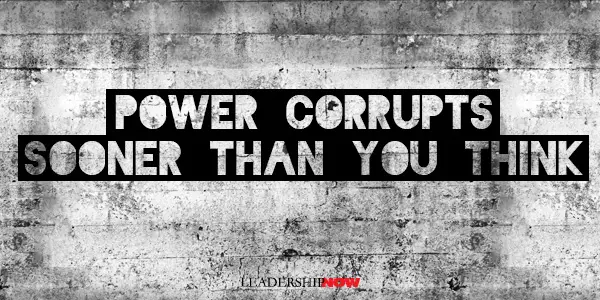
IN A LETTER to Bishop Mandell Creighton in 1887, Lord Acton observed that “Power tends to corrupt, and absolute power corrupts absolutely. Great men are almost always bad men.” British Prime Minister William Pitt also observed, “Unlimited power is apt to corrupt the minds of those who possess it.” Power is a tricky thing and we rely on it more than we should. In a study by Adam Galinsky and others, they found that when people where power primed—temporarily made to feel powerful—they demonstrated a reduced tendency to comprehend how others see, think, and feel as compared with those that were primed with low power. They relied too heavily on their own vantage points and demonstrated less accuracy when assessing the emotions and thoughts of others. The possession of power or even the feeling of power tends to very quickly change how we think. We easily slip into thinking we are something we are not, to become absorbed with ourselves, to think, “It’s all about me.” Our ego can quickly blind us to reality—self-deception sets in very quickly. We lose self-awareness and therefore our sense of the impact we are having on others. We would do well to remember the Stripes Rule. Denny Strigl, former CEO and president of Verizon Wireless, recalls in Managers, Can You Hear Me Now?: When I became president of Ameritech’s cellular subsidiary, Ameritech Mobile, the chairman of Ameritech told me something that has stayed with me ever since. He said I would be managing an entire company, and as the company’s most senior manager, I should always remember that the “stripes” I have been given are on the coat I wear, not on the person who wears the coat. He cautioned me not to let the job go to my head because when I take the coat off, I will just be a person like any other. Power, it seems, can easily become a handicap and not a blessing to leading well. But it often comes with the territory. A wise leader might keep Lord Acton’s words front and center.
Posted by Michael McKinney at 09:25 AM
12.21.11

Doing More With Less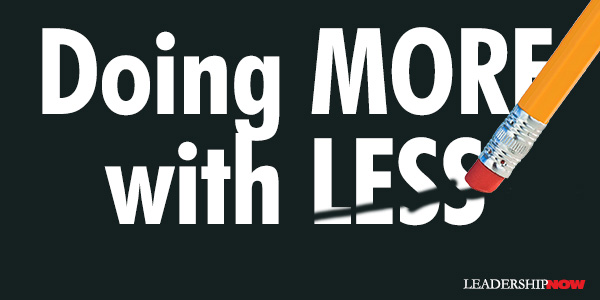 MOST companies are asking employees to do more with less. These demands may produce positive results in the short term, but they are not sustainable in the long term. “Organizations can do more with less simply by not leaving so much untapped performance on the table.” The frustration people often face in these conditions is not an engagement problem; it is more often an enablement problem.
MOST companies are asking employees to do more with less. These demands may produce positive results in the short term, but they are not sustainable in the long term. “Organizations can do more with less simply by not leaving so much untapped performance on the table.” The frustration people often face in these conditions is not an engagement problem; it is more often an enablement problem.
Mark Royal and Tom Agnew of the Hay Group, explain that The Enemy of Engagement is frustration caused by a highly engaged employee’s inability to succeed in a role due to organizational barriers or the inability to bring the bulk of his or her talents, skills, and abilities to the job. Ironically, the more engaged they are, the more frustrated they get because they care more. Doing more with less doesn’t mean conjuring higher levels of motivation out of thin air, but rather allowing motivated employees to perform at their best. It’s about harnessing and unleashing the full potential of frustrated employees—those who want to give their best but can’t due to organizational barriers and constraints. Typically we associate better engagement with leadership, but what drives it is better management. Fixing engagement means dealing with the frustration of thwarted employees. Specific management practices detailed by the authors include:
One of the most actionable things to do is to simply ask: “How can we change things around here to help you be more effective?” By doing so “a manager creates an opportunity for an employee to speak honestly and openly about enablement issues.”

Posted by Michael McKinney at 04:34 PM
12.20.11

5 Leadership Lessons: What if You Could Take Control of Your Life with One Decision?
 Many people are like garbage trucks. They run around full of garbage, full of frustration, full of anger, and full of disappointment. As their garbage piles up, they look for a place to dump it. And if you let them, they’ll dump it on you. So when someone wants to dump on you, don’t take it personally. Just smile, wave, wish them well, and move on. Believe me, you’ll be happier. Here are five lessons from David Pollay, to help us to focus on what really matters personally and professionally:

Posted by Michael McKinney at 10:43 PM
10.14.11

5 Leadership Lessons: EntreLeadership Dave Ramsey defines EntreLeadership as “the process of leading to cause a venture to grow and prosper.” Entreleaders know how to blend their entrepreneurial passion with servant-like leadership that motivates employees through persuasion instead of intimidation. EntreLeadership is a book about how business works from a practitioner. His advice, on nearly every facet of running a business, is based on solid principles. Here are just a few of his thoughts on leadership: 
Posted by Michael McKinney at 05:25 PM
09.28.11

The 3 Core Elements of Delegation
Without delegation no organization can function effectively. Yet, lack of courage to delegate properly, and the knowledge of how to do it, is one of the most general causes of failure in organizations.Every time you delegate work to a teammate, three inescapable core elements of delegation are in play. Authority, responsibility, and accountability form an integrated process and must be applied by you as a unified whole. Authority Can Be Delegated As a leader, you can transfer pieces of your formal authority to another teammate when assigning a task to that person. In essence, you can deputize your teammate to take action on your behalf within the boundaries of the delegated (transferred) authority. Authority chiefly comes from the power of position. The more authority you have, the greater your ability to delegate higher-level, more meaningful and challenging tasks to others to help them learn, develop, and grow. Responsibility Cannot Be Delegated, but It Can Be Assigned As a leader, you can assign responsibility to another teammate in terms of the results that need to be achieved. However, you need to keep in mind that you only assigned responsibility to your teammate. If your teammate “fouls up the thing royally,” your manager will censure you, not your teammate. In short, you can never fully hand off any of your responsibilities to someone else. Assigned responsibility should be made in terms of the goals or results to be accomplished, not the detailed specifics for doing the job. Accountability Means Obligation Accountability is the moral compulsion felt by a teammate to meet the goals and objectives of an assigned task. As a result of accepting a task assignment, your teammate in effect gives you a promise—either expressed or implied—to do her best in carrying out the activities associated with it. Having taken on the task, your teammate is obligated to complete it, and thus is held accountable by you for the results produced. Adapted from Building Team Power: How to Unleash the Collaborative Genius of Teams for Increased Engagement, Productivity, and Results by Thomas A. Kayser
Posted by Michael McKinney at 12:09 PM
09.26.11

Leading: Sharing Accountability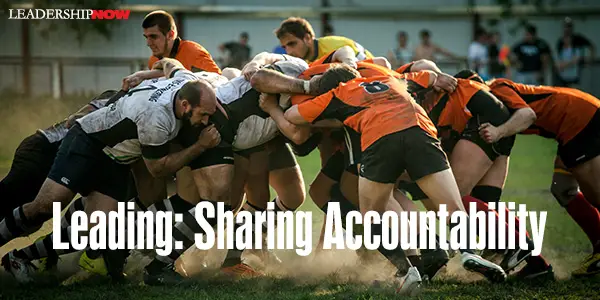
UNCERTAINTY necessitates the need for finding more wisdom within our organizations. This can only be accomplished by creating a leadership mindset throughout the entire organization. It is shared accountability. Any leader that thinks that they can do it alone is indulging their own ego. James Champy and Nitin Nohria cautioned us not to assume that no one else on the premises can match our own ambition, competence, and vision. We have to accept the fact that there are many points of wisdom within our organizations and a wise leader will engage them. Too many leaders are not accustomed to accepting input from junior members no matter how valuable it is. This creates a lack of trust and openness. The currency of leadership is relationships and a wise leader would do well to encourage input from as many sources as possible and especially not from the usual suspects. Phil Nolan, former CEO of Eir Limited, described it this way in A Time for Leadership: The concept of distributed leadership will keep you in touch with the environment. If you want to prepare people for this environment, you have to get leadership further down the organization. We generally tend to drive managing down the organization, but not leadership. Leadership needs to be the expected norm at all levels.
Posted by Michael McKinney at 12:08 PM
09.22.11

5 Leadership Lessons: Good Strategy, Bad Strategy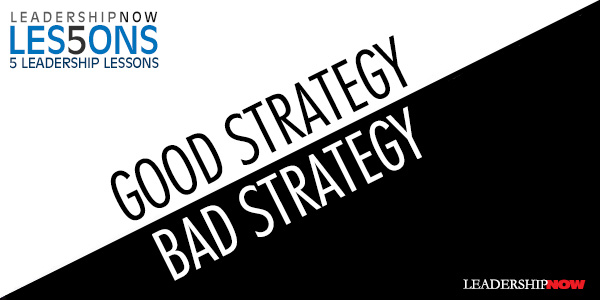
RICHARD RUMELT has written an insightful book on developing the ability to identify and develop good strategy. Good Strategy, Bad Strategy is obviously the result of decades of practice developing strategy and the many case studies and classroom interactions made it personal and very readable. We’ve all been there. The big conference room as the lights dim and the PowerPoint slides begin. We sit attentively as the leader steps to the podium to tell us something like: “Going forward we will attain global leadership in our markets, increase revenues and profits ten percent, rationalize our supply chain and eat the competition’s lunch by taking huge chunks of market share—all based on one of the world’s most highly talented workforces for whom success is never quitting until you win.” When it comes to strategy, we have gotten off-track into thinking that fluffy platitudes, goals, motivational slogans, and wishful thinking are the same thing as strategy. As a result, we don’t get the intended results. “Bad strategy,” says Rumelt, occurs when there is bad doctrine, when hard choices are avoided, and/or when leaders are unwilling or unable to define and explain the nature of the challenge. Here are some key ideas from this classic on strategy:

Posted by Michael McKinney at 06:49 PM
09.21.11

The Four Hallmarks of Bad Strategy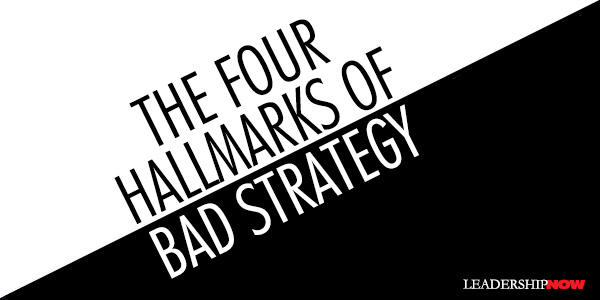
STRATEGY expert and author of Good Strategy, Bad Strategy, Richard Rumelt says that bad strategy “grows out of specific misconceptions and leadership dysfunctions.” In short, it is goals and not action. “It assumes that goals are all you need. It puts forward strategic objectives that are incoherent and, sometimes, totally impracticable. It uses high-sounding words and phrases to hide these failings.” To detect a bad strategy, Rumelt suggests looking for one or more of its major hallmarks: Fluff. Fluff is a form of gibberish masquerading as strategic concepts or arguments. It uses “Sunday” words (words that are inflated and unnecessarily abstruse) and apparently esoteric concepts to create the illusion of high-level thinking. Make it simple. Failure to face the challenge. Bad strategy fails to recognize or define the challenge. When you cannot define the challenge, you cannot evaluate a strategy or improve it. If you fail to identify and analyze the obstacles, you don’t have a strategy. Instead, you have either a stretch goal, a budget, or a list of things you wish would happen. Mistaking goals for strategy. Many bad strategies are just statements of desire rather than plans for overcoming obstacles. Bad strategy is long on goals and short on policy or action. Strategic objectives should address a specific process or accomplishment, such as halving the time it takes to respond to a customer or getting work from several Fortune 500 corporations. An excerpt from Rumelt’s response to a client that had a “strategy” that was long on goals and short on actions, is instructive: If you continue down the road you are on you will be counting on motivation to move the company forward. I cannot honestly recommend that as a way forward because competition is not just a battle of wills; it is also a competition over insights and competencies. My judgment is that motivation, by itself, will not give this company enough of an edge to achieve your goals. He explained that “when a company makes the kind of jump in performance your plan envisions, there is usually a key strength you are building on or a change in the industry that opens up new opportunities.” Bad strategic objectives. A strategic objective is set by a leader as a means to an end. Strategic objectives are “bad” when they fail to address critical issues or when they are impracticable. The purpose of good strategy is to offer a potentially achievable way of surmounting a key challenge. If the leader’s strategic objectives are just as difficult to accomplish as the original challenge, there has been little value added by the strategy. 
Posted by Michael McKinney at 01:52 PM
09.19.11

Hypocrisy Isn’t Going to Get You There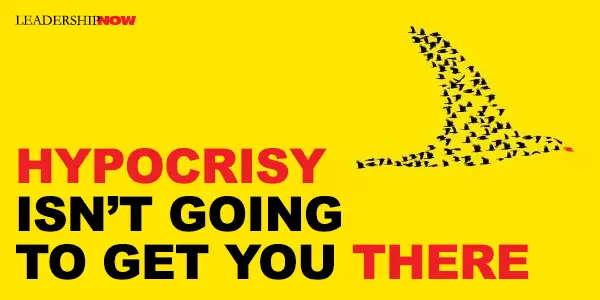
IF you’ve ever asked yourself, “What’s the matter with them? Why don’t they get it?” or said, “I feel like I am alone here,” maybe they are listening more to your actions than your words. Culture explains how things really work. Culture reflects practical values—values that will get you through the day regardless of what you say you believe. When it comes to preaching values, too many leaders are just talking heads. Preach change, demonstrate status quo. Changing culture in an organization is often difficult because leaders make it so. A culture that does not resemble your stated values reflects a lack of ownership and accountability to those values. A value that is meant for “them” but not lived-out in the behavior of and choices made by the leadership, will never become part of the organizational culture. Culture is formed by the choices we make, not the lecture we give. In Too Many Bosses, Too Few Leaders, Rajeev Peshawaria suggests three steps to cultural change: • Define the desired culture. Articulate a set of behavior guidelines for everyone to follow.
In this discussion he makes three statements that are worth reflecting on: Leaders should use every opportunity to exhibit guidelines or values in their own behavior. Are you modeling the behavior you want to see in others? Senior leaders of the company routinely showed up at these training sessions to show employees how important the values and brand were. Are you excusing yourself from what you expect others to be doing? In sharp contrast, another client told me to design the session in such a way that it did not rely too heavily on the executive team’s presence. He argued that the senior team was already under a lot of pressure, and that this would be a huge time commitment for them. I could not believe my ears. After all, as leaders, what do you spend time on if not aligning your organization’s culture with your vision and strategy? Do you live by a different set of rules? Sometimes this is difficult to see in yourself, so asking a trusted friend if there is a disconnect between your words and your behavior is helpful. As a leader, it is too easy to think of yourself as the exception. “I’m busy.” “They don’t have to deal with what I am dealing with.” “This is for them, I don’t need it. When a leader’s behavior conforms to their talk, there is a connective quality formed that is worthy of trust and attention. If we live our values we can create radical change.

Posted by Michael McKinney at 07:07 AM
09.13.11

Ownership Thinking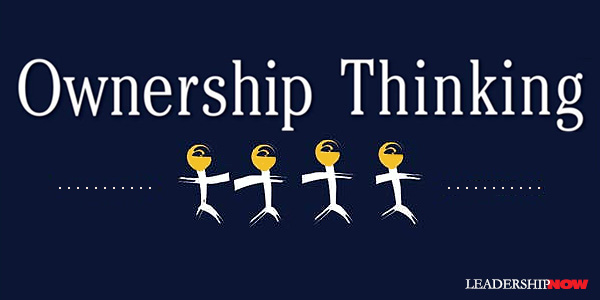
Ownership Thinking is about developing leaders at all levels. “Fundamentally,” writes author Brad Hams, “Ownership Thinking is about moving employees away from the ‘me’ way of thinking and towards concerns of the business and its financial performance.” This is leadership thinking in a business setting. When people understand the business, their role in it, and are informed of what is going on and take responsibility for the outcomes, then they become better stewards of the company’s resources and help to create wealth. Hams has found that the vast majority of people “want to engage and contribute, and feel much better about themselves when they have the opportunity to do so … and they have the capacity to do so.” We often frustrate that effort and create cultures of entitlement because, in the words of Judith Bardwick author of Danger in the Comfort Zone, “managers are unwilling to do the work of requiring work.” Hams says his mission in life is to eradicate habits of entitlement in organizations. People who actually produce things do so primarily for two reasons: (1) They have a strong work ethic. In other words, they have to believe that rewards come only with hard work, and (2) They enjoy producing. It is exciting for them, and the reward for producing is not only the things they are able to afford as a result of it, but the personal growth and sense of worth that come from producing: that is, true self-esteem. A workforce that is helping to create wealth should be able to participate in the wealth they are creating. However, incentive plans should be self-funding, and “it is the obligation of ownership and leadership to teach them how to do that and to provide them with the tools and training necessary to accomplish the task.” Simply put, your employees need to know what’s going on. In a chapter entitled, Your Employees Think You Make Wheelbarrows of Money, Hams relates that when he asks the question: “Your company had 12 million in sales last year, what do you think the profit was?” it is not uncommon to hear 50% from employees of companies where financial information is not shared or business acumen taught. “In the absence of information, people make stuff up.” Generally speaking, the people with the greatest understanding and expertise in any given area are the people who are actually doing the work, and these people are not necessarily management. For an organization to achieve excellence, it must engage all of its organization members. Ownership Thinking is a how-to book. Hams explains how to create incentive plans that work (plans that clearly align employees’ behavior to the organization’s business and financial objectives), how to teach financial skills (how the company makes money and how they add - or take away – value), creating the right performance indicators, rapid improvement plans and how to implement Ownership Thinking for the long-term. “Practicing Ownership Thinking will allow you, as an owner or leader, to rest easier knowing that your employees are making decisions and taking actions that are aligned with what you would do yourself.” 
Posted by Michael McKinney at 10:40 AM
09.09.11

Managing the UnmanageableIf we truly want to deal with a difficult or unmanageable person, we have to get at the thinking behind the behavior. Why do they do that? Why are they that way?Instead of going deeper, it’s easier to just label them and avoid the issue. He’s rude. She’s unreliable. He’s an egomaniac. She’s self-absorbed. Anne Loehr and Jezra Kaye, authors of Managing the Unmanageable, say that these “unmanageable” people are costing companies a fortune. Loehr estimates that her clients lose, on average, 30% of their productivity because of issues related to unmanageable employees. The fact is, “there’s a world of difference between someone who’s acting unmanageable, and someone who can’t [won’t] act any other way. There’s a world of difference between someone who’s become unmanageable in response to a particular set of circumstances (that can, at least theoretically, be changed) and someone who’s just like that.” Perceiving the difference is the task of leaders, managers, and coaches. Most of the time we deal with people at the symptom level. Managing the Unmanageable is written to help you do just that. They begin with an appropriate caution: If you find yourself being convinced that someone could never have the slightest redeeming good quality, find a way to deal with your own feelings before you try to manage theirs. Good advice. There are some early warning signs that it is time to look deeper than the behaviors you see: Diminished Motivation: “Frustration with a job can grow out of unmet or unrealistic expectations, company-wide uncertainty or relationship problems on a team or with a manager.” You’ll hear comments like: “I’m just not into it anymore.”Unclear Expectations: Misunderstandings are common. We don’t always communicate as clearly as we think. Too much often goes unsaid. Sadly, too, “managers and executives sometimes purposely lead employees astray, confuse them, or keep them in the dark to avoid unpleasant issues or consolidate power in their own hands.” It sounds like this: “I have no idea what she wants.”Lack of Confidence or Self-Esteem: “It’s natural to wonder if you have what it takes when the stakes go up or your job becomes more complex. But if that lack of self-confidence persists, an employee can become resistant, defensive, and ultimately unmanageable. They will say things such as: “I don’t know why they thought I could do this.”Personal Issues: “When your employee is distracted, self-absorbed, or unable to focus, her problem may stem from conditions outside of work. It might be expressed as: “I haven’t slept through the night in weeks.”“A radical shift in behavior,” say Loehr and Kaye, “may be your first indication that a good employee is morphing into an unmanageable employee.” In short, other people have many of the same problems we have, it’s just that they haven’t learned how to deal with it or are not in a position to do anything about it in the same way that we would as leaders. The book specifically deals with the excuse-maker, the grumbler, the egomaniac, the loose cannon, the joker, the do-gooder, the wallflower, the gossip, the slacker, the rude-nik, and the AWOL. Each “salvage” operation follows the 5-C Model: Commit or Quit, Communicate, Clarify Goals and Roles, Coach, and Create Accountability. The focus of each chapter is to get behind the behavior of each type and understand it. You will find helpful composite cases, practical tips and dialogues for dealing with each type.
Posted by Michael McKinney at 08:41 AM
08.08.11

Common Purpose Leadership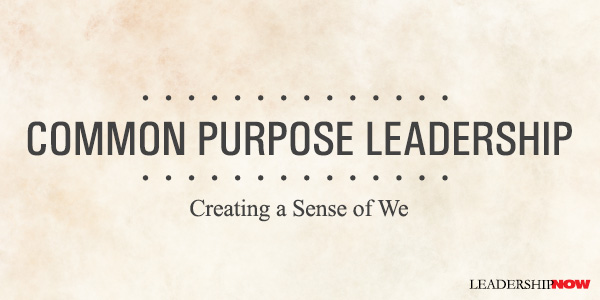
IN Common Purpose, consultant Joel Kurtzman makes the case that excellent leaders build a sense of inclusiveness—a sense of we—within the organization by creating a common purpose. A place where people know what to do and why and understand what the organization stands for. Based on interviews and first-hand experience, Common Purpose lays out how to achieve and then sustain a culture based on a common purpose. For example:
The easiest way to create a sense of we, says Kurtzman, is unfortunately to create the specter of them. Because it is easy, it is probably the reason you see this dynamic played out in so many organizations of all kinds. While it is a shortcut to common purpose, “it can also be a stepping stone to chaos, doom, and organized opposition.” I would add that within the organization or group, it also leads to arrogance, stagnation and closed minds. In most cases, it leads to decline. Organizations are created to achieve goals that “are beyond the capability of an individual to accomplish alone.” They are a method of “aligning groups of people so they achieve common goals.” This is best accomplished when you encourage people to be leaders at any level within the organization. Simon Cooper, president and CEO of Ritz-Carlton, says the best reason to rid an organization of mindless hierarchy is to provide scriptless service: employees deciding on their own how to make guests happy. “They make decisions on their own, on the spot, using their own judgment, and with the sense of confidence that comes from owning their jobs. That’s real leadership.” Taking risks on behalf of the organization. This requires trust at all levels and a different view of real leadership, says Kurtzman. It is difficult to overstress how important it is for teams of people working together to meet informally from time to time…The point is that you cannot lead a team if you do not know the people you are leading, and the best way to do that is informally. “The leader is not separate from the group he or she leads. Rather, the leader is the organization’s glue—the force that binds it together, sets its direction, and makes certain that the group functions as one.” Kurtzman notes, “Leadership is not coaching. Coaching focuses on helping people arrive at their own goals. Whereas leadership, especially common purpose leadership, is about helping people arrive at a collective set of goals. It is about coordinating people’s efforts, aims, ambitions, and capabilities.” Leaders can’t think of themselves as better than their workers or more favored because they have a higher rank. Becoming CEO is not a coronation; it’s a promotion. And CEOs can’t do everything. The purpose of an organization is to combine the efforts of many people to produce results no one on his or her own could achieve alone. Leaders must understand that. They must live the goals they espouse. They must understand that everyone inside the organization is looking at them — scrutinizing them, really — and also that every action of theirs is being watched and talked about. At FM Global, Shivan Subramaniam, the chairman and CEO, decided against buying a corporate jet despite the prodding of his board. Instead, he decided to abide by the same corporate travel rules that every other executive in the company abides by. He even flies on the redeye if he must. By doing this, he sends a powerful signal throughout the company that while he may be the CEO, he’s also an employee, just like everyone else. People value that. People will do almost anything for a leader like that. Of course, one size does not fit all. “People are individuals, and those who thrive in one firm might not thrive in another. Chemistry, fit, values, and many other qualities are in the eye of the beholder.” Kurtzman believes that “organizations will come to resemble constellations of capabilities linked together technologically from centers located around the world….Big companies will comprise smaller pieces, each with unique characteristics, ownership structures, and relationships. Each of these elements, when combined, will create enormous value?” The question is what will keep it all together. Incentives alone won’t do it. “The power of a common purpose will become the factor that differentiates winning organizations from those left behind.” This means that leaders will have to be “kinder, more caring, and more empathic than leaders of the past.” We have seen this increased focus on respect as many of you write, talk, and practice this on a daily basis. Common purpose leadership, at its most basic level, is about recognizing people as individuals. Common purpose leadership begins with respect for individuals and their differences, and goes on to celebrate their strengths. 
Posted by Michael McKinney at 10:59 AM
07.26.11

Have a Nice Conflict!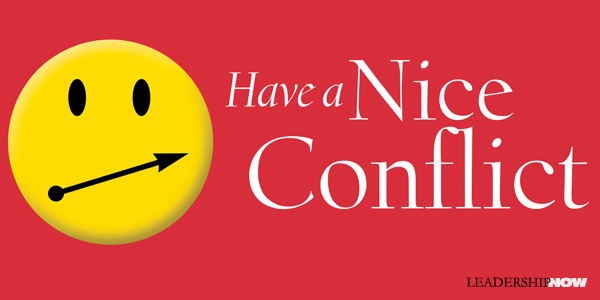
READING Have a Nice Conflict was like listening to my Dad again. He first met “Doc” Porter in the early seventies and they clicked almost immediately. Elias Porter’s Relationship Awareness Theory, on which the book is based, resonated with my Dad. Behaviors are the tools we choose and use to support our self-worth.Have a Nice Conflict is the story of sales manager John Doyle who has been passed over for what he believes is a well-deserved promotion. He has lost some of his top performers because he rubbed them the wrong way. When he turns up at an old friend and client’s office to explain yet another change in sales reps, he puts him on to Dr. Mac to help him improve his people skills at both work and home. Dr. Mac explains to John that there are many ways of interacting with others. We have default ways of behaving and when in conflict we often shift into other behaviors to maintain our self-worth. While we are trying to do the “right thing” to maintain our self-worth, conflict can happen when our “right thing” appears to be the “wrong thing” to another person. Conflict can be prevented by seeing contentious behavior as merely a different style instead of a direct challenge or threat aimed at annoying you or derailing you. He introduces him to the Strengths Deployment Inventory (SDI) which is a tool to help you understand the motivations behind your own behaviors and to better discern the motivations of others. By giving you a framework it helps you to understand what you and others are feeling and then helps you be better able to respond. Having a nice conflict is about taking personal responsibility for the interaction. To create movement toward resolution, we need to show the other person the path back to self-worth—where they feel good about themselves. That path may be different than yours. The concept should be taught in schools, however, the thought process is essential for leaders. The book alone offers valuable insights into the process and methodology, but coupled with the SDI you’ll have greater success. The authors offer a discount on the SDI to readers of the book. 
Posted by Michael McKinney at 05:08 PM
06.27.11

The Big Vision is Important but People Live in the DetailsMost leaders don’t want to be called a tyrant, a control freak, or even a micromanager. To avoid that, it’s easy to jump into the other ditch and be laissez-faire. Leaders have a duty to navigate between these two extremes as the situation dictates.Typically, we like to present the vision—the values—and leave the details to be sorted out. We like to give the big overarching principle without explaining exactly how it plays out in everyday life. The problem is that everything happens in the details. That’s where people live. That’s where decisions are made, community is built, and your vision and values are realized—or not. We like to articulate the “promised land” and expect that everyone will catch on. That might work for the most highly visible leaders—those interacting with employees day-in and day-out—because they see you translating those values and goals on a day-to-day basis. But seriously, how many of us are that visible? We’re far too busy!?! We don’t want to be caught telling people what to do, but we want everyone on the same page. Life doesn’t work like that. People see the same thing and hear the same thing differently. They interpret it differently and thus it plays out in their behavior differently. And that is where the friction starts. That’s where the community breaks down. That’s where the judgment begins. Organizations, groups and families need more guidance than that. I’m not suggesting that we become control freaks, create even more rules, or become condescending or judgmental, but we need to clarify the vision and values in the details where people live. What do our values look like in everyday life? We need to use examples as they come up to relate everyday behavior to our values. Show where they match-up and where they don’t in a way that leaves room for them to develop good judgment and practical wisdom. From the beginning—and along the way as needed—we need to spell out, “This is the kind of company we want to be, this is the kind of people we want to be, so that means we don’t do this but we do do that.” Specifically. And we then communicate this over and over again in our rhetoric and actions. People need to know and understand your values if their behavior is to be guided by them. If there is a disconnect between your values and everyone’s clear understanding of them, confusion and misbehavior will define your leadership.
Posted by Michael McKinney at 08:17 AM
06.22.11

Leading Views: Keep Dissenters Close to Provide Perspective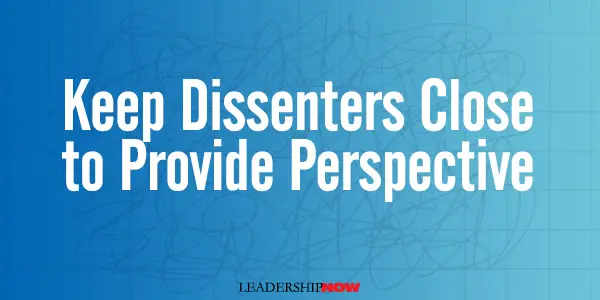

Posted by Michael McKinney at 10:58 PM
06.16.11

To Focus on the Work, You Must Focus on People Doing the Work
Many managers think they manage the work. They don’t. They’re responsible for the work, but they get work done by influencing the people who do the work. What makes this complicated is what Peter Drucker pointed out: when you hire a hand, it comes with a head and heart attached. So you must pay attention, lots of attention, to the whole person—head and heart—because you need more than your people’s time and attention. Most work now requires knowledge, judgment, thinking, and decision making, and so it matters if people care about what they do. You cannot simply give them orders and criticism. That rarely produces the kind of engagement you need. Other, less direct but more effective forms of influence—such as support, development, and encouragement—are needed that engage the whole person. Do you tend to focus on the work or on the people doing the work? In other words, do you tend to confront and criticize, or do you support people and give them what they need to do good work? Adapted from Being the Boss: The 3 Imperatives for Becoming a Great Leader by Linda A. Hill and Kent L. Lineback. 
Posted by Michael McKinney at 05:45 PM
06.07.11

Transforming an Ordinary Moment into a TouchPoint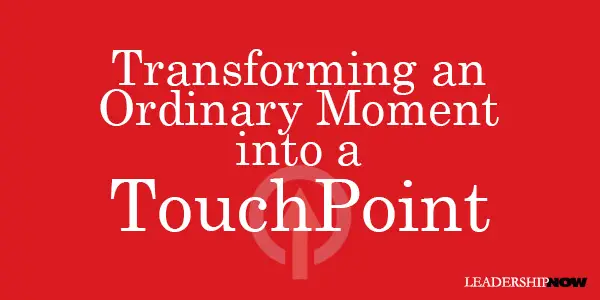
WE ALL have those moments when we are too busy for the people around us. But those moments are the work of leaders. Those are the moments when we can help to move things from what they are to what they could be. Campbell CEO Doug Conant said, “To me, they’re not interruptions. They’re opportunities to touch someone and improve the situation.” TouchPoints, by Doug Conant and Mette Norgaard, describes a new way of thinking about the work of leadership. TouchPoints are those moments in the day when you have the opportunity to touch the lives of other people. Each has the potential to become a high point or a low point in someone’s day. “Each is an opportunity to establish high performance expectations, to infuse the agenda with greater clarity and more energy, and to influence the course of events.”Every TouchPoint is spring-loaded with possibilities. Each one can build—or break—a relationship. Even a brief interaction can change the way people think about themselves, their leaders, and their future. TouchPoints exposes the extreme responsibility that leadership is. A responsibility that in our overloaded age, we often overlook. To make the most of your TouchPoints, they have created the TouchPoint Triad: listen, frame, advance. In any moment you begin by asking, “How can I help?” Then you listen intently. This prepares you and helps you find out what is really going on. Be curious and keep listening for the real issue. Next, you frame the issue to be sure that everyone in the TouchPoint is on the same page. Third, you advance the agenda. People come to you because they want results. Once you know what is needed, do what you can in that moment to advance the agenda; decide on what the next step is, and who is responsible to do it. After the TouchPoint is over, make a point to check-in and see how well the action plan is going by asking something like, “How did it go?” or “Is there anything else you need from me?” It’s a reminder that you care and lets you know if you were genuinely helpful.
A TouchPoint is about really connecting with others and improving results. It’s about engaging in a way that is alert, abundant, authentic, and adaptable: You need to be alert to the real issues. “When you are fully present, you can see the gaps in someone’s line of logic and pick up bits of information that provide clues to what is going on.” You need to be abundant in your thinking; rejecting the either/or scarcity mindset. To be authentic is to embrace the work of the leader and “live by a very clear code that provides an underlying clarity and consistency in every TouchPoint.” “The secret to being adaptable is to develop a broad range of skills, so that you can adjust and adapt in the moment.” Throughout TouchPoints, you will find many nuggets of relationship wisdom to help you, as they put it, “work with, not against, the nature of things.” The authors insist that you clarify your own leadership model so that you can apply it consistently. To that end, they suggest that you answer two vital questions: What makes people give the very best of themselves? What makes for ever-stronger performance in an ever-changing world? Your answers will help you to define how you see yourself, other people, and the world around you. 
Posted by Michael McKinney at 11:06 PM
06.03.11

4 Lessons from the Toyota Crisis
“Crisis response must start by building a strong culture long before the crisis hits,” say Jeffrey Liker and Tim Ogden, authors of Toyota Under Fire. Turning crisis into opportunity is all about culture. It’s not about PR strategies, or charismatic leadership, or vision, or any specific action by any individual. It’s not about policies or procedures or risk mitigation processes. It’s about the actions that have been programmed into the individuals and teams that make up a company before the crisis starts. The accident in August 2009 that took the lives of four people in a runaway Lexus brought national attention to Toyota. Fueled by innuendo and speculation by Congress and some media, it escalated into something it was not. Toyota Under Fire deals with not only the massive recall of 2009-2010, but also Toyota’s response to the oil crisis and recession. Toyota’s response has not been typical, but it does follow the Toyota Way. It is a reflection of their culture. That way includes what is probably Toyota’s “greatest contribution to the world as a model of real continuous improvement” at and by all levels in the organization. Liker and Ogden describe the Toyota Way as: Face challenges with a clear head and positive energy. Hold fast to your core values and your vision for the company. Always start with the customer. Understand the problems that you face by analyzing the facts, including your own failings, and understanding the root causes. Thoroughly consider alternative solutions, then pick a path, develop a detailed plan, and execute with discipline and energy. “You do not turn a culture off and on again like a light switch.” Culture—like character—is built over decades of living your values in the real world. And then in a crisis, when you really need it, it is there to carry you through. The authors isolated four lessons for dealing with a crisis: Lesson 1: Your Crisis Response Started Yesterday. What a company does isn’t likely to change much when a crisis strikes or for any length of time. “They are driven by culture, and culture simply can’t be changed quickly, even in a crisis…. Therefore, the chief questions to ask yourself about how your company will respond in a crisis are not contingency plans and policies, but about your culture and your people. Have you created a culture that rewards transparency and accepts responsibility for mistakes? Have you created a culture that encourages people to take on challenges and strive for improvement? Have you created a culture that values people and invests in their capabilities? Have you created a culture that prioritizes the long term?”Lesson 2: A Culture of Responsibility Will Always Beat a Culture of Finger-Pointing. Common sense? Yes, but the question is how far do you go in accepting responsibility? What if the factors were beyond your control? The answer illuminates an important nuance in understanding Toyota’s culture of responsibility and problem-solving. “There is no value to the Five Whys [the belief that you have to ask why at least five times] if you stop when you find a problem that is outside of your control. There will always be factors outside of your control. When you reach a cause that is outside of your control, the next why is to ask why you didn’t take into account forces outside of your control—either by finding an alternative approach or by building in flexibility to adjust to those forces.” Lesson 3: Even the Best Culture Develops Weaknesses. The greatest threat to a culture of continuous improvement is success. “To survive the weaknesses that inevitably develop, a corporate culture has to have clear and objective standards, codified in such a way that self-correction is possible. Having a culture that recognizes a loss of direction is absolutely critical to long-term survival.” Lesson 4: Globalizing Culture Means a Constant Balancing Act. The clarity of Toyota’s culture and values is essential to growing the culture in every employee. And there is a balance to strike—the balance between centralized and decentralized, local and global—that is not easy. “There is an inherent demand here that especially the people who are at the margins, at the periphery of the organization, be deeply steeped in the culture, and that they are to be trusted to make decisions because they are at the gemba.” One of the root causes of the crisis they identified was centralized decision making. They will now pursue a regionalization strategy which will require trusting the leaders they have trained to maintain the culture. Toyota Under Fire is an in-depth look at the value of having a strong culture that can serve you when things go south. The discussions explaining the reasoning behind why Toyota does what it does were very helpful. They demonstrate that the most important decisions are the ones made before the crisis. And then when the crisis hits, return to basics. Go deeper and wider. 
Posted by Michael McKinney at 05:21 PM
05.24.11

Got Drama?
YOU can’t stop The Drama. There will always be drama. But that’s not the problem says Marlene Chism, author of Stop Workplace Drama. “The amount of time you stay in the drama—and the effort you put toward it—is the problem. Complaints, excuses, and regrets only serve to keep the drama alive.” Your drama—what you add to The Drama—is the problem.Chism defines drama as “any obstacle to your peace and prosperity.” Drama is the result of not recognizing or taking care of the little signs of bigger problems when they first presented themselves. At the core of drama, you will find one of three common elements (if not all three): a lack of clarity, a relationship issue, and/or resistance. So, says Chism, when you experience drama you need to ask yourself three questions: 1. Where am I unclear?
Chism presents eight principles for dealing with drama, but “lack of clarity” struck me as the most common and excuse-laden trap there is. Too often this is where we get stuck.
“Any type of discord, abuse, confusion, or game-playing always boils down to a lack of clarity.” A loss of focus. Sometimes we create drama because we want something on our terms. We imagine that we can’t do something because we can’t do it the way we think it should be done—our way. Chism relates a clarifying example of this with the recently divorced Joe who is having visitation issues with his ex-wife Patty. She’s not letting him do what he wants in the way that he wants. Many people get stuck in the drama of what should or shouldn’t be. Yes, you can fight that battle, if winning a battle is what you want. But again, in order to clear the fog and help Joe get clarity, I asked, “If there are two islands you can go to, and one means winning a battle with your wife and the other island is getting to see your kids and be a father to them—then which island would you choose?” This kind of dynamic plays out every day in our business and personal lives. When we are not clear about what we want, what our values are, what we are committed to, it is easy to lose our focus, to drift off course Solution: Clear the fog. Chism has written a good-natured and practical book that will change your thinking and in the process help you to control the drama in both your personal and professional life. As leaders, we have the responsibility to be very clear with ourselves and our team so that we don’t get pulled into negativity, gossip, power plays, resistance and … drama. Chism suggests asking the following questions: What are my top 10 principle-based values?

Posted by Michael McKinney at 10:00 PM
05.19.11

Landing in the Executive ChairSuccess in any organization requires good decision-making, results orientation, leadership talent and people skills says, Linda Henman in Landing in the Executive Chair. But as you climb the hierarchy in an organization, “the manifestation of those traits and behaviors becomes more complicated.”No matter where you are in the organization, it’s about people. People will make you successful. However, you will find that as you go up the ladder, the need for understanding yourself and others becomes more acute and more difficult. Primarily this is because your relationship with those around you changes—both in your mind and theirs. It’s not surprising that Henman writes, “I have found direct ties between self-awareness, self-regulation, motivation, empathy, social skill—and business results.” As Bill George says, “It's EQ, not IQ, that matters most for leaders.” As a result, Henman has developed a model she calls F² Leadership: Fair but Firm. F² Leaders have a “balanced concern for task accomplishment and people issues.” It’s about balancing dominance (results) and responsiveness (relationships). F² Leaders should keep in mind:
Fairness is in the eye of the beholder, but “you can take steps to stack the deck in your favor.” Henman describes behaviors that indicate that you are firm but fair, and trustworthy. She covers such areas as decision-making and problem-solving, attracting top talent, strategy, execution, leadership development, and building a culture of change. These are valuable insights for both new leaders and experienced leaders alike. 
Posted by Michael McKinney at 09:56 AM
05.05.11

Bill Roedy: From West Point to MTV
BILL ROEDY, former Chairman and CEO of MTV Networks International, began working for HBO in 1979 when it was broadcasting only nine hours a day. There he learned that distribution was everything. It was to be his mantra at MTV—aggressive, creative, relentless distribution. Roedy shares his experiences and lessons in What Makes Business Rock. From virtually nothing, he built MTV International into the largest media network in the world. For anyone involved doing business internationally, it is essential reading. As manager of HBO’s national accounts, he learned that “In life as well as in business, the ability to sell is the foundation upon which success is built.” Some people don’t understand that he says, but even in Vietnam, although he had the formal authority to force troops to obey my orders, I found that if people didn’t believe in the mission, I never got a total effort from them.” Leaders are always selling. Although reluctant to leave HBO and move to London, in 1989 he became managing director of MTV Europe. What he inherited wasn’t working. He had to quickly create a better product, get more distribution and generate revenue. Getting the right people in place was crucial to creating an entrepreneurial organization. “Never take ‘No’ for an answer.” “Take chances.” “Break all the rules.” Their objective was to be the most visually engaging channel in the history of European television. To make sure viewers always knew they were watching MTV, they put their logo in the corner of the screen and left it there. No one had done that before. (Now everyone does.) Here is a lesson every leader could bear to keep in mind: as a leader, your opinion matters—maybe more than you know. But it can actually be having a negative impact. The MTV playlist is extremely important to its viewers and giving them what they want to hear is essential to MTV’s survival. Roedy says that in the beginning, he attended those meetings if only to be the voice of reason and a subtle reminder that they were running a business. “But after attending half a dozen of these meetings I realized I was making a huge mistake. I was much older than our demographic and my musical tastes were very different. I was skewing the choices older.” So he stopped attending those meetings. “As much as I enjoyed being part of that process, I had to remind myself that I was a manager, and I had to delegate decision-making authority to those people I trusted.” How many leaders, for all kinds of well-intentioned reasons feel they have to leave their fingerprint on everything, while they are in-fact stifling their people and skewing the results? Roedy’s success at MTV can be attributed to the fact that he was always reinventing. “The longer you stay with the same strategy, the more vulnerable you become to your competitors.” His most important contribution was the idea, “Think global, act local.” MTV was already local to Europe, but it had to be broken down to the national level, country by country. “Learn the local culture and reflect it in every decision we make,” was their business strategy. He created a structure similar to what he learned in the military: small operating units in the field fighting the competition. “My belief was that the local people would best reflect the needs, tastes, and desires of the local audience, and because their jobs would depend on the bottom line, they were much less likely to make risky or destructive financial decisions. In Vietnam, I had seen over and over the benefits of dealing directly with the loyal population on their own terms, rather than trying to impose our beliefs on them.” Because of the complexities of operating an international business, you need be there on the ground to really feel it. On MTV Arabia for example, they broadcast the call to prayer on the channel five times every day. For Ramadan, they produced an animated film explaining the meaning of that important religious holiday to young people in a creative way and refrained for a month from showing any music videos. Throughout the book there are stories of music celebrities—singing karaoke with Bono and Bob Geldof dressed as a nurse in Tokyo at 4 a.m.—and others like Sumner Redstone, Robert Maxwell, Jeff Bewkes, Nelson Mandela, Jiang Zemin, Fidel Castro, Tony Blair, and the Dalai Lama. They add color to the book and make it all the more interesting. But read it for the insights into global business. 
Posted by Michael McKinney at 01:28 PM
05.04.11

What Makes Business Rock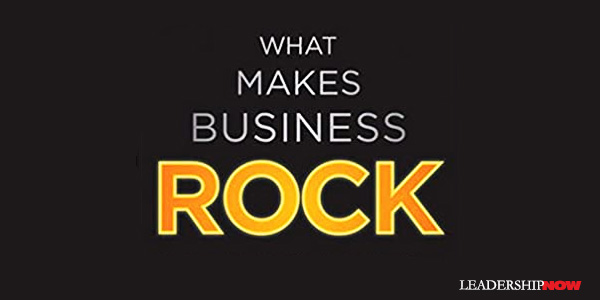
AFTER reading What Makes Business Rock by Bill Roedy, I have developed an appreciation for what it took to build MTV Networks International into what it is today. Former Chairman and CEO, Bill Roedy, has had a remarkable career. Due to financial constraints, he followed his Dad into West Point. Not his first choice. He became a member of the “Century Club” collecting more than a hundred hours of punishment duty. But he did learn the “difference between fighting the system and finessing it.” He also learned many of the skills that would enable him to succeed in business, including “discipline, time management, the value of teamwork, and the importance of physical endurance.” He learned how to prioritize. Survival depended on it. “Too often,” writes Roedy, “I have seen people focusing on the wrong things—things that are not going to directly or immediately affect their business….Leaders need to learn to cut through the chaff to determine priorities and to identify the real target.” After West Point he served in Vietnam in various command positions. “I learned the importance of making quick and firm decisions, communicating those decisions clearly to my troops, and then doing anything and everything necessary to implement them. I learned the importance of building morale, camaraderie, and a team spirit. I learned how to deal with the chain of command and how to get around it when necessary.” From Vietnam he went to Northern Italy where he spent four years in command of three NATO nuclear missile bases. A good place to learn how to deal with pressure and stress. “There are few situations more stressful than commanding a nuclear missile site and trying to determine in 30 seconds whether the aircraft approaching the base was a friend or foe. There was no margin for error. We had to be perfect every day.” Wanting to go into business, he resigned the military after 11 years and went to Harvard to get an MBA. As a child, Bill was so enthralled by the power of television that he would memorize the TV Guide and recite the schedule back to his mother. He knew he wanted to work in television so instead of the typical corporate route followed by his classmates, he took a job at a small start-up cable network called HBO. Roedy’s background doesn’t make him the likely candidate to build MTV International, but it certainly prepared him for it. More on that tomorrow. 
Posted by Michael McKinney at 11:46 PM
04.20.11

Be a Coach, Not a CriticUnless they can highlight a problem, many book reviewers don’t feel like they have done their job. They operate under the assumption that being a critic means being critical. Many bosses operate the same way. They feel feedback is good only if it is critical or negative.Adam Bryant suggests in The Corner Office, that we be a coach, not a critic. He writes, “Employees know if their boss is rooting for them to succeed, and they’re much more open to feedback if they sense the manager’s goal is to make them better. If you assume that most people want to get better, they want feedback and advice, that they want somebody to care about their future, then giving feedback becomes much easier.” Unfortunately, most bosses have not established that fact with those they “serve.” They don’t deliver positive feedback on an ongoing basis and only take the time to say anything when they have some critical points to deliver. Feedback should not be thought of as an event. It should be ongoing and in real-time. Sure that’s more difficult and time-consuming, but it is what you signed up for. Bryant shares what Tachi Yamada of the Bill and Melinda Gates Foundation’s Global Health Program had to say about feedback: “One of the things I’ve learned is that it doesn’t matter how many good things you say, the one bad thing is what sticks….Everybody has their good points. Everybody has their bad points. If you can bring out the best in everybody, then you can have a great organization. If you bring out the worst in everybody, you’re going to have a bad organization.” What are you bringing out? David Novak of Yum Brands adds, “When you start out by talking to people about what they’re doing well, that makes them very receptive for feedback because at least you’re giving them credit for what they’ve done. Then I say, ‘And you can be even more effective if you do this.’ I think that really works.” When it comes to feedback, packaging is everything. 
Posted by Michael McKinney at 07:00 PM
04.12.11

From Values to Action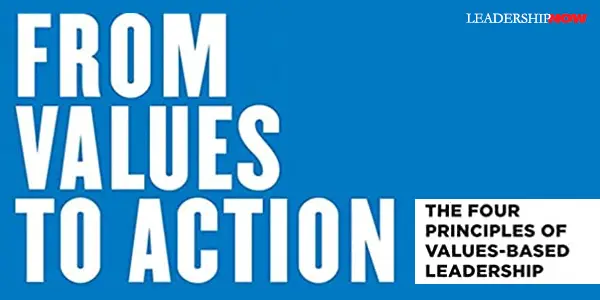
FORMER chairman and chief executive officer of Baxter International, Harry Kraemer, has written a genuine, back-to-basics book on value-based leadership: From Values to Action. He presents four interconnected principles that build on and contribute to each other: Self-Reflection is the most important and is central to your leadership. “If you are not self-reflective, how can you truly know yourself?” writes Kraemer. “If you do not know yourself, how can you lead yourself? If you cannot lead yourself, how can you possibly lead others?” Self-reflection allows you to transform activity into productivity for all the right reasons. It means “you are surprised less frequently.” It is essential in setting priorities. You can’t do everything. So reflection makes it possible to answer key questions like What is most important? and What should we be doing? in a way that is in line with your strengths and values and organizational goals. Engaging in self-reflection on a regular, ongoing basis (preferably daily) keeps you from becoming so caught up in the momentum of the situation that you get carried away and consider actions and decisions that are not aligned with who you are and what you want to do with your life. Balance and Perspective is the ability to understand all sides of an issue. Pursuing balance means you will have to grasp the fact that leaders don’t have all the answers. Kraemer says, “My task was to recognize when a particular perspective offered by one of my team members was the best answer….Leadership is not a democracy. My job as the leader is to seek input, not consensus.” Because he believes we are more effective if we balance all areas of our life, he prefers the term “life balance” over “work-life balance.” It’s not an either-or proposition. “When you identify too closely with your work, you can easily lose perspective and become unable to look at all angles in a situation.” He recommends implementing a “life-grid” to keep track of where you are spending your time and to hold yourself accountable. True Self-Confidence is know what you know and you don’t know; to be comfortable with who you are while acknowledging that you still need to develop in certain areas. (Comfortable not complacent.) Why TRUE self-confidence? There are people who adopt a persona that might make others think that they have self-confidence, but they are not the real deal. Instead, they possess false self-confidence, which is really just an act without any substance. These individuals are full of bravado and are dominating. They believe they have all the answers and are quick to cut off any discussion that veers in a direction that runs contrary to their opinions. They dismiss debate as being a complete waste of time. They always need to be right—which means proving everyone else wrong. Genuine Humility is born of self-knowledge. Never forget where you started. “Genuine humility helps you recognize that you are neither better nor worse than anyone else, that you ought to respect everyone equally and not treat anyone differently just because of a job title.”
Kraemer describes a values-based leader well: “Self-reflection increases his self-awareness. Balance encourages him to seek out different perspectives from all team members and to change his mind when appropriate in order to make the best possible decisions. With true self-confidence, he does not have to be right, and he easily shares credit with his team. Genuine humility allows him to connect with everyone because no one is more important than anyone else.” From Values to Action is an outstanding book and filled with important concepts that any would-be leader would benefit from. 
Posted by Michael McKinney at 04:13 PM
12.22.10

Are You Undermanaged?
BBRUCE TULGAN thinks that at every level of organizations there is a shocking and profound epidemic of undermanagement. That’s right undermanagement. In It’s Okay to Manage Your Boss he argues: The vast majority of supervisory relationships between employees and their bosses lack the day-to-day engagement necessary to consistently maintain the very basics of management: clear expectations, necessary resources; real performance tracking; and fair credit and reward. In fact, most employees report that they feel disengaged from their immediate boss(es); that two-way communication is sorely deficient; and that employees rarely get the daily guidance, resources, feedback, and reward that they need.Part of the problem is that all too often, people are promoted to management positions not because if their people skills, but because of their competency in one area or another. Consequently, they fail to lead, manage or supervise on a daily basis. But what about micromanaging? Tulgan says that what is often labeled “micromanagement” is really a consequence of not managing well. For example, if a manager asks an employee to check in every step of the way in order to complete simple tasks, “it is most always because the manager has not prepared the employee in advance” to able to make those simple decisions. Proper management means making sure that the employee understands how to carry out the task and responsibilities, and is equipped with the necessary tools and skills to do so. It’s Okay to Manage Your Boss is written for undermanaged employees. If the manager isn’t doing it, Tulgan says it is up to the employee to manage the boss. He writes, “In order to be a high-performer in today’s workplace, you need to create highly engaged relationships with every boss, whether that boss is great, awful, or somewhere in between.” Undermanagement is for low-performers. He lays out a seven step plan to manage your boss beginning with learning to manage yourself first. Tulgan urges us to take responsibility for our part of the management relationship. Are you undermanaged? And as a leader, are you paying attention to management basics: providing direction and guidance, holding people accountable, dealing with failure, and rewarding success? 
Posted by Michael McKinney at 12:30 AM
11.22.10

The 7 Habits of Highly-Performing CIOsSpecialization often gets us noticed in the workplace, but to deliver on the promise of that knowledge requires leadership. And that’s a different mindset. In The CIO Edge, authors Graham Waller, George Hallenbeck and Karen Rubenstruck, look at the challenges facing the chief information officer. It’s a another case of what got you here won’t get you there. They write:Focusing on leadership and people skills—the “soft” things that many CIOs tend to minimize in their quest to keep up with their day-to-day responsibilities of managing IT—is in fact the biggest determinate of their success, or failure.In other words, your job is to deliver results through your ability to influence people. As CIO you will ultimately fail is you can’t inspire others to get the right work done. You can’t do it alone. They have found that the highest performing CIOs have these seven traits in common:
Business acumen is an incredibly important trait to possess. There isn’t anything you do in corporate IT that you can’t buy somewhere else.As CIO, what matters is “understanding that your number-one job isn’t mastering the technology. It is providing collaborative, participative leadership through which you can create the relationships, commitments, shared visions, and common purpose that enable success.” Leadership amplifies your value.
Posted by Michael McKinney at 12:46 AM
10.15.10

You Already Know How to Be Great
ONE OF the hardest things we will attempt to do is to act on what we already know to do. It’s that difficulty that lies behind much of our search for the next big thing; some way to get around or make easier that which we know we should be doing. It is never easy, but by applying some new thinking, we can get out of our own way. Alan Fine states in You Already Know How to Be Great, that performance improvement is most often an issue of reducing the interference that’s getting in the way of using the knowledge we already have. Fine says that we have to get right the three elements that facilitate the use of the knowledge we already have. They are: Faith: Our beliefs about ourselves and our beliefs about others. High performance is more likely when we believe that we can learn and do better. The absence of Faith could be described as insecurity. Fire: Our energy, passion, motivation, and commitment. High performance is more likely when we are excited about learning and doing. The absence of Fire could be described as indifference. Focus: What we pay attention to and how we pay attention to it. High performance is more likely when we pay attention in a way that will quiet our minds. The absence of Focus could be described as inconsistency. High performance happens when we “get rid of the interference that blocks these natural, inherent human gifts.” Focus is the most powerful tool for removing distractions and, thus, the “most effective way to release Faith and Fire.” If we “create a singular focus on one or more critical variables of the task, we’re far more likely to create the flow state that creates high performance.” More than instructing, Fine believes we would be better off looking to what is blocking Faith, Fire, and Focus in our organizations, performers, families, and teams. Unleashing these qualities facilitates the use of knowledge. As managers, leaders, coaches, or parents, we’re incredulous to think (or more likely, it never even occurs to us to think) that without our excessive instructing, regulating, controlling, directing, and intervening, people might actually be able to perform with greater confidence, more enthusiasm, and more effective focus. Fine introduces the GROW process as a way of creating focus. The process asks: “What is my Goal? What’s the Reality? What are my Options? What’s the best Way Forward? GROW increases Decision Velocity [the speed and accuracy with which we make decisions]. It helps reduce interference, clarify thinking, identify options, and chunk down the challenge into doable tasks. It unblocks Faith, Fire, and Focus and frees people to use the Knowledge they already have. As leaders, we tend to approach most situations by providing more information. We actually nourish the expectation that we are to be telling people what to do when we really need to be working to help them get what’s inside of them out. Fine calls this inside-out coaching. It’s less about providing more Knowledge and more about releasing the Faith, Fire, and Focus that's already there in the performer. It’s more Focus coaching than it is Knowledge coaching. “It’s easy for coaches to get blindsided by what they think people have to pay attention to—to get so focused on the task that they miss the window through which a person can actually pay attention.” “When leaders simply tell people what to do (which is often the case), the result is often a lack of engagement and accountability on the part of the employee and little or no performance improvement. One of the primary observable signs of an outside-in approach is people constantly asking managers, leaders, teachers, or parents what to do.” As a coach, the biggest challenge isn’t the performer; it’s your own interference. You Already Know How to Be Great is about coaching ourselves and others to remove the interference that is blocking performance. It is full of applications of inside-out coaching and the GROW process he advocates. As such, it is an indispensable book for coaches or leaders of all types.

Posted by Michael McKinney at 06:57 PM
09.20.10

Do You Argue With Reality?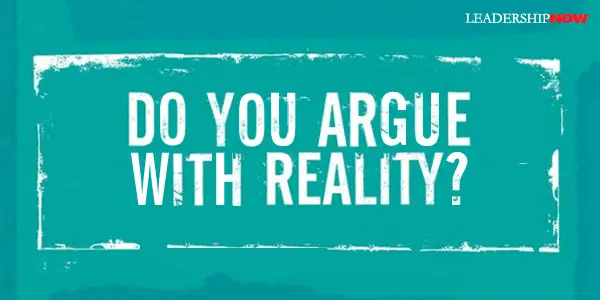
CHRIS THURMAN wrote in The Lies We Believe, “The number one cause of our unhappiness are the lies we believe in life.” Too often, we operate apart from reality. Given a choice between reality and our version of it, we are inclined to choose the latter. It is a central tendency of human beings. The result is drama, not peace. “Instead of getting the results we want,” says Cy Wakeman, “we end up with reasons, stories, and excuses for why things didn’t work out—leading to more drama, disengagement, judgment, and ineffective leadership.” In Reality-Based Leadership, Wakeman presents a much-needed wake-up call. We can ditch the drama by getting in touch with what is. Quit making up stories. Quit arguing with reality. Ditching the stories that are causing us stress. “We all tell ourselves stories and live with the resulting drama.” It sounds like:“I shouldn’t have to do this—it’s not part of my job description.
“You are arguing with reality whenever you judge your situation in terms of right and wrong instead of fearlessly confronting what is.” You need to respond to the facts, not the story you create about the facts. This is easier said than done. Interwoven in our stories are our egos, insecurities, and identities. (At one point Wakeman suggests we ask, “Who am I as a manager or as an employee when I believe this story?”) We like our stories. They make us look better. They place the blame somewhere south of us. If other people are always coming up short in our stories, then it’s all about us. But letting go of our stories is not always easy as we have a lot invested in them. Too often our criticism is about setting us apart from others and not about helping them. It says a lot more about us than it does those it is directed towards. Wakeman says, “When you are judging you are not leading.” In her analysis of the case study about Steve and a team he dreaded working with, she concludes, “his biggest obstacle is his belief that they are a negative group. What if he just dropped that whole story and simply responded to reality directly? The phone rings? Answer it. The team ask a question? Answer it, or teach them where to find the answer. The team share what worked in the past? Listen and lead them into the future. The team requests some time with the leader? Engage with them—lead! When Steve began to lead the team rather than judge and criticize, the team began to change for the better.” She adds, “When you focus your energy on what you are able to give And create rather than what you receive, you are truly serving.” Do you see any applications in what you and involved in? Wakeman insightfully writes: “What is missing from a situation is that which you are not giving.” Operating out of a judging mindset of “I know” or “I am right” effectively shuts down the potential to learn or accomplish anything. Moving on based in reality requires setting the story aside and asking, “If I set the story aside, what would I do to help?” The minute you start judging is the very minute you quit leading, serving and adding value. When you’re in judgment, you are dealing with your story—not with reality. Wakeman suggests that when you get off-track:
What stories are you telling yourself that cause you to operate in your own world? While it may be cognitively economical, it is costing you far more in every other area. 
Posted by Michael McKinney at 03:54 PM
06.29.10

Multipliers: How the Best Leaders Make Everyone Smarter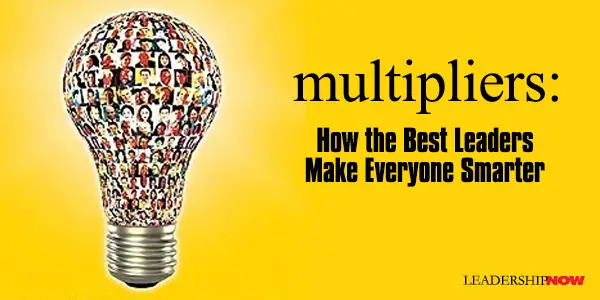
MUCH OF WHAT constitutes good leadership can be summarized in two words: respect and selflessness. How we relate to those two words will determine how we lead. Consider two assumptions that lie at the opposite ends of the spectrum: • Really intelligent people are a rare breed and I am one of the few really smart people. People will never be able to figure things out without me. I need to have all the answers. • Smart people are everywhere and will figure things out and get even smarter in the process. My job is to ask the right questions. What you believe has a big impact on the performance, engagement, loyalty and the transparency you find with those you lead and interact with. In Multipliers: How the Best Leaders Make Everyone Smarter, authors Liz Wiseman and Greg McKeown refer to those with the mindset represented by the first assumption as Diminshers and those with the mindset represented by the second assumption as Multipliers. It explains why some leaders create intelligence around them, while others diminish it. The value of Multipliers is that is shows what these assumptions about people look like in practice and how they are reflected in your behavior. How would you approach your job differently if you believed that people are smart and can figure it out? With a Multiplier mindset, people will surprise you. They will give more. You will learn more. What kind of solutions could we generate if you could access the underutilized brainpower in the world? How much more could you accomplish? It’s not that Diminishers don’t get things done. They do. It’s just that the people around them feel drained, overworked and underutilized. Some leaders seem to drain the “intelligence and capability out of the people around them. Their focus on their own intelligence and their resolve to be the smartest person in the room [has] a diminishing effect on everyone else. For them to look smart, other people had to end up looking dumb.” In short, Diminishers are absorbed in their own intelligence, stifle others, and deplete the organization of crucial intelligence and capability. Multipliers get more done by leveraging (using more) of the intelligence and capabilities of the people around them. They respect others. “Multipliers are leaders who look beyond their own genius and focus their energy on extracting and extending the genius of others.” These are not “feel good” leaders. “They are tough and exacting managers who see a lot of capacity in others and want to utilize that potential to the fullest.” The authors have identified five key behaviors or disciplines that distinguish Multipliers from Diminishers. You are not either/or but are somewhere along a continuum. These are all learned behaviors and have everything to do with how you view people. We don’t have to be great in all disciplines to be a Multiplier, but we have to be at least neutral in those disciplines we struggle with.
They have developed an assessment tool you can use to see where you are. Importantly, the first place to begin is with your assumptions about people. If you don’t have that straight the rest is just manipulation. As with most behaviors, we do them because we feel we have to. They are self-perpetuating. We jump in where we shouldn’t and come to the rescue. Under our “help” (domination) people hold back thereby reaffirming our belief that they just couldn’t do it without us. And they can’t or rather won’t. Instead they quit while still working for us or move on. We see this in ourselves, in others and in organizations of all types. Leaders are especially prone to run over people, because after all, they have the vision, the know-how and the desire to get it done. We have to slow down and remember that we are not there just to get the job done, but to develop others to get the job done. They can (and need to be able to) do it without us. It’s our job to show them how. In many ways, as leaders, we can become accidental Diminishers. The skills that got us into a position of leadership, are not the same skills we need to lead. Leadership requires a shift in our thinking. Wiseman and McKeown write, “Most of the Diminishers had grown up praised for their personal intelligence and had moved up the management ranks on account of personal—and often intellectual—merit. When they become ‘the boss,’ they assumed it was their job to be the smartest and to manage a set of ‘subordinates.’" Here are some thoughts—out of context—from the book that will get you thinking: “Marguerite is so capable she could do virtually any aspect of girl’s camp herself.” But what is interesting about Marguerite isn’t that she could—it is that she doesn’t. Instead, she leads like a Multiplier, invoking brilliance and dedication in the other fifty-nine leaders who make this camp a reality. One leader had a sign on her door: “Ignore me as needed to get your job done.” She told new staff members, “Yes, there will be a few times when I get agitated because I would have done it differently, but I’ll get over it. I’d rather you trust your judgment, keep moving, and get the job done.” The path of least resistance for most smart, driven leaders is to become a Tyrant. Even Michael said, “it’s not like it isn’t tempting to be tyrannical when you can.” Policies—established to create order—often unintentionally keep people from thinking. At best, these policies limit intellectual range of motion as they straitjacket the thinking of the followers. At worst these systems shut down thinking entirely. “It is just easier to hold back and let Kate do the thinking.” [They resign: “Whatever!”] It is a small victory to create space for others to contribute. But it is a huge victory to maintain that space and resist the temptation to jump back in and consume it yourself. An unsafe environment yields only the safest ideas. [Multipliers] ask questions so immense that people can’t answer them based on their current knowledge or where they currently stand. To answer these questions, the organization must learn. His greatest value was not his intelligence, but how he invested his intelligence in others. 
Posted by Michael McKinney at 04:28 PM
06.23.10

Developing a Small-Wins Strategy for GrowthWhen moving through difficult times, it is helpful to develop a small-wins strategy. In difficult times, deficit-thinking is so easy to fall into and often becomes the norm. It is hard to defeat but by highlighting small-wins you help to create the kind of abundance-thinking needed for growth and forward momentum. A strategy of small-wins helps to develop the kind of outlook associated with abundance-thinking—self-efficacy, hope, optimism and resilience.A small-wins strategy also helps to eliminate the tendency to be consumed by past disappointments, obstacles and failures. The need to look for “what is working now” is key to moving forward. It opens your thinking to possibilities and paves the way for improving processes. Small-wins focus on the here and now. What can we do now and what can we safely ignore or eliminate. It is an antidote to the fixation error trap. It’s easy to caught up in “everything”—the full impact of what is happening and the habits and perspectives that have become so much of who we are—that we become overwhelmed and unable to act at all. Fixation errors keep us from noticing what is really happening, separating us from reality. Reassess after each win and keep moving to build momentum. Begin by breaking tasks and issues down in to manageable pieces; pieces that you can take responsibility for and act on now. If you are not in a position to implement this strategy on an organizational level, adopt it for your team or even individually. Lead from where you are. It’s contagious. Of Related Interest:
Posted by Michael McKinney at 11:35 AM
06.09.10

Why Design Thinking Is the Next Competitive Advantage
WE live in a reliability-oriented world. And understandably so. We want predictable outcomes. We want things to keep working as they have always been—perfectly. Success. Repeat. Success. Repeat. But that thinking ultimately limits our growth and quite possibly harbors the seeds of our own destruction. It can be (very) valuable to a point, but it isn’t adaptable because by its very nature it has to leave something out of the equation. While reliable outcomes “reduce the risk of small variations in your business, they increase the risk of cataclysmic events that occur when the future no longer resembles the past” and the reliable is no longer relevant or useful. To remain relevant—to foster innovation—you need to incorporate into your thinking outcomes that are valid. That is outcomes that produce a desired result even if the solution employed can’t produce a consistent, predictable outcome. A perfectly valid solution is one that produces a result that is shown, through the passage of time, to have been correct. It is best to have a system that incorporates both—validity and reliability—into their approach. Balancing and managing the two approaches—analytical and intuitive—is what design thinking is all about. In The Design of Business, Roger Martin presents the knowledge funnel to show how knowledge moves. Each stage represents a simplification and ordering of knowledge. At the beginning is a mystery; a question. It is the observation of phenomena. Things we see but don’t yet understand.
The next stage is a heuristic, “a rule of thumb that helps to narrow the field of inquiry and work the mystery down to a manageable size.” Heuristics don’t guarantee success but do increase the probability of success. The last stage is the development of an algorithm. “An algorithm is an explicit, step-by-step procedure for solving a problem. Algorithms take the loose, unregimented heuristics—which take considerable thought and nuance to employ—and simplify, structuralize, and codify them to the degree that anyone with access to the algorithm can deploy it with more or less equal efficiency.” Martin uses the example of the development of McDonalds to illustrate how they proceeded down the knowledge funnel. In 1940 the McDonald brothers opened their first drive-in restaurant in San Bernardino, California. It did well, but by 1950 they began to lose business. Food was getting cold before it was delivered and families were put off by the hoards of teenagers they attracted. They had to develop a winning heuristic. They reduced and standardized the menu, and implemented their Speedee Service System. Ray Kroc saw an opportunity in it and bought them out. While the Speedee Service System was good, Kroc thought it left too much to chance. So he refined it and simplified it down to an exact science. The new system left nothing to chance and it was repeatable. “Kroc relentlessly stripped away uncertainty, ambiguity, and judgment from the processes that emerged from the McDonald brothers’ original insight. And by fine-tuning the formula, he powered McDonald’s from a modestly prosperous chain of burger restaurants to a scale previously undreamed-of.” The problem is getting stuck in any one stage. We tend to operate within a knowledge stage as opposed to moving across the knowledge stages. We need to explore and question, we need to exploit our solutions, even reducing them to a repeatable, efficient, formula where possible, but we need to be doing these things simultaneously. The vast majority of businesses follow a common path. The company is birthed through a creative act that converts a mystery to a heuristic through intuitive thinking. It then hones and refines that heuristic through increasingly pervasive analytical thinking and enters a long phase in which the administration of business dominates. And in due course, a competitor stares at the mystery that provided the spark for this company, comes up with a more powerful heuristic, and supplants the original business. McDonalds did well for decades, but eventually the heuristic (Americans want a quick, convenient, tasty meal) changed (Americans want a healthier menu). The solution for McDonalds is to go back and rethink the mystery and develop new rules of thumb to guide them. A trip back through the knowledge funnel. Avoiding this cycle is the job of the leader—a leader at any level. Martin writes, “CEOs must learn to think of themselves as the organization’s balancing force—the promoter of both exploitation and exploration; of both administration and invention.” This is design thinking. We need to develop our design thinking skills, analyze what’s working and why, and at the same time revisit the original mystery while considering entirely new mysteries. “The design thinker develops the capacity for observation, for seeing features that others may miss. The design thinker, in the words of novelist Saul Bellow, is ‘a first-class noticer.’” Always cycling through the knowledge funnel.
Posted by Michael McKinney at 12:28 PM
05.17.10

Serve to Lead: Make Your Life a Masterpiece of Service Everyone can be great because everyone can serve. You don’t have to have a college degree to serve. You don’t have to make your subject and your verb agree to serve…. You only need a heart full of grace, a soul generated by love.“Everyone can lead because everyone can serve,” says James Strock. “When service is the basis of leadership, everyone can be a leader.” What’s more, “We’re in a new era, with new rules, new ways to serve—and much greater accountability.” In a new edition, Serve to Lead 2.0 puts the focus of leadership where it should be. Too often, people think of leadership as being about the leader. A leader who serves has greater influence. Service—not control—leads to trust and increased influence. In an excellent chapter on management, Strock helps to place management and leadership in perspective and explains some of the nuances of tough love and accountability. “Management is encompassed within leadership.” As leaders, we must develop management skills. “Ultimately, management is a key to extraordinary service. Individual performance has the limitations of an individual. You may be a virtuoso. Yet, if you are determined to express your individuality in a more expansive way, you must develop management skills and engage others in a larger enterprise.Filled with examples and quotes, Serve to Lead 2.0 is well thought out and one of the best books you’ll read on how to think about service and how to get your leadership to be one of service. Strock urges us to make our life a masterpiece of service. It begins by asking the question—who am I serving—throughout our life, minute by minute, hour by hour, day by day. Importantly, it is not a question that we should apply to only one area of our life. It should be an approach we take in all areas of our life—our time, our money, our relationships, and thoughts. As an ongoing practice, he suggests we continually ask ourselves four questions: Who am I serving? How can I best serve? Am I making my unique contribution? Am I getting better every day? Service isn’t easy. It doesn’t always get noticed, but it is what leading is all about. If that is hard to swallow, you need to ask yourself, why do I want to lead? How many people are trapped in their everyday habits: part numb, part frightened, part indifferent? To have a better life we must keep choosing how we’re living.   
Posted by Michael McKinney at 01:42 PM
04.28.10

We Have Met the Aliens and They Are Us
WE live in a time—aided by advances in science and communication—that is obsessed with quantifying, labeling and optimizing. Generational studies are no different. While identifying and labeling the generations is valuable for understanding and discussion, if we are not careful we can lose some connection to their humanity—their sameness. While generational studies can help us to understand where people are at, if want to engage them, we would do well to remember what they are. A generation comes and a generation goes. Each carries with them their own reaction to the former generation that raised them and their own disbelief of the reactions of the next generation to their own. Yet, each generation is not a new subset of humans; a curious new life form that needs to be studied and obsessed over. They are human. They are like us. "That which seems the height of absurdity in one generation often becomes the height of wisdom in another." We do a disservice to any generation when we coddle them and commoditize them. What generation doesn’t want everything just right? But life doesn’t work like that. Our ideals keep us pushing on, exploring, reflecting, and innovating, but our disappointments and the imperfections we uncover, help us to learn compassion and build character. Every generation has difficulties to overcome and excesses to curb. Every generation is faced with the prospect of growing up. And each generation does it from a different perspective. A perspective that they gained from their observation of those that came before them. And they will hand a different perspective, a different emphasis, over to those that come after them. "Parents often talk about the younger generation as if they didn't have anything to do with it." Like us, they are reacting to their upbringing and the world it created and bringing with them an attempt to find some greater idealism. Similarly, they need to learn balance, curb excesses, and rediscover forgotten behaviors and values. They need to learn compassion, the freedom that comes from admitting that you don’t know it all, and the value in what has come before them. No one generation excels completely in all things. All have different pieces of the life puzzle. All begin by placing a different weight on what is important and need to work to find the balance that makes their life more complete. We all share a humanity that spans generations. Human nature doesn’t change. Not everything the previous generation did was bad. Often it was good and necessary, but was executed poorly. We can be thankful that while previous generations were concerned with “work-life balance,” they decided they had better keep their focus on the tiller so that we would have the opportunity to run on the deck, criticize their methods, and endlessly debate whether or not the figurehead represents us well. "When I was a boy of fourteen, my father was so ignorant I could hardly stand to have the old man around. But when I got to be twenty-one, I was astonished at how much he had learned in seven years." A study of generational differences, more than anything, helps us to understand the consequences of our behaviors. What has worked and what hasn’t. Why an over-emphasis on this causes a problem there. If we can learn from it, we profit. However, our natural reactivity causes us to not learn as we should or build on the lessons of those that came before us. Human beings are not hard-wired with the lessons learned from the previous generation. So we all start at the beginning—learning and relearning—in the context of the world we find ourselves in. Each generation must come to the same place at the end of their lives as the one before it. All need to grow up. We need to become practiced at learning from each other; valuing each generation for where they have been, what they are learning, and the perspective they bring. In a more connected world, the consequences of our behavior are greater. We have more reach. What we do affects more people and for longer periods of time. This creates a critical need for wise leadership. Each generation will rewrite their world. Their thoughts and ideals aren’t new. Their emphasis is. “Treat Millennials with respect and dignity. Don’t over-manage them. Make them feel included.” Really? This isn’t generation-specific. We all desire those things. Generational analysis also reminds us that not everyone sees things the way we do. “By understanding other generations’ perspectives,” writes Tamara Erickson in What’s next, Gen X?, “we are better able to position our ideas and requests in ways that are likely to have positive results and avoid at least some of the frustrations of today’s workplace.” There are many good books in print that help to highlight the challenges that current generations face, their perspectives, and how we might learn from each other, and offer points of connection to help bridge the gaps. Here are several:
All generations face the same human issues but from different perspectives and with different tools. But they all look for connection, meaning, and contribution. They all want to add value and feel the satisfaction of a job well done.
Posted by Michael McKinney at 01:28 PM
04.26.10

Leading Outside the Lines: Mobilizing the Informal OrganizationRight now, the informal elements of your organization are either working for you or against you. Yet for most leaders, say Jon Katzenbach and Zia Khan, authors of Leading Outside the Lines, the informal organization is poorly understood, poorly managed, and often disregarded because it is too hard to think about.The formal organization has its own way of attracting, selecting, developing, and rewarding people—but it rarely has the power to affect promotion or compensation. Therefore, those who rise to influential positions in the hierarchy are more likely to be more comfortable with and skilled at using the formal organization than the informal….Informal leaders rarely have the kind of explicit qualifications that can be easily documented or communicated, much less evaluated.The informal organization lies in the human side of the enterprise and as most things that reside there, it is hard. Unlike the formal side with its top-down, rational approach, the informal is fuzzy, constantly changing and hard to measure. So it is understandable that we would like to somehow ignore it or work around it. But, “if you want your entire organization to improvise frequently and energetically in response to fast-moving change, formal management techniques alone won’t get you there. You need help from the informal side as well. Mobilizing the informal organization helps support formal management mechanisms, increasing their chances of success and deepening their long-lasting impact on the organization.” For leaders, the challenge is to find the balance between the formal and the informal elements of the organization in their particular situation, to achieve concrete, measureable results. When trying to make a change, our default tactic is to explain “in excruciating detail why the new plan is important.” We think if they get the logic of it, they will get behind it. But they often don’t. People need an emotional connection. Simply formalizing a new set of rules, programs, and structures will not pull the company's culture along. “To that end, leaders need to be able to translate vision, targets, and strategies into personal purpose, accomplishments, and choices that each one of their people can understand and feel good about pursuing.” The authors make the distinction that while the formal organization is best when dealing with predictable and repeatable work that needs to be done efficiently and without variance, the informal organization is best suited to unpredictable events—surprises that need to be sensed and solved. They add that in many cases, when activity in the informal organization starts to repeat itself, it “is a signal for broader changes that need to be made to the formal organization.” To move beyond “best practices” and the status quo—to get to “best performance”—a leader needs to learn to mobilize the power and plasticity of the informal. What You Can Do Now
Posted by Michael McKinney at 12:05 PM
04.14.10

The Little BIG Things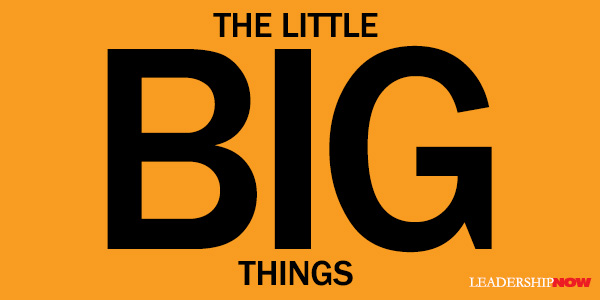
IN many ways leadership is about taking an oath of excellence. To a leader, excellence matters. Excellence requires “re-imagining” (to borrow a Peters’ term) your world done excellent. Leaders see things differently and this difference can be taught. Teaching excellence—one behavior at a time—is what The Little Big Things by Tom Peters, is all about. Some of what you will read in TLBT has been presented on the Tom Peters blog over the years. But for this book, the posts have been edited, revised, organized and conveniently packaged. It’s a compilation of 163 behaviors you can put into practice to achieve excellence in any endeavor. As such, it is not meant to be read straight through. Jump in anywhere it looks interesting. The process here is: read—consider—implement—repeat. Tom, as we’ve said here before, is good at boiling things down to basics. You’ll find opportunities to pursue excellence in basic insights that produce big results. Courtesies of a small and trivial character are the ones which strike deepest in the grateful and appreciating heart. Sometimes the little-big-things can seem too “soft” or beneath the demands of business. Tom explains: “Ideas like conscientiously showing appreciation are matchless signs of humanity—and the practice thereof, in my opinion, doubtless makes you a better person, a person behaving decently in a hurried and harried world….Acts of appreciation, to stick with my theme of the moment, are masterful, even peerless, ways of enthusing staff and partner and client alike, and, hence, greasing the way to rapid implementation of damn near anything. That is, ‘Soft is hard’ is wholly pragmatic—and more often than not, effectively implemented, makes the bottom line blossom!” Excellence has to be challenged into existence. The Little Big Things does just that. 
Posted by Michael McKinney at 08:00 AM
03.23.10

Leading in Turbulent Times
I THINK Victor Fung of the Li and Fung Group (the Chinese multinational founded in Guangzhou in 1906) summed up well the sense of the kind of change we face today: A lot of people say, hey, this is a once in a century type of problem. We haven’t had anything like this since the 1930s. You hear all these statements, and they seem to imply that this is once in a lifetime after I get through this one, boy, am I glad I will never have to face this again. But I’m not so sure. I think we are seeing both the compression of cycle time – how quickly the cycles come and go – and also the amplitude of the swings getting more and more severe. The world has fundamentally changed. I think we all understand that this type of change requires a special kind of leadership. Kevin Kelly and Gary Hayes have collected in Leading in Turbulent Times the lessons learned from over thirty CEOs, Chairmen and other senior executives who are prevailing in spite of a challenging environment. It’s a valuable look at how some frontline leaders are finding the right balance between seizing the opportunities as they present themselves and managing the accompanying risk. Rather than typical conversations focused on financial matters, Kelly and Hayes found that three strong messages emerged from their interviews: Passion Rules – these leaders are driven by a real passion for their business, their organization and the people they work with. Hard Times Call for a Mastery of Soft Skills - especially communication but also empathy, mentoring and coaching. (“This is a timely reminder that cost control is a business basic, but extracting great performance from people is always based on more complex and subtle motivational tools than pure fear.”) A CEO in Germany observed that whenever a leader talks about change, employees always expect the worse. Learning to motivate and engage people in spite of the crisis becomes critical. Think Long Term – these leaders refuse to bow under immediate pressure. They use short-term pressures to harden their focus on long-term objectives. Infosys CEO Kris Gopalakrishnan says, “We need to be much more flat, creating a collegial team-based leadership style so that you can leverage a lot more of people’s intellects and capabilities and make them participate in decision making.” This requires a level of social skills that haven’t been demanded of leaders in the recent past and so I imagine this necessitates a lot of learning-as-we-go. At the same time, we have a more educated workforce that brings with it other issues that require fresh approaches. Henry Fernabdez, CEO of MSCI Barra observed, “They figure things out very quickly. They tend to be more open to change but, on the other hand, they’re smart and can become cynical and harder to change.” As a result, the job of leadership is changing. Through revealing and personal interviews, Kelly and Hayes have analyzed the current situation beginning with how to recognize the early signals, mobilizing people to act, navigating a new course, preventing "mutinies" by engaging the resistors and learning to be flexible in the face of the unpredictable. To live in these turbulent conditions requires that you dig deep. Leaders need to develop and constantly improve; a deeper self-knowledge; new perspectives. As they note, this isn’t easy. “It is a bit like trying to get fit when you are in the middle of a title fight.” A positive mental attitude is critical says Mark Frissora of Hertz: The shadow of a leader is huge so it is very important that we walk out of this room with smiles on our faces, and talk about the opportunities. We need discipline, but at the same time, we need to make sure that we always put a positive frame of reference on everything we’re doing.  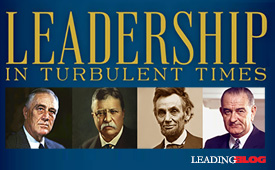 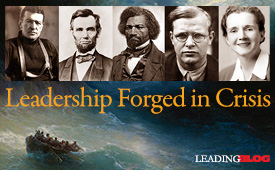
Posted by Michael McKinney at 11:14 PM
02.03.10

The Right Fight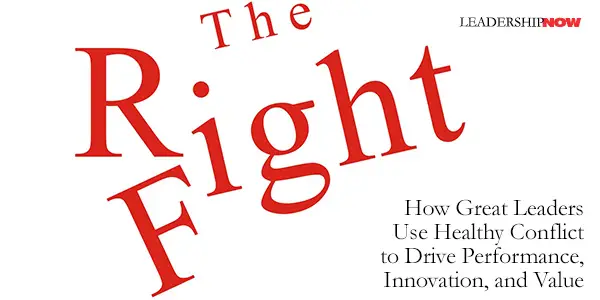
IF YOU believe that the single most important thing leaders have to get right is alignment, if you think that the leader’s time is best spent promoting teamwork and making sure everyone is on the same page and playing nice, then you might want to take a look at Saj-Nicole Joni and Damon Beyer’s book, The Right Fight. The book is based on a counterintuitive premise: In an environment where alignment is the only goal, alignment robs us of necessary dissent, of the checks and balances that mitigate risk, and of the tensions that create innovation and sustainable value. In short, you need to systematically orchestrate the right fights but … you need to fight them right. The Right Fight principle is based on the idea that you learn and grow by the right amount of friction and stress. “A certain amount of healthy struggle is good for organizations and for individuals. Indeed, people and organizations perform optimally when they are under the right kinds and amounts of stress.” They add, “With alignment and properly managed tension, organizations hit a sweet spot and start realizing their potential.” Citing a study by Theresa Wellbourne of eePulse, the single greatest predictor of poor performance is when employees are happy or complacent and thus unmotivated to change. The second greatest predictor is when employees are overwhelmed. Both groups exhibit a low level of energy. They conclude that “Tension in the right measure creates the emotional energy people need to change.” The trick for leaders is to avoid these extremes. “Knowing where and when to use tension is critical. Knowing how to work through the tension is equally important.” They lay out three principles that identify right fights and three more principles that clarify the rules of engagement. The first three Right Fight Principles will help you in identifying and eliminating destructive tensions: Right Fight Principle #1: Make it Worth Fighting About. Make it Material. “A right fight has to create significant value, require integration of multiple perspectives, and change the way work gets done in an organization. In short, a material fight is worth the trouble.” Right Fight Principle #2: Focus in the Future, Not the Past. “Obsession with past performance, or intense interest in decisions made months or even years before, is a dead giveaway that your organization is stuck in a wrong fight.” Right Fight Principle #3: Pursue a Noble Purpose. “Right fights connect people with a sense of purpose that goes beyond their own self-interest, unleashing profound collective abilities to create in ways they didn’t think possible.” The final Right Fight Principles guide you in fighting right fights right: Right Fight Principle #4: Make it Sport, Not War. “Right fights, like sports, have to have rules. One of the key tasks for leadership in a right fight is to define the parameters so everyone involved understands how to participate and what it takes to win.” Right Fight Principle #5: Structure Formally but Work Informally. “You need to structure right fights through the ‘formal organization,’ but work out the tensions created by those fights through the ‘informal organization.’” Right Fight Principle #6: Turn Pain into Gain. “There is a fine line between productive tension and destructive distress, and no two people draw that line in exactly the same place. For right fights to be fought right, leaders need to make sure no one is put under unbearable pressure. Turning pain into gain requires leaders to relate to their team members as individuals and to figure out what creates synergy, stretches skills, and honors outcomes for each of them.” There are case studies to illustrate each of these principles in action. It’s easy to see the negative side of tension: focusing on the past, stigmatizing the losers, fighting over turf. “But without tension, nothing moves.” Tension creates an opportunity for leaders to help their organizations fight the right fight. 
Posted by Michael McKinney at 08:57 AM
12.02.09

Managers Can (and Should) Be Leaders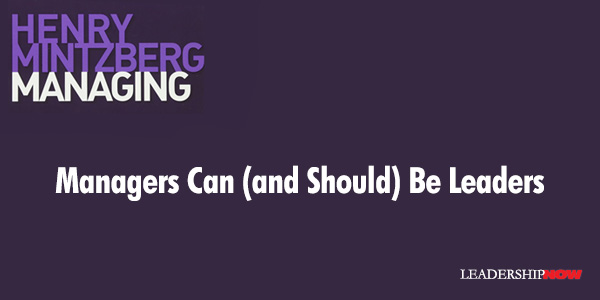
IT HAS BECOME commonplace to regard managers as inferior to leaders. Leaders are out front getting things done and managers are … what are they doing? This is, in part, due to our proclivity to label people as one or the other. Henry Mintzberg is the antidote to that kind of unproductive thinking. He writes in a book simply titled Managing: “we should be seeing managers as leaders and leadership as management practiced well.” While I have maintained that there is value in separating the functions of managers and leaders for the better understanding of both, in practice, they shouldn’t be two different people. Mintzberg believes that managing is a practice that is learned on the job through apprenticeship, mentorship, and direct experience. He has good cause to assert that we should be more concerned about “macroleading;” people that manage by remote control; too far above it all. “We are now overlead and undermanaged, he writes.” By obsessing over the glories of leadership, we lose our grasp on the realities of management. And our leadership is all the worse for it. “The more we obsess about leadership, the less we seem to get.” Managing is a valuable read. Mintzberg always makes you stop and think. He’s at his best when he’s leveling the playing field. As we’ve stressed on this blog before, leadership isn’t evolving. Leadership (and management) are a fundamental human activity. How they are practiced may change depending on the context, but their essence remains unchanged. Much of what we have to learn and relearn are fundamental principles regarding how people get along and work together. Managers deal with different issues as time moves forward, but not with different managing. The job does not change. We buy new gasoline all the time and new shirts from time to time; that does not mean that car engines and buttons have been changing. Despite the great fuss we make about change, the fact is that the basic aspects of human behavior—and what could be more basic than managing and leading?—remain rather stable.Mintzberg has distilled management thought into a general model of managing—what do managers do? They operate on three plains of activity, from the conceptual to the concrete: They act through information. They work through people. They manage action directly. And they need to operate on all three planes. “Too much leading can result in a job free of content…and detached from its internal roots.” A blending of all three planes into a dynamic balance is required and is best learned on the job. “No simulation I have ever seen in a classroom … comes remotely close to replicating the job itself,” says Mintzberg. He playfully addresses the conundrums of managing like: How to keep informed when managing by its own nature removes the manager from the very things being managed? How to delegate when they are better informed than the people to whom they have to delegate? How to maintain a sufficient level of confidence without crossing over into arrogance? How to bring order to the work of others when the work of managing is itself disorderly? And how do you do all these things at once? Managers are flawed. “If you want to uncover someone’s flaws, marry them or else work for them. Their flaws will quickly become apparent. So will something else: that you can usually live with these flaws. Managers and marriages do succeed. The world, as a consequence, continues to unfold in its inimitably imperfect way.” [He adds in the notes: “Not always. Politicians seem to become particularly adept at hiding flaws during elections until they become fatal in office.”] We are successful to the extent that our weaknesses are not fatal relative to the situation we are in. Commitment is the key; commitment “to the job, the people, and the purpose, to be sure, but also to the organization, and beyond that, in a responsible way, to related communities in society.” He concludes, “To be a successful manager, let alone—dare I say—a great leader, maybe you don’t have to be wonderful so much as more or less emotionally healthy and clearheaded.” No institution can possibly survive if it needs geniuses or supermen to manage it. It must be organized in such a way as to be able to get along under a leadership composed of average human beings.”That’s good news!   
Posted by Michael McKinney at 01:43 PM
11.20.09

Lead Your Boss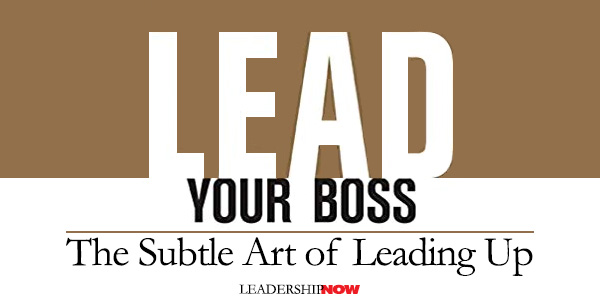
A CAN-DO PERSON himself, Theodore Roosevelt once advised, “Do what you can, with what you have, where you are.” Roosevelt’s admonition is easier said than done. Most of us are not in a position to implement sweeping change by the wave of our hand. And some of us are in a counterproductive culture where sticking your head up is a good way to get it knocked off. But we can learn to do what we can, with what we have, from where we are.It means that we must learn the art of leading from the middle—from among rather than from in front. And if we are honest, in most contexts, we find ourselves leading from the middle. (CEOs included) We are trying to influence the people around us, above us and below us. So learning to appropriately and effectively lead in this way, will impact our success in most areas of life. John Baldoni has written a primer on leading from the middle with Lead Your Boss: The Subtle Art of Managing Up. What I appreciate about his writing is that it is down-to-earth, nuts-and-bolts, and easy to connect with. He is aware of the fact that it is not easy and can be fraught with peril. He writes, Those who lead from the middle are those who think big picture and can do what it takes to get things done so their bosses and their teams succeed….Those who succeed at leading from the middle also are artful and adept managers. Baldoni says that leading up begins with answering three questions: 1. What does the leader need?
As he suggests, this is a selfless act that speaks to the heart of leadership. It requires people who can think for themselves and take the initiative to make things happen. Answering the three questions, taking the initiative and making it happen is the trick and is the focus of the rest of the book. Lead Your Boss walks you through every critical step of leading up. It provides instruction for overcoming those inevitable obstacles and you’ll find tips and strategies for:
Leading up is not a solitary job. “Leading up requires the ability to develop the talents of others; this is important for two reasons,” writes Baldoni. “One, you need to demonstrate that you know how to lead others; and two, putting others into leadership positions gives you the time you need to think and act strategically, that is, to lead your boss and your team more effectively.” Below is a two and a half minute video that provides a good overview of the book by author John Baldoni: 
Posted by Michael McKinney at 03:26 PM
11.02.09

Nestlé's Paul Bulcke on Staying the CoursePaul Bulcke became chief executive of Nestlé SA in April 2008. An inauspicious time to take over the world's largest food company. Deborah Ball reports on an interview with Bulcke. In the short (2:35 min) video embeded below, he reflects on being authentic, developing a culture of competitive intensity and making people feel they have ownership.He says, “If your strategy is right, stick to the strategy. Maintain your inspiration which is long term, but do act short term.” Here is a brief excerpt from the article: WSJ: What is the worst piece of management advice you've received on how to deal with a downturn?Bulcke adds, “We are a long-term company. We are not going to do what I sometimes call "Hoopla" management, and do something damaging. We will be responsible.” Of Related Interest:
Posted by Michael McKinney at 09:53 AM
09.04.09

How to Have More Productive Performance AppraisalsPaul Falcone asks “Does the thought of conducting a performance appraisal for your employees make you cringe?” In Productive Performance Appraisals, Falcone and co-author Randi Sachs set out to make the process more comfortable for all involved. They say that performance appraisals are nothing more than an ongoing feedback system. It also “represents a system of ongoing engagement with your subordinates that creates for them an environment of job satisfaction and motivation” and it will also “help you build a culture that focuses on performance excellence."The most important result is not the rating and encouragement of the employee, but the actual process itself. “By working together to analyze and evaluate the employee’s performance as well as his place within the department and the organization as a whole, and by setting goals for the near- and long-term future, you and your employee can strengthen your relationship and become a team of two adults working toward a common, agreed upon goal.” Here are several tips:
Posted by Michael McKinney at 09:17 AM
09.02.09

Do You Have a Court Jester?
I WROTE on Twitter, “As a leader, if you are not encouraging candid feedback, you are just asking for trouble. Do you have a court jester?” It’s a valid question. French politician Bernard Tapie wrote: “If you haven’t got people around who’ll tell you when to take a running jump, you're not a proper boss.” Manfred Ket de Vries has long advocated the need for a so-called “organizational fool.” He writes, “Leaders in all organizations need someone like this who is willing to speak out and tell the leader how it is. That is precisely the role of the fool.” David Riveness has given us The Secret Life of the Corporate Jester that delves into the specific task of the Court Jester—the concept of jestership. Leaders most often don’t receive the unvarnished truth and most organizational cultures don’t encourage it. As a result, blind spots in their thinking keeps them “from recognizing critical information, powerful choices, and clear paths to follow.” The lack of truth also creates a cycle of arrogance that feeds on itself. The jester concept is a perspective we need to incorporate and encourage in those around us. The jester understands that “in organizations, flawed actions result from an incomplete awareness and understanding of organizational truth.” Riveness suggests that the jester philosophy can be adopted in three distinct but complementary ways:
Jestership, Riveness writes, “could involve speaking your mind more often, speaking up for those that choose not to, challenging the status quo and illuminating the blind spots you uncover in more public ways. Remember to use your jester skills to perform all of the above with subtlety, creativity, and grace because this role can be very tricky—even dangerous if entered into haphazardly.” Most people aren’t ready to have their blind spots uncovered, so begin with your own. The example you set, will in time, draw others to the jester philosophy. 
Posted by Michael McKinney at 05:52 PM
08.11.09

Newswire: The Evolution of Military Leadership
Posted by Michael McKinney at 04:59 PM
07.27.09

5 Leadership Lessons: Getting Your Relationships Right Townsend wrote Leadership Beyond Reason to help you understand and utilize the soft skills – that which is beyond reason. He says “you ignore what is beyond reason at your own peril….Leading from your inner world ultimately produces better results in your leadership.” He divides our inner world into five areas: values, thoughts, emotions, relationships and transformation. As leadership is about connecting with those you lead and a primary focus of leadership, let’s pull five lessons from Townsend on relationships: Developing your relational abilities will help you read the landscape. Townsend adds, “The leader who misses relational aspects is surprised when people become distant, resentful, or just leave. The relational leader sees the signs coming a long way away and has time to do something about them.”
Posted by Michael McKinney at 09:51 AM
07.14.09

Disconnecting Horizontally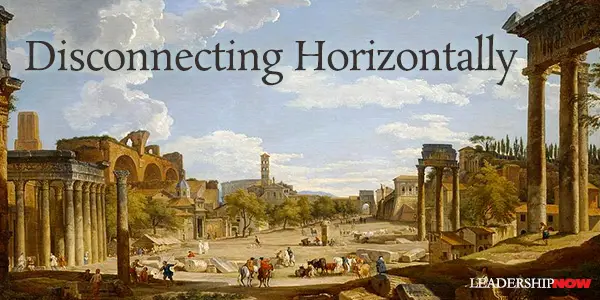
IN HIS excellent analysis of How Rome Fell, historian Adrian Goldsworthy makes some interesting observations about how we tend to disconnect horizontally from anyone or anything outside of our group. We lose our sense of place, and this makes any change so much harder. People resist change when they can't see the bigger picture and why it is necessary. The challenge is to cross our self-imposed boundaries into a world not of our own making and connect to the outside both personally and organizationally.
And this on ever-expanding bureaucracy: By their nature, bureaucracies tend to grow. This was true in the Roman Empire, let alone with the massively larger government agencies of modern countries. Individuals within a department obviously have to focus on a particular task. It is only natural to believe that with more people they could deal with this more effectively. The larger they grow, then the more distant most members will be from the reality of the overall function of the department, and they will become even more removed in their way of thought to anyone outside. This is not inevitably a bad thing, but it does mean that they will continue to expand unless restrained, since their problem or concern is the only one they will see. 
Posted by Michael McKinney at 11:55 PM
06.03.09

Whatever Happened to the Rugged Individualist?“Corporate America is in the midst of a crisis” write Jonathan Littman and Marc Hershon in I Hate People! “The spirit of the individual has played a huge part in forging our nation’s history. Yet the scourge of teamwork pap has made solo efforts in companies seem unwanted, crazy, even dangerous.“Instead of thinking of yourself as a staffer in a big company, the manager of a division, or a top executive, you begin to define yourself in concrete individualistic terms. You are a brand unto yourself. Brainstormer extraordinaire. Marketing whiz. Charismatic project leader.” At the same time the soloist is not a loner, a recluse or a maverick. They fit smoothly within a group, playing with it expertly while often leading or accompanying fellow members. I Hate People! Kick Loose from the Overbearing and Underhanded Jerks at Work and Get What You Want Out of Your Job is a guide for navigating through the kinds of people in the workplace that make us all miserable and undermine rugged individualists. How do you know if you're a Soloist, or at least destined to become one? The easiest sniff test is how many times a day you mutter, shout, or even think to yourself, "I hate people!" But not all People Haters are necessarily Soloists. Littman and Hershon have created the Am I a Soloist Quiz to help you determine the depth of your Soloist leanings. The higher your score, the more Soloist blood in your veins. A. The portion of the day I prefer working by myself is . . .
Posted by Michael McKinney at 04:55 PM
05.27.09

Creating a Sustainable Business Environment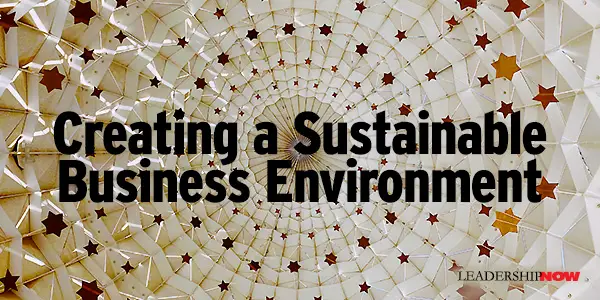
CHARLES HANDY writes that to repair the damage to the image of business, leaders of those businesses should bind themselves to a form of the Hippocratic Oath, “Above all, do no harm.” It means doing more than being legal. It means being ethical. It means taking the lead in creating sustainable environments for both individuals and the world they live in. Lee Cockerell, former executive vice president of operations for Walt Disney World Resort, says that “the organization of the future will pay as much attention to people and leadership strategies as it does to products and services.” He adds that “good leaders are environmentalists: their responsibility is to create a sustainable business environment—that is, one that is calm, clear, crisp, and clean, with no pollution, no toxins, and no waste—in which everyone flourishes.” To that end, leaders must create an inclusive workplace where every employee can contribute to the best of their ability. In The Organization of the Future 2, he suggests ten goals you can set for yourself where you can impact your organization’s culture:
Posted by Michael McKinney at 12:30 AM
05.22.09

The 14 Questions Every Board Member Needs to Ask
THE question of who’s running the organization is a critical one in this economic environment. Many boards are being asked to do what they were never prepared to do. The challenges and pressures are immense. In a critically important book for directors—Owning Up—world-renowned adviser Ram Charan says the economic downturn is a wake-up call to corporate boards. “Boards need to own up to their own accountability for the performance of the corporation.” Increasingly, "governance now means leadership, not just over-the-shoulder monitoring and passive approvals. Boards must fiercely guard their companies against the threats of rapid decline and sudden demise, while at the same time helping management seize the opportunities that tumultuous change presents but are hard to see in the daily fray of running the business. The board that does both turns governance into a competitive advantage." And all of this without micromanaging. It’s quite a balancing act. [Charan: “Asking questions of an operating nature is not in itself micromanaging, as long as the questions lead to insights about issues like strategy, performance, major investment decisions, key personnel, the choice of goals, or risk assessment.” Why and how is key.] Charan offers fourteen questions that “get to the heart of the unique issues that boards are facing now.” I think the questions are as insightful and provide as much food for thought as the answers they might evoke: Question 1: Is the Composition of the Board Right for the Challenge?
In good times, not enough consideration has been given to question one. Does the board have enough depth of knowledge or experience to ensure the organization stays on track? “Directors as a group must have the specific skills and perspectives needed to carry out their responsibilities.” And these skills must evolve with the times. “If the composition of the board is not appropriate, it is the failure if the [governance] committee. The board must empower the committee to actively shape the board composition.” Bad directors drive out good directors. It’s time for a check-up. Charan’s questions help boards do just that. Additionally, while squarely aimed at directors, Charan’s questions serve a wider audience of leader’s as well. The questions speak to any leader of the need to “own up” to the responsibilities found in their own context. Are we up to the challenge in the area we have chosen to lead? Are we dealing with the issues? Are we trying to identify the issues early and get ahead of them? Are we learning so that we are better able to perform? Are we aware of our impact? All of these questions speak to the need for personal accountability. Addressing Charan’s questions is the way forward. 
Posted by Michael McKinney at 10:03 AM
05.11.09

Sebastian Coe On Creating a Winning Culture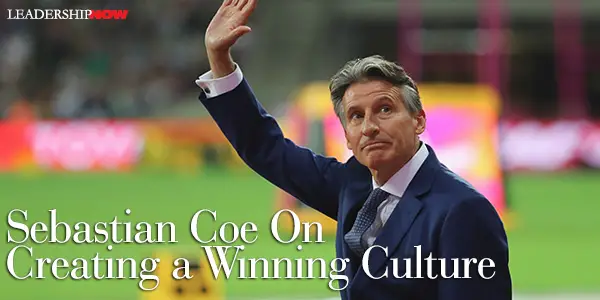
Sebastian Coe, Olympic gold medalist, politician, business leader and chairman of the London Organizing Committee for the 2012 Olympic Games, has written an inspiring book on the mental preparation required for winning in any endeavor. The Winning Mind is a fast-paced collection of life experience that offers evocative insights and expert coaching. Coe believes that leaders are shaped by their “environment, by their ambition, by their role models, by the support they are given as they progress through life and by sheer determination. Our aim must always be that there should be no limit to what an individual from any background can achieve with focus and application — provided they recognize and grab their opportunity with both hands.” Coe says that teams are most productive when they understand the part they play in achieving the final outcome. This requires very clear leadership. “Part of this is ensuring that the work culture is constructive, positive, inclusive and constant.” He offers this advice for creating a winning culture:
How well are you nurturing the conditions necessary to be able to put complete trust in your team? 
Posted by Michael McKinney at 03:27 PM
05.06.09

Ten Leadership Skills You Need For An Uncertain World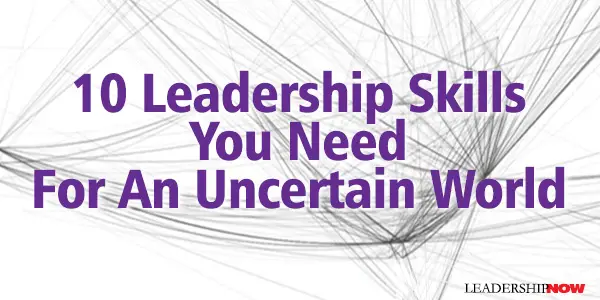
UNCERTAINTY is a part of life. Uncertainty is a call for leadership. Creating clarity from uncertainty is a leader’s stock in trade. Unquestionably some periods of time are more demanding than others. Times like these call on leaders to take a broader view of who and why they are leading and the impact they are having on the world around them. While this is very demanding for any leader, it is also more meaningful. In Leaders Make the Future, futurist Bob Johansen reports that volatility, uncertainty, complexity and ambiguity will only get worse in the future. “Solvable problems will still abound, but top leaders will deal mostly with dilemmas which have no solutions, yet leaders will have to make decisions anyway.” Johansen emphasizes ten leadership skills that will help leaders to cope and thrive in the volatile decade ahead. “We need not passively accept the future. Leaders can and must make a better future.” Although it’s “hard to even think about the future if you are overwhelmed by the present … looking to distant possibilities can provide new insight for the present.” The ten skills he lays out move from the instinctual to the complex and build on each other. Here is a summary of Johansen’s work for you to think on:1. Maker Instinct: The ability to exploit your inner drive to build and grow things, as well as connect with others in the making. Future leaders will need both a can-do and a can-make spirit. The maker instinct is what separates the leaders from the powerless. 2. Clarity: The ability to see through messes and contradictions to a future that others cannot see. Leaders are very clear about what they are making, but very flexible about how it gets made. How can you as a leader, create and communicate with clarity in confusing times – without being simplistic? 3. Dilemma Flipping: The ability to turn dilemmas – which, unlike problems, cannot be solved – into advantages and opportunities. We must be able to nurture the ability to engage with hopelessness, learn how to wade through it to the other side, and flip it in a more positive direction. Think Roger Martin’s concept of the “opposable mind.” How can you remake a situation with no solution? 4. Immersive Learning Ability: The ability to immerse yourself in unfamiliar environments; to learn from them in a first-person way. Immersive learning requires active attention, the ability to listen and filter, and to see patterns while staying centered – even when overwhelmed with stimuli. Leaders can’t absorb everything, so they must filter out extraneous information and learn how to recognize patterns as they are emerging. 5. Bio-Empathy: The ability to see things from nature’s point of view; to understand, respect, and learn from nature’s patterns. It is big-picture thinking that respects all the multiple interrelated parts and nonlinear relationships, as well as cycles of change. 6. Constructive Depolarizing: The ability to calm tense situations where differences dominate and communication has broken down – and bring people from divergent cultures toward constructive engagement. The next decade will be characterized by diversity and polarization. The temptation is to pick sides, but that is rarely a good strategy. 7. Quiet Transparency: The ability to be open and authentic about what matters to you – without advertising yourself. This begins with humility. Leaders who advertise themselves and take credit for their own performances will become targets. Are you self-promoting? 8. Rapid Prototyping: The ability to create quick early versions of innovations, with the expectation that later success will require early failures. Fail early, fail often, and fail cheaply. Accept failures as important ingredients to success and learn from them. 9. Smart Mob Organizing: The ability to create, engage with, and nurture purposeful business or social change networks through intelligent use of electronic and other media. Leaders are what they can organize. Can you organize smart mobs using a range of media? 10. Commons Creating: The ability to seed, nurture, and grow shared assets that can benefit other players – and sometimes allow competition at a higher level. Can you create commons within which both cooperation and competition may occur? 
Posted by Michael McKinney at 09:30 AM
04.24.09

What Games Do You Play?We all play games. We play them for the promise of reward they hold. They function as a coping mechanism to help us to navigate uncertain and challenging settings. But they are self-serving and drain people of energy and commitment. “They lock people into routines and rituals that hamper flexibility and thwart change efforts.” They will never go away, but we can minimize both the frequency and their effect.“A lack of knowledge about games allows them to thrive” say Mauricio Goldstein and Phillip Read in their book, Games At Work: How to Recognize and Reduce Office Politics. “The more you know the better able you’ll be to limit their damage and turn the energy of your people in more productive directions.” You might have played or been involved in some of these common games they mention:
The authors give managers the tools to “diagnose” the games that people play in their company. Using a three step process entitled AIM—Awareness, Identification, Mitigation—with specific examples from global companies that illustrate both the games and their solutions, Goldstein and Read provide a clear outline for managers to address and end the games people play in organizations. They also present five principles to keep in mind: To game is human. Your goal is to have fewer and less. Games flourish during times of high anxiety. Companies need anxiety to fuel performance, however this anxiety and stress needs to be channeled into productive rather than manipulative behaviors. Your company’s games are not comparable to another company’s games. Different organizations have different game ecologies. Minimizing game playing starts at home. As soon as you deny that you play or facilitate games, you’ve limited your options for dealing with them. Recognizing this tendency in yourself helps you deal with these issues at a personal level. Dialogue is a natural antidote to games. Don’t embark on a course of “gamocide” – that is. Don’t create programs and policies to punish game playing. This will serve only to create more games. Speaking openly and honestly discourages game playing.
Posted by Michael McKinney at 04:23 PM
04.20.09

How to Hit the Ground Running
STAKES are high. Whether you are just starting out, trying something new, or just starting each day with the understanding that you need to be putting your best foot forward, you need to know how to get up to speed, make the right decisions, and produce the right results fast. You need to hit the ground running. If you could sit and learn from some of America’s best CEOs, you could discover the right steps to take to ensure your success while avoiding many of the pitfalls that come from learning from one’s own experience. In Hit the Ground Running, Jason Jennings has made that possible. He has selected ten CEOs that created more economic value for their companies than all of the other CEOs of America’s top one thousand companies during the study period. They made the decisions that allowed them to achieve great results on issues we can all relate to by adhering to, sometimes, counterintuitive principles. From interviews and observation, Jennings has compiled these principles into ten lessons from each of these CEOs that if applied, will help you to hit the ground running. Rule 1: Don’t Deceive Yourself—You Will Reap What You Sow Let the Golden Rule guide every decision. Richard Smucker says, “In matters of style, swim with the current but in matters of principle, stand like a rock.” Rule 2: Gain Belief Leaders gain belief by being authentic and humble, getting rid of regal trappings, proving their worthiness, asking others for belief, and surrounding themselves with others who are also trusted. "I need everyone to respect and support one another and work with each other. Everything else is B.S." says Fred Eppinger of the Hanover Group. Rule 3: Ask for Help Howard Lance CEO of Harris Corporation “has a keen sense of humor and doesn’t have a problem generating a laugh even at his own expense.” He says, “Sometimes you have to take the veneer and let people see you for who you really are and share a chuckle or two.” To “hit the ground running" requires that you admit that you don’t have all the answers and engaged the assistance of others when assuming new duties. Rule 4: Find, Keep, and Grow the Right People Ronald Sargent’s strategy at Staples is to promote from within, move people around, identify rising stars, make everyone an owner, communicate with your workers and make diversity your priority. Promoting from within “creates a career culture that encourages people to stay longer and stretch their skills.” Rule 5: See Through the Fog Pat Hassey, CEO of Allegheny Technologies told Jennings, “It’s the job of the CEO to see through the fog and to be a destination expert. People want to know where the company is headed, what their future holds, the opportunities that exist for them, and what their role is going to be. And they don’t want to wait forever to find those things out.” (See page 97 for Hassey’s well-thought-out Team Rules that all team members have to agree to part of a Hassey-led team.) Rule 6: Drive a Stake in the Ground Jennings writes, "Driving stakes into the ground allows a leader to provide a clear vision about what the company is, where it’s headed, and how it’s going to get there so it can hit the ground running. But it isn’t for the faint of heart. Once you’ve driven a stake in the ground you have to talk about it and promote it relentlessly.” Mike McCallister, CEO of Humana, says, “The problem with most businesses is that instead of driving a stake in the ground, they stick a toe in the water and when it gets hard or boring they start thinking about it too much, begin questioning their decision and pull their toe out, changing things, and starting all over again.” Rule 7: Simplify Everything "Oversimplify everything! Sit down and ask, `If I could start with a blank sheet of paper today and create the best answer, what would I do?'" says Jeff Lorberbaum, CEO of Mohawk Industries. Rule 8: Be Accountable “Setting a personal example of accountability is where many leaders fall short,” writes Jennings. “Instead of starting by being accountable themselves, they use the threat of accountability as a tool to drive others.” Rule 9: Cultivate a Fierce Sense of Urgency Keith Rattie, CEO of Questar says, “You must have a sense of urgency—if one doesn’t exist, the CEO’s job is to create one. The mindset needs to be ‘We’re not as good as we know we have to be.’” Rattie adds that it will be time for him to leave when he loses the “sense of urgency and the belief that we have to be better tomorrow than we are today… it’ll be time to get somebody else in the chair who will bring a new pair of eyes and fresh thinking to the job.” >Rule 10: Be a Fish Out of Water The CEOs interviewed don’t fit the typical picture of what a CEO should be. They have been described as “humble, authentic, accessible, highly ethical, compassionate listeners and truly, believable committed to doing the right thing for all stakeholders.” Jennings skillfully weaves the thoughts from these business leaders into coherent and practical lessons. You will find all kinds of great advice in this book, much of it delivered in an almost off-the-cuff manner that belies its value. But it makes this insightful and crisply written book great reading. 
Posted by Michael McKinney at 11:09 PM

More Useful Ideas from Hit the Ground Running by Jason Jennings
THESE quotes are from Hit the Ground Running: A Manual for New Leaders by Jason Jennings. Ronald Sargent CEO of Staples, warns, “I think a leader has to do something big, new, and different within the first one hundred days and make sure that it’s properly communicated to everyone. If people don’t know what’s going on, they’ll assume nothing is going on.” “The three most important observations I made early on in my career,” says Pat Hassey of ATI, “were that most people are loyal and want to do a good job and be successful, that offering a sincere thank you goes a long way, and that a soft response is always better than a harsh one.” Hassey also remarked, “I promised I’d never let myself get into a position where I’d stop growing. Everybody has a question, an idea, and an opinion, and if you take the time to listen, you’ll end up with a better business. There’s no such thing as a dumb question or idea.” Mike McCallister, CEO of Humana: "We try to treat all of our people like they are adults, which sounds like straightforward common sense, but it's amazing how many businesses don't." Goodrich CEO Marshall Larson: “The one thing I did know is that if all leaders in the company thought like me and acted like me, we’d end up with groupthink and make on hell of a big mistake someday and march off the side of the cliff like lemmings.” Goodrich CEO Marshall Larson: "Any CEO who thinks he can pull all the strings that make things happen is kidding himself.” 
Posted by Michael McKinney at 11:08 PM
03.23.09

MBA Arrogance and the Myth of Leadership
PHILIP Delves Broughton, author of Ahead of The Curve: Two Years at Harvard Business School, writes in the Financial Times about MBA Arrogance and the Myth of Leadership. Broughton observes: What business schools can teach is organisational behaviour. They can teach compensation systems and recruitment processes. They can offer classes on cash and non-cash incentives, on training, promotion and the value of a corporate culture. They can offer frameworks for negotiations, strategy decisions and implementing change. But when they bundle this up and call it leadership, they risk leaving their students with the faulty impression that they are now qualified, if not obliged, to go into the world and lead. It breeds the arrogance for which MBAs are mocked. It is the merit of Broughton to remind readers of the problems of surrounding leadership education. He is right. Business schools are best at teaching the competencies that business leaders need when performing their tasks. And at this point in time, they are probably rethinking what that means. Teaching leadership – as in take these classes and read these books and you are a leader – is something else. Broughton correctly asserts that MBA students often walk out into the world thinking that they are uniquely equipped to lead the world. It’s an arrogance that is rarely appreciated in the real world and an approach that does not serve them well in the long-term. Books and lectures do not make you a leader, but they can give you the tools to become a leader through the practice of leadership. They point you in the right direction. They fast-track your awareness. They are extremely valuable but they do not make you a leader. That label is earned, not taught. Broughton states, “Not all MBAs can be leaders, nor need they be. Every business needs followers: people who are good at what they do, who are able to implement the plans laid out by leaders.” Here is where discussions of leadership often derail. Broughton is confusing leadership with position. Position is the brass ring and there are a limited number of those to go around. Most people will be left out. He’s right. We can’t all have position, but we can all be leaders. Likewise, we are all – regardless of our position – followers. The idea that “I’m a leader, not a follower” is a foolish notion and belies the ignorance of what leadership really is by anyone who states it. Leadership is intentional influence. Basic to a proper understanding of leadership is the understanding that leadership is not position and does not make you a leader. There was a time when management was just management, the science of providing organizational support for innovators and salespeople to win customers and revenue. No, business schools need leadership courses. They just need better ones. They need courses with a proper emphasis about leadership. I appreciate his phrasing – “this super-sizing of management” – but management and leadership go together. They are often separated so that we can, by pulling them apart, see how they fit together. We need both and we need to be practicing both. One is not better than the other. A good leader manages. A good manager leads. 
Posted by Michael McKinney at 10:50 AM
03.13.09

Shrink to Grow and Other Backward Steps ForwardIn The Moneymakers (i.e., long term winners – consistent performers), author Anne-Marie Fink addresses foundational business issues from her experience as one charged with understanding whether businesses were solid, long-term moneymakers – or rotten tomatoes – before investing with them. Fink has spent more than twelve years studying businesses and investments, as a vice president and analyst at JPMorgan Asset and Wealth Management.Not all of the concepts are new – is there such a thing? – but they are all important, well thought out and presented in a way that will make you stop and reconsider your approach. These concepts are divided up into eleven lessons that she has formulated from observing real-world businesses that work. The eleven lessons are:
Even for the moneymakers, eventually something goes wrong. What distinguishes them is how the handle it. A downturn is an opportunity to step back in order to move forward. She calls it shrink to grow. Here are ways she suggests to make the most of a downturn in business: • Fess Up Don't massage your numbers. You will only postpone the day of reckoning and make things worse when that day arrives. Don't let the short-term pain of admitting to disappointing numbers determine your execution and your spending. Good managers and partners will stand. If you have a good strategy and execution, earnings will come back and your stock price with it. • Fish or Cut Bait Don’t let hubris, fear of admitting a mistake, or concern about walking away from a prior investment keep you from exiting a problematic business. Consider the value of your time when considering whether to exit a business. [And I thought this was key:] Exit underperforming operations even if it means opting out of a potentially lucrative long-term trend. The trend may not be “ripe.” By getting gout of the business now, you will be able to retrench and come back later. Look for alternative ways to participate in the trend rather than stubbornly sticking with a losing proposition. • Shrink to Grow Shrink troubled operations down to their profitable core; if there is no profitable core, either sell or close the operations. Err on the side of cutting too much rather than too late. • Amputation or Minor Surgery Assess whether a slowdown is cyclical or long term, temporary or permanent, and calibrate your response accordingly. Even as you make cuts to respond to a slowdown, continue to invest to drive growth when the cyclical slowdown ends. Improve the mix of your business. She adds, “Exceptional leaders take steps backward in troubled times so they can lay a solid foundation for future growth.” Ask: Are the changes that are causing your operations difficulty rooted in long-term trends or cyclical events, or even a combination of both factors? Have you considered a “shrink to grow” strategy? When deciding where to invest during a difficult time, what are the goals of the spending? Will it produce a more efficient way to conduct your business? If so, then spend. Does it provide the next leg of growth when the market returns? If yes, then invest – but somewhat more cautiously, since you do not know when the market will return. Does the investment produce better returns but only at volume levels above currently depressed levels? If so, then perhaps tinker around with the idea, but do not invest serious funds to it. In times like these, this book is certainly a place to spend some time.
Posted by Michael McKinney at 01:10 AM
03.11.09

Six Ways Companies Mismanage Risk
OHIO STATE University professor René Stulz writes in the Harvard Business Review, “Of course, financial institutions can suffer spectacular losses even when their risk management is first-rate. They are, after all, in the business of taking risks. When risk management does fail, however, it is in one of six basic ways, nearly all of them exemplified in the current crisis. Sometimes the problem lies with the data or measures that risk managers rely on. Sometimes it relates to how they identify and communicate the risks a company is exposed to. Financial risk management is hard to get right in the best of times.” Obviously, risk assessment needs to be tempered with time-tested experience and calculated risks need to cast a wider net when calculated. In summary, here are his six paths to failure:
Posted by Michael McKinney at 12:07 AM
02.06.09

Mastering UncertaintyNeal A. Hartman, a senior lecturer in behavioral and policy sciences at Sloan School of Management, MIT, offers this advice in the Financial Times, concerning how a leader should behave in this uncertain business environment.Managers must also pay close attention to their own actions during uncertain times. Because many people perceive uncertainty as frightening, leaders need to display behavior that brings about a sense of trust and credibility. Uncertainty is often a source of stress, but it is how people react to this stress that determines the kind of decision-making that occurs. Effective managers are those who develop the emotional maturity to behave rationally and confidently in stressful and uncertain situations and they must nurture this ability in their employees as well.
Posted by Michael McKinney at 12:26 PM
01.26.09

You Can’t Order Change: Making Ethics and Compliance a Clear Competitive Advantage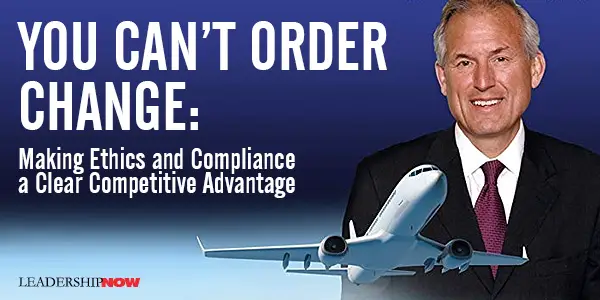
WHEN Jim McNerney became CEO of Boeing in 2005, change wasn’t an option. It was mandated. In 2005 Boeing was facing investigations into illegal business practices, there was the sex scandal, revenue was down, and key people were jumping ship. In short, it wasn’t the place to work. But even when everyone agrees that change is necessary – even vital – it doesn’t come easy. It still has to be approached in a careful and respectful way. You Can’t Order Change, by Peter Cohan, is about how McNerney brought about that change in Boeing. How he cleaned up the mess and changed the culture and revitalized the organization. Probably the biggest task that faced him was the quagmire created by years of costly ethical problems. He had to settle a lawsuit with the government and create a culture of ethics and compliance. This has to be done by example and system changes that encourage ethical behavior and compliance. He said in Boeing Frontiers, “I plan to make leadership development a focus across the company because I believe that as we strengthen our leadership capacities, we can have a positive impact on the company's overall performance. As I've said before, better leaders make better companies. And effective leadership, at all levels of an organization, is based on a foundation of trust, integrity, and escape-free compliance. As we turn up the gain in leadership-development training, we will embed in it an equal emphasis on how leaders can lead with ethics and integrity.” Cohan writes that McNerney made sure that ethics wasn’t a passing fad, but a value that had teeth in it. If the leaders of the organization “have not been behaving in a way that’s consistent with Boeing’s values, he expects them to change their behavior. And if they don’t meet McNerney’s expectations, they lose their leadership roles.” Step one for McNerney, of course, is getting the leaders to act ethically; to set the example. Cohan cites this statement from McNerney: We also realize it all starts with leadership. If an organization’s leaders don’t model, encourage, expect and reward the right behaviors, why should anyone else in that organization exhibit those behaviors? Companies have to take the hugely important step of driving ethics and compliance through their core leadership and Human Resources processes. This must be … and must be seen to be … a central part of the whole system of training and developing leaders and of the whole process of evaluating and promoting people. This is the key.” Critical also to this change is a system that supports and rewards people for getting results ethically and gets rid of people who don’t. Cohan writes, “McNerney let people know that he wanted them to discuss problems and not bury them.” If people didn’t talk about ethics and compliance, he would bring it up. “Ultimately, McNerney wants to avoid surprises about ethical problems that originate at lower levels. I know and you know … that one of the absolute perquisites for success in ethics and compliance is the belief that it is OK for people to question what happens around them.” McNerney’s methods and approach to change have gotten him dramatic results and they are worth studying. 
Posted by Michael McKinney at 01:35 PM
01.23.09

Step One: Reality Check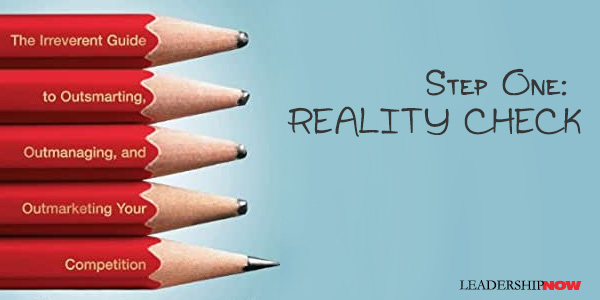 WE have written here that this is the season to rethink, explore, fine tune what works, discard what doesn’t and set a new course. Essentially what we need is a reality check. No longer can we skate by on surplus. Guy Kawasaki’s new book, Reality Check: The Irreverent Guide to Outsmarting, Outmanaging, and Outmarketing Your Competition, is a good place to begin.
WE have written here that this is the season to rethink, explore, fine tune what works, discard what doesn’t and set a new course. Essentially what we need is a reality check. No longer can we skate by on surplus. Guy Kawasaki’s new book, Reality Check: The Irreverent Guide to Outsmarting, Outmanaging, and Outmarketing Your Competition, is a good place to begin.
It would be unfortunate if the book’s heft – 474 pages – made it too intimidating to pick up because it’s full of great insights, clever thought, and often provocative ideas that will make you see things in a new way. I don’t recommend reading it from cover to cover. It’s not that kind of book. It’s more of a highly readable, reference tool that you’ll want to refer to again and again. Besides, unless you were born in this century, you’ll need some time to allow your brain to create some new circuitry. There aren’t any shortcuts given here. Often life and especially entrepreneurship is about grinding it out; sticking to what you believe in until it works. It’s not about sticking to your competition either. It’s about focusing on what you can do to add value to your customers and the world. Frank Sinatra famously said, “The best revenge is massive success.” What drives your competition crazy is your success. The 94 chapters are based on his highly regarded blog, How To Change the World. The topics cover everything from the start-up, maintaining, growing your business to communicating your message and surviving what comes your way. Some takeaways:
There’s more, but it would take 474 pages. Better get the book. 
Posted by Michael McKinney at 07:21 AM
01.19.09

Hitting Your Goals by Knowing What Matters“The trouble with an overload of information isn’t just that it’s confusing. It’s that the data have conflicting implications,” writes David Apgar in Relevance: Hitting Your Goals By Knowing What Matters. Today, data is cheap so we make more of it. But in generating more of it, we unwittingly complicate our decisions. The problem is in determining what is relevant.Two tests help to determine the usefulness of any piece of information. First, is its specificity “because you can draw more conclusions from precise outcomes rather than vague ones.” And secondly is its relevance. “Relevance has to do with how well a piece of information tests your expectations.” Apgar suggests that while we have become used to less relevant data we have developed two bad habits. “Instead of devising a specific strategy to meet a financial goal like a sales or profit target, we’re increasingly tempted to enumerate requirements for meeting the goal…. Requirements are not strategies. An unlike strategies, there’s little to learn when they fail to work.” And then there’s our growing reliance on red herrings. “Red herrings are results that appear to confirm your plans but in reality are merely consistent with them.” We end up chasing after the wrong thing. It leads to an unintended use of the balanced scorecard. “It’s too easy for organizations to fill out balanced scorecards with lists of obvious requirements for success that resemble ingredients in a cookbook. The trouble isn’t that the ingredients may be wrong; it’s that they run so little risk of being wrong. As a result, they end up saying very little.” The strategy should look more like a recipe than a list of ingredients. There is little chance of the ingredients being wrong. You can execute the ingredients, but the recipe is what needs to be tested. Apgar offers a quick and efficient way to get the indicators that test strategic assumptions and devising better performance strategies. He writes, “A leader must both promulgate polices clear enough to test and be ready to change them. Clarity and a critical attitude are great virtues when combined. Instead of avoiding leaders with simplistic or nuanced approached to the world, organizations and countries alike need leaders who alternate between them.”
Posted by Michael McKinney at 09:21 AM
01.09.09

The Accountable Leader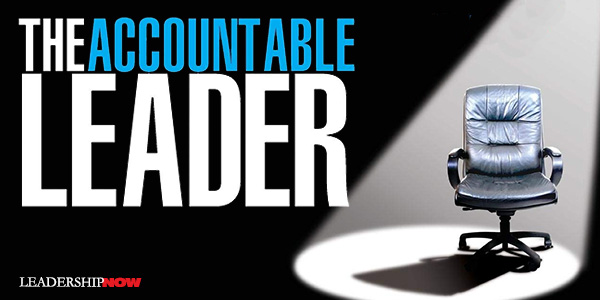
BRIAN DIVE tells us in The Accountable Leader that many organizations have difficulty developing leaders and fostering effective leadership because they have never considered the context they must lead in. The organization must be structured, Dive contends, so that all leadership roles from top to bottom have well-defined decision rights. In other words, accountability needs to be structured into the very fiber of the organizational architecture at all levels. Accountability, organizational design, and leadership are three inextricably linked factors. An organization is in flow, or in a state of equilibrium, when the required number of management layers (vertical architecture) matches the effective reach (or span of control) over the relevant resources that the organization needs in order to achieve its purpose. After briefly explaining the problem and the key concepts used in correcting it, he begins to present the practical application of his ideas for creating accountability within an organization. He addresses questions such as: How many layers of management are necessary? How do leadership requirements change at different levels? How can potential leaders be identified? How can they be developed? How should people be rewarded?Beyond the useful correctives to organization architecture and accountability, Dive also makes an important distinction between Managerial leadership (operational in nature) and Strategic leadership (changing the organization) for leadership development. Each requires different abilities and approaches in decision-making style and accountability. “Operational accountability is ensuring that existing assets and resources continue to perform better. The resources are given. Problem-solving remains related to actual events, rather than the abstract.” With Strategic accountability, “problem-solving moves into the abstract domain. Solutions have to be found that require mental modeling, as they do not yet physically exist.” On leadership development, Dive writes that “many organizations still confuse values, skills, and competencies” and “it is one of the main reasons why so many leadership development programs fail.” Here are several thoughts in this regard: Although values and skills, especially technical skills, play an important role in who should work in an organization, they are not reliable guides for the assessment of potential and who should be promoted. 
Posted by Michael McKinney at 09:01 AM
11.18.08

The Secrets of the Millennial Generation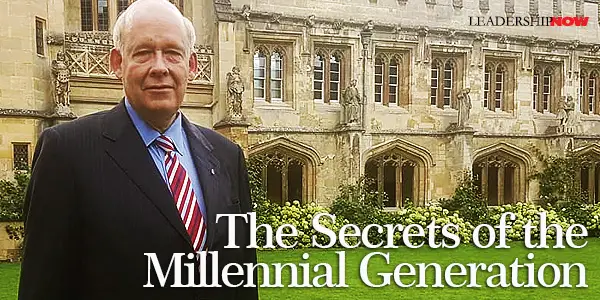
Talking Management is a weekly videocast that McGill University’s Karl Moore hosts for Canada’s Globe and Mail newspaper. Recently he recorded a presentation on how to manage and lead today’s youth. The Business Strategy Review, published by the London Business School, identified Moore among a group of world’s greatest business thinkers. In this 20 minute video, he provides not only some practical ideas but an understanding of the context that produced the Millennial generation. Here are some excerpts: The job of the manager is not to have the ideas but to support them. That is saying that innovation comes from everywhere, not just from the center, not just from the top of the pyramid, not just from the old people, it comes from throughout the organization. This fits with the business need. A manager, a leader must now spend more time listening and looking for others' ideas and empowering them than in merely trying to be the great strategist. We have heard this for a while but I think that it seems more compelling today than in the past. It is just more true. It used to be that global firms would have a head office in a country and that is where ideas would come from but probably the main advantage of being a global multinational organization is that you are getting ideas and innovation from all over the World rather than from one place.You can also read a transcript of the video on the Globe and Mail web site.
Posted by Michael McKinney at 12:32 PM
11.14.08

Hiring the Right Skill Set and Motivating the Millennials
IN RAISING and schooling our children in the U.S., it appears we have dropped our standards. And it shows. Finding the right people is becoming a more and more difficult proposition. (I enjoyed reading about Linda Zdanowicz's search for a dental assistant on her blog.) Tony Wagner, author of the The Global Achievement Gap has written an important book that should not be ignored by business leaders. It sets a meaningful agenda for a good dialogue between educators and business leaders and concerned parents about our educational system. Wagner has written the following for us: In an economic downturn, employers need to be even more careful with their hiring decisions. And recent graduates from some of the best schools may not have the skills that matter most in the new global knowledge economy. In researching my book, The Global Achievement Gap: Why Even Our Best Schools Don’t Teach The New Survival Skills Our Children Need -- and What We Can Do About It, I have come to understand that there are "7 Survival Skills" for the New World of Work, and that employers must look beyond applicants' "pedigrees" to carefully assess whether they have the skills that matter most. New Skills Here are the Seven Survival Skills, as described by some of the people whom I interviewed: • Critical Thinking and Problem Solving "The idea that a company's senior leaders have all the answers and can solve problems by themselves has gone completely by the wayside . . . The person who's close to the work has to have strong analytic skills. You have to be rigorous: test your assumptions, don't take things at face value, don't go in with preconceived ideas that you're trying to prove." —Ellen Kumata, consultant to Fortune 200 companies
• Collaboration Across Networks and Leading by Influence "The biggest problem we have in the company as a whole is finding people capable of exerting leadership across the board . . . Our mantra is that you lead by influence, rather than authority." —Mark Chandler, Senior Vice President and General Counsel at Cisco
• Agility and Adaptability "I've been here four years, and we've done fundamental reorganization every year because of changes in the business . . . I can guarantee the job I hire someone to do will change or may not exist in the future, so this is why adaptability and learning skills are more important than technical skills." —Clay Parker, President of Chemical Management Division of BOC Edwards
• Initiative and Entrepreneurship "For our production and crafts staff, the hourly workers, we need self-directed people . . . who can find creative solutions to some very tough, challenging problems." —Mark Maddox, Human Resources Manager at Unilever Foods North America
• Effective Oral and Written Communication "The biggest skill people are missing is the ability to communicate: both written and oral presentations. It's a huge problem for us." —Annmarie Neal, Vice President for Talent Management at Cisco Systems
• Accessing and Analyzing Information "There is so much information available that it is almost too much, and if people aren't prepared to process the information effectively, it almost freezes them in their steps." —Mike Summers, Vice President for Global Talent Management at Dell
• Curiosity and Imagination "Our old idea is that work is defined by employers and that employees have to do whatever the employer wants . . . but actually, you would like him to come up with an interpretation that you like -- he's adding something personal -- a creative element." —Michael Jung, Senior Consultant at McKinsey and Company
Looking Beyond the Degree The conventional thinking of many who make hiring decisions is that graduates from "name-brand" colleges are likely to be more intelligent and better prepared than students who have gone to second or third tier schools. But, in reality, what the degree may mean is that these students are better at taking tests and figuring out what the professor wants -- skills that won't get them very far in the workplace today. A senior associate from a major consulting firm told me that recent hires from Ivy League business schools were constantly asking what the right answer was -- in order words, how to get an "A" for the job they were doing -- and were not always very adept at asking the right questions, which was the single most important skill senior executives whom I interviewed identified. So what does this mean for the interview process? First, listen carefully for the kinds of questions the applicant asks. Are they probing? Insightful? Do they suggest that the applicant has really prepared for the interview by trying to understand your business? Do you feel as though you or your company are being interviewed? If so, that's a very good sign. How a prospective employee asks these questions matters, as well. Does he or she listen carefully and engage you in discussions? Is the potential new hire both interested and interesting? In addition to the ability to ask good questions, senior execs told me that the ability to "look someone in the eye and engage in a thoughtful discussion" is an essential competency for working with colleagues and understanding customers' needs. Finally, perhaps the most important question you might ask is, "what do you want to learn or how do you want to grow in this job?" This question is essential for two reasons: First, the quality of the answer will tell you how reflective this individual is -- and how intentional he or she may about his or her own development. More than any specific skill, individuals must want to learn, grow, and improve continuously to be successful in today's workplace. Motivating the Millennials The second reason why this question is important goes to the heart of the problem of how to motivate new hires to do their best. In asking the question, "how do you want to grow," you are signaling to a prospective employee that you and your company are committed to developing the talents of your workers. Many employers worry that this generation lacks a work ethic. But in my research, I have discovered that this generation is not unmotivated but rather differently motivated to learn and to work. Above all else, they want opportunities to be challenged and to make a difference. Describing the different work ethic of this generation, Ellen Kumata, who is a managing partner at Cambria Associates and consults to senior executives at Fortune 200 companies, told me, "They don't see coming into a company as being a career experience. They don't want to climb the corporate ladder and make more money and please the boss. And so you can't manage them the same way -- you can't just put them into a cubicle and expect them to perform." Tracy Mitrano, who manages the Office of Information Technologies at Cornell University, agreed: "You have to make the work more interesting and allow them to work in different ways. They are prepared to work just as much and just as hard -- but not at a desk 8 hours a day." Andrew Bruck was finishing a law degree at Stanford when I interviewed him last year. "We want to feel ownership. We have a craving for an opportunity to do something really important," he told me. "People in my generation have been in a constant state of training. Now they're excited to go do something. The more responsibility you give people, the better they produce . . . There are more and more recent law school grads who are willing to take a lower salary in return for an opportunity for more meaningful work." Ben McNeely, a journalist, described to me the difference between his former employer and his current one. "At the paper where I worked previously, the publisher would kill stories if they portrayed an advertiser in a negative light. At the paper where I work now, I have an opportunity to contribute something in a growing community. I was brought in to cover the new bio-tech research campus under construction nearby, where the Canon towel factory used to be, and to cover health care issues, as well. I have support from the editor and publisher who both have strong journalistic ethics. I like it that the editor pushes Windham, who us to dig deeper." Carie Windham, who graduated from college in 2005, told me about the best boss she's ever had. "He asked me where I want to be in 10 years. He talked to me about creating the experience I want to have. He understood I wouldn't be there forever . . . Mentoring is a huge motivational tool, someone showing an interest in you and giving you feedback. We want to feel we have a creative, individual role -- that we're not just working on an assembly line. We want to feel like we have ownership of an idea." Hiring the right talent, then, is only part of the problem employers face today. Equally important is how businesses create challenges and learning opportunities that motivate the Millennials to do their best. Google, which had more than one million applications for 5,000 jobs in 2006, is the number one pick of a place to work for many of the Millennials. Listening to twenty-two-year-old Matt Kulick talk about his work, one begins to understand how profoundly many companies will have to change in order to attract and retain the best talent: "First, they (Google) share ideals that I believe in—open source software. And their products are solving important problems for people—doing good in the world. I believe in what they're doing—these values are very important to me. I wanted to help out, to make a contribution. The second reason I came to Google is because they give me the resources I need to accomplish major things that will really make a difference in the world. The third reason is the responsibility they give you from the day you start. It is a winning combination. It makes me happy to go to work every day."  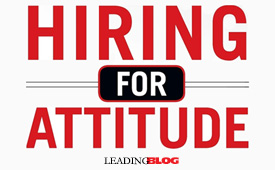 
Posted by Michael McKinney at 06:07 AM
11.10.08

Not All Recognition Is EqualThe Wisdom of the Flying Pig It is the great merit of Hayhow to remind readers of timeless principles for building relationships and getting work done through people. He reminds us, “No one responds well to manipulation—no matter how cleverly or skillfully the manipulation is done.” The first principle of effective recognition: Provide recognition in an honest and authentic way.What are you doing to find what's right in people?
Posted by Michael McKinney at 08:25 AM
08.22.08

What Do You Mean “Urgent Patience”?
 Behaving urgently does not mean constantly running around. Screaming “Faster-faster,” creating too much stress for others, and then becoming frustrated when no one else completes every goal tomorrow. That is false urgency. People who understand the basics—a faster-moving world, the need for more urgency—fall into the false-urgency trap far too often. 
Posted by Michael McKinney at 08:38 AM
08.12.08

Are You Having a No-Good, Very-Bad Day?
IF YOU are like most of us, anything going on but what you want, warrants a complaint. Not an action-oriented, let’s get this solved kind of complaint, but your everyday run-of-the-mill mindless kind of complaining that leads nowhere (except to more negative thinking). Jon Gordon, author of The No Complaining Rule, says there are two main reasons why we complain: (1) because we are fearful and feel helpless and two, because it has become a habit. He urges us to outgrow the complaining habit. He cites a Gallup poll that finds that negativity costs companies nearly $300 billion each year. “In life,” Gordon writes, “you have a choice between two roads. The positive road and the negative road. The positive road will lead to enhanced health, happiness, and success and the negative road will lead to misery, anger, and failure. Since your bus can’t be on two roads at the same time, you must decide which road you want to be on. And when you complain you travel down the negative road.” “In life,” Gordon writes, “you have a choice between two roads. The positive road and the negative road. The positive road will lead to enhanced health, happiness, and success and the negative road will lead to misery, anger, and failure. Since your bus can’t be on two roads at the same time, you must decide which road you want to be on. And when you complain you travel down the negative road.” As former chronic complainer, Gordon effectively delivers his message through a story. The No Complaining Rule doesn’t rule out complaining – it requires that it be constructive. Employees are not allowed to mindlessly complain to their coworkers. If they have a problem or complaint about their job, their company, their customer, or anything else, they are encouraged to bring the issue to their manager or someone who is in a position to address the complaint. However, the employees must share one or two possible solutions to their complaint as well.Gordon explains how do develop a positive culture by creating a culture where negativity can’t breed, grow, and survive. A crucial key is to all this is to focus on gratitude. “Research shows that when we count three blessings a day, we get a measurable boost in happiness that uplifts and energizes us. It’s also physiologically impossible to be stressed and thankful at the same time. Two thoughts cannot occupy our minds at the same time. If you are focusing on gratitude, you can’t be negative. You can also energize and engage your coworkers by letting them know you are grateful for them and their work.” Start a revolution in your own life, at work, and at home. Download free No Complaining Rule posters and other tools from Jon Gordon’s web site. Have no complaining day! 
Posted by Michael McKinney at 09:22 PM
07.09.08

Focus Like a Laser BeamWe all know that when we focus on something we leverage our efforts. Success Magazine founder Orison Swett Marden, wrote, “Every great man has become great, every successful man has succeeded, in proportion as he has confined his powers to one particular channel.” But focusing, determining exactly what to focus on, and focusing on our strengths to make a tangible contribution, isn’t as easy as it sounds. Simplifying your life by eliminating as many of those things that take an inordinate amount of time and don’t contribute substantially to your goals is sometimes a very difficult thing to do. Yet it is important to keep in mind that habits drive most of what we do, the ways we react and respond and so we need to constantly review what we are spending our time doing.In her very practical book, Focus Like a Laser Beam, Lisa Haneberg writes, “Leaders need to know what laser focus looks and feels like. The first and most obvious sign of focus is that everyone knows what’s important.” To do this, people need to know what’s relevant. “When you define success, you define relevance.” She offers four questions to apply when trying to define relevance:
Lisa maintains a blog about the craft of management and leadership called Management Craft.
Posted by Michael McKinney at 10:32 AM
06.13.08

How to Survive the First 100 Days As the New BossThe New Boss: How to Survive the First 100 Days by Peter Fischer is a practical how-to guide to help leaders avoid typical mistakes and pitfalls and provides a proven framework and systematic approach to managing leadership transitions. While not all of the material is new, it is a welcome and fresh perspective and contains relevant examples of dos and don’ts of successful leadership transitions. Fischer’s process is well thought out and easily adapted to your new role.The chart below gives a brief overview of the issues addressed here.
Fischer also cites John Gabarro’s work (The Dynamics of Taking Charge / HBSP / 1987) in this area. Gabarro notes that a crucial factor distinguishing successful from less successful leaders in a new positions was the relationship to key people. In his studies, 75% who were not successful in their new roles after 12 months had poor working relations with their key employees. They had conflicts over objectives, leadership style, and the criteria of effective performance. I mention this in particular as this seems to me to be the most common reason new leaders are asked to move along before they really get anything done. The temptation is to go in “full boor” and show them what you know. After all that’s why they hired you. Right? But if you can’t get along and gain the trust and cooperation from the people and culture you are moving into, your competence won’t matter. Focus on the people first. Also check out: The First 90 Days: Critical Success Strategies for New Leaders at All Levels by Michael Watkins
Posted by Michael McKinney at 08:55 AM
05.21.08

Imagine Time Is a House With Four RoomsDondi Scumaci relates the following analogy on time management in her book Designed For Success:Imagine time is a house with four rooms, and all of your activities, tasks, and commitments must be placed into one of them. Each room has a name, and the name is really a goal. The first room is called Maximize. Here you will place all of the things that make you better – the actions you can take to be more prepared, informed, knowledgeable, effective, and valuable. The goal is to spend more time in this room. Into the second room you will gather the things that cause you to react. These are situations and circumstances that throw you into the frenzy of crisis mode. Call this room Minimize, because you want to reduce the amount of time you spend here. Stress also lives in this room. Incidentally, when you spend more time in the first room, you end up here less often. Next is the room for everything that steals your time. You’ll recognize the activities that belong in here because they don’t add anything. They just take. This is where gossip, perfectionism, negativity, blame storming, fear, and worry live. This room is called Eliminate. If you pay close attention, you’ll be surprised how often you go into this room and how much time you actually spend here. The last room is called Manage. It’s a place for meetings, interruptions, and communications. This is where conference calls, voice mail, e-mail, and “do you have a minute?” live. Some of these are essential and some, quite frankly are not. You must learn to tell the difference so you can out them in the rooms where they really belong. Quite often this is the most cramped room in the house, and you may find yourself climbing over things to search for what is lost in the chaos. 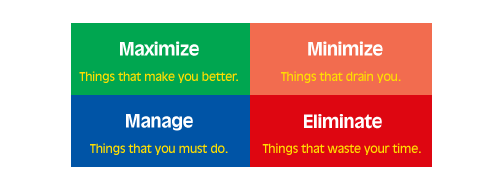 With your first assessment, you are likely to find some activities living in the wrong room, and you may discover the room called Maximize is nearly empty. This goal is to take inventory, put things in the proper place, and spend your time where you will realize the greatest return.
Posted by Michael McKinney at 08:46 AM
03.19.08

The Lack of Connection Burns Us OutMichael Stallard's Fired Up or Burned Out, is a book that is worth returning to again and again. He writes that “connection meets basic human psychological needs for respect, recognition, belonging, autonomy, personal growth, and meaning. When these needs are met we thrive…. Conversely, the lack of connection will gradually burn us out.”As leaders our lives touch more people than we can imagine. It is here that we are either making connections with others or we are not. We are either contributing to engagement or burn out. Stallard believes that after we delete the things that devalue others like inappropriate criticism, micro-managing and allowing others who do to continue to do so, we need to dial up the value in at least six important ways:
Stallard writes, “Unless the people in an organization have a strong sense of connection—a bond that promotes trust, cooperation, and spirit de corps—they will never reach their potential as individuals, and the organization will never reach its potential.” Of Related Interest:
Posted by Michael McKinney at 11:17 PM
03.04.08

Five Tips from Atsutoshi Nishida on Overcoming a Crisis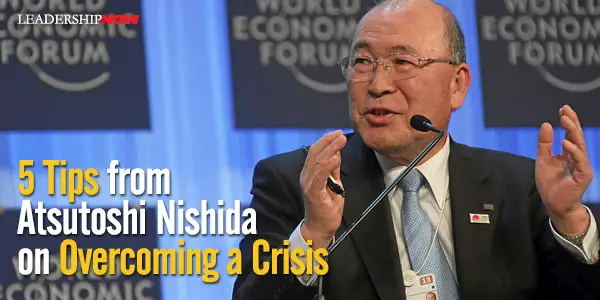
THE Wall Street Journal interviewed Toshiba Chief Executive Atsutoshi Nishida who recently pulled the plug on the company's HD DVD business. From that interview came the following wisdom regarding crisis leadership in particular but good ideas to keep in mind regarding the daily crises we often face in the minutia of our day.
That fifth step is important to keep in mind as it helps you keep things moving forward rather than getting bogged down in your current situation. Things change. Most things are cyclical. He explained the balance between practicality and enthusiasm in decision making. I don't operate just on logic. I'm practical, but I also have enthusiasm, which is the side of me that's not practical. If you have that in addition to a strong will to achieve your goals, then you can overcome any adversity. For example, I used logic to rationally make the decision to quit HD DVD, but my enthusiasm allows me to move forward. Enthusiasm too helps us to reframe our problems in a way that is constructive. This is not naïve optimism, but an informed optimism that reflects the reality of the situation.
Posted by Michael McKinney at 01:10 PM
02.25.08

Miles’ Law and Six Other Maxims of Management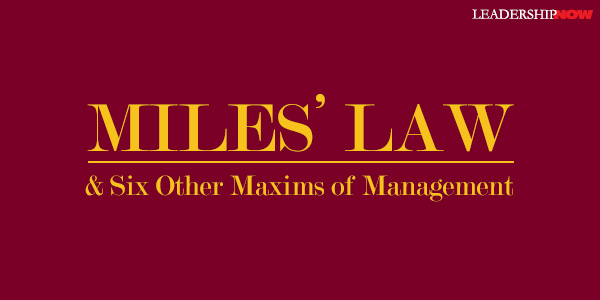
Rufus E. Miles, Jr. (1910-1996) was an assistant secretary under Presidents Dwight D. Eisenhower, John F. Kennedy and Lyndon B. Johnson and six H.E.W. secretaries. He developed from “memorable encounters with reality,” Miles’ Law and Six Other Maxims of Management. The law states: Where you stand depends on where you sit. He codified that which we should know intuitively. We see things and form judgments of things from our own perspective. We need to discipline ourselves to see things from other’s vantage point. To his law, he added six maxims: • Maxim 1: The responsibility of every manager exceeds his authority, and if he tries to increase his authority to equal his responsibility, he is likely to diminish both. • Maxim 2: Managers at any level think they can make better decisions than either their superiors or their subordinates; most managers, therefore, seek maximum delegations from their superiors and make minimum delegations to their subordinates. • Maxim 3: Serving more than one master is neither improper nor unusually difficult if the servant can get a prompt resolution when the masters disagree. • Maxim 4: Since managers are usually better talkers than listeners, subordinates need courage and tenacity to make their bosses hear what they do not want to hear. • Maxim 5: Being two-faced—one face for superiors and one for subordinates—is not a vice but a virtue for a program manager if he or she presents his or her two faces open and candidly. • Maxim 6: Dissatisfaction with services tends to rise rapidly when the provider of the services becomes bureaucratically bigger, more remote, and less flexible, even if costs are somewhat lower. These laws were originally published in September 1978. "The Origin and Meaning of Miles' Law," Public Administration Review, September – October 1978. Miles wrote that the “concept is probably as old as Plato, but this particular phraseology arose in the Bureau of the Budget as a result of events that occurred in late 1948 and early 1949.”
Posted by Michael McKinney at 07:22 AM
02.11.08

Insultants Wanted WE need people who will tell us like it is in the right way. Often we don’t like to hear what they have to say but we should never discourage them. Frequently, leaders are the last to know. Keith McFarland author of The Breakthrough Company, calls these straight-shooters insultants (inside consultants). He describes them as those people “willing to ask the tough questions that cause a company to think critically about its fundamental assumptions. The value of insultants is that they will go to great lengths to get their companies to reevaluate a position or adapt to a changing environment.”
WE need people who will tell us like it is in the right way. Often we don’t like to hear what they have to say but we should never discourage them. Frequently, leaders are the last to know. Keith McFarland author of The Breakthrough Company, calls these straight-shooters insultants (inside consultants). He describes them as those people “willing to ask the tough questions that cause a company to think critically about its fundamental assumptions. The value of insultants is that they will go to great lengths to get their companies to reevaluate a position or adapt to a changing environment.”
If you think that you welcome these people, think again. A survey showed that while 90 percent of CEOs believed that their companies regularly implemented ideas that the CEO initially didn’t like, only 60 percent of their direct reports agreed. McFarland reports that people tend to differ to authority and rank because they feel that they must know better. “But often authority figures are wrong, and if an organization doesn’t have a strong insultant culture, errors are likely to be propagated throughout the company.” If you feel you are an insultant, don't think you begin by charging in like a bull in a china shop. There is a right way and a wrong way to do things. You are trying to make the leader successful, not trying to show how smart you are or place the spotlight on yourself. Good insultants must learn to excel at relationships based on genuine care for others. McFarland offers these tips that one would do well to heed:
As a leader, you gain nothing by not knowing what people are thinking. People with ideas and challenges to your way of doing things are not necessarily being insubordinate. They are practicing leadership. Leaders can encourage a candid environment be celebrating productive failure, involving people enough in the issues that they can make intelligent contributions, focusing on both employees and customers that have left the company, and using humor to encourage frankness and trust. 
Posted by Michael McKinney at 01:47 PM
01.21.08

You Attract the People Your System InvitesIt’s no secret that healthy environments attract healthy people. Healthy people leave environments that are not or more often than not, get pulled down by them. Yet, it is something we tend to forget. When we find a system or environment that is wrong, there is something wrong at the top. It is from there that the change must come if something is out of kilter.Harvard Business Review published an interview this month with Lazard CEO, Bruce Wasserstein. In Giving Great Advice, authors Thomas Stewart and Gardiner Morse relate his comments regarding attracting and developing good talent. We have to want to attract a network of stars—people who communicate and cooperate but are entrepreneurial and stand out as quality individuals, who are not the cogs in a corporate machine. Quality people must be managed with customized approaches. The idea is to create a hothouse where young talent is nourished by our culture and people are encouraged to think creatively, think deeply, think about the long-term client relationship—but above all, think. I want them to reflect on what they are doing and why, and then wonder, “Can we do better?”
Posted by Michael McKinney at 09:12 AM
12.17.07

Applied AwarenessIn one of this year’s outstanding leadership books, Apples Are Square, authors Susan and Thomas Kuczmarski interviewed Lambert & Associates vice-president of Client Affairs Brian Sorge about seeing what isn’t there.“Understanding others involves not only paying attention to what they say, but also when they don’t say anything at all,” Sorge believes. “I have always been very emotionally intuitive and that is not easy. I think what happens is that you tend to take on people’s fear and struggles. It allows for tremendous empathy, but also tremendous stress. I remember during speech class in seventh grade, some of the kids would go up there and be so nervous, and I would get tears in my eyes because I could feel their nervousness. I loved getting up and talking to people and giving a speech and I had no problem with it, but I would feel their pain profoundly.” The authors write, “Good leaders take on the problems of the team. They sense difficulties and out themselves not only in the minds, but also the hearts of those around them. This empathy allows them to develop meaningful solutions that impact people on a personal level.” Sorge adds the most important component to all of this: “So many people lack what I call applied awareness. You can give me all the awareness in the world, but you also have to be able to translate that into behavior. In corporate America, it is okay to talk about behavior, but difficult to get beyond talking. That level is not deep enough to make an impact. It allows people to feel like they are changing when they really are not. It is very superficial.”
Posted by Michael McKinney at 10:16 AM
12.05.07

James Kilts on Developing People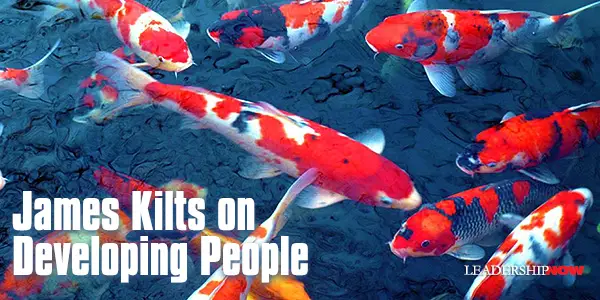
IN Doing What Matters, James Kilts, former chairman and CEO of Gillette Company, shares a story about developing people: One of the most important responsibilities of a leader is to create the right environment and then give the employees development opportunities that enable them to realize their full potential. I like to use an analogy that I heard some years ago of the Japanese carp, known as the koi, to make the point. 11.23.07

Why Leaders Don’t ComplimentIn Results that Last, Quint Studer lists six myths and excuses as to why too many leaders resist giving people much needed compliments.
Charles M. Schwab (1862-1939), founder of the Bethlehem Steel Company, said, “I have yet to find the person, however great or exalted his station, who did not do better work and put forth greater effort under a spirit of approval than he would ever do under a spirit of criticism.” In the often cited study by Gerald Graham, Ph.D. of Wichita State University, it found that employees consider personal, immediate recognition by their managers to be one of the most powerful workplace motivators. However, 58 percent of the respondents said their manager rarely, if ever, offered such simple praise. Graham concluded, “It appears that the techniques that have the greatest motivational impact are practiced the least, even though they are easier and less expensive to use.” Who should you be thanking?
Posted by Michael McKinney at 09:41 AM
11.14.07

Optimizing LuckIn a world of rapidly changing conditions, luck often seems to be the determining factor in the success of the best organizations. According to authors Thomas Meylan and Terry Teays, luck is something that can be optimized and built into your culture. While the chapter on leadership could have benefited from some more rigorous thought, they do outline six behaviors and procedures you can implement to amplify your natural abilities to succeed in any environment. First, and most importantly, they stress the importance of hiring the right people. Look for people with sufficient skills and experience to do the job, aptitudes that will contribute positively to the organization and people with a passion for the kind of work you are hiring them for. (Seek staff reaction to the new person.) “If you don’t have the time to work through a hiring process that gets you the right people, how are you possibly going to have time to deal with all the misfits you end up with?” Secondly, multiply your strengths through the power of delegation – or just let people do their job. If you have hired the right people with the right skill set, then you should be able to trust them to accomplish the task. “Without trust, delegation doesn’t happen. What you get instead is the making of assignments that you either micromanage or snatch back to do yourself.” Third, become adaptable through the “master process of continuous habit management.” This consists of being alert to changes, continuously trying new things until you get the results you want, converting successful behaviors into personal habits and organizational procedures, and discarding obsolete habits when you realize it’s time to create new ones. Fourth, know how to operate in a lean environment before it is forced upon you. “If you have hired self-renewing employees, and you have given them the opportunity and resources to learn new skills, then they are well prepared to adapt to changes in your enterprise’s needs….Don’t think in terms of malnourished drudges. Think of slender gymnasts, flexible and agile and capable of an entire repertoire of tricks.” Fifth, promote prompt and accessible communication to all who need it. Knowledge is the raw material you use to drive a business, it must reach everyone, whether it is good or bad news. “Without good communication habits, your organization may be too slow to take advantage of a surprise opportunity and end up not getting there first.” Finally, build a system for recognizing and rewarding people that perform beyond their job description. “Your method of rewarding employees should encourage the behavior you want your employees to show.” The key passage is this: Differences in levels of success often come down to differences in personal habits. People employ decades-old systems of habits to get through the day. However, most people put no special thought into developing these systems. They pick up a few tricks from mom and dad and a few teachers and a lot from their peers, while growing up and going through school. And that’s where their habit-developing effort stops.
Posted by Michael McKinney at 12:10 AM
11.12.07

Finding the Difference Makers in Your Organization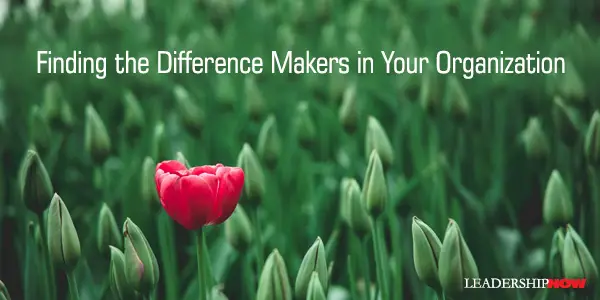
STORIES about people who have gone above and beyond inspire us to be better than we are now. These stories of people who make a difference can help others to see themselves and their work in new ways. Stories help people to disconnect from the moment and project themselves in to a new place where things are possible. Quint Studer writes in Results that Last, “I think difference makers are the world’s real heroes, the people working to make things better. You know who they are: those men and women who give extra effort without thinking of themselves. They may not get a lot of glory, but they are deeply appreciated by the people whose lives they touch.”He suggests that we make a conscious effort to look for and collect the stories of those people that go above and beyond and know when to break the rules in order to make a difference. Then retell them over and over to make them a part of the organization’s culture. The stories should have a behavior-oriented point and help people to connect their situation to that of the heroes in the story. “Finding your heroes and recognizing their behavior is key because recognized and rewarded behavior is repeated.” Here are several ways he suggests we go about finding heroes in our organizations:

Posted by Michael McKinney at 10:43 AM
11.05.07

The Art of Winning Others Over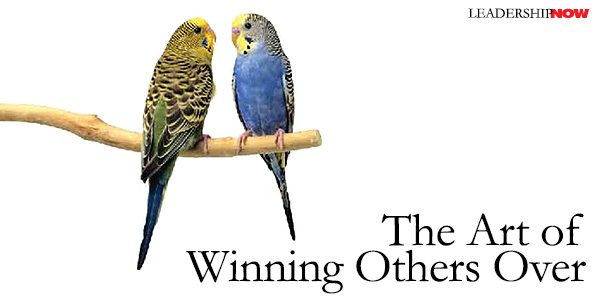
If there is any secret of success, it lies in the ability to get the other person’s point of view and see things from that person’s angle as well as your own. IN The Art of Woo or "Winning Others Over," authors Richard Shell and Mario Moussa, make the case that wooing is one of the most important skills in a manager's repertoire. Research would seem to support this claim as people with strong social skills have been shown to command higher fees and salaries than equally talented but less socially adept colleagues. And they are no doubt more pleasant to be around. Winning others over is an art. It is the ability to sell “your ideas to people within the context of ongoing, important relationships.” They maintain, “If you want to be a player in your organization, a successful partner with your customers or suppliers, a leader in your community, or even a good parent, you need to woo people to your point of view by putting your ideas across in convincing, relationship-friendly ways.” To that end, they remind us that the idea in persuasion is not to defeat the other person but to win them over. The place to begin is in understanding your own persuasion style. They have identified five types—The Driver, The Promoter, The commander, The Chess Player, and The Advocate—and have included a Persuasion Style Assessment to get you started. Whatever your preferred style tends to be, the idea is to strike a balance between what the authors identify as the "self-oriented" perspective-where focus is on the persuader's credibility, and point-of-view and the "other-oriented" perspective, which focuses on the audience's needs, perceptions, and feelings. They have created a systematic strategy or Woo Process, to aid you in skillfully getting your point across. In brief, they are: Step 1: Survey Your Situation, that is
They note that authority plays a background role in most interactions and while it can be useful in some situations, it should not be relied upon especially where there are multiple stakeholders. They say, “The formal roles people occupy are the starting positions for a complex dance of organizational influence.” They also note that actually, the higher up you go in an organization, the less authority comes into play and the more important relationship and persuasion skills become. 
Posted by Michael McKinney at 09:03 AM
09.03.07

Why Aren’t We Learning?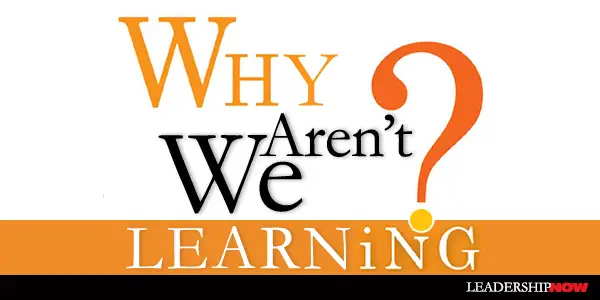 JEFFREY PFEFFER observes in What Were They Thinking? that while “learning organization” and “continuous improvement” have become cliché, few companies actually do those things that need to be done to make them smarter. He writes, “That’s because some of the things they need to do to learn are counterintuitive.” And we might add, are frowned upon socially. We would rather say, “We rarely (never) make mistakes,” instead of “We make mistakes, but we’re learning.” The latter just doesn’t have that ring to it. Culturally, mistakes have no glamour to them. To be free of them is everything. We are attracted to the person who seems to be on top of it all. The fact is, we all make mistakes. But are we learning?
JEFFREY PFEFFER observes in What Were They Thinking? that while “learning organization” and “continuous improvement” have become cliché, few companies actually do those things that need to be done to make them smarter. He writes, “That’s because some of the things they need to do to learn are counterintuitive.” And we might add, are frowned upon socially. We would rather say, “We rarely (never) make mistakes,” instead of “We make mistakes, but we’re learning.” The latter just doesn’t have that ring to it. Culturally, mistakes have no glamour to them. To be free of them is everything. We are attracted to the person who seems to be on top of it all. The fact is, we all make mistakes. But are we learning?
It may seem counterintuitive, but the most successful people are making many if not more mistakes than most people. The difference is that they don’t try to cover them up. They acknowledge them, learn from them and move on. At IDEO, they believe that it’s better to make many smaller mistakes than one big one. Pfeffer writes, “But that ethos requires accepting that novelty and innovation are invariably accompanied by setbacks and failures. And embracing such a way of operating requires letting people fail—maybe even encouraging them to fail. After all, if nothing ever goes wrong, it must be because the capabilities of the system and its people have not been truly tested.” This applies on a personal level as well. Are you testing your capabilities? Pfeffer proposes that organizational learning requires three things: 1. A clear understanding of reoccurring problems. “If the root causes of problems are not discovered and remedied, the problems will almost certainly recur . . . . Organizational learning thus requires people to direct others’ attention to problems so they can be noticed, diagnosed, and fundamentally fixed once and for all.” 2. The willingness to allocate resources to address the root causes of those problems. Research on health care organizations “found that those that learned best generally had a higher proportion of managers. . . . They were helping their employees learn, moving information across organizational boundaries, and essentially scanning the environment for common trends and themes, and then bringing that information to their people, who could collectively use it to enhance performance.” 3. Cultural values that foster learning—which means “encouraging employees to find, fix, and report mistakes rather than heroically patch things up.” Fundamental to this issue, is that we—businesses, churches, families, friendships—all too often punish (exclude, at least frown upon) those making mistakes and reward (promote, speak well of, hang-out with) those who don’t seem to be making any. Who would dare try to learn in that environment? Who would ask for help? 
Posted by Michael McKinney at 10:54 AM
07.26.07

The Consultant’s Tightrope: Knowledge-Innovators vs. Knowledge-BrokersThe British Economic and Social Research Council released a study led by Professor Andrew Sturdy, of Warwick Business School at the University of Warwick in the UK on The Evolution of Business Knowledge. Contrary to popular belief, the study concluded that, “management consultants are, like their immediate clients, more 'knowledge brokers' than innovators. Both groups are often more concerned with managing projects and getting the job done.” "Typically, they are seen as outsiders, bringing ideas and organizational techniques which are new to their clients. But in reality, we found that prospective clients were unlikely to welcome consultants if their knowledge was 'too new'." Perhaps this isn’t too surprising since consultants are themselves operating a business and must please the client as well. Sturdy explains: “the study findings suggest that consultants walk a tightrope between offering what might be seen as either a ‘helpful’ challenge or an unconstructive interference. So whilst clients were generally happy to be challenged, this was only if the consultant did so sensitively, showing a good understanding of the business. “Consultants also needed to earn the respect of staff at all levels in the organization - something best achieved by demonstrating intelligence, commitment and willingness to engage with its problems, and respecting the knowledge of its employees. Professor Sturdy said: "The real outsiders then, are those people not directly involved in the project team, often including the most senior management and the rest of the client organization. "This is important, as it means that consultants are not as innovative or different as is often thought. But this can help in their role as knowledge-brokers. The main barriers then become the initial selling process, and later the implementation; typically still the preserve of managers more than consultants."
Posted by Michael McKinney at 02:02 PM
07.10.07

Six Disciplines for Excellence: Decide What's ImportantNow in its new and improved second edition, Six Disciplines for Excellence by Gary Harpst is still one of the best field guides to business. It lays out a practical methodology to help you stay aligned with your mission using sound foundational principles. Through a series of repeatable annual, quarterly, weekly and daily cycles, this methodology will help you to successfully guide your business and quite frankly, your personal life as well. Not surprisingly, you will find that these disciplines are applicable to your personal life, because we are all subject to some of the same pressures that are present in any other system.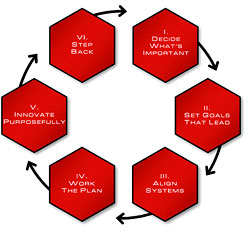 I find that the most vital principle presented here begins with step one: Decide What's Important. Its importance is underscored in the fact that it is woven throughout the process and culminates in step six. The practice of repeatedly stepping back and asking how did we get here? and why are we doing what we are doing? is vital to sustaining any system. While this is probably one of the most intellectually understood behaviors, it is in practical terms, likely the most overlooked discipline he presents here. It is overlooked because the pressures of the present lead us into directions and practices that we never intended and are often counter-productive. So we put it off, intending to address it later. Unfortunately, later rarely comes and the inconsistencies we create only breed more inconsistencies. Unnecessary actions and behaviors hang on long after their usefulness is gone. In business and life, we need to continually step back and reconsider what we are doing. Sometimes life happens – things happen we can’t plan on - and in the swirl of it all, we find ourselves doing that which we otherwise would not. His methodology helps to you to become more proactive and eliminate the tangents that distract you from what you should be doing. Harpst writes: Businesses are “systems” and they’re subject to forces similar to entropy. Once a small business makes plans, the chaos of everything changing around it gradually erodes those plans, like the warm water melts the ice. An organization must have a systematic and ongoing way to offset those forces, or it will eventually become ineffective to the point that its survival will be at stake. Or, using a different analogy, Stephen Covey once said, “We are too busy driving to get gas.”
Posted by Michael McKinney at 08:49 AM
07.06.07

JFK’s Leadership Style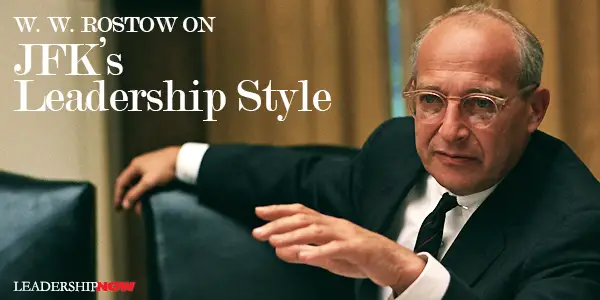
AS WE HAVE discussed before, the idea of the great leader as sole player is flawed. The point leader can’t do it alone. It takes many leaders to support the point leader. John F. Kennedy is said to have wondered how a man could conceive of seeking the job of the president when the problems were obviously bigger than mortal man should have to handle. It can only be done through people in an environment where they can do their best. Good relationships are vital to the success of any leader.  The late W. W. Rostow served as Deputy National Security Advisor to Kennedy. His observations of Kennedy’s leadership style are instructive: It did not fit the hierarchical pyramids to be found in textbooks on administration: it was like the spokes of a wheel. When he formed a bond it remained firm. His enormous energy permitted him to deal with a great many people on a bilateral basis, weaving their efforts into his tasks as he saw them. His method was that of the extended family. He put each member to work in ways that could help, according to his talents.Kennedy was able to create an environment without too many layers that fostered more open communication. At the same time, this requires thoroughness on the part of the leader so as to be certain that each task is covered by a capable person, while coordinating and leading in a way that doesn’t become dictatorial.
Posted by Michael McKinney at 01:12 AM
06.06.07

10 Rules to Fuel Your Life, Work, and Team with Positive Energy
JON GORDON writes in The Energy Bus, “No one goes through life untested, and the answer to these tests is positive energy.” Fortunately he is not referring to the kind of rah-rah positive energy that makes you roll your eyes and close the book as the title might suggest. Instead he refers to “the kind of positive energy consisting of vision, trust, optimism, enthusiasm, purpose, and spirit that defines great leaders and their teams.” The Energy Bus is a well-executed fable that reveals 10 secrets for approaching life and work with the kind of positive, forward thinking that leads to true accomplishment - at work and at home. The story will resonate with anyone with any life experience at all. The 10 rules are:
Jon Gordon's take on these rules is good and worth a look at. He has created a web site to support the book. 
Posted by Michael McKinney at 09:24 AM
04.30.07

A Pyrrhic Victory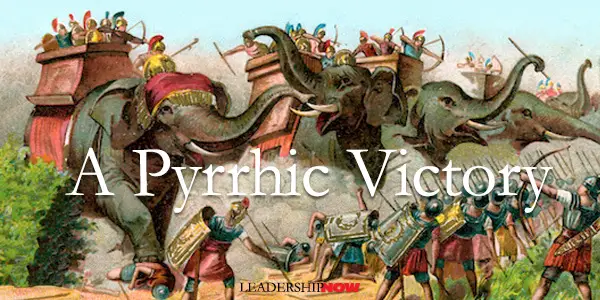
IN 279 BC, 40,000 Romans battled for two days against 40,000 Greeks and their 20 war elephants in the hills of southeastern Italy near Asculum. The Greeks were under the command of King Pyrrhus. According to the great Carthaginian general Hannibal, he was the greatest general the world had seen since Alexander the Great. The first day of battle accomplished little. The two sides fought an indecisive battle. Over the next day, the Romans were forced back, but Pyrrhus was unable to capture their camp. Finally, at the end of the day, seeing the futility of continuing, the armies separated. The Romans had lost 6,000 men and the Greeks 3,500 including many officers. It was a costly victory for Pyrrhus. At dawn the next morning, in response to congratulations for his victory over the Romans, the historian Plutarch relates that Pyrrhus confessed, “one more such victory would utterly undo him.” The battle had been won at too high a cost. Although they never defeated Pyrrhus on the field, the Romans were able to win a war of attrition. Henceforth, no soldier would cheer a Pyrrhic victory. We, too, have battles to fight from time to time. Some battles though can be won at too high a cost. As Pyrrhus admitted, some battles can literally undo us. If we are not careful we can let situations and our ego get the best of us. We can undermine our purpose of serving and lifting up those we lead. Winning an argument can destroy our influence and cost us a relationship. In Pearls of Wisdom, Joyce Brothers wrote, “There is a rule in sailing where the more maneuverable ship should give way to the less maneuverable craft. I think this is sometimes a good rule to follow in human relationships as well.” Relationships are what leadership is all about. As the leader, we are the more maneuverable ship. Being immovable or stubborn, just because we are right, doesn’t move us closer to our goal. It is up to us to step back, bend, or give way and let the other person pass. Later we might try a different tack if it is really that important to make the point. Hitting a difficult person head on is rarely the appropriate action. When we come up against conflict, we must ask ourselves if winning this one is really that important. How will winning affect my ability to work with this person? What is motivating me to win? We don’t need to fight every battle. We should choose battles that in the final analysis will strengthen our relationships and improve our effectiveness.
Posted by Michael McKinney at 09:53 AM
03.16.07

Employees Who Quit, But Stay On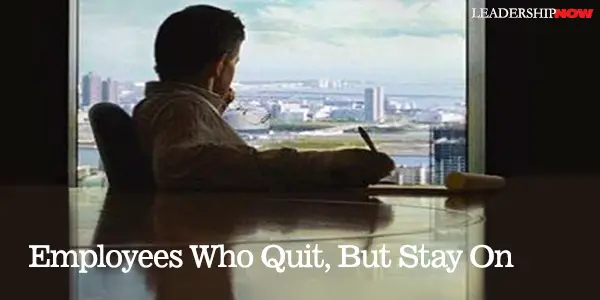 ARE disengaged employees eroding your customer satisfaction, employee retention, productivity and profitability? Research has shown that the average employee engagement figures for the United States are: 30% Engaged, 54% NOT Engaged and 16% Actively Disengaged. Keith Ayers in his book, Engagement Is Not Enough, says that it is a leadership issue and the problem is critical. “Like a cancer, they spread their discontent and do their best to turn the engaged employees against you as well. Even if they don’t succeed, they will undermine the good work your engaged employees are doing by failing to complete their part of projects on time or lowering the overall quality of the job.”
ARE disengaged employees eroding your customer satisfaction, employee retention, productivity and profitability? Research has shown that the average employee engagement figures for the United States are: 30% Engaged, 54% NOT Engaged and 16% Actively Disengaged. Keith Ayers in his book, Engagement Is Not Enough, says that it is a leadership issue and the problem is critical. “Like a cancer, they spread their discontent and do their best to turn the engaged employees against you as well. Even if they don’t succeed, they will undermine the good work your engaged employees are doing by failing to complete their part of projects on time or lowering the overall quality of the job.”
According to the Gallup Organization, the problem usually begins in the first six months when an average of over 60% of employees switch off. This is basically due to the perceived realization that their expectations are not going to be met. They feel powerless to fix the situation and give up but stick around at your expense. Ayers, warns us to avoid four primary obsessions that often result in managers unintentionally increasing the spread of the cancer of disengagement: An obsession with financial results. “To drive myopically toward profit or achieving budget alone, ignoring the needs of employees, customers, and the culture and the values of the organization, is very costly to results.” How much more could you “achieve with passionate employees who go to extreme lengths every day to give their best performance?” An obsession with control. “Control-based leaders assume that people cannot be trusted and send that message to their team. These autocrats are a liability to the organization, squashing natural enthusiasm, creativity, and ambition and driving away the most talented employees.” An obsession with avoiding responsibility. “The number one cause of lack of engagement, poor employee performance, and staff turnover is the relationship the employee has with his or her immediate supervisor. If your team is not performing the way you want them to, first look at whether the leadership they are getting from you is what they need to be able to perform at their best.” An obsession with logic. “Managers obsessed with logic and left-brained thinking are dismissive of feelings—they say that emotions don’t belong in the workplace. They do not believe engagement has anything to do with organizational performance or that people can be passionate about their work. Managers need to understand that emotional intelligence and right-brain thinking are critical skills to become successful leaders in the new global economy.” Ayers offers a discussion of the leadership skills you will need to develop to create passionate employees. He correctly notes, “By now you may be thinking, ‘Don’t the employees have a responsibility to be engaged and perform at their best?’ And you’re right, they do. They should be engaged. But the reality is, in an average organization, 70 percent of them are not! Being right about what they should do won’t make them more engaged. Being effective as a leader will.” According to The Conference Board of Canada, they reported that in looking at a cross-section of studies, that all studies, all locations, and all ages agreed that the direct relationship with one's manager is the strongest of all drivers. Not surprisingly then, they also reported that larger companies are more challenged to engage employees than are smaller companies. 
Posted by Michael McKinney at 12:24 AM
02.14.07

Simplicity: Focused and On Track Simple Solutions is directed toward getting things done. It’s about being able to “boil things down to their essence” and thereby bring complex issues down to a simple problem statement. To do this you must learn what is important to all stakeholders. Simplified problems are ones that can be acted one through effective, focused communication. Authors, Tom Schmitt and Arnold Perl provide some practical steps to build this skill. They define a continuum of leadership as: clarity of thought leads to simplicity, which leads to focus and powerful communication—the essence of leadership. Here are a few of the ideas found in this book:
Simple Solutions is directed toward getting things done. It’s about being able to “boil things down to their essence” and thereby bring complex issues down to a simple problem statement. To do this you must learn what is important to all stakeholders. Simplified problems are ones that can be acted one through effective, focused communication. Authors, Tom Schmitt and Arnold Perl provide some practical steps to build this skill. They define a continuum of leadership as: clarity of thought leads to simplicity, which leads to focus and powerful communication—the essence of leadership. Here are a few of the ideas found in this book:
Focus on the Amazing Goal, Not the Incremental. The deadly enemy of innovation is incrementalism. By just trying to make problems better a little bit at a time you can lose sight of the possibility of making a quantum leap. A useful question to help you look for amazing goals is, “What would have to be true in order to/for…?” The answer to the question helps you to think differently and make breakthroughs. Be Directionally Correct. “The fact is there will never be enough time or information to help you arrive at the perfect answer. The right answer can be one that is directionally correct. In other words, the solution may not be perfect, but it’s in the ballpark. This paves the way for more action but at least you’re already working with the customer and aren’t stuck back at the starting gate, still refining the model in the search for the non-existent perfect solution.” Determination versus Distractions. Determination is the willingness and ability to overcome obstacles and to avoid distractions. “Determination requires continued focus and commitment to a project. It requires the business savvy to separate the core of an issue from ancillary matters and then to continue plugging away at the core.” It is important to note though, “determination is an art. It requires walking a fine line between passionate focus and blind stubbornness. Use your judgment to determine if the goal needs to be simplified, changed, or even abandoned altogether. Don’t confuse sheer stubbornness with determination. 
Posted by Michael McKinney at 12:26 AM
02.09.07

The Study of LeadershipIn a 1969 keynote address in Tokyo, Peter Drucker made the following observation about an aspect of leadership—management: There are management tools and techniques. There are management concepts and principles. There is a common language of management. And there may be even a universal "discipline" of management. Certainly there is a worldwide generic function which we call management and which serves the same purpose in any and all developed societies. But management is also a culture and a system of values and beliefs. It is also the means through which a given society makes productive its own values and beliefs. Indeed, management may well be considered the bridge between a “civilization” that is rapidly becoming worldwide, and a “culture” which expresses divergent traditions, values, beliefs, and heritages. Of course, along the same lines, leadership encompasses far more than the business or political environment we typically confine it to. From being the act of a few, it has become a personal responsibility. The issues we face today require a multidimensional understanding of leadership that is broader than most academic studies would give it. In fact the study of leadership is not the study of leadership at all, for leadership is the development of an individual’s whole being which is dynamic and ongoing.
Posted by Michael McKinney at 07:41 AM
01.26.07

Connections: It’s a Lego World
“…The management world is only flat if you take an industrial perspective. If you just want the lowest cost, the capabilities exist virtually everyplace in the world to get the lowest cost. But if cost is not your only concern and you recognize that the industrial world has given way to an information and knowledge driven world, you will see that Indiana and India are not interchangeable. “In the twenty-first century, businesses exist in a Lego world. Companies are built out of Legos: People Legos, Product Legos, Idea Legos, and Real Estate Legos. And these aren't just ordinary Legos; they pass through walls and geographic boundaries, and they are transparent. Everything is visible to everyone all the time. Designing and connecting the pieces is at least as important as providing them. It's crucial to remember that these aren't simply pieces of plastic or metal—they are not just factories or warehouses. They are also humans who program computers, train newcomers, and think about innovation as they prowl malls, libraries, and parks, coming up with new products. These pieces are constantly being put together, pulled apart, and re-assembled. >“My company's Legos—manufacturing, distribution, skills, and services—cannot be unique unto themselves; they have to connect with your company's Legos. I can build my company, but in a year or two, my CEO and I might have to tear down and rebuild part of it in a totally different configuration, perhaps with fewer American People Legos and more of your company's People Legos in Sweden or South Africa. Leading visionaries in business are expressing the same notion. Ray Ozzie, Microsoft's chief software architect, recently explained: 'What's more important than any one individual Lego is that you know how to build with all the Legos. With everything out there, all those programs and applications and accessories, what's important is the ability to find a way to connect fragmented software pieces “…There are no competitors. Let me repeat that, because it's something that Peter Drucker loved to say: 'There are no longer competitors, just better solutions and more choices that can be put together in more ways.'” 
Posted by Michael McKinney at 07:23 AM
01.02.07

Study Says Two of Five Bosses Don't Keep WordNearly two of five bosses don't keep their word and more than a fourth bad mouth those they supervise to co-workers, according to a new study by the College of Business at Florida State University. "They say that employees don't leave their job or company, they leave their boss. We wanted to see if this is, in fact, true," said Wayne Hochwarter, an associate professor of management at FSU's College of Business. Working with doctoral students Paul Harvey and Jason Stoner, Hochwarter surveyed more than 700 people who work in a variety of jobs about their opinions of supervisor treatment on the job. The survey generated the following results:
According to the researchers, "Employees stuck in an abusive relationship experienced more exhaustion, job tension, nervousness, depressed mood and mistrust. They also were less likely to take on additional tasks, such as working longer or on weekends, and were generally less satisfied with their job. Also, employees were more likely to leave if involved in an abusive relationship than if dissatisfied with pay."
Posted by Michael McKinney at 10:45 PM
05.05.06

Fire Someone Today
Fire Someone Today sounds like a book of contrary advice for bosses. Surprisingly, it is a book full of down-to-earth, practical, and tested advice for leaders seeking to better their company and the lives of those who work for them. It is written in a conversational and helpful tone by Bob Pritchett, President and CEO of Logos Research Systems (makers of Bible Software). Firing someone is never easy. Consequently, we often find ourselves doing everything we can to avoid facing the issue. And the reasons we come up with sound pretty good and effectively forestall the inevitable. However, Pritchett explains these are not just bad reasons; these are selfish excuses. Compassion is caring about others, but retaining the employee who should be fired is all about caring for ourselves—it is never about the employee. We want to protect our investment, our presumptuous feeling of parental responsibility, our time and energy, even our reputation for "being nice." If employees quit or were hit by the proverbial bus, we would find a way to address any real issues related to their sudden absence—we would have to, because their departure date would be out of our control. Pritchett reminds us that firing the employee should be a last resort after trying to retain the person in a different position (in reality, not in name only). But if it has to be done, he explains how to do it right. When we don’t fire employees who need to be fired, we aren't doing anyone any favors. When we don’t fire someone we should, our inaction is malicious. We are hurting our organization and wasting the employee’s time on a job with no future. Our motivations are most likely selfish; at the very best, we are just being stupid. Some of the other great and immediately practical advice: Nobody Needs an Optimistic Accountant: You should be optimistic about your business. Your salespeople should be optimistic about your business. Your parents, your children, your vendors, and your employees should be optimistic about your business. You do not want any negative, pessimistic, whining, cry-baby Chicken Littles on your team. Except for your accountant. Fire Someone Today will help you too look at business problems through another lens and show you how to deal with them head-on in constructive and profitable ways. 
Posted by Michael McKinney at 06:59 AM
04.05.06

Stuffing the Dog
ACTOR ALAN ALDA wrote about a dog he had when he was eight years old. In his book, Never Have Your Dog Stuffed, he describes how he was so upset about burying his dog that his Dad suggested that they have it stuffed. In a Newsweek interview, he said: It turned out to be a really terrible idea because the dog came back from the taxidermist with a hideous expression on its face that frightened everybody. After a while, I started to think of that as an image of something that went a lot deeper than the dead dog, which is you can’t bring back anything to life. Alda continued that there are a lot of ways we stuff the dog, trying to avoid change or hanging on to a moment that's passed. We all of course, like to hang on to the familiar. What things are you hanging on to that once abandoned would allow you to move to the next level? Joseph Schumpeter (1942) coined the phrase “creative destruction” to describe the process by which people and organizations determine what they should stop doing. So much of building a good life or organization is a process of elimination. A process where we replace the outdated with the new more productive behaviors or products. Start by creating a not-to-do list. Have you stuffed the dog lately?
Posted by Michael McKinney at 09:56 AM
|
BUILD YOUR KNOWLEDGE
 

How to Do Your Start-Up Right STRAIGHT TALK FOR START-UPS 
Grow Your Leadership Skills NEW AND UPCOMING LEADERSHIP BOOKS 
Leadership Minute BITE-SIZE CONCEPTS YOU CAN CHEW ON 
Classic Leadership Books BOOKS TO READ BEFORE YOU LEAD |
| |||||||||||||||||||||||||||||||||||||||||||||||||||||||||||||||||||||||||||||||||||||||||||||||||||||||||||||||||||||||||||||||||||||||||||||